
Home » Travel Guides » Morocco » 25 Best Things to Do in Marrakesh (Morocco)

25 Best Things to Do in Marrakesh (Morocco)
Against the snow-capped High Atlas Mountains, Marrakesh is a timeless city of red sandstone.
Storytellers still regale the public on the Jemaa el-Fnaa square and an army of vendors sell their wares on haphazard interweaving alleys, packed tight to keep the sun at bay.
Marrakesh went through two periods as an imperial capital, under the Almoravids and Almohads in Medieval times, and the Saadian Dynasty in the 16th century.
These spells left the city with masterpieces of Hispano-Moorish art, like the 12th-century Koutoubia Mosque, and the ruined palace and mausoleum of Sultan Ahmad al-Mansur (1549-1603). Marrakesh has caught the imagination of many Europeans, not least the long-term resident Yves Saint-Laurent (1936-2008), whose epoch-defining designs have found a stage at a new museum in his honour.

Marrakesh’s walled old town is an indecipherable labyrinth of alleys converging in the west on the Jemaa el-Fnaa square under the emblematic 12th-century minaret of the Koutoubia Mosque.
You’ll learn time and again that outward appearances can be deceiving in the Medina, and this goes for the plain-looking external walls of riads (courtyard mansions), giving no indication of the splendour of the mosaics and stuccowork within.
Naturally a riad would be the best accommodation in Marrakesh, and you can see inside more than a few that have been restored and turned into museums.
If there’s one way to enter the Medina it’s got to be the Bab Agnaou gate, the historic entrance to the kasbah greeting you with bands of interlacing carved sandstone radiating from its horseshoe arch.
2. The Souks of Marrakesh

A fact you may hear about Marrakesh is that it’s a city of 40,000 craftsmen.
On the close, intersecting alleys pulling off the immense Jemaa el-Fnaa you can see what all these artisans get up to.
Effervescent, picturesque and hectic, the souks are as much an experience as a shopping opportunity, and are broken down by speciality.
There’s a Souk Smata for babouche slippers, a Souk Seffarine for brassware, a Souk Haddadine for blacksmithing, Souk Chouari for carved cedar and the famed Souk Cherratin, selling all manner of leather goods, from purses to belts.
Souk Sebbaghine, the dyers’ souk, is a photographer’s dream with its strands of wool in bright colours drying overhead.
You will be expected to haggle, but through this act it’s worth bearing in mind that all traders want to make a sale.
Recommended tour : Marrakech: 3-Hour Colorful Souks Tour
3. Koutoubia Mosque

The 77-metre minaret of the city’s largest mosque has towered above the west side of the Medina for more than 800 years.
When the French drew up the Ville Nouvelle, this Medieval tower was still the guiding landmark, and is visible for almost 30 kilometres.
Completed in the reign of Almohad Caliph Yaqub al-Mansur, the minaret came before, and inspired, Seville’s famous Giralda and the Hassan Tower in Rabat, also Almohad creations.
Instead of steps, the minaret has a ramp inside, so that the muezzin could ride up to give the call to prayer.
This also means that the orientation of the interlaced window arches is slightly different on each facade.
Access is prohibited to non-Muslims, but you can get a good look from the esplanade by the Jemaa el-Fnaa.
To the right of this you’ll see the ruins of an earlier Almohad mosque, raised in the 12th century but abandoned because its mihrab (shrine) wasn’t oriented towards Mecca.
4. Jardin Majorelle

Yves Saint-Laurent and his label’s co-founder Pierre Bergé bought up and restored this transformative garden and its Cubist villa in the 1980s.
It was all the work of Jacques Majorelle (1886-1962), son of the fabled Art Nouveau furniture designer Louis Majorelle.
Jacques spent more than forty years perfecting this 2.5-hectare space, and you can wander among the bamboo, outlandish tall cactuses and bright bougainvillea.
Fronted by a square fountain in the same shade of cobalt blue, Majorelle’s villa and studio holds a museum for Islamic art, presenting Saint-Laurent’s personal collection of North African textiles, ceramics and jewellery, along with a collection of Majorelle’s paintings.
Suggested tour : Majorelle Garden and Palmeraie Camel Ride Tour
5. Bahia Palace

Up there with the masterworks of Moroccan architecture, Bahia Palace reached its current scale and opulence under the grand vizier Ba Ahmed (d.
1900). The intensely decorated palace, on eight hectares in the south-east of the Median, was begun in the 1860s and then extended by the famously portly Ba Ahmed, whose additions included a gigantic harem on a courtyard around a central basin.
The complex abounds with painted cedar and beech ceilings, gleaming white marble, multicoloured zellige, elaborate latticework, stained glass and gardens laden with jasmine, hibiscus, citrus trees and banana trees.
The grand vizier had no fewer than four wives and 24 concubines, which explains the magnitude of this space.
Ba Ahmed’s wives each had an apartment identical in size, denoting their equal status, and around the palace you’ll step through the school/mosque for his many sons and daughters and the hall where he conducted business.
King Mohammed VI occasionally stays at Bahia Palace, in personal quarters not open to the public.
Included in : Marrakech: Private Half-Day Walking Tour
6. Ben Youssef Madrasa

Until it closed in 1960, Marrakesh laid claim to one of the largest madrasas in North Africa, accommodating more than 800 students.
This was completed during the reign of Sultan Abdallah al-Ghalib (1517-1574) on the site of an earlier Marinid-dynasty madrasa from the middle of the 14th century.
The complex opened as a historical site in 1982 and is designed around a magnificent interior courtyard, decorated to provoke a feeling of astonishment through its brilliant zellige mosaics, feather-light stuccowork, finely carved cedar and bands of Arabic calligraphy around a rectangular reflection pool.
At the far end from the entrance is the mihrab couched in yet more vibrant tilework.
This richness continues in the latticework and moulded stucco niches of the secondary courtyards, while the student’s cells are purposely unadorned.
7. Jemaa el-Fnaa

Marrakesh’s fevered marketplace was born as a space for military parades and executions in front of the palace that preceded the Koutoubia Mosque.
Jemaa el-Fnaa is a frenzy all day and into the night.
In the afternoon there will be snake charmers, Barbary monkeys, orange juice stalls and water sellers.
Later these withdraw to be replaced by a mass of dancing youths dressed as women (who wouldn’t be permitted to dance), magicians, fire breathers, acrobats and storytellers, all soundtracked by bands of gnaoua musicians in blue robes.
At night there are myriad food stalls at Jemaa el-Fnaa for tagines, couscous, sizzling meat skewers and spiced soups with lentils and chickpeas.
Suggested tour : Marrakech: Medina by Night Tour
8. Saadian Tombs

Members of the powerful Saadian Dynasty, whose rule coincided with Marrakesh’s apogee in the late-16th century, were laid to rest in this sumptuous walled mausoleum complex on the south side of the Kasbah Mosque.
The tombs date from the time of Ahmad al-Mansur (1549-1603) and were lost for hundreds of years behind their indomitable walls until an aerial survey in the 1910s.
Some 66 people are entombed in these three rooms, including al-Mansur, his son and grandson in the showpiece Hall of the Twelve Columns.
The tombs here are fashioned from Carrara marble, ensconced in kaleidoscopic zellige mosaics on the floor and lower walls, all under an astoundingly intricate dome of carved cedar.
9. Maison de la Photographie

Opened in 2009 in an old merchants’ inn at the heart of the Medina, this museum has a collection of more than 10,000 historic photographs, from 1870 to 1950. You’ll witness seldom seen images of Moroccan landscapes, the ancient city of Volubilis, palaces, kasbahs and candid images of Berber culture.
There are pictures captured by some of the earliest photographers to arrive in Morocco, including the Scotsman George Washington Wilson (1823-1893), and many more anonymous travellers visiting the country on their grand tours.
There are new exhibitions every few months on themes relating to specific locations, photography styles and aspects of life in the country.
After perusing the exhibition you can head up to the terrace for a pot of mint tea and a privileged view of the Medina and the mountains.
10. El Badi Palace

This ruined palace inhabited by storks and stray cats, also constructed Sultan Ahmad al-Mansur, was started immediately after his victory in the Battle of the Three Kings (1578) using funds raised by a ransom paid by the Portuguese.
Decades later, El Badi Palace, thought to have had 300 lavishly decorated rooms, was plundered by the Alaouite Sultan Ismail Ibn Sharif (1645-1727) for material for his palaces at the new capital Meknes.
The vestiges left behind are substantial, with spellbinding views from the crenellated walls and a mysterious network of subterranean passageways to explore.
Something not to be missed at the back of the courtyard is the Koutoubia minbar (pulpit), hewn from cedar in the 12th century, with fabulous marquetry and calligraphy in gold and silver by Medieval Cordoban artisans.
Recommended tour : Marrakech Historical Tour
11. Yves Saint Laurent Museum

This purpose-built museum for Marrakesh’s famed former resident opened on his namesake street in October 2017. The building, designed by Studio KO, looks at once traditional and modern, evoking Art Deco in its curving forms and dressed in bricks that were fired in Morocco and arranged in an interlacing pattern.
On a minimal backdrop, the permanent exhibition is rooted in Marrakesh, and features many of Yves Saint Laurent’s most iconic creations, like the Mondrian dress, the pea coat, “Le Smoking” and the safari jacket.
The 50-piece display is rotated every few months and organised along themes that guided the designer’s work: Art, Gardens, Morocco, Africa, Black, Imaginary Voyages, Masculine-Feminine.
Complementing this work are sketches, runway footage, photographs, audio accounts and music for an insight into the designer’s creative process and influences.
12. Menara Gardens

Some way out of Marrakesh towards the airport is a set of botanical gardens first planted around 1130 by the ruler of the Almohad Caliphate, Abd al-Mu’min.
The name Menara comes from the pavilion building, with horseshoe arches, a balustraded terrace and pyramidal roof, impressive before the snow-capped High Atlas Mountains.
That pavilion, dating from the 19th century on an earlier 16th-century foundation, sits on a giant reservoir that was constructed to irrigate the orchards and olive around it.
As was the case almost 900 years ago the gardens are a respite from the heat of the day.
13. Cyber Park

The name of this park to the west of the Medina gives little indication of its great age.
With a clear view of the Atlas Mountains the garden was laid out by Prince Moulay Abdeslam, son of Sultan Sidi Mohammed Ben Abdellah, at the end of the 18th century.
The space became public in the early 20th century, and lost its landscaping until a rehabilitation project by the Foundation Mohammed VI for the Protection of the Environment in the early 2000s.
The Cyber Park pairs a historic arsat (orchard) garden, planted with citrus trees, lucerne and olive trees, with a modern park laid out with spacious lawns, water features and walkways.
The name comes from a cyber cafe and telecom museum that opened in 2005 but also the free Wi-Fi available at the park.
14. Tiskiwin Museum

This museum was founded by the Dutch anthropologist Bert Flint as a place to show off his extensive assemblage of Amazigh artefacts.
Such is the importance of the collection that the museum has now become part of Marrakesh’s Cadi Ayyad University.
The permanent exhibition is conceived as a trip into Berber Sahara on the old caravan routes between Marrakesh and Timbuktu.
On your journey you’ll become acquainted with Berber festivities, commerce and domestic life.
In this fine riad you’ll see carvings in stone and wood, furniture, baskets, fabrics, djellabas (robes), jewelry, cooking implements and more, all matched with well-researched descriptions.

In Marrakesh’s Jewish quarter you’ll notice that the city’s already narrow streets constrict even more, and that the buildings are a little taller.
This is because until the arrival of the French Protectorate in 1912 Jews were unable to live outside this dense quarter, and so had to make the most of what little space there was.
The quarter grew up in the middle of the 16th century during the Saadian dynasty, on the plot where the Sultan’s stables used to be.
At its height it was a hectic neighbourhood of jewellers, sugar traders, tailors and bankers.
The Mellah has been restored a little in the reign of Mohammed VI, readopting its original Jewish street names.
Marrakesh’s Jewish population has now dwindled to just a few dozen, as you’ll see from the occasional glimpses of Stars of David on the walls.
As well as somewhere to get a handle on the city’s past, the Mellah is a place to shop away from the city’s frenzied main souks.
16. Salat Al Azama Synagogue

This 16th-century synagogue in the Mellah was built on the back of the Expulsion of the Jews from Spain.
Newly revamped with a gallery for women, you’ll find it on a courtyard hidden down a narrow alley, its vivid blue tilework, doors and benches contrasting with the oranges and browns of the city.
The Salat Al Azama Synagogue is one of two active places of worship for Marrakesh’s Jewish community, but for everyone it’s a place to gain a bit more insight about Judaism in the city, through an exhibition of photographs and documents.
The courtyard here once served as a yeshiva (religious school) for 400 students from the region.
17. Miaara Jewish Cemetery

The cemetery in the Mellah, the largest Jewish cemetery in Morocco, gives a clearer picture of just how many people lived in this district after it was first developed in the 16th century.
As with so many places in the Medina, the nondescript entrance belies the beauty and magnitude of what lies behind.
Men will be given a yarmulke to wear as they go in, to be faced by a field of long, whitewashed tombs, most worn down over time but some keeping their triangular outline.
It’s staggering to think that there are three burial layers here.
The Miaara Jewish Cemetery has a special place in Jewish culture, as the burial place of many tzaddikim (Hasidic spiritual leader or guide). An ornate mausoleum, with a carved cedar roof and detailed stucco mouldings, is reserved for the president of the city’s Jewish community.
18. Dar Si Said Museum

The oldest museum in Marrakesh opened in 1932 in the exquisite late-19th-century palace ordered by Si Said ben Moussa, minister of defence to his brother, the grand vizier Ba Ahmed (d. 1900). Go in to luxuriate in the hypnotic zellige tilework, the stained glass and the beautifully fashioned cedar ceilings.
The museum documents the traditional crafts of the region, incorporating Marrakesh, the banks of the Tensift River and the High Atlas and Anti-Atlas ranges.
There’s Berber jewellery, hammered copper, pottery, rugs, ceremonial clothing and weapons, as well as an exhibition of fastidiously embellished doors and window frames from Kasbahs across the south.
19. Boucharouite Museum

On your adventure through the Medina you can step inside this museum in a riad, with a central courtyard and a calm, green terrace above.
The museum shines a light on the Berber Boucharouite rug-making technique, in which strips of colourful rags are woven together, normally by a woman.
As they can be made by a single weaver rather than a workshop, Boucharouite rugs often tell you something personal about their maker.
This goes for the pieces hanging at this museum, and if you’re in luck the museum’s owner will be around to share some of the background on each rug and what they say about Berber culture.
At the end you can take tea on the terrace, high above the clamour of the Medina.
20. Ouzoud Waterfalls Full Day Tour from Marrakesh

Marrakesh’s inland location puts awesome natural wonders within striking distance, and there’s a whole catalogue of once-in-a-lifetime experiences available.
The Ouzoud Falls in the Middle Atlas Mountains are 150 kilometres northeast of the city, and this tour will take you there in the comfort of an air-conditioned minibus, safe in the hands of a local guide.
The drive is memorable, passing through olive groves and little Berber villages perched in the High Atlas.
The falls are breathtaking, where the El Abid River roars down three drops with a total height of 110 metres, into a vast gorge with mossy walls.
You’ll get the chance to swim in the river and take snaps of the curious Barbary macaque monkeys that have made the falls their home.
Recommended tour : Ouzoud Waterfalls Full-Day Trip from Marrakech
21. Marrakesh to Merzouga 3-Day Desert Safari

Marrakesh is as close as many people will ever come to the open Sahara Desert, and it’s thrilling to think that those romantic orange and bronze dunescapes are within reach.
This tour on GetYourGuide.com is a three-day odyssey, crossing the High Atlas Mountains and visiting the spectacular Kasbah of Ouarzazate, a dreamlike city long known as “The door of the desert”. After seeing the high craggy walls of the Todgha Gorges you’ll continue to the Erg Chebbi dunes, which fit everyone’s most romantic notions of the Sahara.
After a camelback ride you’ll pass the night in a Bedouin camp, tucking into a tagine cooked under the stars and being entertained by real nomadic gnaoua musicians.
22. Atlas Mountains Day Trip with Camel Ride

The High Atlas Mountains are tantalising and ever-present on Marrakesh’s southern horizon, and this day trip will take you into the range’s Imlil Valley for sublime mountain panoramas, a camelback ride and a dose of Berber culture.
On the way you’ll stop at a women’s only Argan oil cooperative to buy this coveted cosmetic product at its source.
Later, at the town of Asni, you’ll visit a Berber souk unaffected by tourism, followed by little hamlets, waterfalls and a stop at the steep fertile terraces of Tamatert, growing vegetables, corn and barley since time immemorial.
Heading back towards Marrakesh there will be a stop at the Moulay Brahim Gorges for a camelback ride in epic scenery.
Book online : Atlas Mountains Day Trip with Camel Ride
23. Museum of Marrakesh

Despite the name, the Museum of Marrakesh is concerned less with the history of the city and more with the architecture and decor of its admittedly beautiful building.
Next to the Ben Youssef Madrasa, this is a palace built at the end of the 19th century for Mahdi Menhbi, the defence minister under Sultan Moulay Abdelaziz (1878-1943). The palace lost its sheen during a period of neglect, until it was restored and turned into a museum in the 1990s.
The best bit is the unusually large patio, taking up more than 700 square metres, and dominated by a spectacular multi-tiered chandelier.
On the ground floor are small displays of hammered copper objects, Berber jewellery, weapons and clothing, while upstairs you can take a close look at the dainty Moorish decor and fine cedar furniture.
24. Le Jardin Secret

Worthwhile as a momentary escape, Le Jardin Secret is a hushed palace and garden complex right in the Medina.
The fanciful story goes that this was initially a pair of Saadian Dynasty riads in the 17th century, reconstructed by the ambitious 19th-century kaid (commander) al-Hajj Abd-Allah U-Bihi during the reign of Sultan Mohammed IV.
He later met with a sticky end when his tea was poisoned.
From the 1930s onwards the palaces became dilapidated and opened in 2016 after an eight-year restoration.
There’s an Islamic and an exotic garden to peruse, and the palaces show off modern examples of Moroccan design in their tilework, hand-moulded stucco, carved cedar and tadelakt (waterproof plaster). The newly constructed tower almost matches some of Marrakesh’s minarets for height, looking down on the Medina and out to the mountains.
25. Oasiria

After braving the medina with children or teenagers you may be ready for some time out.
Attached to a resort, Oasiria is a water park with eight pools and 17 different slides, all in ten hectares of gardens.
Grown-ups can take it easy in this oasis-like environment of lush lawns, palms and ancient olive trees.
But there’s lots of fun to be had at the wave pool, lazy river and a choice of heated pools.
For the tiniest there’s a space to splash around in knee-high water, and a sprawling playscape with low slides.
Bigger kids can contend with rides with names like Rio Loco, Kamikaze and Cobra, and there’s a new climbing wall for a change of pace.
25 Best Things to Do in Marrakesh (Morocco):
- The Souks of Marrakesh
- Koutoubia Mosque
- Jardin Majorelle
- Bahia Palace
- Ben Youssef Madrasa
- Jemaa el-Fnaa
- Saadian Tombs
- Maison de la Photographie
- El Badi Palace
- Yves Saint Laurent Museum
- Menara Gardens
- Tiskiwin Museum
- Salat Al Azama Synagogue
- Miaara Jewish Cemetery
- Dar Si Said Museum
- Boucharouite Museum
- Ouzoud Waterfalls Full Day Tour from Marrakesh
- Marrakesh to Merzouga 3-Day Desert Safari
- Atlas Mountains Day Trip with Camel Ride
- Museum of Marrakesh
- Le Jardin Secret
🙌 Awesome, you're subscribed!
Thanks for subscribing! Look out for your first newsletter in your inbox soon!
Get us in your inbox
Sign up to our newsletter for the latest and greatest from your city and beyond
By entering your email address you agree to our Terms of Use and Privacy Policy and consent to receive emails from Time Out about news, events, offers and partner promotions.
Awesome, you're subscribed!
The best things in life are free.
Sign up for our email to enjoy your city without spending a thing (as well as some options when you’re feeling flush).
Déjà vu! We already have this email. Try another?
Love the mag?
Our newsletter hand-delivers the best bits to your inbox. Sign up to unlock our digital magazines and also receive the latest news, events, offers and partner promotions.
- Los Angeles

The 17 best things to do in Marrakech
From museums and souks to fabulous restaurants, here are the things in Marrakech you should not miss
Photograph: Paula Hardy for Time Out

Within minutes of arriving in Marrakech you’ll learn a new word: ‘ Balek !’ Roughly translated as, ‘move it, donkey coming through!’ It’s a good word to know as Marrakech is a creative cauldron and is currently making an exciting dash to the future.
Having earned the prestige of being Africa’s first Capital of Culture, the city is now on a mission to introduce you to the best Moroccan food, fashion, design, art and hospitality. The Medina has recently benefited from careful architectural restoration; new museums have opened showcasing jewellery, desert gardens and ethnographic collections; the city’s souks sell almost anything you can dream up; and, the food scene is booming. So, join the throng and try out these must-do recommendations.
RECOMMENDED: 🥘 The best restaurants in Marrakech 🇲🇦 Your ultimate guide to Morocco
This guide is by Paula Hardy , a writer based in Marrakech . At Time Out, all of our travel guides are written by local writers who know their cities inside out. For more about how we curate, see our editorial guidelines .
Been there, done that? Think again, my friend.
What to do in Marrakech
1. medersa ben youssef.
- Things to do

An architectural marvel and Marrakech’s most important monument, this 14th-century religious school has recently undergone a painstaking five-year renovation during which the rich zellij tiling, ancient cedarwood ceilings and vine-covered stuccowork have been brought back to stunning life. Up in the dormitories of Medersa Ben Youssef you’ll find absorbing videos about the restoration.
Why go? To get an appreciation of the extraordinary technical skill and imaginative power of Morocco’s master craftsmen, who still ply their trade in the city’s souks.
2. Souk Semmarine

Souk Semmarine is the Bond St of Marrakech’s central souks, lined with carpets, cut brass lanterns, leatherwork and babouche. Dive in and get lost in the tangle of alleys which lead off into Rahba Kedima (the spice market) and souk Haddadine ( blacksmiths alley).
Why go? Did you even go to Morocco if you didn’t come back with something to remember it by? Haggle with the traders for that beautiful rug you spotted – you won’t regret it.
3. Musée Yves Saint Laurent

The French designer loved spending time in Marrakech so much he bought the famous Jardin Majorelle in 1980 and made it home. Now, the Musée Yves Saint Laurent, located next door, is dedicated to Yves’s couture legacy and has a permanent display of hundreds of garments spanning his 40-year career.
Why go? The YSL collection is an amazing body of work that even non-fashionistas can appreciate. It’s housed in one of the city’s most striking contemporary buildings, and includes a beautiful café, bookshop, archive library and auditorium.
4. Jardin Majorelle

Created by the French painter Jacques Majorelle, this botanical garden is home to more types of cacti than you can shake a terrarium at and has a stunning indigo blue art deco house as its centrepiece.
Why go? Phone cameras at the ready – Jardin Majorelle with its sculptural cacti and indigo blue villa is pure Instagram gold. Majorelle’s studio also houses the Berber Museum, showcasing a rich collection of traditional Moroccan jewellery and fashion.
5. Bahia Palace

Bahia Palace (which roughly translates to ‘beautiful palace’) was built in the late 19th century, and now forms the epicentre of the city’s culture. You won’t believe the decor until you see it, with high, gilded ceilings, rooms filled with paintings, mosaics and stuccos, and a huge, open garden to wander.
Why go? To find a spot in the shade and sit for hours to take it all in.
6. El Badi Palace

What is it? The epic ruins of Sultan Ahmed al-Mansour's once-magnificent palace, within which are set sunken gardens of orange trees surrounded by epic ramparts whose decrepit towers offer panoramic views over the medina.
Why go? El B adi may be a ruin, but it offers a fascinating insight into the power and wealth of past Moroccan dynasties. Within the ruins, you’ll also find the jewel that is the Koutoubia’s minbar (prayer pulpit), crafted by 12th-century Cordoban artisans.
7. Maison de la Photographie

What is it? A three-storey riad-turned-gallery housing the vintage Moroccan photography collection of Patrick Menac’h and Marrakshi Hamid Mergani. The images document the lifestyle and landscapes of Morocco between 1870 and 1950 – more than a century later, many things remain exactly the same.
Why go? To immerse yourself in the visual history of Morocco. Maison de la Photographie 's rooftop café is also one of the highest in the medina and is a great spot for lunch .
8. Indulge in a restorative hammam

The hammam – public bathhouse – is a Moroccan institution and you’ll find one in every neighbourhood in Marrakech as well as hotels like La Mamounia , Riad Tarabel and Es Saadi . It’s where Moroccans go for their weekly, relaxing gommage (scrub), but also to reconnect with themselves and with friends and family.
Why go? Because it’s an authentic Moroccan experience and is incredibly restorative. Alongside a full body scrub, most hammams offer masques and massages as well.
9. Contemporary Art Crawl in Gueliz

Ten minutes west of the walled medina, you’ll find the neighbourhood of Gueliz, the so-called 1930s ‘New Town’. Alongside its cafes and shopping malls, it harbours some exciting modern and contemporary art galleries like Galerie Siniya 28 , Galerie 127 and Comptoir des Mines .
Why go? Gueliz is the modern face of Marrakech and these galleries offer an insight into the vibrant, multidisciplinary art scene that Morocco fosters.
10. Jemaa el-Fna

The vast open square at the heart of the medina is one of Marrakech’s biggest attractions and is a Unesco world heritage site. Expect snake charmers, street entertainers and over-enthusiastic henna artists at every turn. Locals and tourists descend on the Jemaa every night, drawn by the ceaseless hoopla and halqa (street theatre).
Why go? Grab some food from one of the barbecue stalls, listen to some music, head up to a rooftop bar and marvel at the sunset.
11. Musée des Confluences

The former governor’s palace and home to the notorious Thami El Glaoui, Lord of the Atlas. Now the Musée des Confluences , it houses the archaeological collection of American Patty Birch and puts on shows exploring the intersection of eastern and western cultures.
Why go? This is one of the most beautiful palaces in the medina, vast in ambition and covered in intricate detail: coffered cedar ceilings, geometric tiling, stucco worked into elaborate floral motifs. Don’t miss Marrakech’s best cafe , Bacha Coffee House , which serves more than 40 brews in a jewel-like space .
12. Marrakech Insiders

Hop aboard a vintage sidecar motorbike for Marrakech Insiders ' tailormade tour of the Red City. The essential tour nips down alleys and through grand royal gates to give you a behind-the-scenes peak of local neighbourhoods, while other tours take you out to Art Deco Gueliz and beyond to the Palmeraie and desert.
Why go? Because it’s fun and revealing and will give you a fabulous insight into Marrakech that will be hard to access on your own. It’s also a tremendously adventurous way for families to tour the city.
13. Musée de Mouassine
A jewel of 16th-century Saadian architecture, this douiria (guest apartment) was built by a chorfa (noble) family and retains all its exquisite original decoration that acts as a backdrop to thoughtful exhibitions and musical events.
Why go? Every Monday and Friday from October to May, Musée de Mouassine hosts concerts of classical Moroccan music. Set in such beautiful surroundings, the events are super-atmospheric and accompanied by tea and pastries.
14. Sahbi Sahbi

Sahbi Sahbi is an atmospheric modern Moroccan restaurant in the New Town, Gueliz, designed by renown architectural practice Studio KO. Presided over by an all-female team, Sahbi Sahbi serves up some of the best traditional Moroccan dishes in a stylish interior with an open, central kitchen where you can see the magic happen.
Why go? To sample traditional Moroccan cooking at its finest, including unctuous beef tangia with white beans and cinnamon-dusted pigeon pastilla. Reserve a seat at the counter to see the chefs in action.
15. The Mellah

The Mellah is the ancient Jewish quarter of Marrakech, which has undergone an extensive renovation programme reinstating Jewish street names and repairing unique architectural. Make sure to visit the Al Azama synagogue, founded in the 16 th -century, and the extraordinary Miaara cemetery, the largest Jewish cemetery in Morocco.
Why go? Tours give an insight into a fascinating part of Marrakech’s (and Morocco’s) history. The Mellah is also an area of the city is less well explored by tourists and still has a very authentic neighbourhood atmosphere.
16. Souk Cuisine

Souk Cuisine puts on cookery classes with a twist. Starting with a tour of the souks, you shop for ingredients before heading to a riad where you’re taught how to cook by a group of local women.
Why go? Food is a huge part of Moroccan culture, and the course is a fab way to learn more about the country and its traditions. You’ll also make some of the tastiest tagines in town.
17. Café Clock

Café Clock is a hybrid restaurant-café-cultural centre where you can consider the merits of date milkshakes and camel burgers and sign up for storytelling workshops, calligraphy classes, oud lessons and Gnaoua jam sessions.
Why go? To dive deep into Moroccan culture and give some things a go yourself. Also, 10 dirhams from every camel burger Café Clock sells goes to charity.
More great things to do in Marrakech
[image] [title]
Discover Time Out original video
- Press office
- Investor relations
- Work for Time Out
- Editorial guidelines
- Privacy notice
- Do not sell my information
- Cookie policy
- Accessibility statement
- Terms of use
- Modern slavery statement
- Manage cookies
- Advertising
- Time Out Market

25 ICONIC Things to Do in Marrakech (Don’t Miss #15!)
By: Author Tiana Thompson
Posted on Last updated: March 16, 2024
Categories Africa , Morocco , Travel Guides
Home » 25 ICONIC Things to Do in Marrakech (Don’t Miss #15!)
- 242 Share on Twitter
- 358 Share on Facebook
- 779 Share on Pinterest
- 279 Share on LinkedIn
- 549 Share on Email
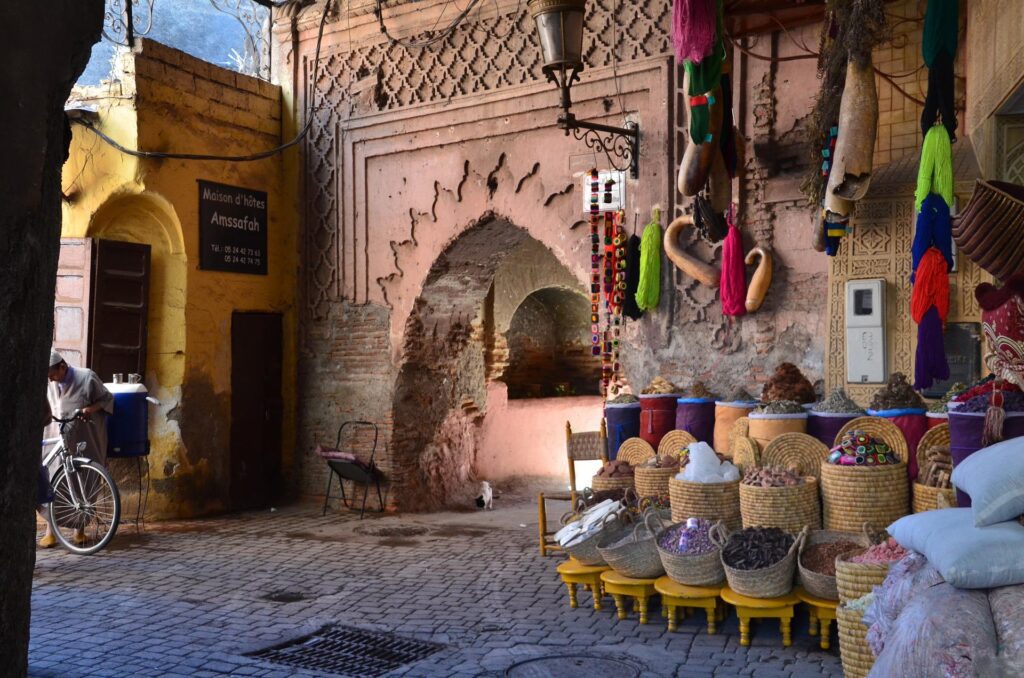
Marrakech is a vibrant city in Morocco that is known for its bustling souks, vibrant nightlife, and beautiful architecture. If you’re looking for an exciting place to visit, Marrakech is definitely the place for you.
The city is full of life and there’s so much to see and do. The people are genuinely some of the most hospitable I’ve met and were so friendly and welcoming, despite cultural differences and language barriers.
I recently came back from an amazing first visit to Marrakech and I absolutely loved it. I spent an amazing five days there and am already planning my next trip back (see ya in March 2023, Morocco)!
From exploring the ancient Medina and hanging for goods in the bustling souks to riding a camel through the Sahara Desert, there are plenty of activities to keep you busy during your stay here. There are so many exciting things to do and see in this historic city, and these 25 Marrakech activities don’t even scratch the surface of all the things this place has to offer its visitors.
In this blog post, I’ll be sharing the best things to do in Marrakech , the main attractions you should definitely add to your Marrakech itinerary, and what to avoid while visiting Marrakech .
About Marrakech
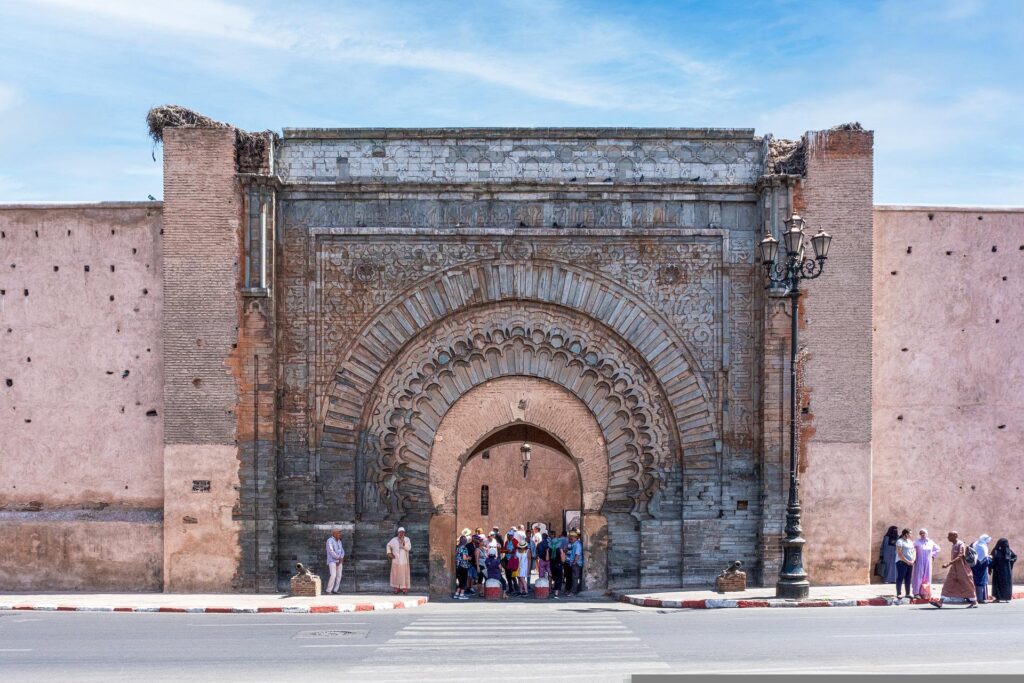
Marrakech is a city in central Morocco, in North Africa. The city is located just south of the Atlas Mountains.
It is the fourth largest city in the country with a population of over 1 million people. It’s located about 160 miles (260 kilometers) from the capital city of Rabat and is easily accessible by plane, train, or car.
The city was founded in 1062 by Youssef ibn Tachfin, the leader of the Moroccan Almoravid dynasty. Marrakech served as the capital of the Almoravid dynasty and later the Almohad dynasty.
The city is now a popular tourist destination, with many people coming to experience its unique culture and history.
This historic city has been a major trading hub for centuries, and its Souks (or markets) are world-renowned. The Medina is the old city center and is full of narrow streets and alleyways lined with shop owners, stalls, and street vendors. It’s a great place to bargain for goods, as prices are often negotiable.
Marrakech is also known for its beautiful architecture, with many buildings in vibrant colors and landmarks dating back centuries. Morocco is a Muslim country and brings a unique blend of French and Arab cultures. It’s definitely worth a visit if you’re looking for an exotic and exciting place to travel.
Marrakech is best known for its bustling souks, vibrant nightlife, and beautiful architecture. It’s also a popular tourist destination for its unique culture and history.
Marrakech is generally safe to visit, but as with any city, there are always areas that are best avoided. It’s important to be aware of your surroundings and not flash valuables or walk around alone at night.
Ideally, you would want to spend at least 3-5 days in Marrakech to experience all that the city has to offer.
The best time of year to visit Marrakech is during the spring or fall, when the weather is mild and pleasant. Average temps during these months range from the low 60s to mid-80s.
Yes, alcohol is widely available in Morocco and there are many bars and nightclubs throughout the city.
As a general rule of thumb, it’s best to dress conservatively in Marrakech. This means covering your shoulders and knees, and avoiding shorts or skirts that are too short.
Morocco is generally an affordable country to visit, with prices for food and lodging being relatively reasonable. Of course, there are always ways to save money, such as bargaining for goods in the souks or eating at local restaurants.
The currency in Morocco is the Moroccan Dirham (MAD). 1 USD is equivalent to about 9.38 MAD, or $10 USD = 100 Moroccan dirhams.
The official language of Morocco is Arabic, but French and Berber are also widely spoken. In Marrakech, you’ll hear French more often than you’ll hear any other language. It is a tourist-heavy city, so most people will be able to speak English as well.
25 ICONIC Things to do in Marrakech
1. visit the jardin de majorelle.
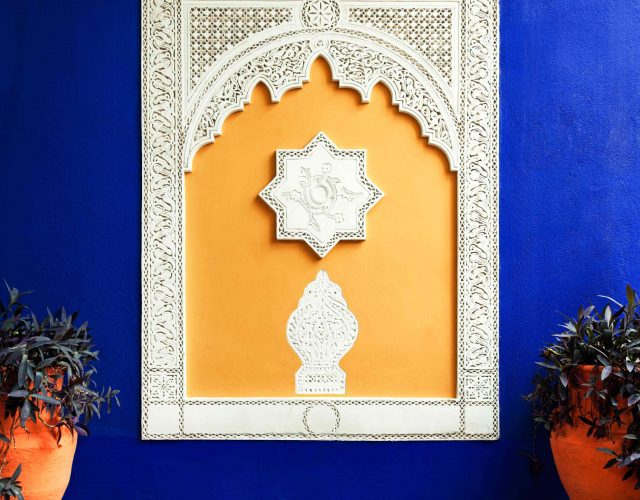
The Jardin de Majorelle (or the Majorelle Gardens) is one of the most popular tourist attractions in Marrakech.
The gardens were created by French painter Jacques Majorelle in the 1922s. They feature a stunning array of plants and flowers, as well as a labyrinth of intertwining alleys and hallways, bold-colored buildings, and a beautiful blue-and-yellow Art Deco villa. The gardens are home to many exotic plants and trees, including cacti, palms, and bamboo.
The gardens also feature a number of fountains and waterfalls, as well as a cafe on site. The Majorelle Café is only accessible to visitors to the garden and is situated in a perfectly shaded spot where you can enjoy some tea or refreshing beverages while taking a break from the Marrakech heat.
They also offer breakfast and lunch if you want to make a day of it!
The Pierre Bergé Museum of Berber Arts is a museum that is featured at the Jardin de Majorelle, which showcases a collection of Berber art and artifacts. This Berber museum was actually once the former painting studio of artist Jacques Majorelle, who the museum is named after, and was later inaugurated in 2011 as the museum we know today.
From the Rif to Sahara, the more than 600 objects collected by Pierre Bergé and Yves Saint Laurent residing here bear witness to a culture that is still alive. This vast collection has been organized into multiple rooms displaying various pieces showcasing the rich history and geography of the Berber people of Morocco.
Le Jardin de Majorelle is open daily for visits, from 8am to 6:30pm. The last entry for touring the museum is at 6pm though, so make sure to get there earlier to ensure you have time to see everything. Tickets to the museum can be purchased at the ticket office on-site, but the museum recommends buying your tickets online in advance at least 24 hours before your visit.
This transportation and ticket package costs $32 USD per person and includes a round-trip transfer from your Marrakech hotel, as well as admission to the Majorelle Garden and the Pierre Bergé Museum of Berber Arts. It’s ideal for those who want to enjoy a hassle-free visit to this top Marrakech attraction.
2. Get Lost in the Medina
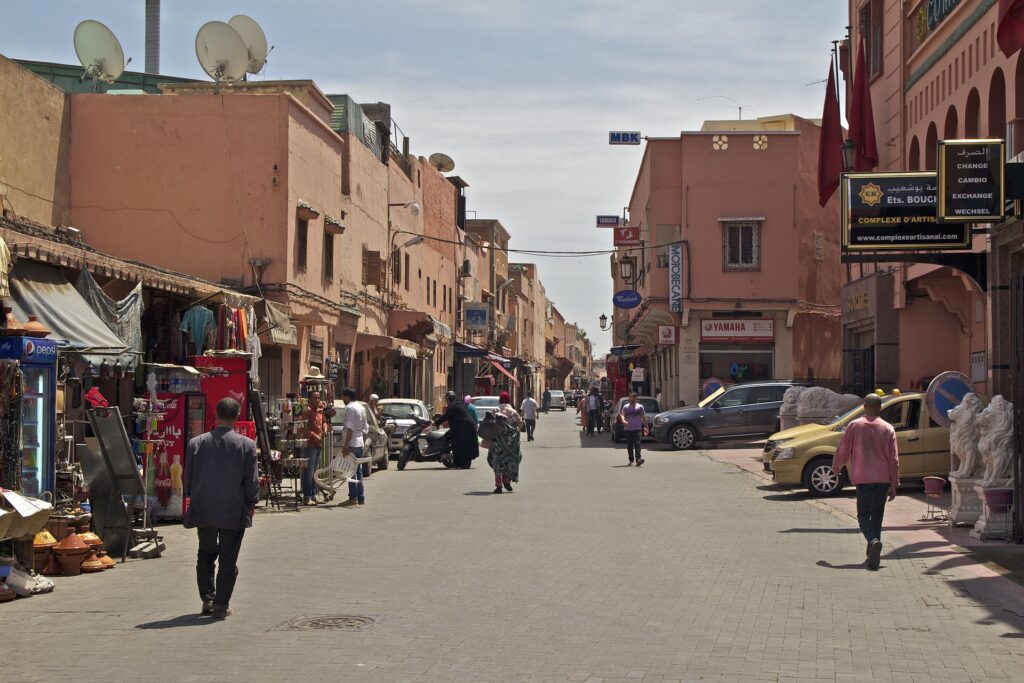
The Medina is the Old City of Marrakech, and it’s absolutely massive.
It’s a labyrinth of narrow streets and bustling souks (markets). With its winding streets and maze-like alleyways, it can be easy to get lost here. But that’s all part of the fun! Exploring the Medina is a great way to experience the true culture of Marrakech.
There are a number of things to see and do in the Medina of Marrakech, such as visiting the numerous markets, checking out the historic mosques, and exploring the many side streets and alleyways. Be sure to bargain when shopping in the markets, as prices are often negotiable.
If you really want to get off the beaten path, head to the Derb el Mitter area of the Medina. This is where the locals live and work, and it’s a great place to find some hidden gems. From traditional Moroccan restaurants to family-run shops, there’s a lot to explore in this part of town.
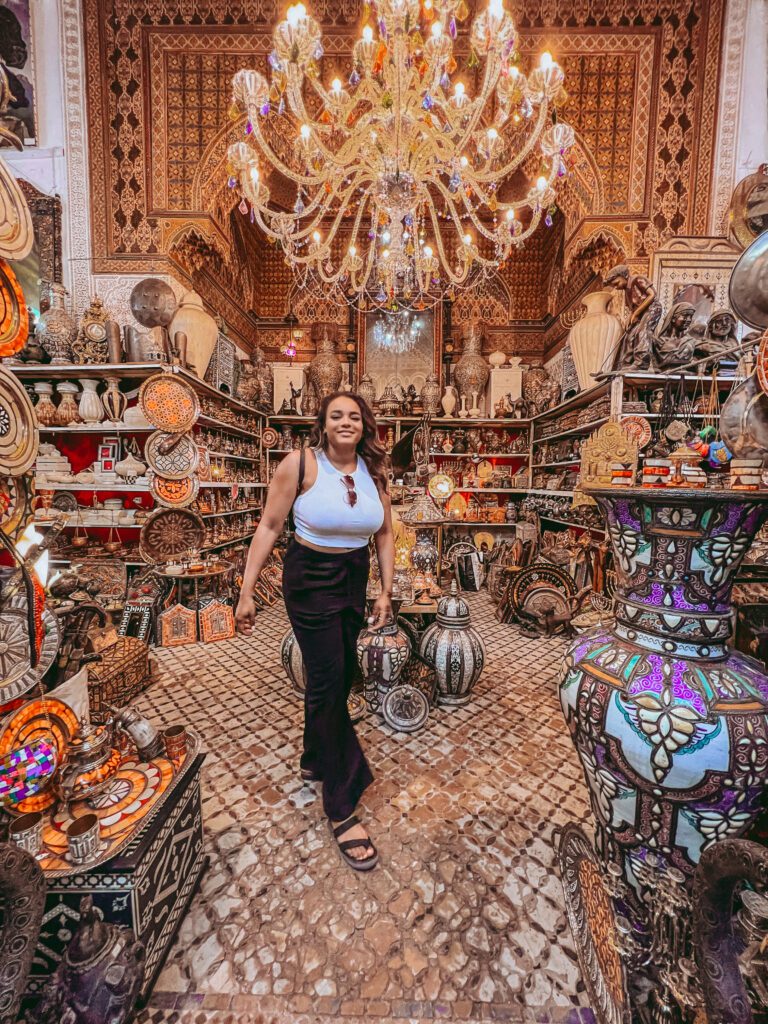
If you want to make sure you don’t miss anything, there are a number of guided tours available. This free walking tour will take you to all the must-see sights in the Medina, as well as some hidden gems that most tourists don’t know about. You’ll hit up some of the best markets, learn about the history and culture of the area, and get an insider’s look at life in the Medina.
The best way to see the Medina is by simply walking around and getting lost. Getting lost in the Medina is all part of the experience, and it’s honestly the best way to get to see the true authentic side of the city.
On my recent trip here, we ended up getting lost in the medina while looking for the restaurant that we had dinner reservations at. We wandered down the narrow alleyways, taking in the sights and sounds of this vibrant city.
We ran into a group of young boys playing soccer, who kicked the ball to my friend who eagerly accepted the invitation to play for a few minutes. We ended up finding the restaurant, but not before getting completely turned around and spending a good hour or so exploring the Medina.
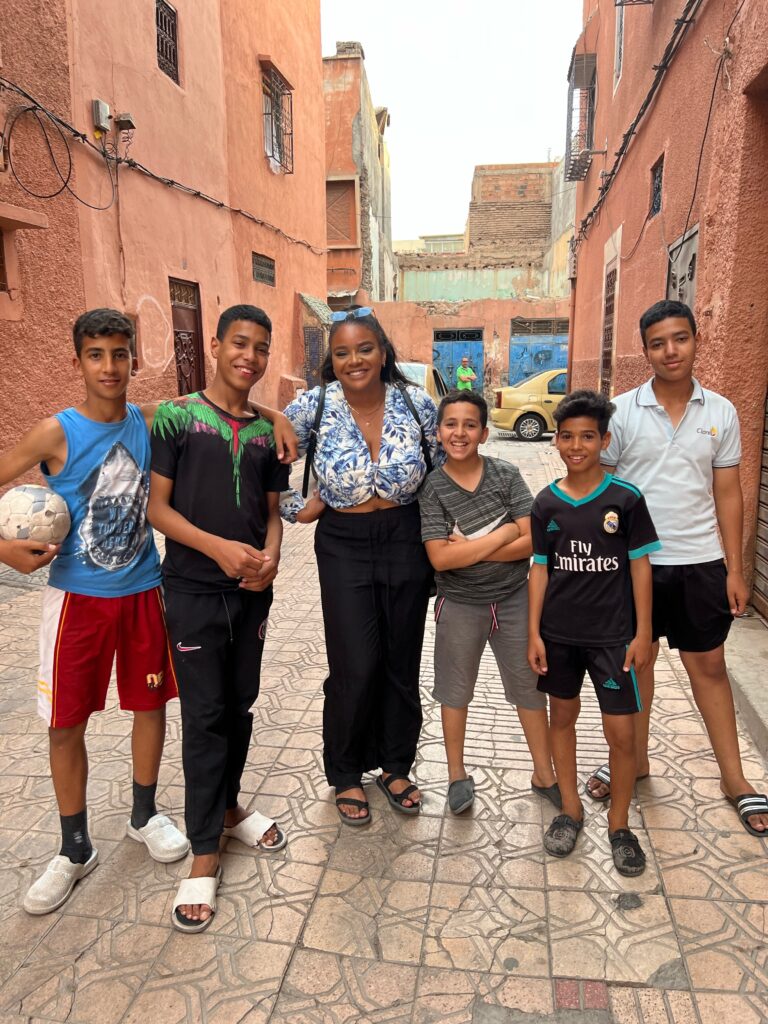
So, if you find yourself in the Old City of Marrakech, don’t be afraid to get lost. It’s all part of the fun!
Just make sure to keep your wits about you and carry only small amounts of cash. Though crime is generally pretty low here, pickpocketing and petty theft is common in heavy tourist areas like this one.
3. Explore Djemaa el-Fna
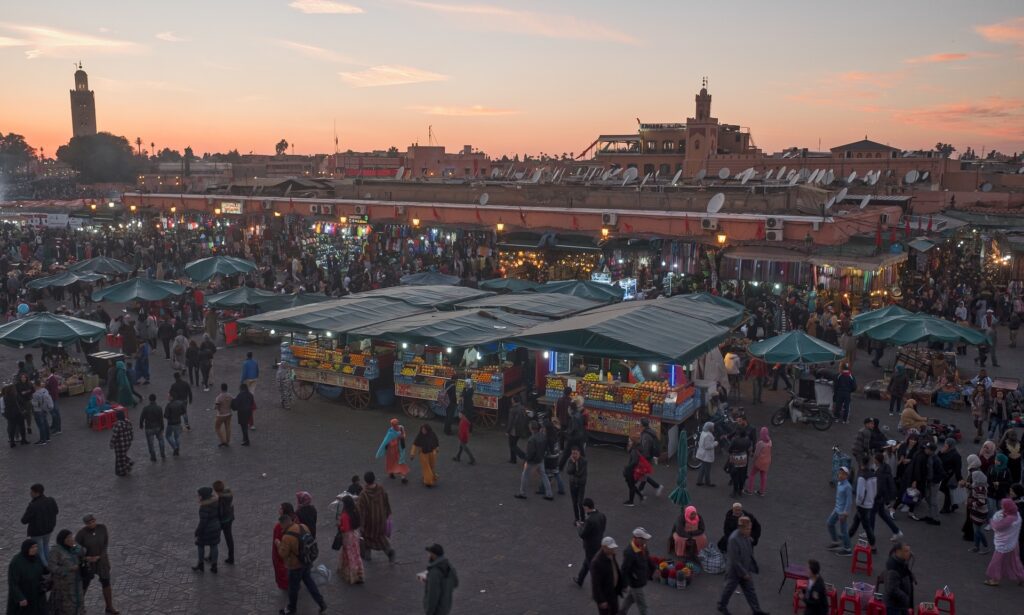
Djemaa el-Fna is the central square of Marrakech, and it’s a hive of activity day and night. By day, you’ll find snake charmers, acrobats, and fortune-tellers, while at night the square comes alive with food stalls serving up delicious Moroccan fare.
This main square is one of the most popular Marrakech attractions due to its vibrant atmosphere, and it’s the perfect place to people-watch and soak up the local culture.
If you want to get a henna tattoo while in Marrakech, this is definitely the place to do it! Henna artists can be found all around Djemaa el-Fna, and they’ll usually have a portfolio of designs for you to choose from.
Prices for henna tattoos start at around 100 dirhams (about $10 USD), and they usually take about 15 minutes to complete.
Note : These henna tattooers will 100% try to swindle you into paying a higher price if they realize you’re a tourist.
One lady tried to get me to pay 60 EUROS for a Henna tattoo after she had finished it and refused to let me leave! I stood my ground and eventually talked her down to $30 (which was frankly still too expensive) but I was over it by that point and just wanted to leave.
Sellers here will try to haggle with you, so it’s best to always agree on a price before they start tattooing.
Sometimes they will even try to charge you more than you agreed upon after they’re finished, so be firm and only pay what you agreed to.

Make sure to visit Djemaa el-Fna at night, when it really comes alive!
The square is really popular and therefore extremely crowded in the daytime, which can be a bit overwhelming. I visited both during the day and around sunset, and I can 100% say that the evenings here were much better!
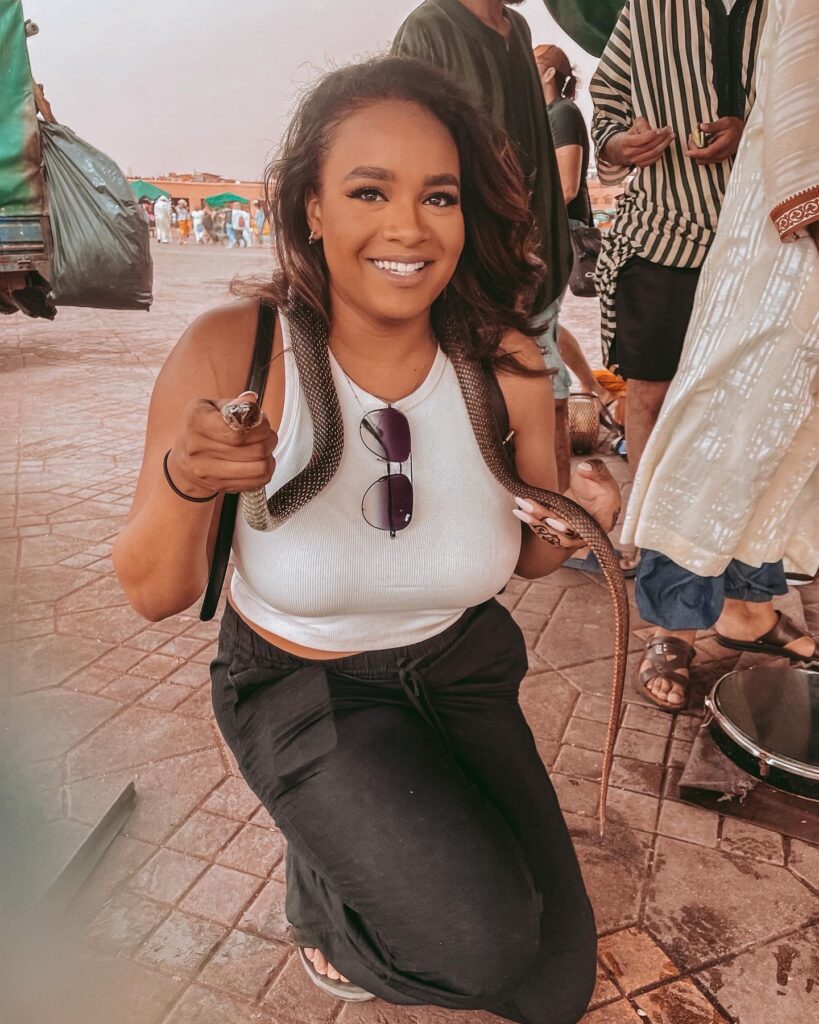
Not only is the sun not beating down on you relentlessly, but the square is also much more lively and atmospheric at night. The best time to go is around sunset, when you can watch the square transform from a busy marketplace to a lively entertainment hub.
There are also plenty of food stalls to choose from here, serving up everything from grilled meats to fresh fruit juices. I highly recommend trying a fresh fruit juice from one of the many stalls here!
You can choose from fruits like strawberry, mango, pineapple, watermelon, and even avocado! You can even mix together two fruit juices if you wish (I highly recommend the strawberry-mango!).
Aside from the fruit stands, there are also stalls serving up Moroccan staples like tagines and couscous. The Djemaa el-Fna square is one of the best places to try all the traditional foods of Morocco in one place! You can explore all the street food stands on your own, or take a guided tour.
This 3.5-hour food tour of Djemaa el-Fna costs $50 USD per person and includes a guided tour of the square, where you’ll learn about the exotic spices and flavors used in Moroccan cuisines, like saffron, anise, and cumin. Your expert guide will show you around all the different stalls of the market and you’ll get an up-close look at how locals haggle at the meat markets, as well as see the traditional bread-making process.
You’ll also get to try a variety of dishes, including a traditional Berber meal of ghoulal, a soup cooked with snails! To top it off, you’ll enjoy a traditional Moroccan dinner while enjoying the show of the performers in the square.
This tour is a great way to learn about the culture and cuisine of Marrakech in one go!
4. Visit the Saadian Tombs
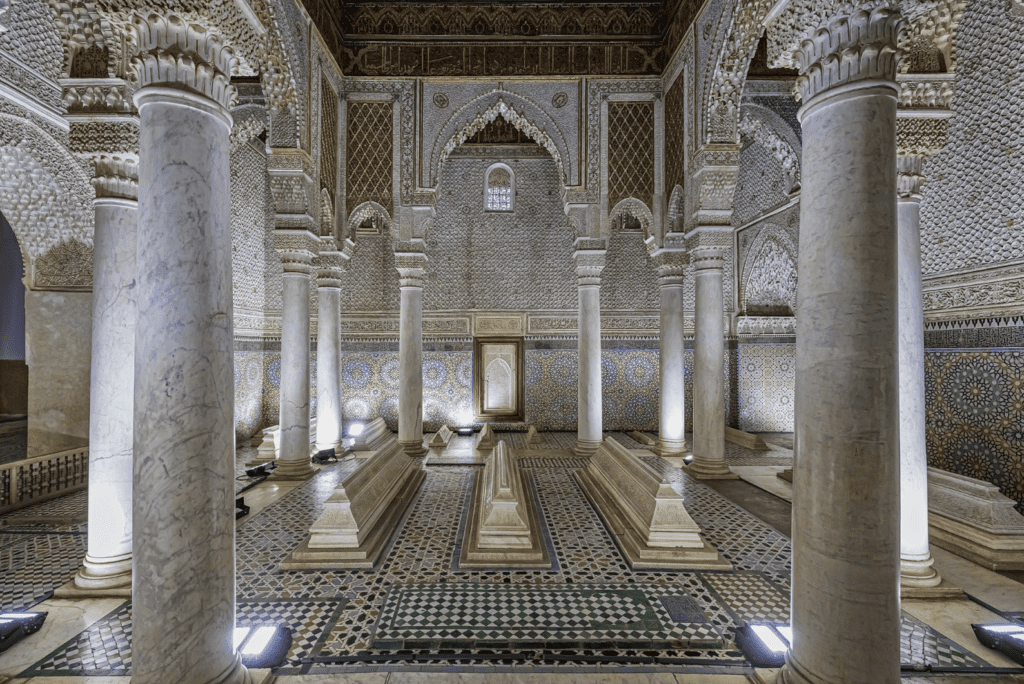
The Saadian Tombs are the final resting place of the rulers of the Saadian dynasty, and they date back to the 16th century. The tombs are beautifully decorated with intricate carvings and tile work, and they’re definitely worth a visit.
At the tombs, you’ll find the bodies of more than 60 members of the Saadian dynasty, as well as their servants and concubines. The walls of the tombs are lavishly decorated with arabesque carvings and intricate Islamic calligraphy, which date back to the 1600s. The Saadian Tombs are one of the best-preserved examples of Islamic art in Morocco, and they’re definitely worth a visit!
The Saadian Tombs are located in the historical city center of Marrakech, just a few minutes’ walk from the Jemaa el-Fna square. They’re open every day from 9am to 5pm, and admission costs 70 dirhams (about $7 USD).
Note: The lines here tend to get long in the afternoon, with tourist groups lining up to view Al Mansour’s chamber. Try to get here right at opening time or later in the day – the afternoon light is the best time for photos here, as the light reflecting off the marble walls is simply gorgeous!
5. Check out the Bahia Palace
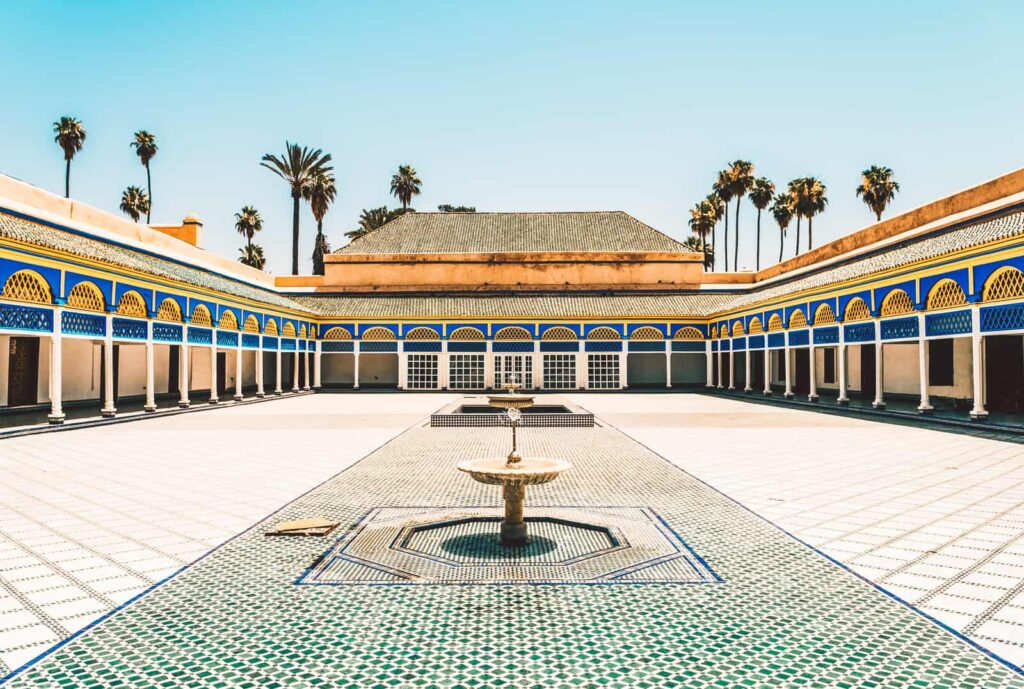
The Bahia Palace is one of the most beautiful buildings in Marrakech, and it was once the home of a powerful Moroccan ruler. Built in the late 19th century, the palace was designed to be the ultimate luxury home, and is spread across two acres in the heart of the bustling Marrakech medina.
The palace features over 150 rooms, which are all lavishly decorated with intricately carved woodwork, tiled floors, and colorful mosaics. The Bahia Palace is definitely worth a visit if you’re interested in Moroccan architecture and design! It has housed a number of important Moroccan figures over the years, and has previously hosted events such as the Marrakech Biennale.
The palace is now open to the public, and it’s definitely worth a visit for its stunning architecture and botanical gardens.
The Bahia Palace is located in the historical city center of Marrakech, just a few minutes’ walk from the Jemaa el-Fna square. It’s open every day from 9am to 4pm, and is closed on religious holidays. Entrance to the palace is about 70 dirhams ($7 USD).
6. Browse the Souks
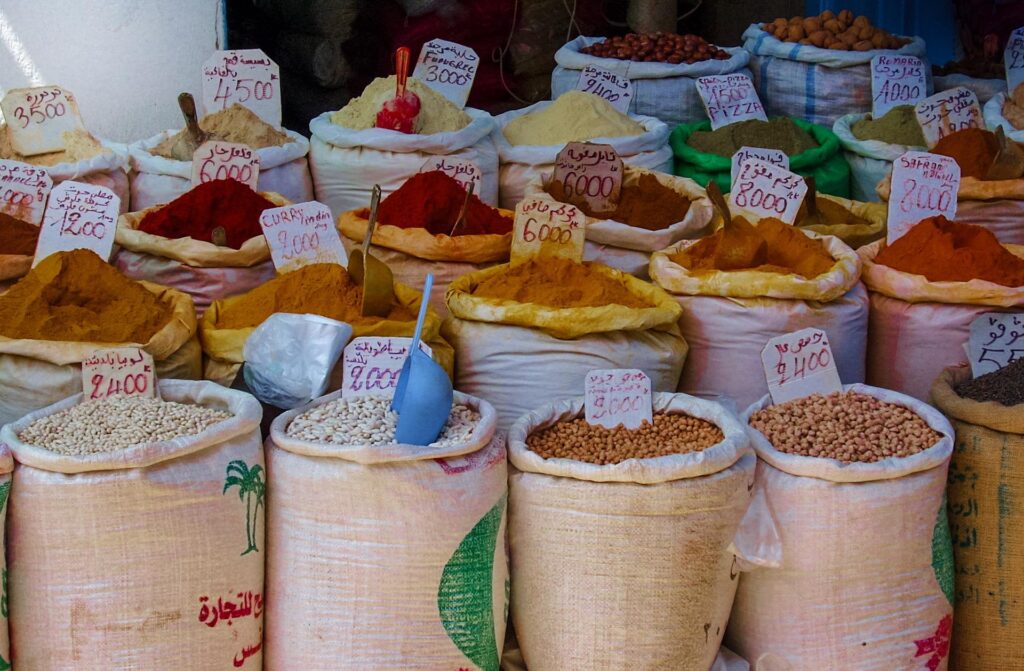
Marrakech is famous for its souks (markets), where you can find everything from spices and leather goods to handmade jewelry and lanterns. Haggling is expected (and even encouraged), so don’t be afraid to bargain for a better price! Some common things you’ll find in the souks are spices, herbal remedies for illnesses, Morocco’s famous Argan oil, and handmade Berber carpets.
I got so many goodies from the markets, including a beautiful Moroccan-style lantern, some hand-embroidered towels, and a silver necklace. I even bought some traditional Moroccan mint tea, a spice blend, authentic argan oil, and traditional black soap and an exfoliating glove that they use in the hammams to bring back home with me.
The best time to visit the souks is in the morning, when they’re less crowded and the air is cooler. However, be aware that many of the shops don’t open until later in the day (around 10am), so you may not find much to do if you’re an early riser.
There are a few different souks in Marrakech, but the most popular ones are the Souk el-Kebir (the main market) and the Souk de la Médina (the old city market). The Souk el-Kebir is located in the heart of the medina, while the Souk de la Médina is located just outside the walls of the old city.
7. Wander around Koutoubia Mosque
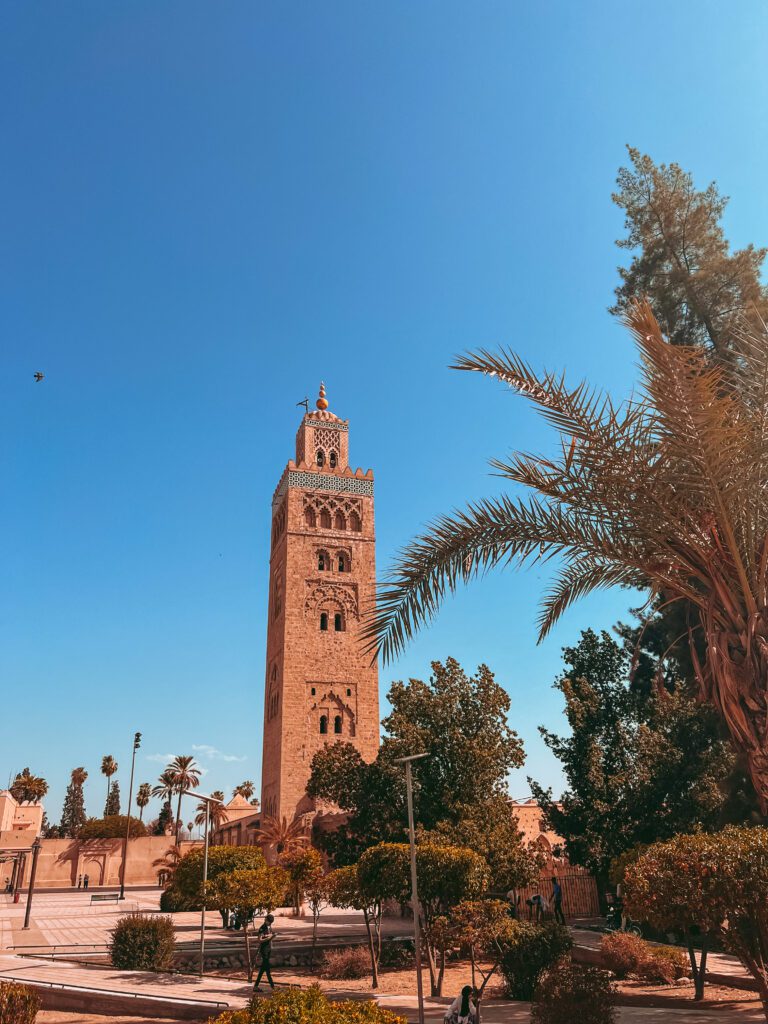
The Koutoubia Mosque is the largest mosque in Marrakech, and its minaret is the city’s highest point. This mosque is one of the most important landmarks in Marrakech, and it’s definitely worth a visit – even if you’re not religious.
The mosque was built in the 12th century, and its minaret is 77 meters (253 feet) tall. The minaret tower was actually initially displeasing to the Muslim people of Marrakech, as they felt that the tower did not at all resemble Mecca like it was intended to. The tower was redesigned a few centuries later to make it more like the mosques in Mecca, and today it’s one of the most iconic landmarks in Marrakech.
Five times per day, you can hear the muezzin doing the call to prayer from the mosque – it’s a really beautiful and atmospheric experience. There’s even an arrow at the top of the minaret that points in the direction of Mecca, so that locals know which direction to pray to when they hear this call.
The mosque is open to the public and tourists are welcome, but visitors are expected to dress modestly (no shorts or tank tops) and remove their shoes before entering. Even if you don’t go inside, it’s worth walking around the exterior of the mosque to see its beautiful architecture up close.
The Koutoubia Mosque is located in the center of the medina, just a few minutes’ walk from the Jemaa el-Fna square. It’s open every day from sunrise to sunset, and admission is free.
8. Take a bike tour of Marrakech
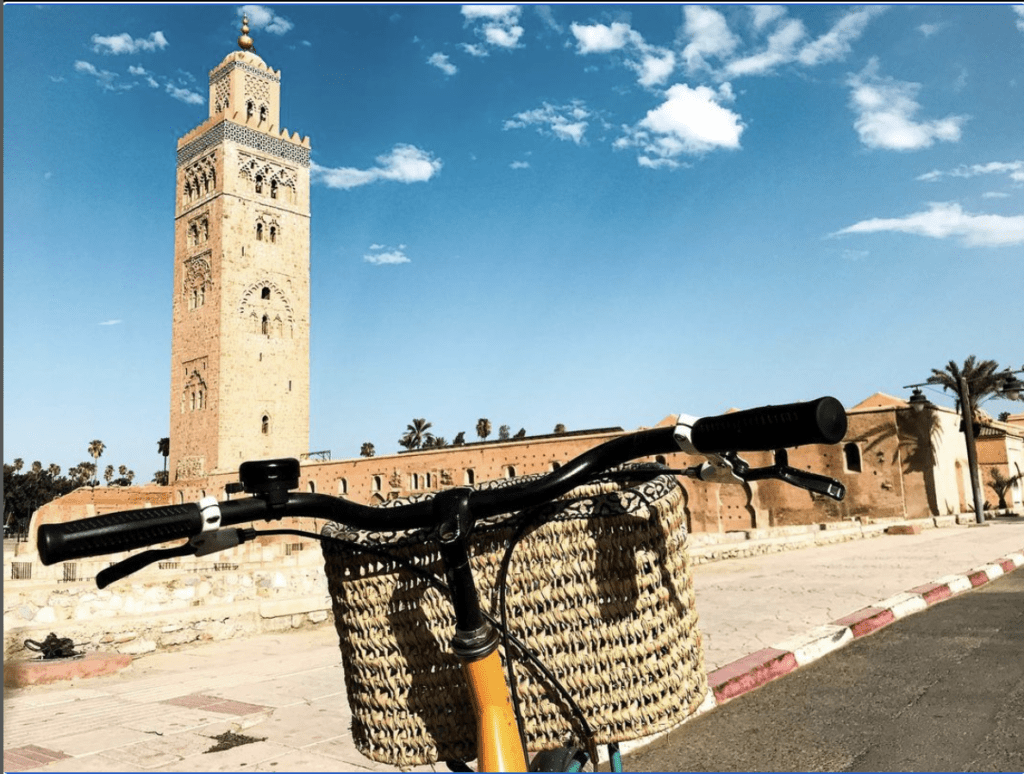
A bike tour is a fun and unique way to see the city while getting some exercise in! Ab bike tour here will usually take you through the Medina (old city) and includes stops at all of the major sights, including the Djemaa el-Fna square, the Saadian Tombs, and the Bahia Palace.
I did this bike tour on my trip to Marrakech and absolutely loved it! Admittedly, I’m not the most sporty person, so initially I was skeptical when my friend told me that he’d booked this 3-hour bike tour of the city. Not only that, but the day we booked the tour for happened to be 106 degrees (46 C) – the hottest day of our entire trip!
I honestly wasn’t sure that I would enjoy this bike tour due to the heat and trying to navigate and busy and bustling city like Marrakech, but it truly ended up being one of the highlights of my trip. Despite the heat, the tour was a lot of fun and a great way to see the city!
Our guide, Fatuma, was very knowledgeable about the history of Marrakech and made sure to include plenty of stops for photos. She was very sweet and friendly, asked us tons of questions about ourselves, and was really interested in getting to know us better. She made sure to go at our own pace and was always happy to stop and answer any questions we had. We even got to try some traditional Moroccan mint tea halfway through the tour, and stop at a community bread-making oven to see the process and try some fresh bread!
The bike tour lasts 3.5 hours and costs $31 USD per person and includes bottled water, juices, and Moroccan sweets at a local cafe, a local guide, and your bike, helmet, and safety equipment. I would highly recommend booking this tour for anyone visiting Marrakech, especially if you’re looking for a unique way to see the city.
9. Try traditional couscous and tajine
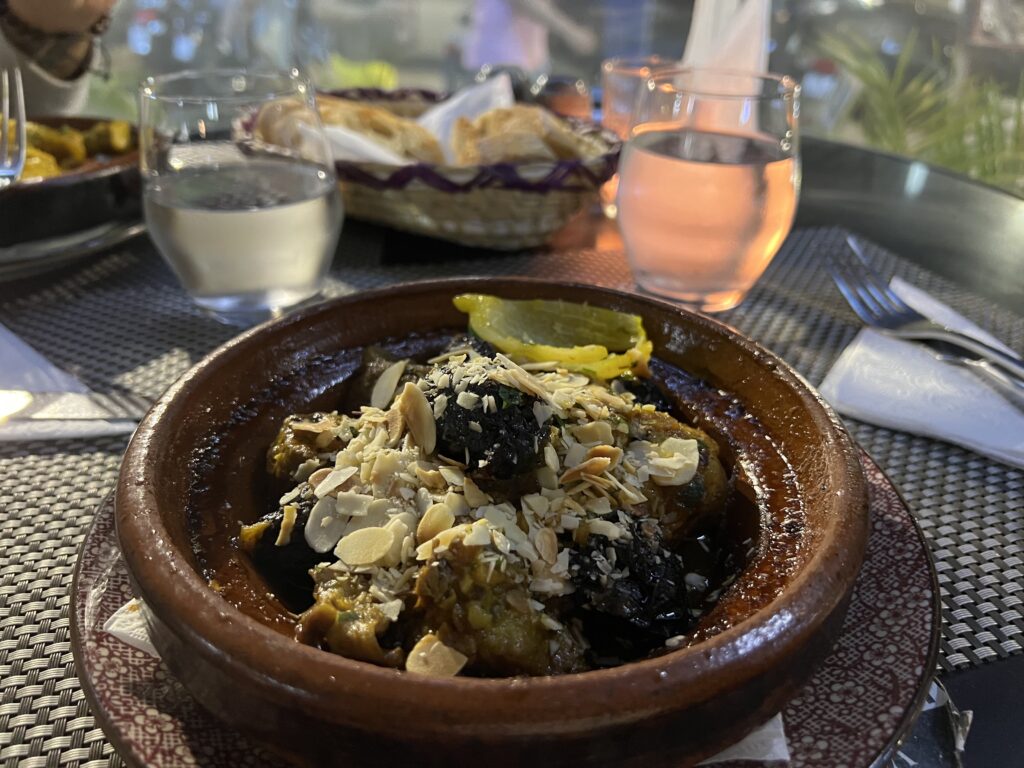
If you take a trip to Morocco and don’t eat couscous and tajine… did you really even go? Couscous is a type of grain that’s commonly served with vegetables and meat, while tajine is a slow-cooked stew that’s usually made with chicken or lamb. Both dishes are incredibly flavorful and definitely worth trying! Couscous takes a long time to prepare so traditionally, it’s only served in Morocco on Fridays. However, you can usually find it being served in restaurants all week long. Tajine, on the other hand, can be found being served any day of the week.
Morocco’s food culture has been influenced by a variety of different cultures over the years, including Arab, Berber, French, and Spanish. This can be seen in the diversity of Moroccan cuisine, which includes a wide variety of both sweet and savory dishes.
However, there are a few things that you should know before ordering couscous or tajine in Morocco. Firstly, portions are usually very large, so it’s meant to be shared among a group. Secondly, it’s considered impolite to leave food on your plate, so make sure to eat everything! And lastly, always use your right hand when eating, as the left hand is considered unclean.
Now that you know a few things about Moroccan cuisine, go out and enjoy some delicious couscous and tajine! The food here was some of the best I’ve ever had, and I would definitely recommend trying more than just the traditional couscous and tajine if you have the chance, but these two dishes are certainly a good place to start.
10. Trek through the Atlas Mountains
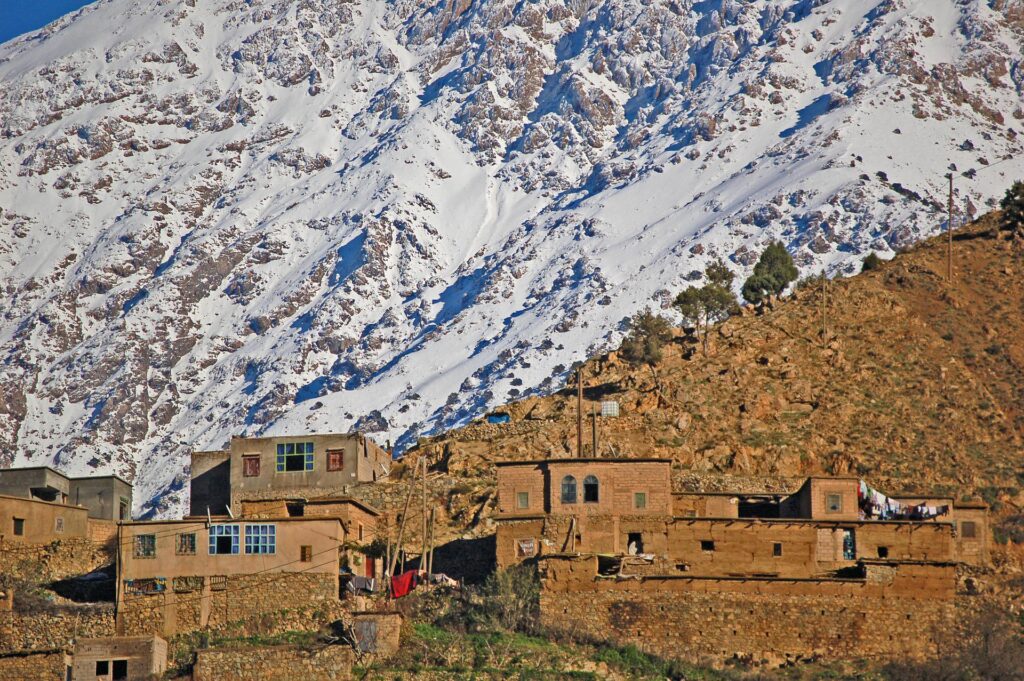
The Atlas Mountains of Morocco are a stunning mountain range that stretches for over 1,000 miles (1,600 kilometers) across the country, from the Moroccan port city of Agadir to Tunis, the capital city of Tunisia. The mountains are home to the traditional Berber people, as well as a variety of wildlife, including Barbary macaques, Barbary apes, and leopards.
There are a number of trekking routes through the Atlas Mountains, ranging from easy one-day hikes to multi-day treks that require some mountaineering experience. No matter what your level of fitness or experience, there’s a trek for you!
I did a two-day trekking trip through the Atlas Mountains on my trip to Morocco, and it was one of the most amazing experiences of my entire life. The scenery was absolutely breathtaking, and I loved getting to experience a different side of Morocco that I wouldn’t have otherwise seen. My favorite part of the trek was camping overnight in a traditional Berber hut, where we got to sleep on the floor and eat dinner with our guide’s family. It was an incredible experience that I will never forget!
If you’re interested in doing a trekking trip through the Atlas Mountains, I would highly recommend this 3-day hiking tour of the Atlas Mountains . It’s a great option if you’re looking for a guided tour and have a few days to spare. Over the span of three days, you’ll be immersed in the High Atlas Mountains’ natural vistas and unique Berber settlements and trek through mountain passes, gorges, and woods alongside an expert hiking guide. You’ll also have the chance to stop by the towns of Imlil, Tinerhourhine, and Aït Aïssa; and take in the breathtaking views from heights of over 7,874 feet (2,400 meters)! The tour starts at $145 USD per person and includes a three-day hiking tour with a guide, three meals per day, accommodation in the Atlas Mountains, and roundtrip transportation from Marrakech.
If you’re not up for a hike, there are plenty of other things to do in the Atlas Mountains. You can go horseback riding, take a camel ride, or even go skiing in the winter! You can even take a day trip to the Atlas Mountains from Marrakech if you don’t have time for a multi-day trip.
11. Visit Aït Benhaddou, a UNESCO World Heritage Site
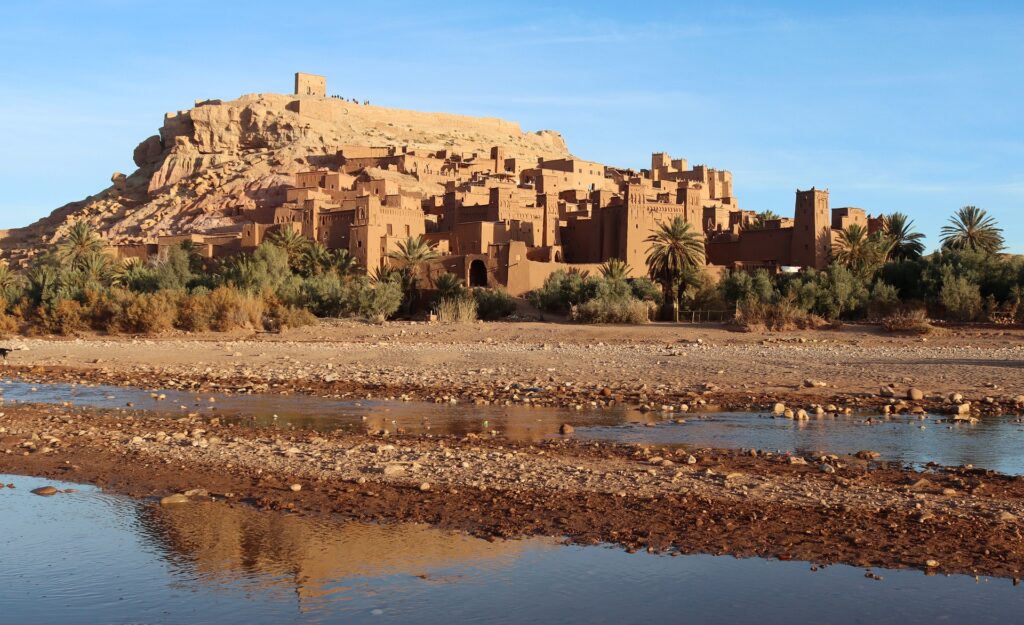
Aït Benhaddou is a fortified city (or ksar) in southern Morocco that has been designated as a UNESCO World Heritage Site. The city is located on the old caravan route between the Sahara Desert and Marrakech, and it was once an important stop for traders travelling through the region.
Today, Aït Benhaddou is a popular tourist destination due to its well-preserved architecture and stunning location at the base of the Atlas Mountains. The city is home to a number of traditional Moroccan buildings, including kasbahs (fortified homes), mosques, and palaces.
One of the most popular things to do in Aït Benhaddou is to take a day trip from Marrakech. The drive from Marrakech to Aït Benhaddou takes about four hours, and you’ll have plenty of time to explore the city and its surroundings. This day trip to Aït Benhaddou will pick you up from your hotel in Marrakech and take you on a guided tour of the city. You’ll learn about the history of Aït Benhaddou and get to see some of its most important sights, including the kasbah, the souk (market), and the mosque. You can even add on an optional camel ride through the desert for only $10 USD extra and/or a traditional Moroccan lunch to your experience.
The day trip costs $144 USD per person and will last about 10-12 hours. It includes roundtrip transportation in an air-conditioned van, a guided tour of the ksar, and entrance fees to the UNESCO site.
12. Explore the Yves Saint Laurent Museum
The Yves Saint Laurent Museum of Marrakech is a must-visit for any fashion lover. The museum is dedicated to the life and work of famed fashion designer Yves Saint Laurent, who was born in Algeria and spent many years living in Morocco.
The museum is located in the Jardin Majorelle, a beautiful garden that was once owned by Saint Laurent himself. In addition to Saint Laurent’s fashion designs, the museum also features a number of other exhibitions, including a look at his personal life and his work in film and theatre.
The Yves Saint Laurent Museum is open every day from 10:00am to 6:00pm, and tickets cost $15 USD per person. You can also buy a combined ticket that includes entrance to the museum and the Jardin Majorelle for $20 USD.
13. Eat your way through Marrakech on a food tour
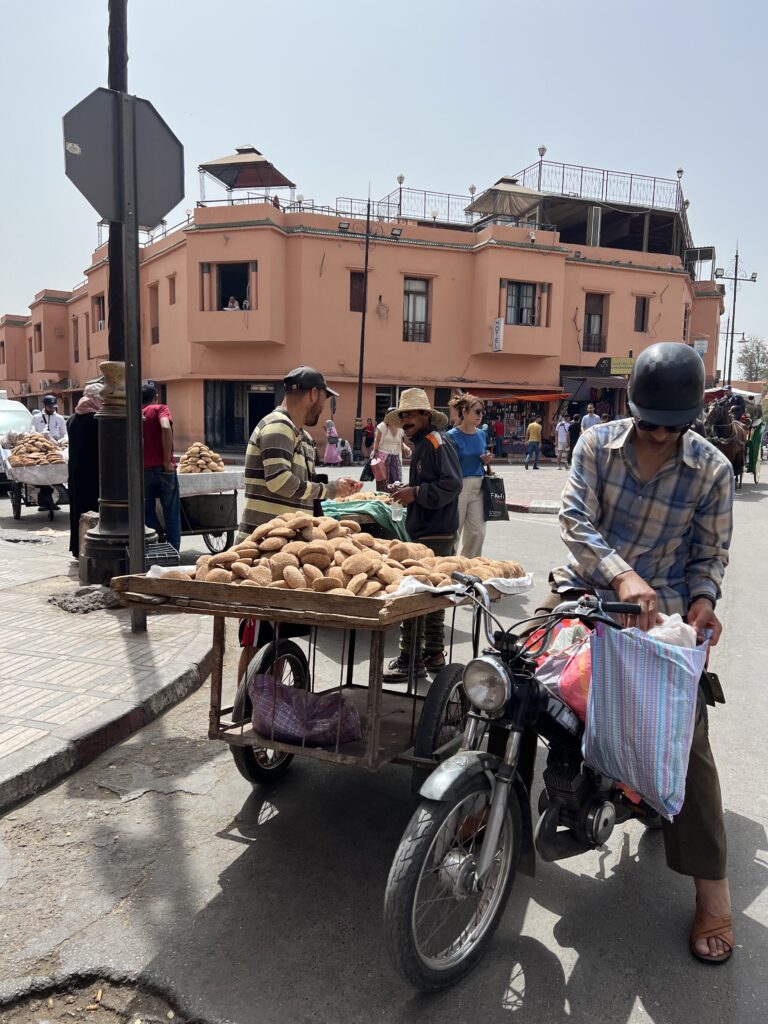
You know what I like to say, the best way to explore a new city is through its food! And Marrakech is a city that definitely doesn’t disappoint when it comes to food. From traditional Moroccan cuisine to international dishes, there’s something for everyone in Marrakech.
If you want to learn about the different types of food available in Marrakech and get a taste of some of the best dishes the city has to offer, then you need to take a food tour! This Marrakech food tour will take you to more than 10 of the best places to eat in the city, including a traditional Moroccan restaurant, a local market, and a bakery.
You’ll get to try a wide variety of Moroccan dishes, including tagine (a type of stew), couscous, and pastilla (a meat pie). And of course, no food tour would be complete without a few sweet treats! You’ll get to try some traditional Moroccan desserts, like baklava and khboz (a type of flatbread). After your tastings, you’ll finish the tour off with a delicious 3-course Moroccan dinner and a cup of traditional hot Mint tea.
This is a great opportunity to eat like a local and learn about hidden food spots of Marrakech that you’d probably miss if you were exploring on your own. It’s a small-group experience that’s capped at 12 people, so you’ll have plenty of time to ask questions and chat with your guide. The tour costs $50 USD per person and includes all food and drink and an English-speaking guide. It lasts approximately three hours.
14. Go shopping
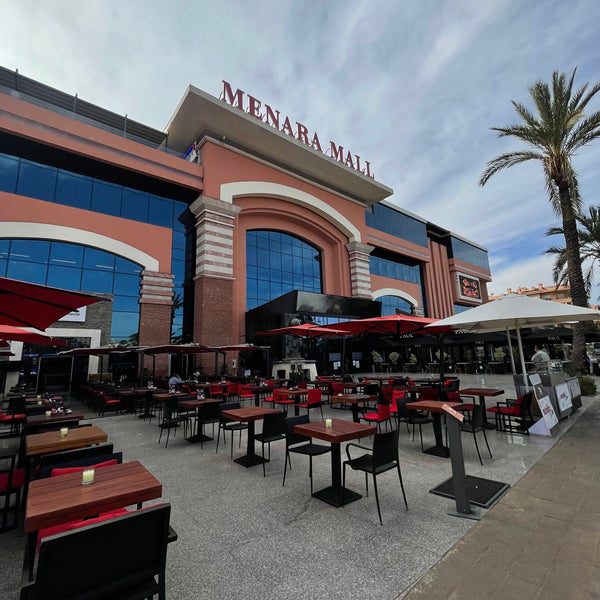
My toxic trait? I have to go shopping in every city I visit. It’s a serious problem, but I just can’t help myself! Thankfully, Marrakech is the perfect place to indulge in my shopping addiction.
Not only is the city full of souks (marketplaces), where you can find everything from handcrafted Moroccan furniture to traditional Berber clothing, but there are tons of department stores and malls as well.
If you’re looking for a more traditional shopping experience, then you need to head to the souks. My favorite souk in Marrakech is the Souk des Teinturiers, also known as the Dyers’ Market. This market is dedicated to all things textile, and you’ll find everything from handwoven rugs to colorful silk scarves.
If you’re looking for something a little more modern, then you can head to one of the city’s many malls. The Menara Mall is the largest mall in Marrakech and features over 90 stores, restaurants, and cafes. Some classic stores like Zara, H&M, and Stradivarius have outlets here, as well as a number of Moroccan brands.
Something I didn’t know until coming here, is that the markets in Marrakech are also filled with tons of fake designer bags and shoes for sale. So, if you’re looking for a fake Louis Vuitton or Gucci bag, this is the place to get it! Of course, not everyone is into that, but I know that some of you are, so I thought I would mention it. You can even find shoes and belts with designer logos like Nike, Adidas, Yeezys, and Balenciaga.
15. Ride camels in the desert

This is definitely the highlight of any trip to Morocco! A camel ride in the Sahara Desert is an experience you’ll never forget. Camels have been used for transportation in the desert for centuries, and there’s no better way to see the Sahara than on the back of one of these gentle giants.
There are tons of tour companies in Marrakech that offer camel rides, both in the desert and in the city. Camel rides can also be arranged through most hotels in Marrakech. Prices vary depending on how long you want to ride for and how far into the desert you want to go, but you can expect to pay around $30-$50 USD for a one-hour ride.
The sunset camel ride I did wasn’t in the Sahara, but rather in a small village at the base of the Atlas Mountains. If you’re short on time, this is a great option as it’s only about an hour from Marrakech. I paid $40 USD for a one-hour ride and it was totally worth it! We learned a lot about camels, including how intelligent they are and how they can remember people’s faces for up to 20 years!
View this post on Instagram A post shared by WHERE TIANA TRAVELS (@tianabaaaby)
We were picked up from a central meeting point in Marrakech around 6pm by our local guide, and driven up to the mountains in an air-conditioned van. Along the way, we got to stop at a local spice shop and listen to explanations about the traditional herbal remedies they use to treat illness.
The tour also included a stop at an argan oil cooperative, where we learned about the history of argan oil and how it’s made. We also got to watch the women crack the argan nuts by hand and press the oil using a traditional method. It was really interesting to see how it’s done and to hear about the cooperative’s efforts to empower local women.
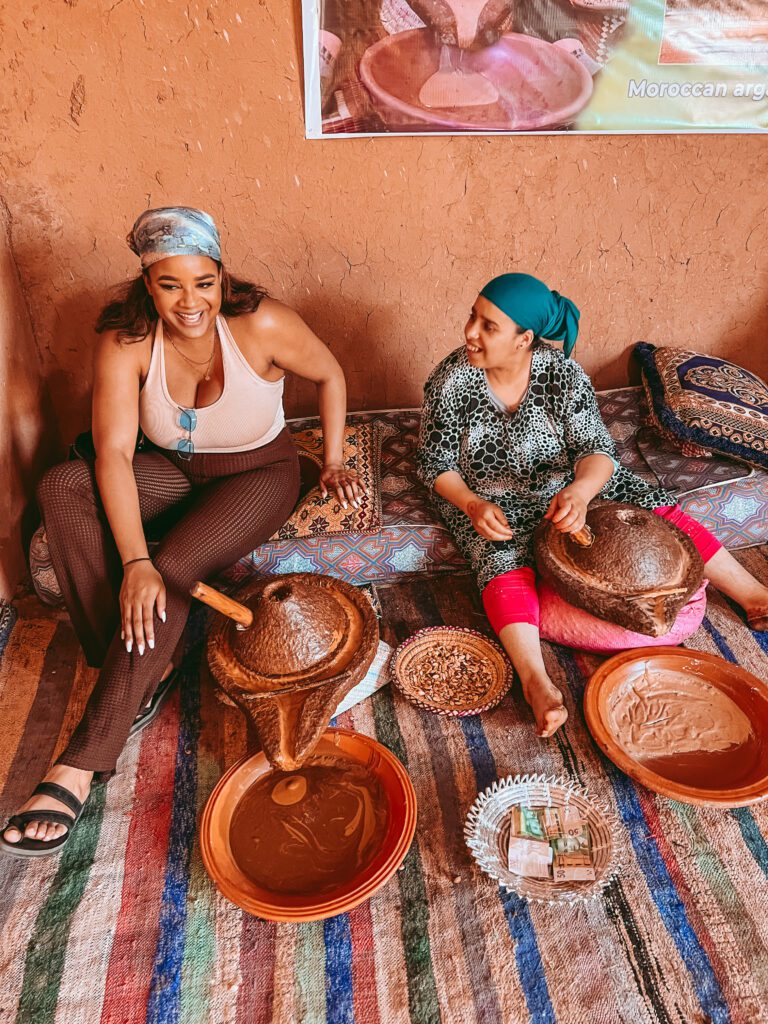
After the argan oil stop, we continued on to the desert. When we arrived at the camel stable, we were each given a camel to ride and our guide showed us how to mount and dismount. Then we set off into the desert! The views were absolutely incredible, especially as the sun was setting. We rode for about 45 minutes before stopping to watch the sunset over the sand dunes. It was truly a magical experience. After the sunset, we rode back to the stable and were given mint tea and Moroccan pastries.
If you want to really make the most of your camel ride, consider doing an extended camel trek and adding on an overnight stay in a desert camp. You’ll get to sleep under the stars, enjoy traditional Moroccan meals, and maybe even see the sunrise over the sand dunes. This 4-day private camel trekking experience gives you the chance to take in stunning views of Berber villages and scenic landscapes as you travel to the Dades Valley by camelback. You’ll pass through the oasis of Tafilet, the largest date palm grove in Morocco, meet local Gnaoua people, and camp in the Sahara Desert under a blanket of stars. The price for this private tour is $715 USD per person and includes all food, drink, camel rental, overnight accommodation in a desert camp, and transportation back to Marrakech.
Overall, I would highly recommend doing a camel ride if you’re visiting Marrakech! It’s a great way to see the desert and it’s definitely a once-in-a-lifetime experience.
16. Take a day trip to Essaouira
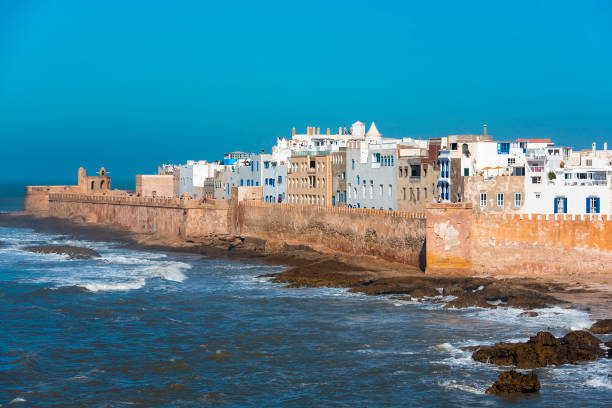
Essaouira is a beautiful coastal town located about three hours from Marrakech. It’s known for its stunning beaches, colorful fishing boats, and relaxed atmosphere. The Medina (old town) is a UNESCO World Heritage Site and is full of narrow streets, art galleries, and cafes.
There are several ways to get to Essaouira from Marrakech . You can take a bus, which costs around $10 USD, or you can book a day tour through a local tour company.
Or, if you just want transportation to Essaouira but don’t want to do the full tour, you can hire a private car to drive you from Marrakech to Essaouira for about $80 USD per group.
If you’re interested in taking a day trip to Essaouira, I would recommend booking a tour as it’s a long drive and it can be difficult to navigate if you don’t speak French or Arabic. Plus, the tours usually include stops at interesting places along the way that you might not otherwise see. Tours typically cost around $60-$70 USD and include transportation, a stop at an argan oil cooperative, and lunch. It’s definitely worth the money and you’ll get to see some beautiful scenery along the way!
On this 12-hour Essaouira trip , you’ll spend a full day in the seaside town of Essaouira. You’ll visit the old Medina, explore the ramparts and watch the fishermen bring in their daily catch. You’ll also have free time to relax on the beach, go shopping, or try some of the local seafood. The price for this tour is $25 USD per person and includes hotel pick-up and drop-off, transportation to Essaouira in a climate-controlled van, and a knowledgeable guide.
Essaouira is also a great place to test out your surfing skills! The town is known for its strong winds, which make it a popular spot for windsurfing and kitesurfing. If you’re interested in learning how to surf, there are several surf schools in Essaouira where you can take lessons. Prices vary, but expect to pay around $40-$50 USD for a two-hour lesson. This 3-hour surfing and kite-surfing experience is a great way to learn how to surf or kite-surf in Essaouira. You’ll have a professional instructor who will teach you the basics and then you’ll get to practice your new skills in the water. The price for this experience is $30 USD per person and includes all equipment rental, transportation, and a drink.
All in all, I would definitely recommend spending a day in Essaouira if you’re visiting Marrakech. It’s a beautiful town with a lot to offer, and it’s the perfect place to relax after exploring the bustling city of Marrakech.
17. Relax and refresh in a traditional hammam
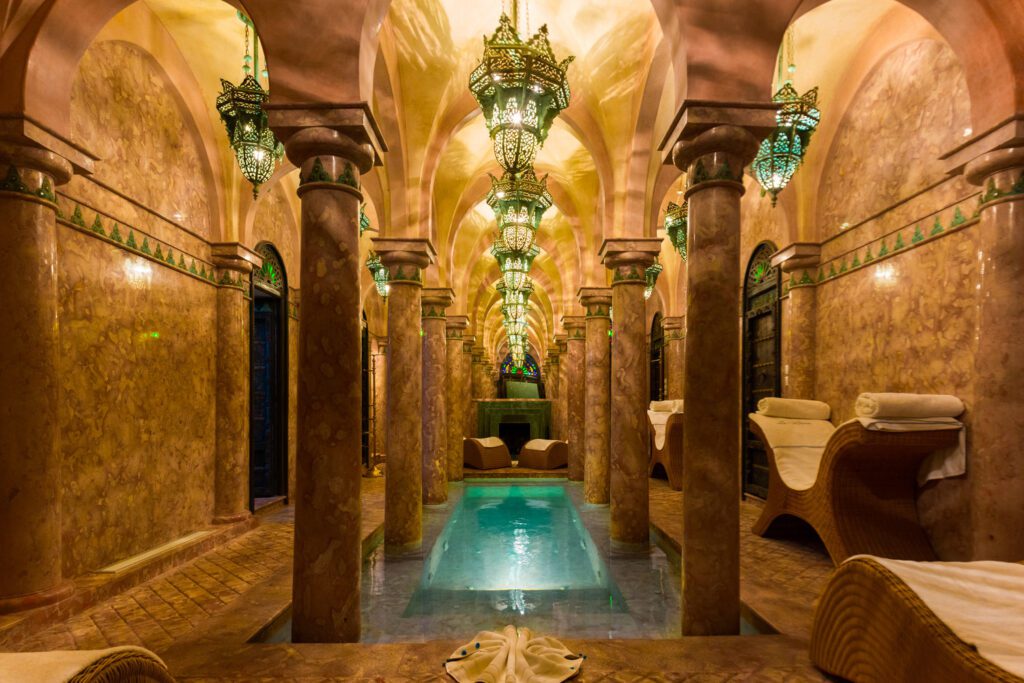
Morocco is well-known for its hammams, which are traditional bathhouses where you can relax and refresh your body and mind. Hammams usually have different areas for men and women, and they often have separate days or times when each gender can use the facilities.
Hammams have been used by Moroccan locals for centuries to cleanse the body, and they’re now becoming increasingly popular with tourists. Hammams typically use black soap, which is made from olives and Laurel, to cleanse the skin.
At the hammam, you’ll first undress and then wrap yourself in a cloth. You’ll then lie down on a heated marble slab and let the steam work its magic. After a few minutes, you’ll cover yourself in black soap and wait up to an hour for it to dry completely. Once it’s dry, you’ll scrub your body with a special exfoliating glove made for removing dead skin cells. After you’ve scrubbed your body, you’ll rinse off the soap and then lie down on the heated marble slab again to relax and let your skin absorb all of the nourishing properties of the black soap.
The whole experience usually lasts around an hour for men, but can take up to three hours for women, as they usually have their kids in tow as well and like to spend their time chatting with friends who are also visiting the hammam.
Hammams are a great way to relax and detoxify your body, and they’re an integral part of Moroccan culture. If you’re interested in experiencing a hammam while you’re in Morocco, I would recommend doing some research beforehand to find a reputable place. If you’re interested in experiencing a hammam, I would recommend going to one of the more well-known and reputable places in Marrakech, such as Les Bains de Marrakech.
Les Bains de Marrakech is a luxurious spa that offers a variety of services, including hammams, massages, and facials. The price for a traditional hammam experience starts at around $60 USD, and they also offer three other spa experiences that each increase in price.
If you’re looking for a more authentic hammam experience, I would recommend checking out Hammam Ziani. Hammam Ziani is a local bathhouse that has been in operation for over 400 years, and is a place where locals go about once per week to cleanse their bodies. The price for a traditional hammam experience at Hammam Ziani is only $10 USD, and it includes the use of a steam room, sauna, and cold plunge pool. This hammam is open daily from 8am to 10pm.
18. See Marrakech from the sky on a hot air balloon
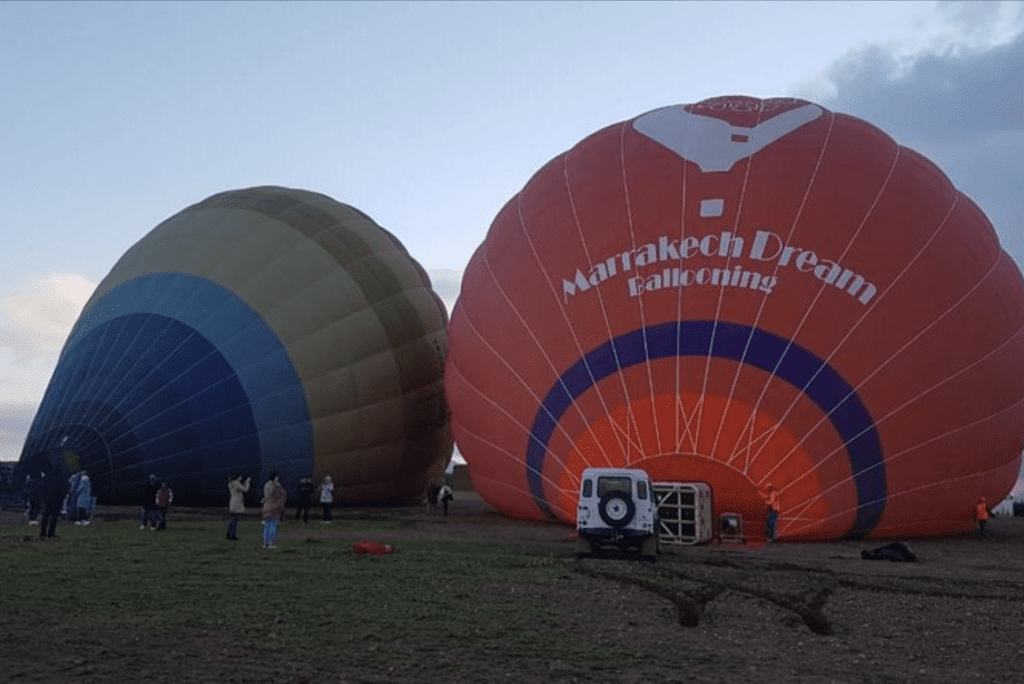
One of the best ways to see Marrakech is from above, and there’s no better way to do that than on a hot air balloon ride. This has to be without a doubt one of the coolest things to do in Marrakech.
There are a few companies that offer hot air balloon rides in Marrakech, but the one that I would recommend is Ballooning Marrakech . They offer both group and private hot air balloon rides, and the price for a group ride starts at $120 USD per person.
If you’re looking for a more immersive experience, this hot air balloon flight over Marrakech also includes an authentic Berber breakfast in a traditional Moroccan tent. After you spend some time relaxing and enjoying the views, you’ll be served a delicious breakfast of bread, Moroccan pancakes, honey, butter, and coffee. This experience costs $200 USD per person and includes pick-up and drop-off from your hotel, your flight in a hot air balloon, as well as breakfast after the ride.
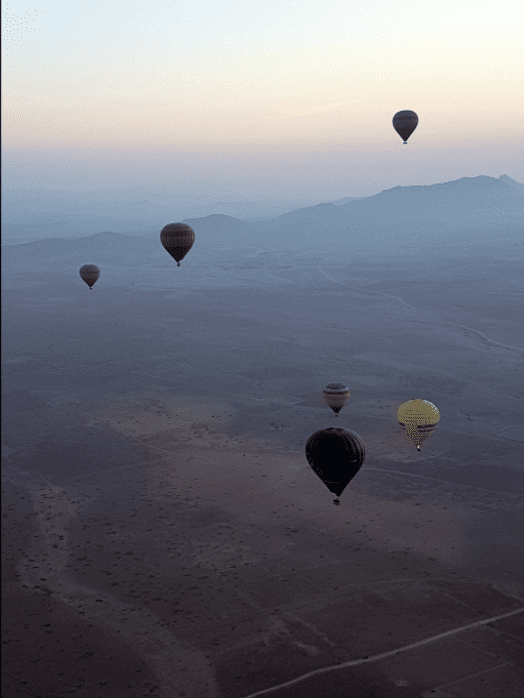
Hot air balloon rides are typically offered in the early morning hours, as that’s when the weather is the most stable. The whole experience usually lasts around three hours, and it’s an experience that you won’t soon forget!
If you’re looking for something unique to do in Marrakech, a hot air balloon ride is definitely something that you should consider.
I unfortunately didn’t have the time to do this on my most recent trip to Marrakech, but it is definitely on my to-do list for the next time I visit!
19. Take a cooking course
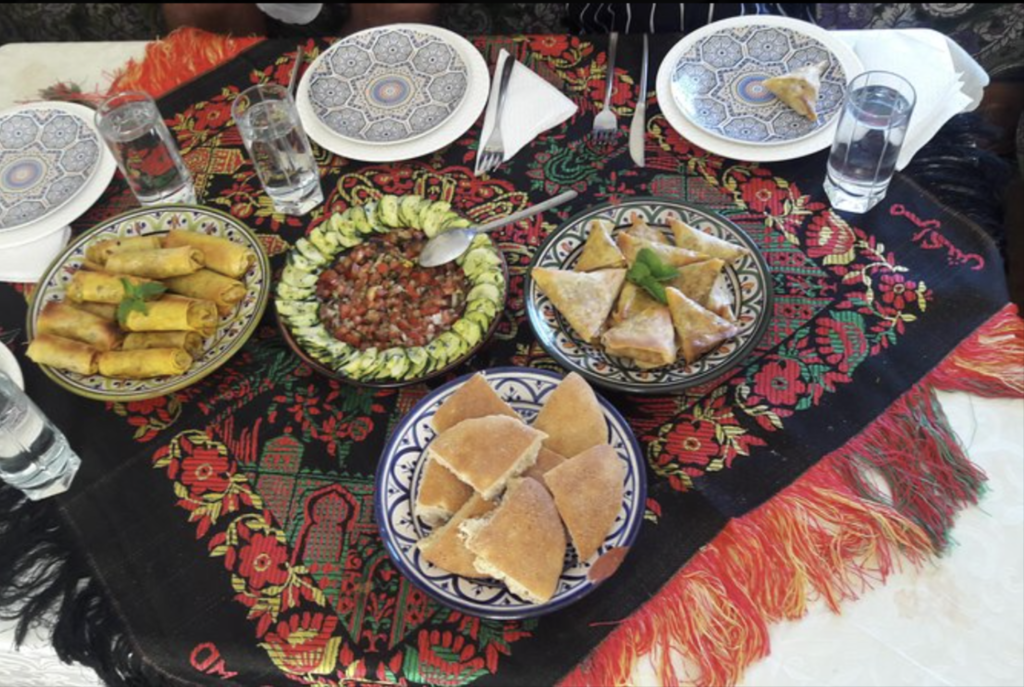
As we know, the fastest way to a man’s heart is through his stomach.
But the same can actually be said for women. Well, at least for me it can.
If you’re looking to impress your significant other, or just want to learn how to cook some authentic Moroccan food, I would recommend taking a cooking course.
Morocco is the origin place of so many amazing foods that we now enjoy all over the world. Think of dishes like couscous, tagine, and harira soup. All of these dishes originated in Morocco, and I’m sure that you’ve had at least one of them before, maybe even without realizing where it came from.
This cooking class is taught by a private Moroccan chef named Khmisa, who teaches both individuals and small groups. During the class, you’ll learn about Moroccan cuisine and culture, as well as how to cook some of the most popular dishes. The tour is accompanied by Kawtar, another Moroccan woman who is passionate about food and all things travel and tourism.
She will help you communicate with your guide and join you as you walk through the souks in search of fresh ingredients to use in your cooking. The cost for this cooking class is $45 USD per person, which includes a market visit to buy ingredients, as well as the cost of the food itself.
If you’re interested in learning how to cook some authentic Moroccan food, I would highly recommend taking a cooking course with Khmisa and Kawtar.
Not only will you learn how to cook some delicious food, but you’ll also get to experience the market and learn about Moroccan culture.
20. Spend a day by the pool at Nikki Beach
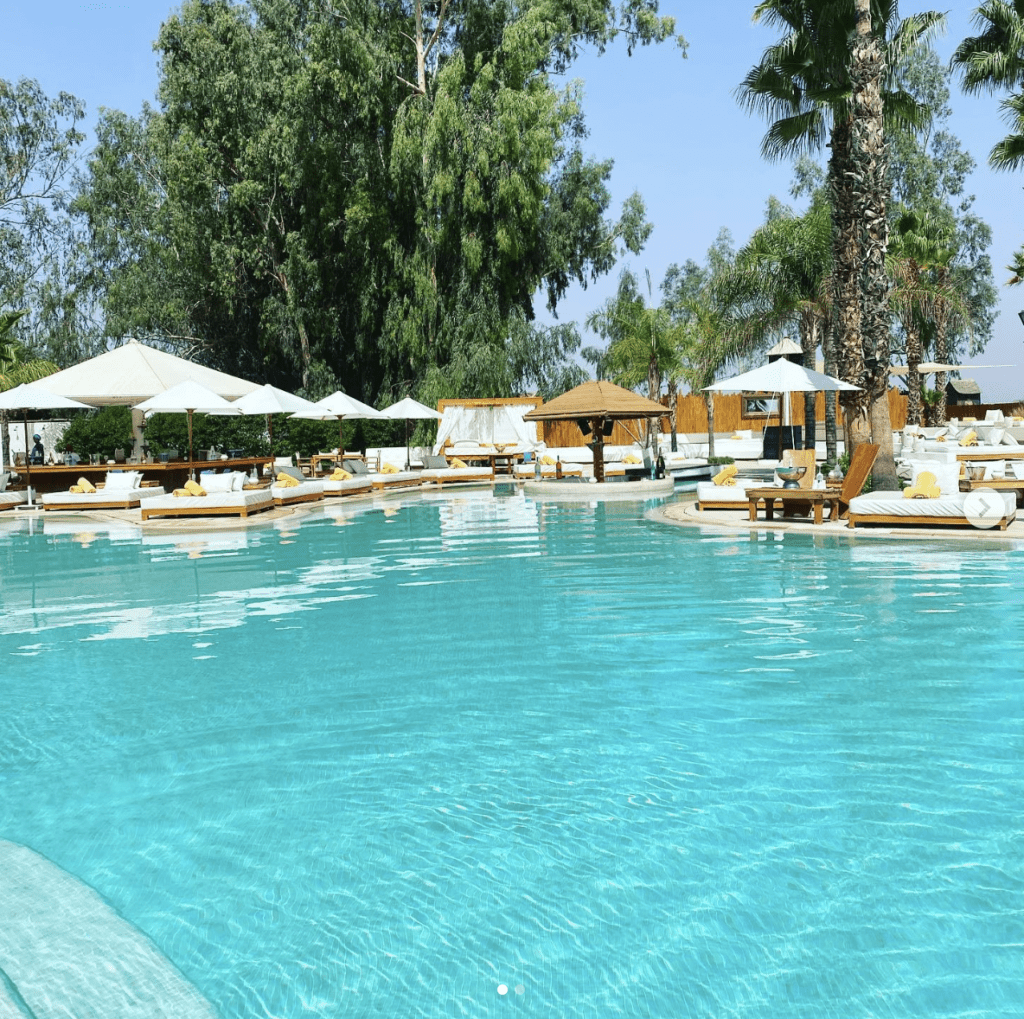
Marrakech is hot . Like, scorching hot .
So hot that sometimes the only thing you want to do is lounge by the pool with a refreshing drink in hand.
And there’s no better place to do that than Nikki Beach.
Nikki Beach is a luxury beach club that’s located just outside of Marrakech. It’s the perfect place to spend a day relaxing in the sun, swimming in the pool, and enjoying some delicious food and drinks.
If you want to add on a massage or other spa treatment while relaxing by the pool, you can do that for an additional cost.
You will have to pay an entrance fee to visit Nikki Beach, so be prepared to spend some cash.
A day pass to Nikki Beach depends on which section of the club you want to sit in. The cheapest option is their “Cannes” sun lounger area, which fits up to two people and costs $50 USD for the day, but also requires a $120 minimum spend on food and drinks once you get inside.
For $400 USD you can book the “Marrakech VIP” lounge section of the day club that can fit between 4 to 6 people and requires an additional minimum spend of $700 USD.
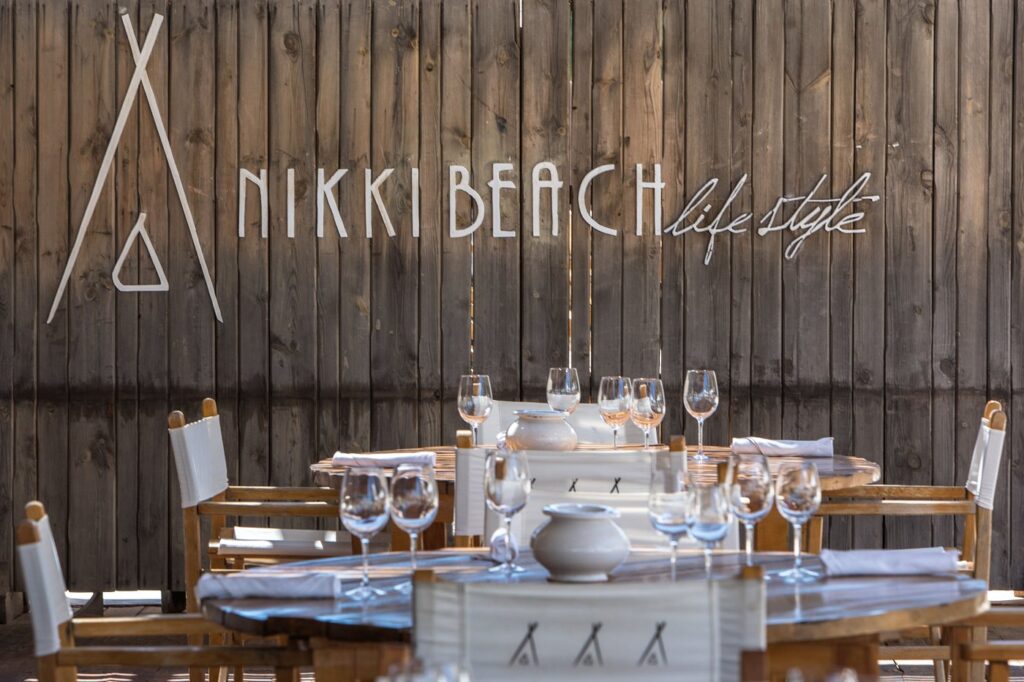
Or, if you’re feeling really indulgent, you can book a VIP cabana bed for the day, which is all-inclusive, with all-you-can-eat food, drinks, and shisha.
With this package, you’ll also have free access to all the services offered at the on-site spa. Prices for this VIP package require a $2000 USD minimum spend and can accommodate 6-7 people. You can find all their lounge bed options and prices on their website .
Nikki Beach also offers a variety of food and drinks on their menu , but it is honestly a bit expensive.
Prices per plate here are closer to prices that you would see at beach resorts in Europe, and not at all similar to standard food prices in Marrakech. You can easily expect to spend at least $25 on a meal here, not including drinks or appetizers.
So, if you’re on a budget, I recommend eating before or after your time at Nikki Beach.
All in all, Nikki Beach is a great place to spend a day if you want to relax and escape the hustle and bustle of Marrakech. But it’s definitely not cheap, so keep that in mind when planning your day here.
21. Ride ATVs in the Marrakech palm grove
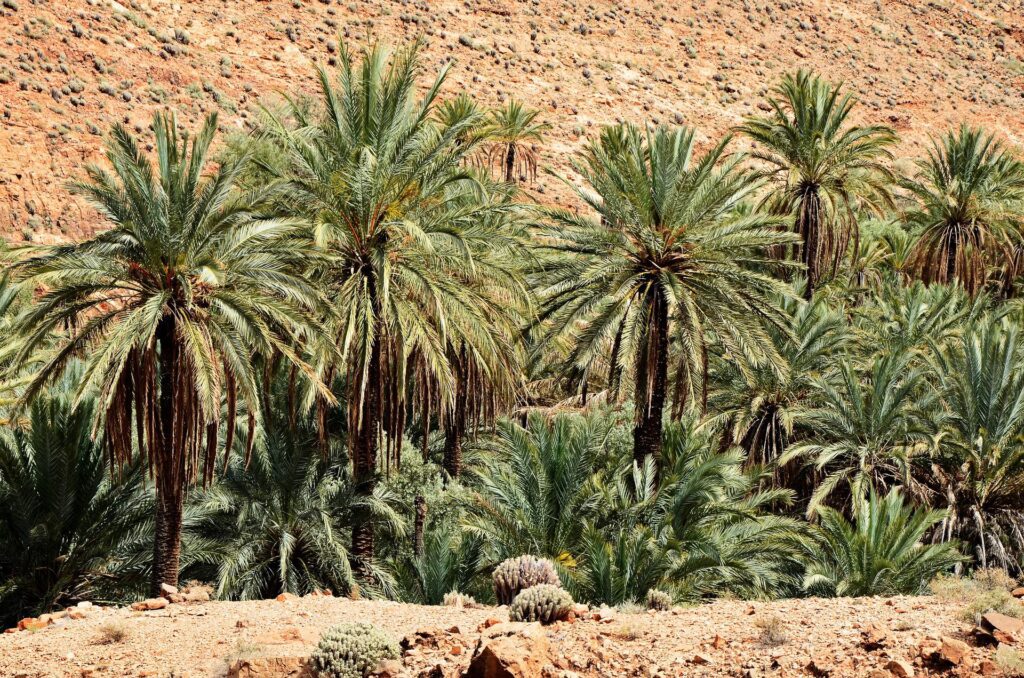
Looking for an adrenaline-pumping activity while in Marrakech? How about an ATV tour through the Agafay Desert!
The Afagay Desert is located just outside of Marrakech and is a great place to get away from the city for a day. ATVs rides are a popular choice in Marrakech because they’re fun, easy to use, and a great way to explore the desert.
You can find ATV tours that range from 1 hour to full-day excursions, so there’s something for everyone.
On this quad biking tour , you’ll ride an ATV through the desert, stopping along the way to admire the stunning views. You’ll also visit a traditional Berber village, where you can learn about their culture and see how they live as you drink traditional Moroccan mint tea with them.
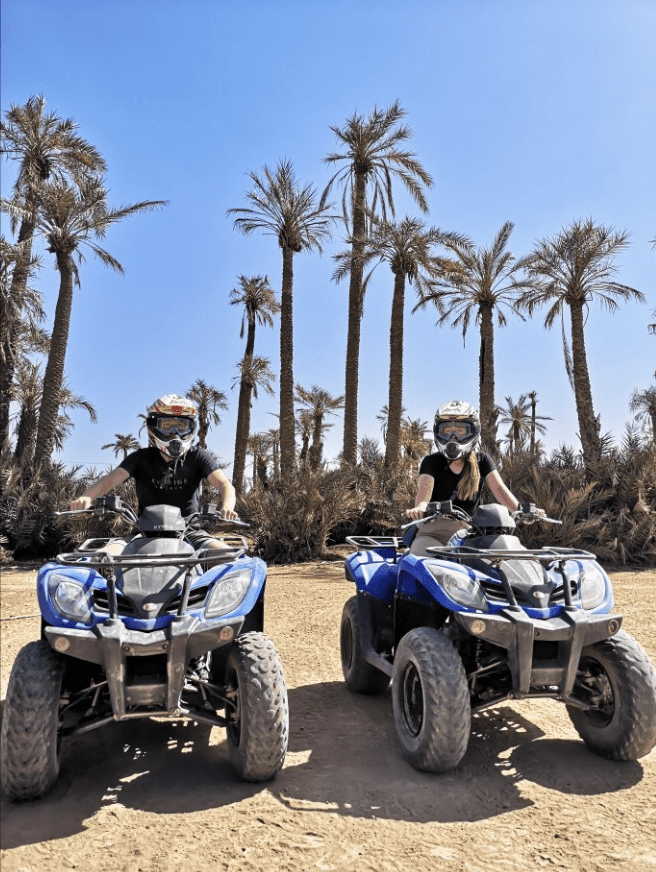
This tour is great for both solo travelers and couples, as you can either ride your own ATV or share one with someone else. The $40 cost of the tour includes the ATV rental, a guide, and transportation to and from the desert – you can even choose what time of day you want to go on the tour.
So, if you’re looking for an adventurous activity to do in Marrakech, an ATV tour through the Agafay Desert is a great option!
Just make sure to wear sunscreen and comfortable clothes, as it can get very hot in the desert.
22. Take a tour to Fez
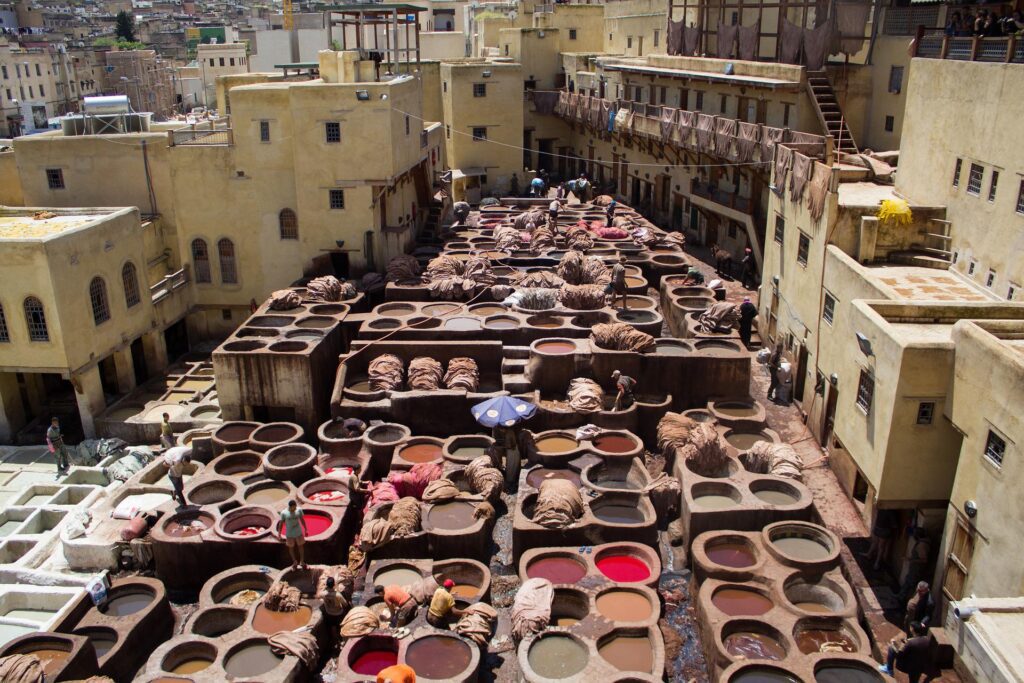
Fez, another imperial city, is the cultural and spiritual heart of Morocco. The Medina of Fez el-Bali is the largest pedestrian UNESCO World Heritage site in the world and full of souqs selling everything from spices to rugs to leather goods.
Fez is located about 5.5 hours from Marrakech by car, so it’s obviously not ideal for a day trip. But if you have a few days to spend in Marrakech and are looking to explore some of the surrounding cities, Fez is a great option. There are many different tour companies that offer day trips from Marrakech to Fez, and the cost of the tour will depend on which company you choose.
This 3-day tour to Fez from Marrakech includes transportation to Fez in a group van, a local guide, all meals, accommodation, and entrance fees to all the sights. In three days, you’ll explore Ait Ben Haddou’s Kasbah, tour the Gorge of Todra, and go on an overnight camelback safari to a desert camp in the Sahara.
You’ll visit all the major sights in Fez, including the Medersa Bou Inania, the Nejjarin Fondouk, and the Karaouine Mosque, and also have free time to explore the souqs and do some shopping.
This is a great tour for anyone interested in Moroccan culture and history, as Fez is one of the most important cities in Morocco. The tour includes all transportation and entrance fees, so it’s a great value for the money.
Tickets for this tour start at $174 USD total for three days of exploring and all meals, which is definitely worth it in my opinion.
Note: This tour ends in Fez and does not include transportation back to Marrakech. You will need to make your own arrangements to get back to Marrakech from Fez.
23. Spend the day at Ouzoud Falls
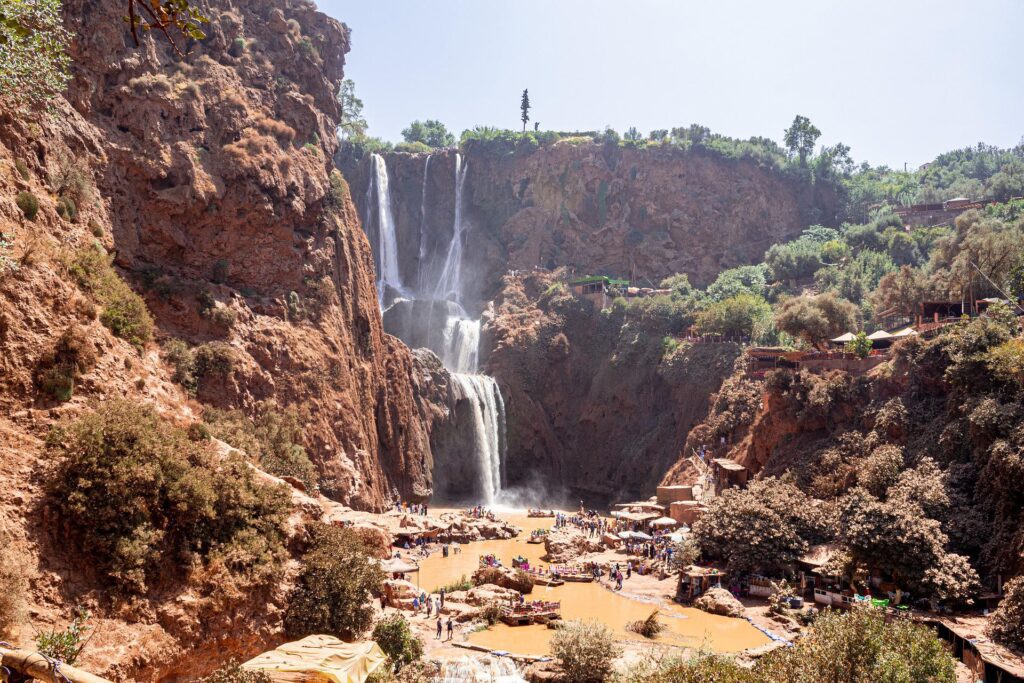
Like I mentioned earlier – Marrakech is hot. Like, really hot .
So hot that sometimes you just need to get out of the city and escape to a cool, refreshing place. And there’s no better place to do that than Ouzoud Falls.
Ouzoud Falls is located about 3 hours from Marrakech by car, and it is absolutely worth the drive. The falls are absolutely stunning, and you can even take a boat ride underneath them. Ouzoud Falls is also the second tallest waterfall in Africa, so it’s definitely a sight to see.
The falls are made up of a collection of several waterfalls that empty into the El-Abid river gorge and are surrounded by picturesque mountain scenery.
There are many different tour companies that offer day trips from Marrakech to Ouzoud Falls, so it’s easy to find one that fits your budget and schedule. This tour , for example, includes transportation to and from Marrakech, a local guide, and all entrance fees for only $25 USD per person.
The tour will last about 10 hours, where you’ll be transported from Marrakech to the Cascades d’Ouzoud (Ouzoud Falls) for a day of exploring, wildlife spotting, and swimming. The tour includes all entrance fees and a local guide, so it’s a great value for the money.
This tour is also a really popular one, so booking online in advance is recommended to save your spot.
So, if you’re looking for a cool (literally) day trip from Marrakech, Ouzoud Falls is a great option. And at only $25 USD, it’s definitely worth it.
24. Splash around at the Aqua waterpark
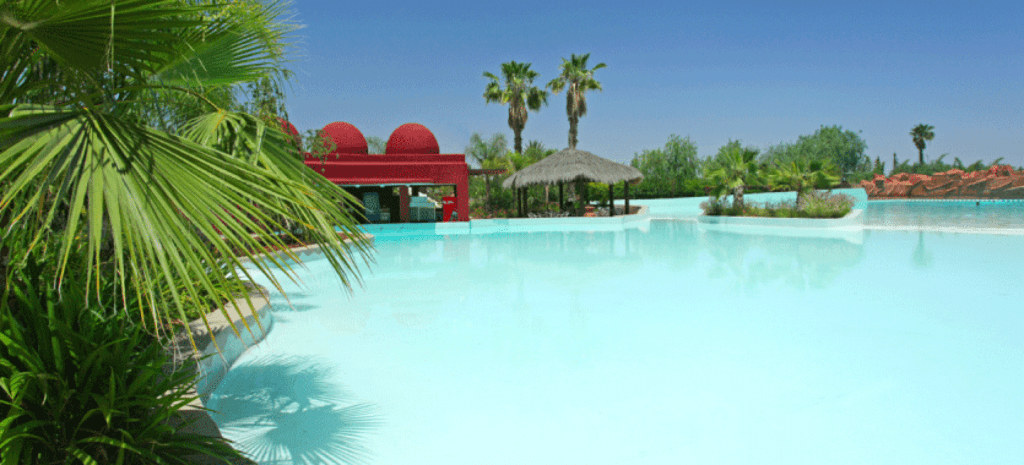
Oasira Marrakech is the first waterpark in Marrakech, and it’s the perfect place to spend a hot day.
The waterpark has slides, pools, a lazy river, and even a wave pool. This park is equipped with 8 different pools, 20 attractions, 17 different waterslides to explore. And if that’s not enough to cool you off, there’s also a snow park inside the waterpark!
One of their famed attractions is the AquaRoc, a rock climbing wall course and the first-ever climbing wall in Africa! The rock climbing wall is 5 meters high with 3 different routes to choose from, and when you fall off the rock, you fall directly into the water!
There’s a swimming lane near the rock for family and friends to watch and enjoy.
Oasira even has an indoor heated swimming pool and jacuzzi for those looking for a more relaxed experience. The 4 on-site restaurants will make sure you’re never hungry, and there’s even a waterpark shop to buy souvenirs.
The gardens at Oasira are also beautiful, with palm trees and flowers lining the paths.
Oasira Marrakech is located about 15 minutes from Marrakech city center by car, and it’s open every day from 10am to 6pm. General admission tickets for the waterpark start at $27 USD for adults and $17 USD for children, which includes access to all the rides and attractions.
This day pass ticket with transportation grants you access to the park for a day, and also includes pick up and drop off from your hotel in Marrakech. All tickets include access to all of the attractions, pools, and waterslides, as well as use of locker rooms, showers, and towels.
25. Try traditional mint tea in a tea room
Not to be dramatic, but Moroccan tea was some of the best tea I’ve tasted in my life.
And what’s even better than Moroccan tea? Drinking it in a traditional Moroccan tea room.
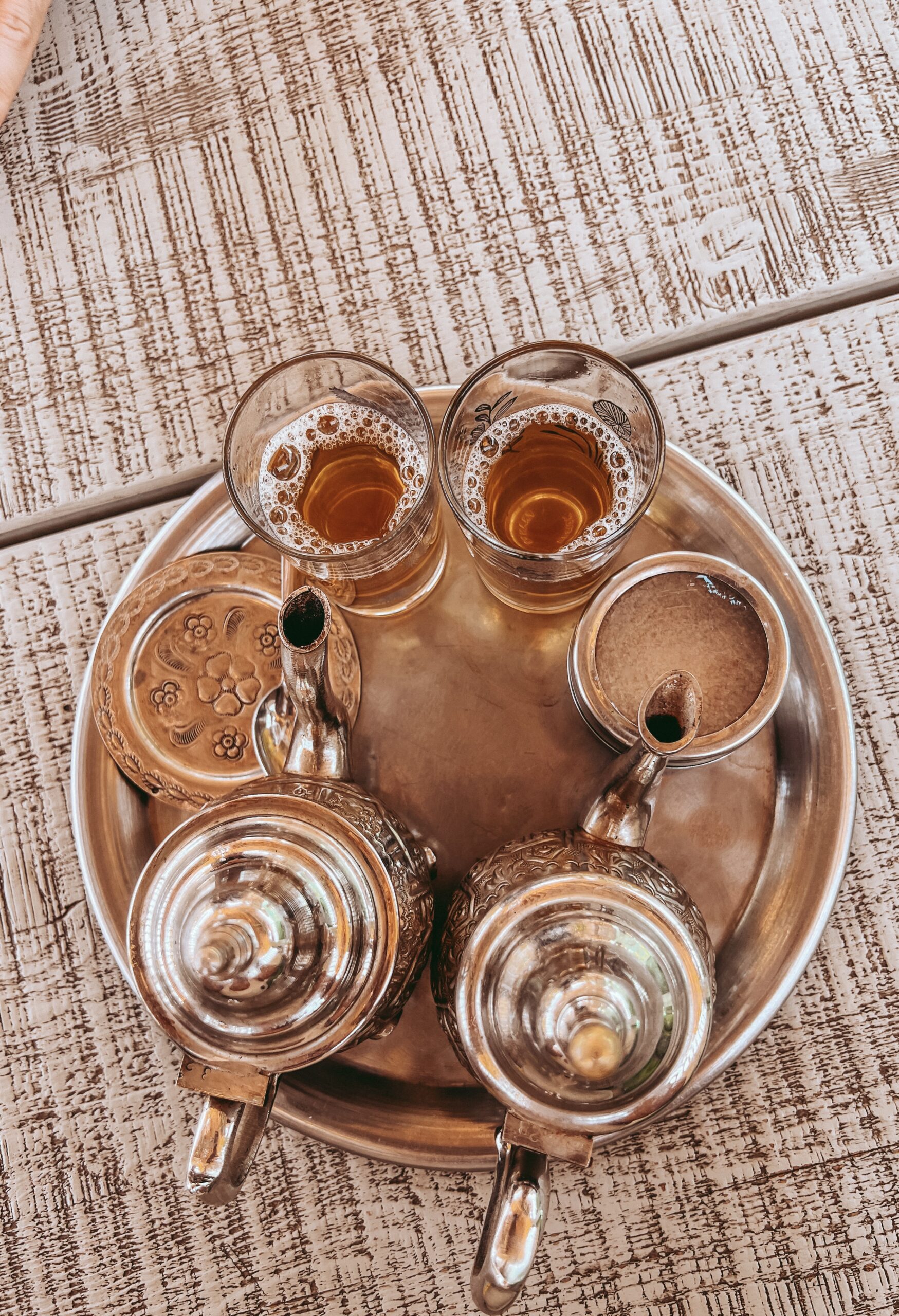
Tea is such an important part of Moroccan culture, and it’s customary to drink it several times a day. Tea rooms are found all over the city, and they’re the perfect place to relax, people watch, and escape the heat.
The best part about drinking tea in Morocco is that it’s always served with mint, and it’s pretty much always delicious. If you’re not a fan of mint, don’t worry – you can always ask for your tea without mint. But I would definitely recommend trying it at least once!
Tea rooms are usually very casual, and you can stay for as long or as short as you want. It’s common to see people reading, working on their laptops, or even taking a nap in the tea room. And don’t worry, they won’t kick you out!
Drinking tea is a great way to experience Moroccan culture, and it’s something that you can do for free (or very cheaply). So next time you need a break from sightseeing, head to a tea room and enjoy some mint tea.
One of my favorite tea rooms we visited in Marrakech was the Chichaoua Tearoom. This tea room was recommended to us by our riad owner, and it did not disappoint! The tea room was beautiful, with traditional Moroccan decor and a cozy atmosphere, and had a speakeasy kinda feel to it.
We ordered mint tea and sat for hours people watching and chatting with the friendly staff. It was a nice way to take a break from the chaos of the Marrakech medina.
If you’re looking for a more upscale tea room experience, head to Jardin Majorelle. This tea room is located in the beautiful Jardin Majorelle, and it’s the perfect place to enjoy a cup of tea and some dessert. The tea room has a lovely outdoor patio with views of the garden, and the inside is just as beautiful.
In addition to traditional mint tea, they also serve a variety of other teas, as well as coffee, juices, and cocktails. And if you’re feeling hungry, they have a menu of light snacks and desserts.
Where to stay in Marrakech
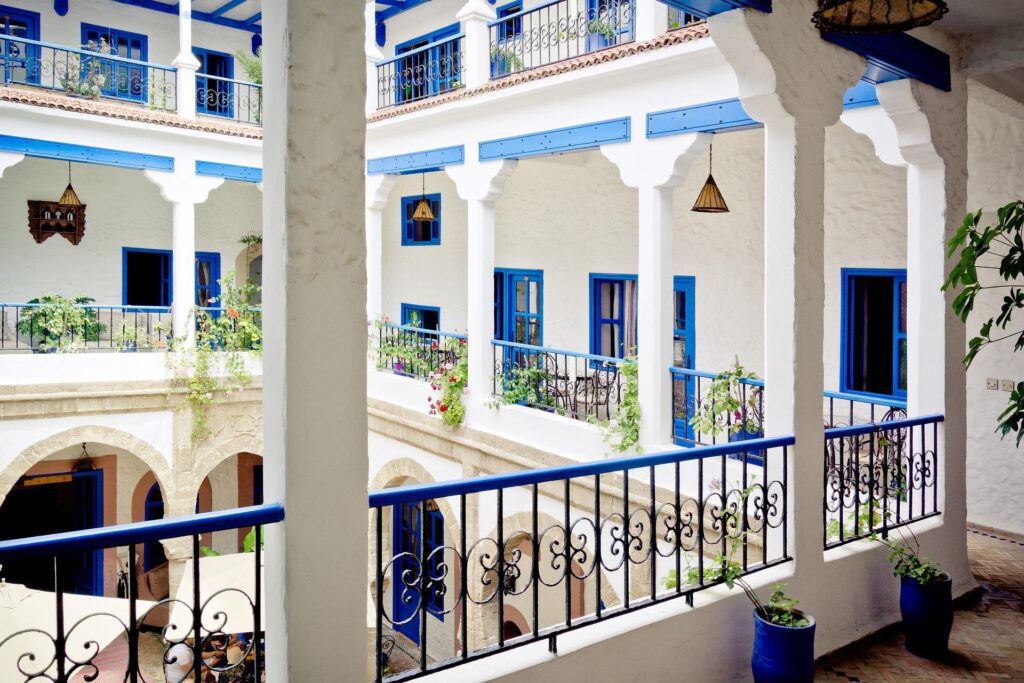
There are a lot of accommodation options in Marrakech, from luxury riads to budget-friendly hostels. Depending on your budget and the type of trip experience you’re looking for, you’ll definitely be able to find the type of stay that fits you.
Before you choose your accommodation, it’s important to know what part of the city you want to stay in. Marrakech is separated into two main areas – the Medina and the Ville Nouvelle.
The Medina is the old city, and it’s where you’ll find most of the historical sites, markets, and restaurants.
The Ville Nouvelle (New City) is the newer part of town, and it’s more modern with wider streets and Western-style hotels and restaurants.
Marrakech Old City vs Ville Nouvelle
If you’re looking for a more authentic experience, the Medina is definitely the place to stay. This is where you’ll find most of the traditional riads, and it’s the perfect place to get lost in the winding streets and experience the true culture of Marrakech.
If you’re on a budget, there are several hostels located in the Medina that offer dorm beds for around $10 per night. These are great for solo travelers or those on a tight budget, and they’re a great way to meet other travelers.
If you’re looking for a more modern experience, the Ville Nouvelle is the place to stay.
This is where you’ll find most of the Western-style hotels and restaurants, as well as some of the city’s best nightlife. The downside to staying in the Ville Nouvelle is that it’s not as authentically Moroccan as the Medina.
But if you’re looking for a more comfortable stay with easier access to nightlife and restaurants, the Ville Nouvelle is definitely the way to go.
Rodamon Riad Marrakech Hostel – ($)
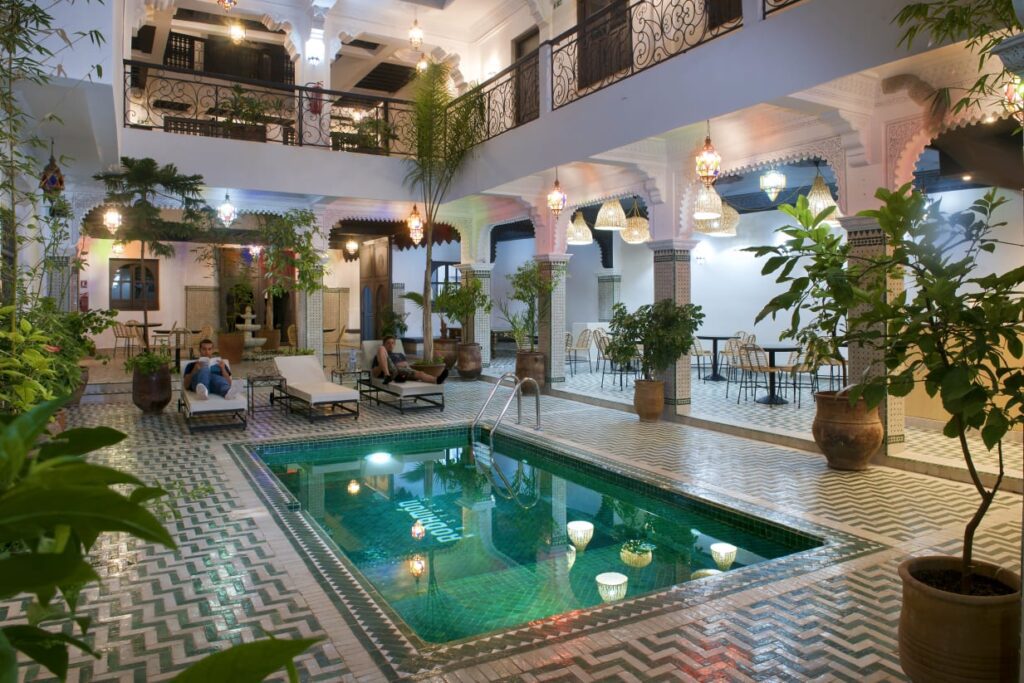
Rodamon Riad Marrakech is a hostel located in the heart of the Medina, and it’s a great option for solo travelers or those on a tight budget.
It’s traditionally decorated with colorful Moroccan tiles that line the floors and walls of the hostel, and is equipped with a rooftop terrace and bar that provides panoramic views of the entire city. A bed in a shared dorm at this hostel starts at $26 USD per night.
You can check availability and up-to-date rates for your desired dates on Hostelworld or Booking.com
Riad du Ciel – ($$)
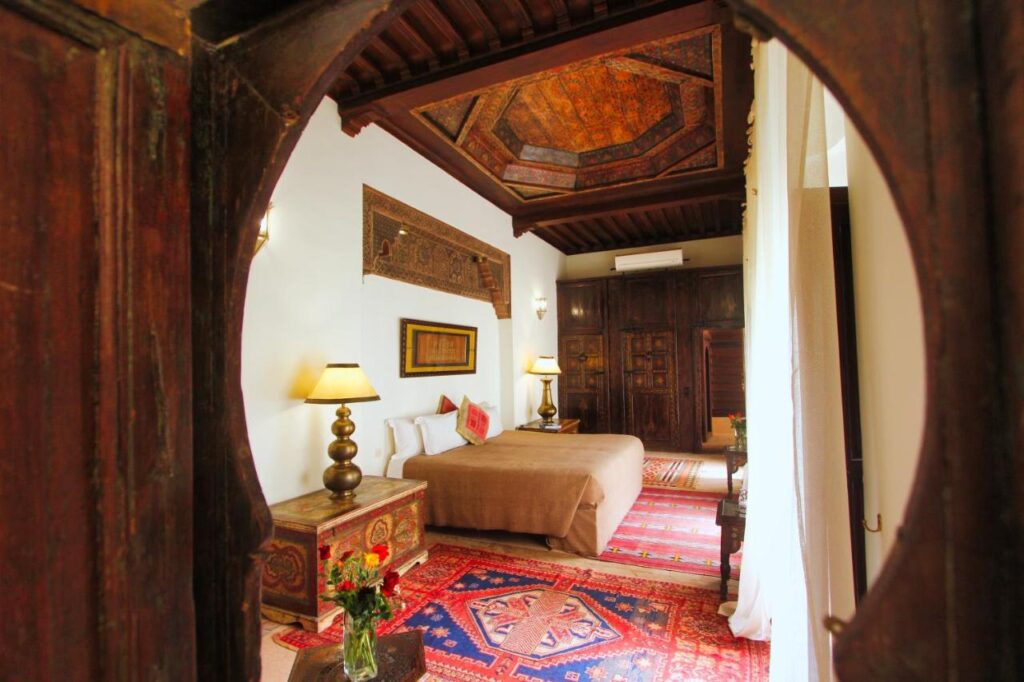
This traditional Riad is located in the Medina, and it’s just a short walk away from all of the major sites. The Riad du Ciel has a rooftop terrace with views of the city, as well as an indoor pool and hammam, sauna, and massage services that are offered at an additional price.
All rooms feature tiled floors and traditional Moroccan style decor, air-conditioning, and a private bathroom with a shower. A continental breakfast is served to guests here every morning and is included in the room price.
A double room at this Riad starts at $115 USD per night. You can check availability for this hotel on Booking.com .
Cesar Resort & Spa – ($$$)
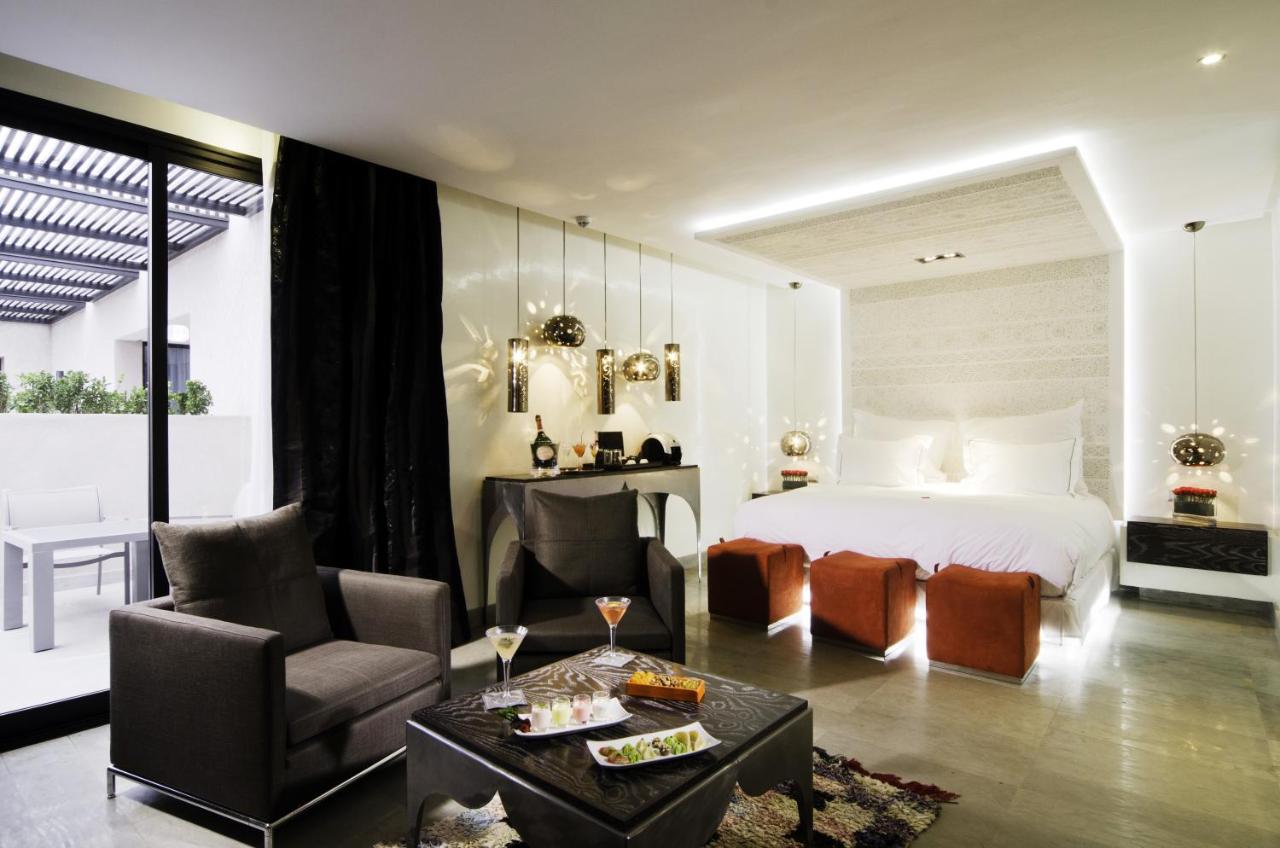
This luxury 5-star hotel features 3 swimming pools, including one on the rooftop of the property overlooking the Atlas mountains.
The Cesar Resort & Spa also has a spa with a variety of massage and beauty treatments, as well as a fitness center and a kids club. You can enjoy both international and traditional Moroccan cuisine at their on-site restaurant.
The hotel rooms are all decorated in a modern style, and they come equipped with marble floors, air-conditioning, a flat-screen TV, an Espresso Crema coffee machine, and private bathroom with toiletries.
A standard double room at this hotel starts at $165 USD per night. You can check availability and up-to-date rates on Booking.com .
Thanks for reading!
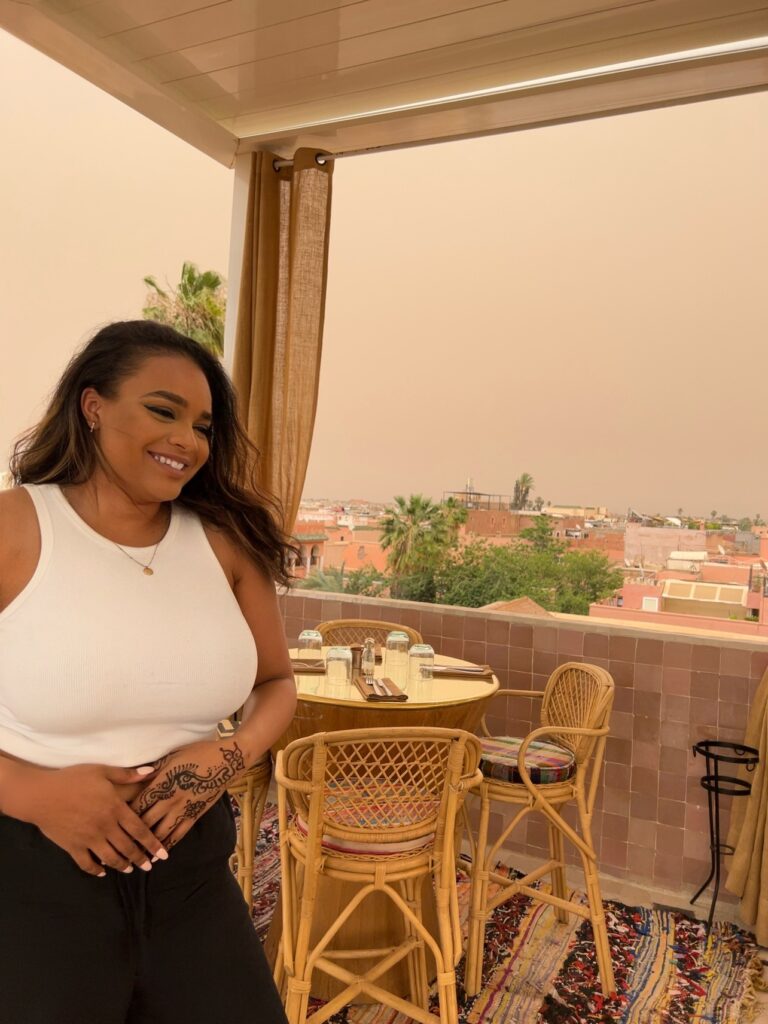
I hope this list of things to do in Marrakech has been helpful in planning your trip! This ancient city is so much more than just a tourist destination – it’s a place where you can really immerse yourself in the culture and experience the true spirit of Morocco.
You really can’t go wrong with any of these Marrakech activities, so just pick a few that sound fun to you and start exploring!
If you enjoyed this post about things to do in Marrakech, check out these related reads:
Top 9 Solo Female Travel Tips from Black Solo Travelers 14 Mistakes to AVOID in Zanzibar Is Solo Travel Lonely? How to Combat Homesickness while Abroad
Pin this post!
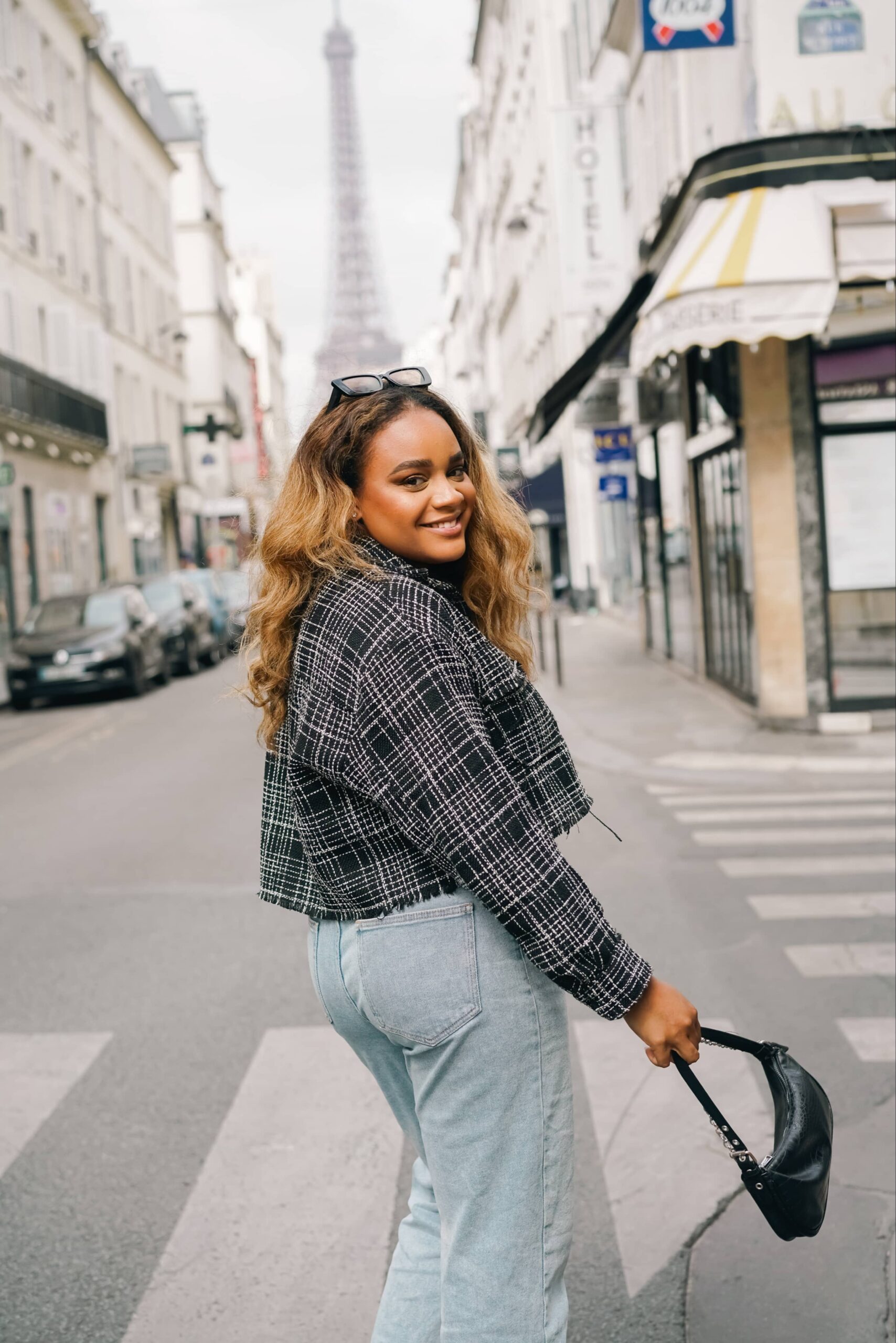
Hi, I’m Tiana – founder of and author here at Where Tiana Travels. I’m a 20-something with a love for all things travel, photography, and food. I have been living abroad for the past 5 years and solo traveling the globe in my free time. I created this blog to share my travel stories and inspire other women to go out and see the world. Read more about me here!
- 460 Share on Facebook
- 71 Share on Twitter
- 233 Share on Pinterest
- 89 Share on LinkedIn
- 213 Share on Email

17 Top-Rated Attractions & Places to Visit in Marrakesh
Written by Jess Lee Updated Dec 26, 2023 We may earn a commission from affiliate links ( )
Marrakesh is a city that effortlessly combines the ancient and the new. The city's name provided the root for the name of the country itself, spelling out this town's importance through the ages.
Within the high red walls of the medina, just soaking up the atmosphere is the main tourist attraction with snake charmers and smooth shop touts both competing for your attention amid a noisy, colorful bustle that encapsulates Morocco's vibrant soul.
For shoppers, Marrakesh's souqs are the best place to visit in Morocco, offering the full scope of the country's artisan work, while the medina's scatter of richly decorated heritage buildings are some of the country's most famous monuments.
Marrakesh is also the gateway into the High Atlas region, Morocco's major activity area, with hiking, mountain biking, climbing, and many other active things to do. Even on a short visit, you can experience a taste of Morocco's mountain life on one of the many Marrakesh day trips offered from the city.
Discover what the city has to offer with our list of the top attractions and things to do in Marrakesh.
1. Shop the Medina Souks
2. experience djemaa el fna after dark, 3. stay in a medina riad hotel, 4. admire the koutoubia mosque, 5. stroll around majorelle gardens, 6. visit the medersa ben youssef, 7. soak in a hammam, 8. be dazzled by bahia palace, 9. hot-air balloon ride over the marrakesh countryside, 10. cycle or horse ride in the palmeraie, 11. check out the saadian tombs, 12. visit dar si said, 13. admire the interiors of marrakesh museum, 14. explore the badi palace, 15. peek into the almoravid koubba, 16. picnic in manara gardens, 17. photograph the marrakesh tanneries, where to stay in marrakesh for sightseeing, tips and tours: how to make the most of your visit to marrakesh, map of attractions & things to do in marrakesh, history of marrakesh.
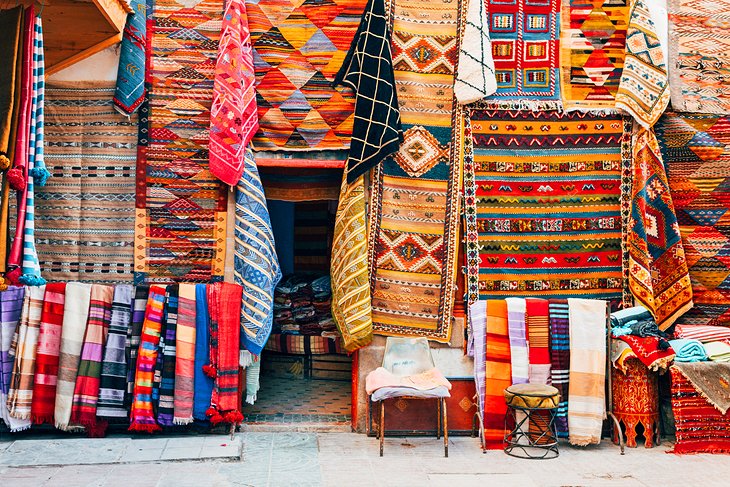
For many visitors, Marrakesh's labyrinthine medina (old city) district is the town's star attraction.
The narrow alleyways are a kaleidoscope of colors, scents, and sounds and are bound to be the sightseeing highlight of your trip.
As well as simply wandering (and getting lost) amid the bustling maze, there are myriad shopping opportunities where you can put your haggling hat on and barter to your heart's content.
The main souq area is the tangle of lanes between Place Rahba Kedima and Place Ben Youssef.
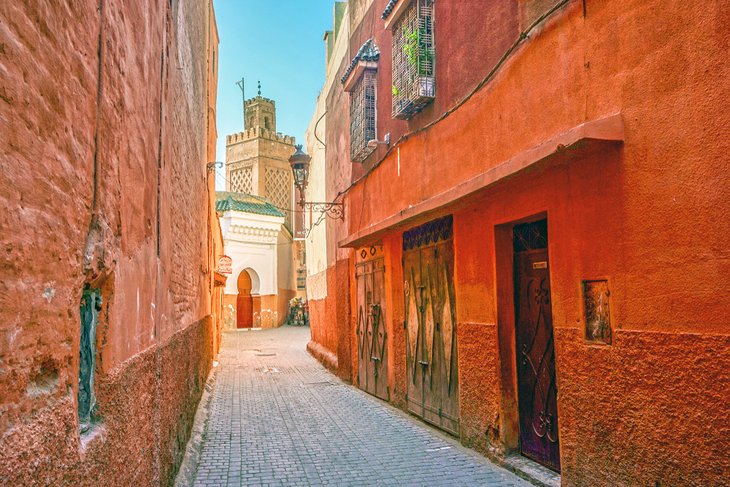
Just off Place Ben Youssef, you'll find Fondouq Namas, an old trader caravanserai that is now home to plenty of carpet shops. Place Rahba Kedima itself is one of the main medina areas for buying spice and spice mixes.
Souq Haddadine is the metalworkers area, while just to the north is Souq Cherratine, where the leatherworkers have their workshops.
The narrow crisscross of lanes between the main thoroughfares of Souq el-Kebir and Souq Smata is full of traditional clothing stalls, while if you follow Souq Lebbadine west, you'll end up amid the skiny alleys of Souq Teinturiers (the Dyers souq).
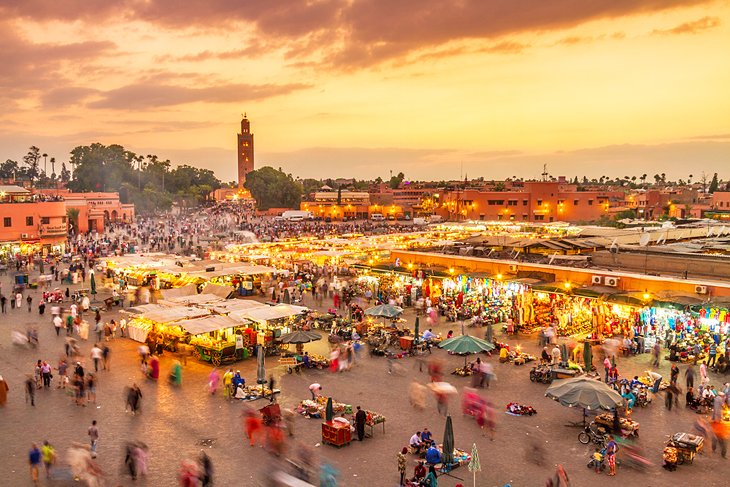
This large square at the entry to the medina is the center of Marrakesh life.
The Djemaa El Fna (assembly place of the nobodies) is a vibrant hub of bric-a-brac stalls, musicians, storytellers, fortune-tellers, and snake charmers that springs into life from late afternoon daily with entertainment carrying on until midnight.
An evening spent here wandering between the acrobat troupes and local musical groups is a truly Moroccan experience.
At sunset, the northern section of the square fills with stalls serving cheap meals and snacks. It's also easy to escape the chaos of the square for a time-out at one of the many cafés that rim the square. Many of these cafés also offer the best panoramic views of all the Djemaa El Fna action from their rooftops.
Address: Avenue Mohammed V, Marrakesh
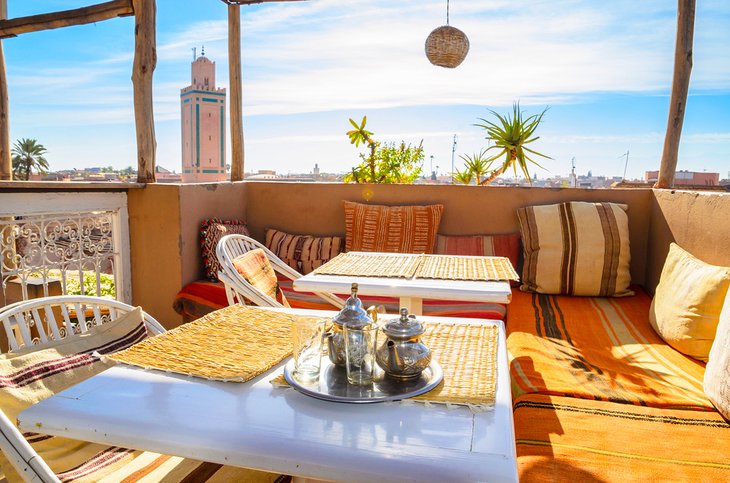
Marrakesh's riad hotels are an experience in themselves, and for many travelers, a visit here is as much about the hotel as it is about the city.
A riad is a traditional medina mansion, centered around a courtyard. Over the past few decades, many have been restored, revamped, and opened as boutique hotels, usually in the luxury and mid-range category (though Marrakesh even has a backpacker hostel based in a restored riad).
Some are palatial in both historic ambience and their Moroccan artisan features, while others blend contemporary style with traditional design.
Modern comforts and amenities such as plunge pools and on-site hammams (Turkish baths) are common in the larger riads, and many also provide evening meals on request.
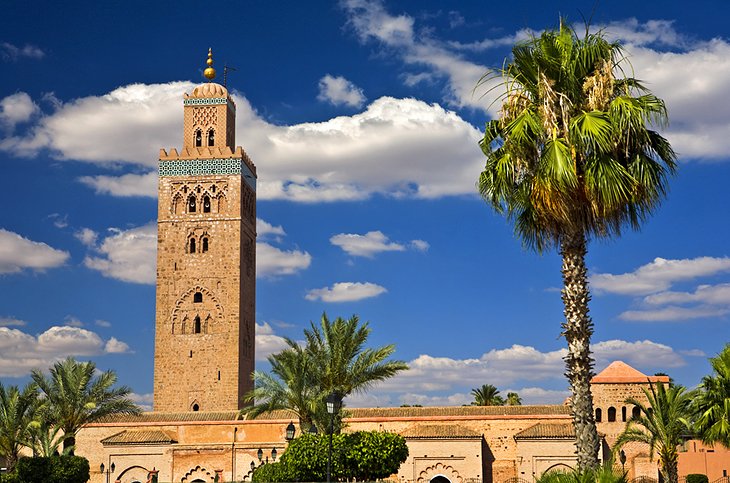
The Koutoubia Mosque is Marrakesh's most famous landmark with its striking, 70-meter-tall minaret visible for miles in every direction.
Local Marrakesh legend tells that when first built, the muezzin (man who calls the faithful to pray) for this mosque had to be blind, as the minaret was so tall, it overlooked the ruler's harem.
The mosque was built in 1162 and is considered one of the great achievements of Almohad architecture.
The archaeological excavation area on the northwest side of the minaret displays the foundations of the earliest mosque built on this site. It was destroyed by the Almohads and replaced with the current mosque.
Non-Muslims are not allowed into the Koutoubia Mosque itself.
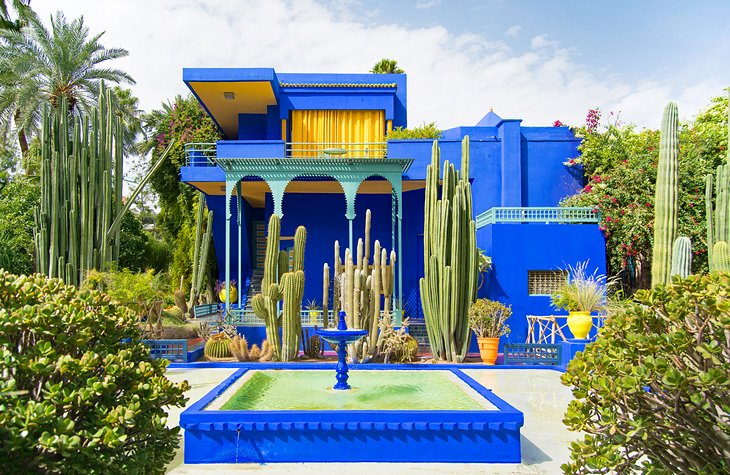
These lush tropical gardens full of cacti, palms, and ferns, are the work of painter Jacques Majorelle.
Originally from the town of Nancy in France, Majorelle came to Marrakesh for health reasons and became well known for his paintings of local Moroccan life.
His most famous work, though, was this garden and the vibrant blue (the color now known as Majorelle blue) painter's studio he lived in on the grounds.
After Majorelle's death in 1962, French fashion designer Yves Saint Laurent bought the property, and upon his death in 2008, his ashes were scattered in the gardens.
Within the grounds, Majorelle's old painting studio is now home to a fabulous museum dedicated to Berber artistry.
Just next door to the entrance into the gardens is a museum dedicated to the life and fashion legacy of Yves Saint Laurent, which also hosts a program of temporary exhibitions.
Address: Avenue Yacoub el Mansour, Marrakesh
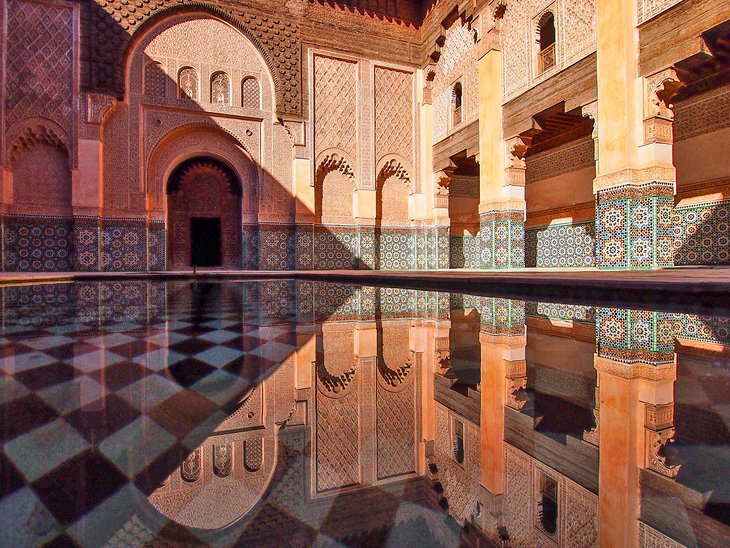
The sumptuously decorated Medersa of Ben Youssef is one of the finest examples of Saadian era artistry in Morocco. This theological college (completed in 1565), directly opposite the Ali Ben Youssef Mosque, once homed 900 students and was the largest center for Quranic study in the country.
The warrens of rooms where students once slept are clustered around small internal courtyards in typical Islamic architecture style, but the main internal courtyard is the real highlight here.
The fine zellige tiling, stalactite ceilings, cedar-wood detailing, and Kufic inscriptions used as decoration across the courtyard's interior make this medersa one of Morocco's most beautiful buildings and a star medina attraction.
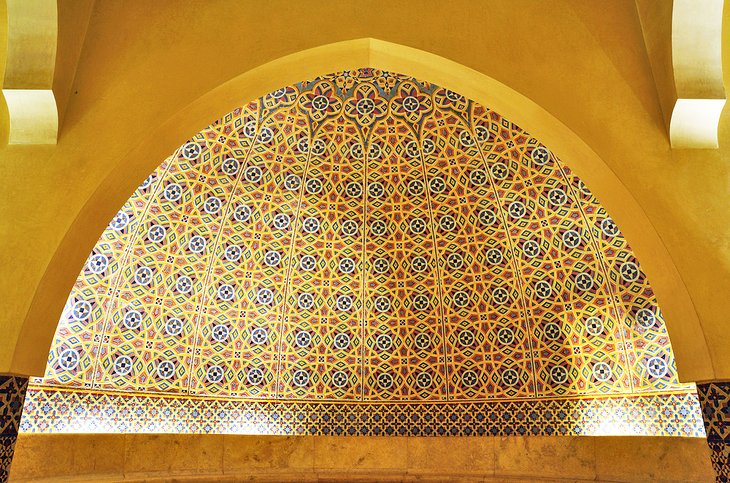
Navigating around the medina can be hot, dusty, and crowded work but luckily there's a traditional way to relax and rejuvenate after your sightseeing and shopping is done.
A hammam is a traditional communal bath (often called a Turkish bath) with a multiple domed interior dedicated to bathing. The process at its most basic consists of steaming, washing, and then exfoliating your skin, with a short massage as an additional service.
While public hammams are scattered throughout the medina and still serve the community, many historic and contemporary-built hammams provide hammam experiences directly aimed at visitors and are a great introduction to Moroccan hammam culture.
Some of the more luxurious hammams also provide modern spa add-ons with a host of beauty treatments and massages available.
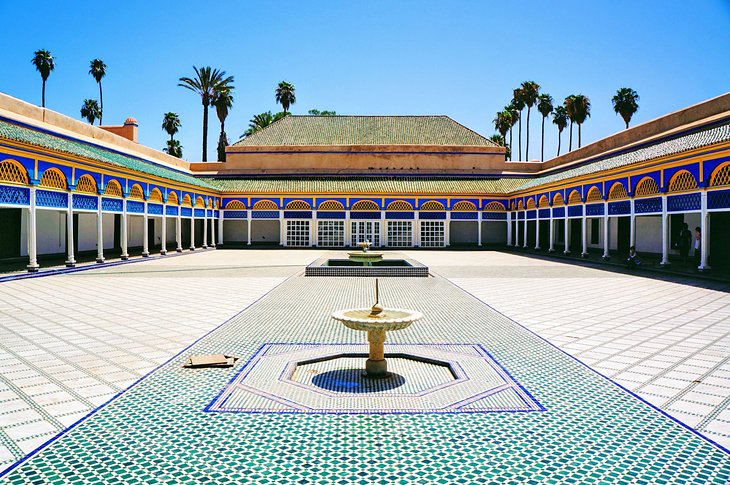
This magnificent peacock of a palace was built in the late 19th century as the residence of the Grand Vizier Bou Ahmed, who served Sultan Moulay al-Hassan I.
The interior decoration is a dazzling display of Moroccan artisan work combining zellige tiles, painted ceilings, and ornate wrought-iron features showcasing the opulent lives of those high up in the sultan's favor at that time.
The massive marble grand courtyard and opulent salons of the haram area are the two main attractions, while the lush internal courtyard of the grand riad, with its banana-leaf plants and citrus trees, is a tranquil respite from the city.
Address: Rue Riad Zitoun el Jedid, Medina, Marrakesh
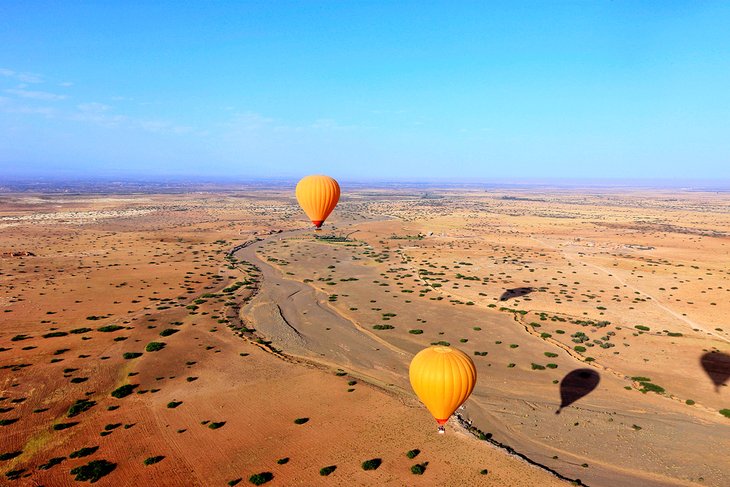
Several companies run sunrise hot-air balloon ride tours in Marrakesh, which provide panoramic views across the city, the palm groves, and surrounding arid plateau and the spine of the Atlas Mountains in the distance beyond.
For photographers, the dramatic vistas are definitely worth the early-morning start.
Flights generally take off just after sunrise and usually include an hour of flight time with a picnic breakfast of traditional Berber dishes offered after the flight, and return transfers to the city center.
Higher priced tours often include a camel ride or quad bike tour after the hot-air balloon ride or offer private baskets rather than sharing the balloon basket with other passengers.
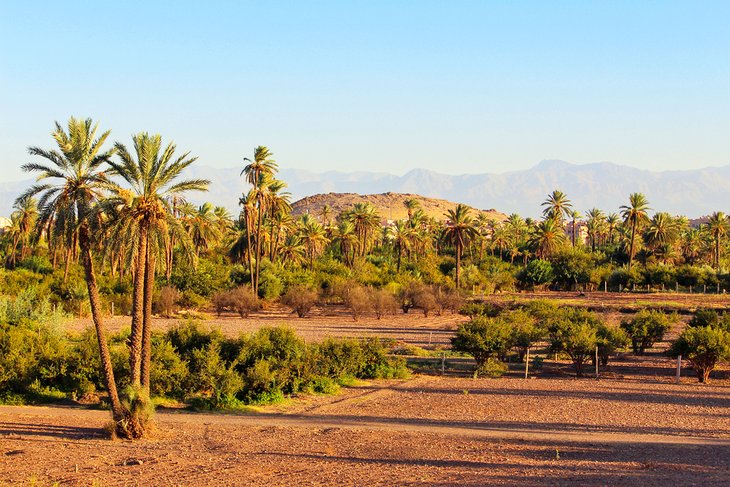
Marrakesh's Palmeraie (palm groves) area is just to the northwest of the city.
Containing around 50,000 date palm trees, the palmeraie is an alternative to staying in central Marrakesh, with plenty of villa-style luxury boutique hotels.
If you are not staying in the palmeraie, though, you can still enjoy a time-out from the city in this tranquil, shady haven as it's a popular destination for cycling, horse riding, and quad-bike tours, as well as camel rides.
Palmeraie half-day cycle tours are offered by a couple of local companies and thoroughly cover the area, while Palmeraie-based stables offers horse rides that explore both the palmeraie and some of the surrounding countryside.
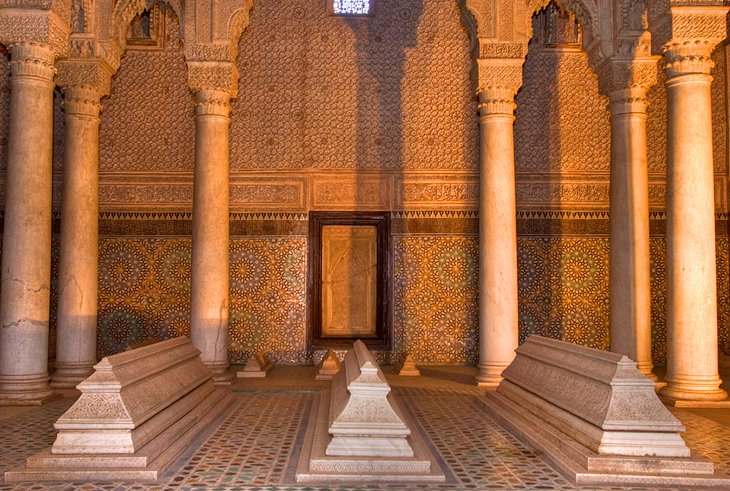
This 16th-century burial ground is home to 66 members of the Saadian dynasty, which ruled over Marrakesh between 1524 and 1668.
The tombs here include that of the ruler Al-Mansour, his successors, and their closest family members.
It's a rambling, atmospheric place, with the mausoleums set amid a rather overgrown garden.
In particular, the main mausoleum (where Moulay Yazid is buried) has a fine surviving mihrab (prayer niche).
The Saadian Tombs were walled up by their Alawite successors and were only rediscovered in the early 20th century.
The entrance to the Saadian Tombs is the small alleyway next to the southern wall of the Kasbah Mosque.
Address: Rue Kasbah, Medina, Marrakesh
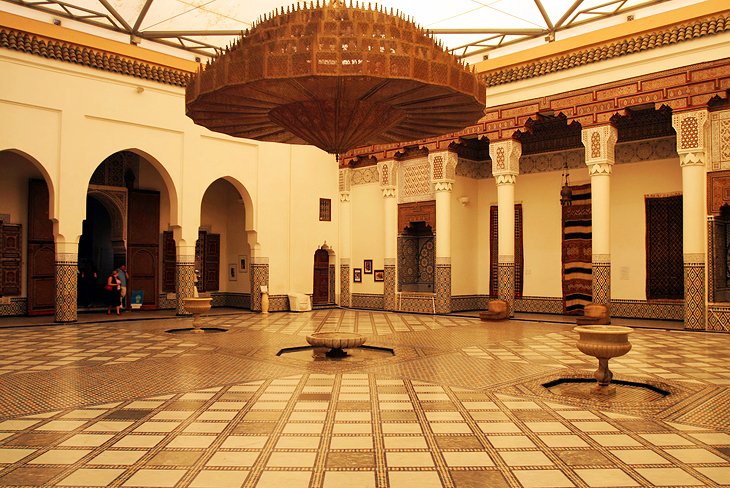
This lovely old palace built by Vizier Si Said is home to a wonderful collection of Berber jewelry in finely worked silver, oil lamps from Taroudant, pottery artifacts, embroidered leather, and marble.
There is also a display of Moroccan carpets and an amazing collection of traditional Moroccan door and window frames, which highlight this country's local architecture styles.
For anyone interested in the evolution of North African art and crafts, it's a lovely place to potter about for a couple of hours.
Near the Dar Si Said, the Maison Tiskiwin has a rather wonderful collection of costumes, jewelry, arms, musical instruments, textiles, and furniture (focused on Saharan culture) put together by Dutch art historian Bert Flint. Another branch of the museum is in Agadir .
Location: Off Rue Riad Zitoun el Jedid, Medina, Marrakesh
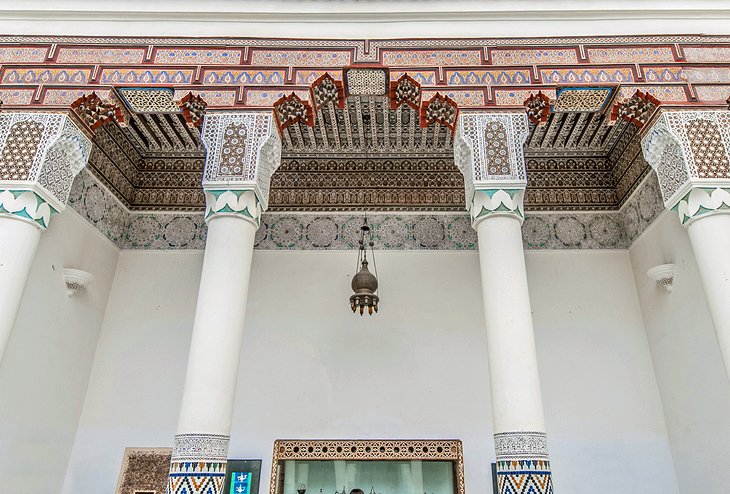
The Marrakesh Museum (Musee de Marrakech) has an eclectic collection ranging from contemporary art to Qur'anic inscriptions, with local ceramic work, textiles, and coins thrown in for good measure.
For most visitors, the real highlight of a visit here, though, is the building itself.
The museum is housed in the Mnebhi Palace, which was originally the residence of Mehdi Mnebhi (a minister in Morocco's government) but was later home to Pasha Thami Glaoui, ruler of Marrakesh.
The architecture is a harmonious blend of local North African form with Portuguese elements, and features an extremely impressive central courtyard area complete with a lavish chandelier.
Address: Place Ben Youssef, Medina, Marrakesh
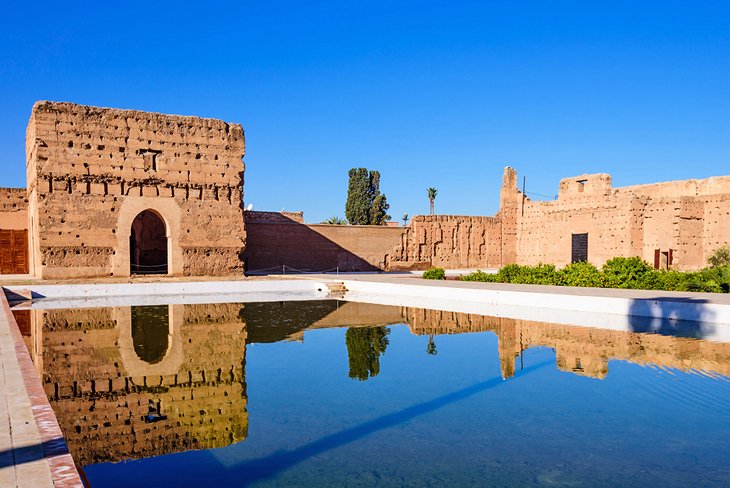
The ruins of Al-Mansour's once grand palace are one of the kasbah area's most atmospheric sights. The Saadian ruler built the opulent palace, with pavilions set amid a mammoth garden of reflective pools, during his triumphant reign, but it was plundered and destroyed soon after.
Now the sparse remnants of mosaic-tiled floors, ruined pavilions, and the high enclosing walls are all that remain. There are excellent views across the medina from the top of the walls, where storks have also built their nests.
After viewing the palace, head to the nearby Mellah , the old Jewish quarter of Marrakesh. It was established in the 16th century and is now populated mainly by Muslims.
The small synagogue here has been nicely restored and can be visited, as can the vast Jewish cemetery.
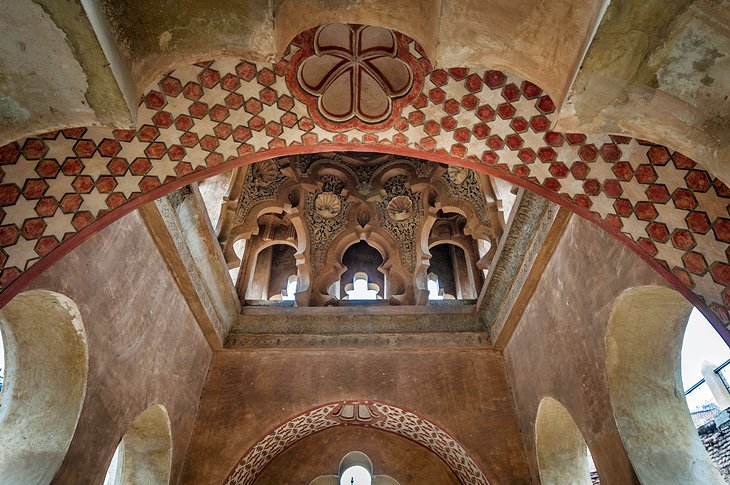
Also known as the Koubba Ba'adiyn, the Almoravid Koubba is Marrakesh's oldest monument still standing, built in the 12th century during Ali Ben Youssuf's reign.
Although its original use is unknown, some experts have suggested that it may have been the ablution house of a mosque that once sat next door.
Its simple exterior design (a squat, square building topped with a dome) belies an interesting interior, with a dome ceiling covered in Almoravid motifs.
The koubba was one of the few buildings to survive the damage inflicted by the Almohad conquerors, who destroyed much of the earlier Almoravid architectural legacy.
Address: Place Ben Youssef, Medina
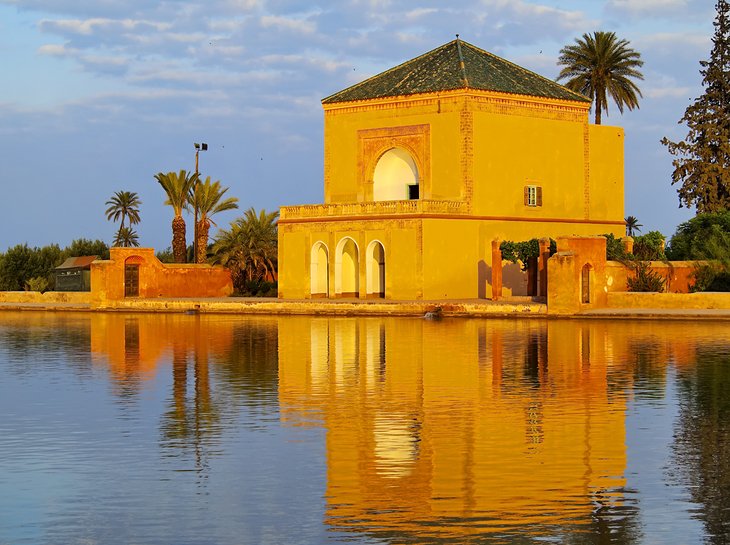
This huge garden, once a royal retreat, is a bubble of serenity hidden right in the heart of Marrakesh. It's a favorite spot for locals who want to escape the hustle and enjoy some peace and quiet.
The majority of the area is taken up with olive groves, but for visitors, the main attraction and reason to come here is the large reflective pool with its fine pavilion. Built in the late 19th century, the pool and pavilion are a favored spot for many local Marrakesh families, who come here to picnic and stroll.
There are excellent photo opportunities here of the pool with the Atlas Mountain Range reflected in its water, on a clear day.
Address: Avenue Menara, Marrakesh
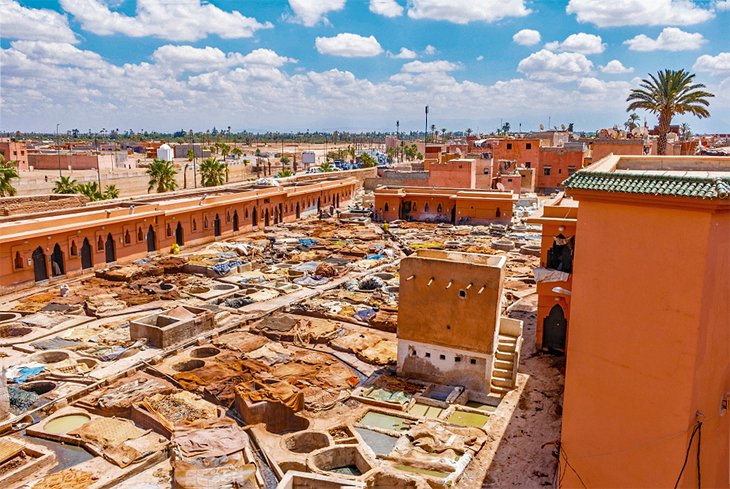
Marrakesh's tanneries district is smaller than the one in Fes but just as atmospheric. This is where the leather hides, used for the colorful shoes, bags, and other products you'll find in the souks, get dyed in a myriad of shades.
Come here in the morning if you want to see the tanners working in the colored vats of dye.
For photographers, there are great views over the entire area from some of the leather workshops, which rim the tanneries. You need to pay the shop a tip to enter and head up to their balconies or rooftops, and do expect the staff to try to get you to linger and buy something.
Address: Rue Bab Debbagh, Marrakesh
If you're visiting Marrakesh for the first time, and want to be in the heart of the action, the best area to stay is in the medina, near the Djemaa El Fna, the large square at its entrance. Some of the best-value accommodation options here are riads, traditional Moroccan guesthouses with inner courtyards that are shielded from the hustle and bustle of the medina outside; breakfast is usually included in the price.
Luxury Hotels:
- Oranges and rose blossoms perfume the air at La Villa des Orangers , steps away from all the medina attractions and the Koutoubia Mosque. This is a Relais & Châteaux property, with three patios, a rooftop pool, and a spa with a hammam.
- In the medina, near the entrance to the old souk, Riad Dar Anika is a more affordable luxury option, with a lovely courtyard pool and warm Moroccan hospitality.
- If you prefer to stay away from the hubbub of the medina, the Four Seasons Resort Marrakech is a taxi ride away. Facilities include palm-lined pools, a spa, fitness center, and kids' club.
Mid-Range Hotels:
- In the heart of the medina, the evocatively-named Riad Romance resides in a restored 17th-century building , with a lovely courtyard pool, cozy rooms, and a rooftop garden.
- Also in the medina, Dar Charkia , with a heated swimming pool, is in the Dar el Bacha antique dealers district. All the rooms are air-conditioned, and many come with a fireplace.
- Riad Karmela is a soothing oasis amid the medina, with a spa, restaurant, and personalized service. With its family apartments, it's a great choice for those traveling with kids.
Budget Hotels:
- In the medina and with a pool, Riad Sadaka has comfortable and cozy rooms and serves up tasty Moroccan cuisine, while Riad L'Orchidee has air-conditioned rooms, a plunge pool, and plenty of inviting nooks for relaxing and dining.
Taking an organized tour is a great way to see all the highlights of Marrakesh and the Atlas Mountains and experience the traditional culture without the hassle of finding your way around. Along the way, you'll learn all about the area's history, as well as insider tips and stories. These tours also include convenient pickup and drop-off at select hotels.
- Full-Day City Sightseeing Tour : The Marrakesh Discovery Tour allows you to relax and enjoy the sights while a local guide takes you on a tour through the city's labyrinthine backstreets and bustling souks, as well as historical highlights such as Bahia Palace and the Koutoubia Mosque. This full-day tour includes lunch at a medina restaurant, entrance fees, and pickup and drop-off from select hotels.
- Half-Day City Sightseeing Tour: Alternatively, the Marrakesh Half-Day Private City Tour offers three to four highlights of the city with stops at Majorelle Gardens, Bahia Palace, and the Saadian Tombs followed by a medina walking tour. Transport is included.
- Small-Group Atlas Mountains Day Trip : The Four Valleys Day Trip from Marrakech with Optional Visit to Takerkoust Lake and Kik Plateau is the perfect complement to a hectic city stay. This full-day tour gives you a great overview of the Atlas mountains, with a visit to three lush valleys, traditional Berber villages, Ourika Valley waterfalls, an optional lunch in a Berber home, and an optional upgrade to include the Takerkoust Lake and Kik Plateau. This is a small-group tour with more personalized service and a maximum of seven people.
- Toubkal National Park Day Trip : The Atlas Mountain Three Valleys Day Trip is a private full-day tour of the beautiful scenery in and around Toubkal National Park, with an included lunch and visit to a traditional Berber home. As well as all transport being included, with pickup and drop-off from Marrakesh hotels, the tour itinerary includes a short hike (or mule ride) from Imlil to the tiny mountain village of Ait Souka, a visit to an argan oil cooperative, and a camel ride.
- Hot Air Balloon Ride : The Atlas Mountains Hot Air Balloon Ride offers a different perspective on the desert and Atlas Mountain foothill scenery surrounding Marrakesh. On this morning adventure, you take a hot air balloon ride for bird's-eye views. Afterwards, descend to ground level for a delicious Berber breakfast and a camel ride in Marrakesh's Palmeraie. Also included is a flight certificate, as well as pickup and drop-off from select hotels.
- Camel Ride : The Sunset Camel Ride is a great way to explore the sandy trails of Marrakesh's Palmeraie area, shaded by date palms as you ride. The ride takes around one hour and ends at a traditional Berber house with included mint tea and snacks. Pickup and drop-off from Marrakesh hotels is included.
The Almoravides made Marrakesh the capital of an empire that covered most of the Maghreb (Northwest Africa) and extended well into Europe.
With the Almoravide conquest of southern Spain, Marrakesh was invested with the cosmopolitan culture of Andalusia and became a bastion of Islamic civilization and an intellectual center where the most famous scholars and philosophers of the age converged.
Lavish buildings were constructed and splendid gardens designed. The ancient ramparts and gates of the city are monuments to its medieval preeminence.
Almohade armies stormed the gates of Marrakesh on March 23, 1147, conquering the Almoravide capital.
The Almohades under Abdal Mou'min continued their conquest of North Africa, extending their empire through Algeria and Tunisia and moving across the Mediterranean to capture Seville, Cordoba, and Granada. Under Abdal Mou'min, Marrakesh became an even greater Islamic capital.
Marrakesh went into a period of decline under the Merenids, who captured the city in 1269. The Merenid capital was already centered in Fes, and Marrakesh fell into neglect for two and a half centuries.
The fortunes of Marrakesh revived under the Saadian dynasty. The Saadians were tribesmen from the Souss region, who conquered the whole of southern Morocco in a war against the Portuguese colonialists in Agadir.
When the Saadians gained control of the whole of Morocco, their leader, Mohammed Al Mahdi, made Marrakesh his capital in 1551 and began to restore the city.
Although the new city district of Marrakesh was constructed in 1913 during the French occupation and reflects this European influence, the majority of the city (like Fes) is a genuinely Islamic city in both its genesis and traditions.
More Related Articles on PlanetWare.com
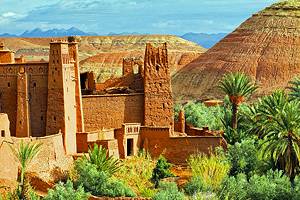
After Marrakesh: You can explore some of the most beautiful valleys and gorges of the High Atlas area on day trips from the city but to really delve into this vast region of snowcapped peaks, palm tree oases, and mudbrick kasbahs, take a journey into the High Atlas itself.
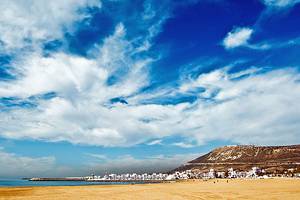
Head to the Coast: Head west to the Atlantic coast to check out some other Moroccan cities. Casablanca is a bustling city and home to the Hassan II Mosque. The capital, Rabat, has a medina perched right on the coast, and Agadir is Morocco's top beach break city, with a swathe of white sand.

More on Morocco
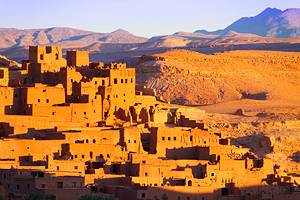
Marrakech, Morocco: Your Ultimate Guide
Alyssa Faraji
Dive into the labyrinthine alleyways of Marrakesh, a city that enchants with its vibrant colors, diverse aromas, and symphony of sounds. From bustling souks and tranquil gardens to timeless palaces and thrilling desert escapades – explore the heart of Morocco with our comprehensive guide.
Key Takeaways if You Visit Marrakech
Marrakech greets visitors with a vibrant array of experiences, filled with mesmerizing sights, sounds, and scents – from lively street vendors to enchanting snake charmers.
If you’re new to Morocco, it could be advantageous to familiarize yourself on of the quieter Moroccan cities before diving into the vibrant energy of Marrakech.
Marrakech offers a uniquely immersive sensory journey, featuring bustling markets, traditional architecture, a diverse array of sounds, and a medley of fragrances from incense to the scent of leather.
Owing to its central location, Marrakech serves as a perfect launching point for excursions to other Moroccan highlights, such as the High Atlas Mountains or the mesmerizing dunes of the Sahara.
Contrary to the serene images often portrayed on social media, Marrakech is a dynamic and bustling city (the fourth largest city in Morocco), which may test your patience but will reward you with an unforgettable exploration experience.
List of Top 10 Things to Do in Morocco

- Explore the Historic Medina of Marrakech: Immerse yourself in the bustling souks, visit iconic landmarks like the Koutoubia Mosque, and experience the vibrant atmosphere of Jemaa el-Fnaa.
- Discover the Blue City of Chefchaouen: Wander through the enchanting blue-painted streets, admire the picturesque views of the Rif Mountains, and soak in the relaxed ambiance of this charming city.
- Experience the Sahara Desert: Embark on a desert adventure, ride a camel over the mesmerizing sand dunes, witness breathtaking sunsets, and spend a night under the starry sky in a traditional desert camp.
- Visit the Ancient Roman Ruins of Volubilis: Step back in time at this UNESCO World Heritage site, explore the well-preserved Roman ruins, and admire the intricate mosaics and architectural marvels.
- Trek in the Atlas Mountains: Hike through the stunning landscapes of the High Atlas Mountains, visit traditional Berber villages, and enjoy panoramic views of snow-capped peaks.
- Explore the Vibrant Markets of Fes: Get lost in the labyrinthine streets of Fes Medina, shop for authentic Moroccan crafts, and witness the centuries-old craftsmanship of local artisans.
- Relax in the Coastal Town of Essaouira: Enjoy the laid-back atmosphere, stroll along the picturesque beach, savor fresh seafood, and explore the fortified medina with its narrow streets and vibrant art scene.
- Visit the Imperial City of Meknes: Discover the grandeur of Meknes, explore the impressive architecture of the Royal Palace, and wander through the bustling medina and its lively squares.
- Marvel at the Ait Ben Haddou Kasbah: Explore this UNESCO World Heritage site, admire the ancient fortified village with its unique earthen architecture, and recognize it from famous movies and TV shows.
- Experience Moroccan Hospitality in a Traditional Riad: Stay in a beautifully restored riad, enjoy Moroccan hospitality, indulge in delicious traditional cuisine, and relax in the tranquil courtyards and rooftop terraces.
Marrakech Through the Ages
Marrakech, the chief city of central Morocco in North Africa, has a rich history stretching back nearly a thousand years. Throughout the ages, it has been home to numerous dynasties, each leaving its mark on the city’s architecture, culture, and traditions.
It was founded around 1070 by the Almoravids and has served as the capital for several empires throughout history, including the Almohad Caliphate. Today, it is known for its vibrant culture, beautiful architecture, and warm, welcoming people.
Prehistoric Marrakech

The area around Marrakech has been inhabited since prehistoric times. Archaeological excavations have uncovered evidence of human settlements dating back to the Neolithic period. The earliest known inhabitants of the region were the Berbers, who were later joined by the Phoenicians, Romans, and Arabs.
The Almoravid Dynasty and the Establishment of Marrakech
In the 11th century, the Almoravid Dynasty established Marrakech as the capital of their empire. They built the city’s first walls and mosques, including the famous Koutoubia Mosque, which still stands today. Marrakech became a center of Islamic learning and culture, attracting scholars and artists from across the Muslim world.
The Saadian and Alaouite Dynasties: Expansion and Modernization
The Saadian Dynasty took control of Marrakech in the 16th century and embarked on a program of expansion and modernization. They built new palaces, gardens, and public works, including the famous Saadian Tombs. The Alaouite Dynasty, which still rules Morocco today, took control of Marrakech in the 17th century and continued the city’s growth and development.
Marrakech in the Colonial Era
In the late 19th and early 20th centuries, Marrakech became a target of European colonial powers. France established a protectorate over Morocco in 1912 and began a program of modernization and development in Marrakech. They built new roads, schools, and hospitals, and established a French Quarter in the city.
Post-Colonial Marrakech
Morocco gained independence from France in 1956, and Marrakech became a center of political and cultural activity. The city continued to grow and modernize, with new hotels, restaurants, and tourist attractions , the modern city is the more business side of town. Today, Marrakech is a vibrant and cosmopolitan city, blending its rich history with modern amenities and a thriving tourism industry.
The Unique Culture of Marrakech
Marrakech is a city that is steeped in history and culture. The city’s unique blend of Arab, Berber, and Islamic influences has created a distinct identity that sets it apart from other cities in Morocco.
Understanding Marrakshi Identity
The people of Marrakech, known as Marrakshis, are proud of their city and its rich cultural heritage. They are known for their warm hospitality and welcoming nature, which is reflected in the way they interact with visitors. Marrakshis are also known for their strong sense of community and family values.
Marrakshis take pride in their strong connection to Moroccan traditions and the city’s rich history. Their identity is deeply rooted in the local customs, arts, and cuisine that have evolved over centuries. Religion, particularly Islam, plays a significant role in shaping Marrakshi identity, with the city’s numerous mosques and religious practices being integral to daily life.
Marrakshi people are known for their warm hospitality, vibrant spirit, and a sense of resilience that reflects their attachment to their beloved city.
Language and Dialects in Marrakech
The official language of Morocco is Arabic, but in Marrakech, you will also hear a Berber dialect known as Tashelhit. French is also widely spoken, especially in tourist areas. Visitors to Marrakech should not have any trouble communicating with locals, as many Marrakshis also speak English.
Marrakech’s Rich Artistic Traditions
Marrakech has a rich artistic heritage that is reflected in its architecture, textiles, ceramics, and other crafts. The city is home to many skilled artisans who have passed down their craft from generation to generation. Visitors to Marrakech can explore the city’s artistic traditions by visiting its many souks and markets.
Religion and its Influence on Marrakech’s Culture
Islam is the dominant religion in Morocco, and its influence can be seen throughout Marrakech’s culture. The city is home to many beautiful mosques, including the iconic Koutoubia Mosque. Visitors to Marrakech should be respectful of local customs and dress modestly when visiting religious sites.
Traditional Clothing and Fashion in Marrakech
Marrakech is known for its traditional clothing, which includes the djellaba, a long, loose-fitting robe worn by both men and women. Women also wear the hijab, a headscarf that covers the hair. Marrakech is also home to many talented fashion designers who blend traditional and modern styles to create unique and beautiful clothing.
Festivals and Celebrations in Marrakech
Marrakech is a city that loves to celebrate. The city is home to many festivals and events throughout the year, including the Marrakech International Film Festival, the Marrakech Popular Arts Festival, and the Marrakech Biennale. These events are a great way to experience Marrakech’s culture and traditions.
Architectural Highlights of Marrakech
Marrakech is a city renowned for its stunning architecture, blending traditional Moroccan and Islamic styles with contemporary design. From the iconic Koutoubia Mosque to the vibrant Medina and Souks, there is no shortage of architectural highlights to explore in this enchanting city.
The Iconic Koutoubia Mosque

The Koutoubia Mosque is one of the most iconic buildings in Marrakech and an important symbol of the city. This stunning mosque is located in the heart of the city and is visible from many parts of Marrakech. The mosque’s minaret is the tallest structure in the city and is visible from miles away. The Koutoubia Mosque is also known for its beautiful gardens, which provide a peaceful oasis in the midst of the bustling city.
The Historic Bahia Palace
The Bahia Palace is a stunning example of traditional Moroccan architecture. This historic palace was built in the late 19th century and is known for its intricate tilework, ornate carvings, and beautiful gardens. The palace was designed to be a symbol of wealth and power, and it certainly lives up to its reputation. Visitors can explore the palace’s many rooms and courtyards, each more stunning than the last.
The Saadian Tombs: A Hidden Gem
The Saadian Tombs are a hidden gem in Marrakech, located in the heart of the city’s historic Medina. These tombs date back to the 16th century and were only rediscovered in the early 20th century. The tombs are known for their intricate tilework, beautiful carvings, and stunning architecture. Visitors can explore the many rooms and chambers of the tombs, each more impressive than the last.
The Majorelle Garden and Villa Oasis
The Majorelle Garden and Villa Oasis is a stunning example of contemporary Moroccan architecture. This beautiful garden was designed by French painter Jacques Majorelle in the early 20th century and is known for its vibrant blue color scheme and beautiful plant life. The garden also features a stunning villa, which is now home to the Yves Saint Laurent Museum. Visitors can explore the garden and villa, taking in the stunning architecture and beautiful surroundings.
The Medina and Souks: A Vibrant Labyrinth
The Medina and Souks of Marrakech are a vibrant labyrinth of narrow streets and alleys, lined with beautiful architecture and bustling markets. The Medina is the historic heart of the city, and visitors can explore its many beautiful buildings and landmarks, including the Ben Youssef Madrasa and the El Badi Palace. The Souks are a maze of narrow streets and alleyways, lined with shops selling everything from textiles and spices to jewelry and pottery.
The ancient section of Marrakech, known as the Medina , is a maze of narrow streets surrounded by walls. It is home to various souks (markets) and traditional Moroccan buildings, showcasing the city’s past and its connection to Islamic civilizations. The Medina is a hub of cultural and social life in Marrakech, with countless shops, restaurants, and museums within its walls.
UNESCO World Heritage Site
In 1985, the Medina of Marrakech was designated a UNESCO World Heritage Site due to its well-preserved architectural heritage, historical significance, and unique blend of Arab, Berber, and Islamic influences. This recognition has helped to ensure the continued preservation of the Medina’s unique cultural features, drawing tourists from all around the world.
El Badi Palace

The El Badi Palace is a prominent historical landmark in Marrakech. Constructed in the late 16th century, this once-lavish palace now lies mostly in ruins. However, it still serves as an important representation of the Saadian dynasty’s architectural prowess and their impact on Moroccan history. Visitors can explore what remains of the palace grounds and appreciate the grand scale and ornate designs that once stood there.
Bahia Palace
Another impressive historical site in Marrakech is the Bahia Palace, built in the 19th century by the Grand Vizier of Marrakech, Si Musa. This palace showcases a remarkable blend of Islamic and Moroccan architecture, including intricately carved woodwork, vibrant ceramics, and stunning landscaped gardens. The Bahia Palace now functions as a museum, allowing tourists to immerse themselves in the rich history and cultural magnificence of Marrakech.
Tourist Attractions
Marrakech, a vibrant city in Morocco, is known for its rich history and culture. In this section, we’ll explore some of the top tourist attractions that you shouldn’t miss during your visit.
Saadian Tombs

The Saadian Tombs are a historical site dating back to the late 16th century. This hidden gem was rediscovered in 1917, and since then, has attracted tourists from all over the world. The tombs are beautifully adorned with intricate carvings, colorful tiles, and Arabic inscriptions, showcasing the artistic prowess of the Saadian dynasty.
Koutoubia Mosque
The Koutoubia Mosque is not only an architectural marvel but also a major landmark in Marrakech. Towering over the city, the mosque features a minaret that stands 77 meters high, visible from miles away. Although non-Muslims are not permitted to enter the mosque, its exterior is worth admiring, with its intricate engravings and well-proportioned design.
Jardin Majorelle
Jardin Majorelle is a lush, meticulously designed botanical garden created by French painter Jacques Majorelle. Later, it was purchased and restored by French fashion designer Yves Saint Laurent. The garden offers a peaceful escape from the bustling city, with various plants, fountains, and vibrant blue buildings to admire. It’s a popular spot for tourists seeking respite amidst a colorful, tranquil setting.
Maison de la Photographie
The Maison de la Photographie is a must-visit for photography enthusiasts. This museum, housed in a beautifully restored riad, showcases a vast collection of vintage Moroccan photography, providing glimpses into the country’s history and culture. The exhibitions are thoughtfully curated, often with accompanying descriptions that provide context to the images. There’s also a lovely rooftop terrace where visitors can relax and take in panoramic views of Marrakech.
Remember to take the time to explore these iconic attractions in Marrakech, as they provide valuable insights into the city’s rich history, art, and culture.
Exploring the Medina
Souks and markets.
The Medina of Marrakech is a treasure trove of sights, sounds, and experiences. One of the main attractions is the bustling souks and markets that offer a wide variety of traditional Moroccan crafts, textiles, and spices. Wander through the narrow, cobblestoned streets and you can find everything from colorful rugs to handcrafted pottery. Remember to practice your bargaining skills, as this is an essential part of the shopping experience in Morocco .
Djemaa El Fna Square
At the heart of the Medina is the iconic Djemaa El Fna Square, a lively and vibrant gathering place for both locals and tourists alike. The square is surrounded by cafes, restaurants, and street food vendors, offering a wide range of local and international cuisine. As the sun sets, the atmosphere in Djemaa El Fna becomes even more electric, with musicians, snake charmers, and storytellers captivating the crowds. Embrace the sights, sounds, and energy of this bustling square as you soak in the essence of Marrakech.
Surrounding the Medina of Marrakech is the impressive city walls, which have stood to protect and define the boundaries of the old city since the 12th century. These ancient walls stretch for an astonishing 19 kilometers and are dotted with beautiful, historic gates. Take some time to stroll along the walls and admire the fortifications that have withstood the test of time.
As you explore the Medina, don’t forget to also visit the renowned Koutoubia Minaret, admire the intricate Islamic architecture, and discover the hidden gardens and courtyards that add to the charm of this ancient city. With its unique blend of history, culture, and entertainment, the Medina of Marrakech is truly a must-see destination for any traveler.
Marrakech’s Culinary Scene
Marrakech’s culinary scene is a vibrant and diverse mix of traditional Moroccan cuisine, street food culture, fine dining, and modern interpretations. The city is known for its aromatic spices, fresh ingredients, and unique flavor profiles that are a testament to its cultural heritage.
Traditional Moroccan Cuisine
Traditional Moroccan cuisine is a cornerstone of Marrakech’s culinary scene. It is characterized by the use of aromatic spices, such as cumin, coriander, and cinnamon, and fresh ingredients, such as vegetables, meat, and seafood. Some of the most popular traditional dishes in Marrakech include tagine, a slow-cooked stew made with meat, vegetables, and spices, and couscous, a dish made with semolina grains, vegetables, and meat.
Street Food Culture in Marrakech
Marrakech’s street food culture is a must-try for any foodie visiting the city. The streets are lined with food stalls selling a variety of dishes, from savory snacks to sweet treats. Some of the most popular street food items in Marrakech include bissara, a hearty soup made with dried fava beans, and msemen, a flaky, buttery flatbread that is often filled with savory ingredients.
Marrakech’s Iconic Mint Tea
No visit to Marrakech’s culinary scene is complete without trying the iconic mint tea. This sweet, fragrant tea is a staple in Moroccan culture and is often served as a welcoming gesture to guests. It is made with green tea, fresh mint leaves, and sugar, and is traditionally served in small glasses. Mint tea can be enjoyed at cafes and restaurants throughout the city, or even in the comfort of a local’s home.
Entertainment
Snake charmers.
Marrakech is also home to unique and fascinating forms of entertainment. One such example is the snake charmers who can be found in the city’s famous square, Jemaa el-Fnaa. These talented performers entertain crowds by handling and charming dangerous snakes, accompanied by traditional Moroccan music.
This ancient art form has been practiced for centuries and serves as a captivating experience for both tourists and locals alike. However, make sure to exercise caution and maintain a safe distance when watching these performances, as the snakes can be unpredictable.
Marrakech also offers a variety of live music performances throughout the city. Traditional Moroccan musicians can often be found playing instruments such as the oud (a stringed instrument similar to a lute), the darbuka (a drum played with the hands), and the qanun (a plucked string instrument). These performances add to the city’s vibrant atmosphere and create a truly immersive cultural experience for visitors.
Day Trips and Surroundings
Marrakech, Morocco offers a variety of exciting day trips and surrounding areas to explore. In this section, we will focus on the Atlas Mountains and Fez as two popular destinations for day trips from Marrakech.
Atlas Mountains
The Atlas Mountains are a stunning natural attraction located south of Marrakech. These mountains offer several trekking and hiking opportunities for adventure seekers. One popular destination in the Atlas Mountains is Imlil, a collection of Amazigh villages and an excellent base for walks in the surrounding mountain valleys.
There are guided day tours available like the Atlas Mountains and Three Valleys & Waterfalls – Camel ride Day Trip Marrakech, which provide visitors with an unforgettable experience combining nature, culture, and adventure. Some highlights of these tours include:
- Panoramic mountain views
- Exploring traditional Berber villages
- Hiking in the lush valleys
- Visiting waterfalls and enjoying a camel ride
Fez, located in northern Morocco, is an ancient city full of history and culture. A day trip from Marrakech to Fez allows visitors to dive into the rich Moroccan history, explore narrow streets, and visit some of the oldest historical monuments in the country. The journey between Marrakech and Fez can be made by train or taxi, although it is a longer day trip and may require an early start.
While in Fez, some must-see attractions include:
- Fez el-Bali : The oldest walled part of the city, also known as the medina
- Al Quaraouiyine Mosque and University : One of the world’s oldest universities
- Dar Batha Museum : Showcasing traditional Moroccan art and crafts
- Bou Inania Madrasa : A stunning 14th-century religious school with intricate architecture
Fez’s narrow streets and bustling markets offer a unique experience for visitors looking for an authentic immersion in Moroccan culture.
Travel Planning and Itineraries
Marrakech, Morocco is a vibrant city filled with rich culture and history. When planning a trip, it’s essential to consider essential aspects such as itineraries, maps, and local experiences to make the most of your visit. In this section, we will focus on Hammams, Maps, and Lists that can help you enjoy Marrakech in the best possible way.
Hammams are traditional Moroccan bathhouses where locals and tourists can relax and rejuvenate. When in Marrakech, visiting a Hammam is a must. Some popular options include:
- Hammam Dar El-Bacha : Known for its authentic atmosphere and excellent treatments.
- Hammam de la Rose : Renowned for its luxurious setting and high-quality services.
- Hammam Mouassine : Located in the heart of the Medina, offering a traditional experience for its guests.
Remember to book your treatments in advance, as Hammams can get quite busy and fully booked.
When exploring Marrakech, a reliable map is essential. It’s easy to get lost in narrow alleys and bustling markets of the Medina. Consider the following resources for accurate and detailed maps:
- Lonely Planet’s Marrakesh Map: A comprehensive and user-friendly option.
- Marrakech Pocket Guide: Provides an excellent selection of insider tips, local hotspots, and pocket-sized maps.
We recommend having a physical map or downloading an offline version on your mobile device before exploring.
FAQs on Visit Marrakech in Morocco
Is marrakech good for tourists.
Marrakech is an excellent destination for tourists. It’s renowned for its historical sites, bustling markets, unique cuisine, and vibrant culture, offering visitors a unique and immersive travel experience.
What’s Marrakech famous for?
Marrakech is famous for its iconic Jemaa el Fna square, historic Medina, beautiful gardens, such as Majorelle Garden, and traditional souks (markets) teeming with artisan goods, from pottery to hand-woven carpets.
Is Marrakech an expensive city?
Compared to many Western cities, Marrakech is generally more affordable. However, prices can vary widely depending on the area, type of establishment, and the level of luxury you opt for.
What language do they speak in Marrakech?
In Marrakech, the primary languages spoken are Moroccan Arabic (Darija) and Tamazight (Berber). However, due to tourism, French and English are also commonly spoken in many areas.
Is there alcohol in Marrakech?
Yes, alcohol is available in Marrakech, primarily in hotels, bars, and some restaurants. However, public consumption is frowned upon due to the predominance of Islam, the state religion.
Morocco offers a variety of traditional alcoholic drinks that are popular among locals and visitors. Here are some typical Moroccan alcoholic beverages:
- Moroccan Wine: Morocco has a flourishing wine industry, producing a range of red, white, and rosé wines. The country is known for its vineyards in regions like Meknes, Casablanca, and the Atlas Mountains.
- Mint Tea with a Twist: While not a traditional alcoholic drink, a popular Moroccan twist involves adding a splash of spirits like vodka, rum, or whiskey to the traditional mint tea, creating a refreshing and unique cocktail.
- Casablanca Beer: Casablanca Beer is one of Morocco’s most well-known beer brands. It is a light and refreshing lager that is commonly enjoyed by locals and tourists alike.
- Mahia: Mahia is a traditional Moroccan spirit made from figs or dates. It has a distinct flavor and is often consumed as a digestive after meals or during special occasions.
- Moroccan Cocktails: Moroccan mixologists have developed unique cocktails inspired by local flavors and ingredients. These can include combinations of fresh fruits, spices, and herbs, resulting in refreshing and flavorful drinks.
Why is Marrakech called the red city?
Marrakech is called the “Red City” due to its distinctive red sandstone buildings and walls. The city’s architecture is characterized by the extensive use of this reddish-colored material, which imparts a warm and earthy hue to the entire cityscape.
The natural red pigmentation of the sandstone, combined with the sunlight, creates a remarkable ambiance, particularly during sunset, when the city glows with a beautiful reddish tone. This unique architectural feature has earned Marrakech its enduring nickname as the “Red City.”
How many days in Marrakech is enough?
A three to four-day visit to Marrakech is typically enough to explore the major attractions, enjoy the local cuisine, and experience the unique culture.
How do Moroccans spell Marrakesh?
In Morocco, Marrakesh can be spelled in two ways: “Marrakech”, the French spelling, or “Marrakesh”, the English spelling. Both are correct and widely used.
Is Marrakesh an Islamic City?
Yes, Marrakesh is an Islamic city. As one of the major cities in Morocco, it holds deep Islamic traditions and influences. The majority of the population in Marrakesh practices Islam, and the city is home to many beautiful mosques, such as the famous Koutoubia Mosque. Islamic customs and traditions are prevalent throughout the city, adding to its rich cultural heritage and religious significance.
Does Marrakesh have an international airport?
Yes, Marrakesh has an international airport. Marrakech airport called Marrakech menara airport serves as the main airport for the city, offering both domestic and international flights. It provides convenient access for travelers from various parts of the world, connecting Marrakesh to numerous destinations globally.
Is Marrakesh the Moroccan Capital?
No, Marrakesh is not the Moroccan capital. The capital of Morocco is Rabat. Marrakesh, however, holds great historical and cultural significance in Morocco and is a popular tourist destination known for its vibrant atmosphere and rich heritage.
How can visitors conveniently navigate Marrakesh?
Marrakesh offers various transportation options for visitors to explore the city with ease. Calèches, pronounced “kutchee,” are horse-drawn carriages readily available near the bustling main square, Jemaa el-Fnaa. They provide a charming and leisurely way to venture beyond the square, with rates clearly displayed inside the carriages. For those looking to travel between the medina (old town) and ville nouvelle (new city), local buses are available.
Is Marrakech one of the Imperial cities?
Yes, Marrakech is one of the Imperial cities of Morocco. The Imperial cities, also known as the “Four Cities of Morocco,” are a group of historically significant cities that served as capitals of various Moroccan dynasties. Marrakech, along with Fes, Meknes, and Rabat, holds a prominent place in Morocco’s rich history and cultural heritage.
These cities boast architectural wonders, palaces, medinas (old towns), and other historical landmarks that reflect their imperial past. Marrakech, in particular, was the capital of the Almoravid dynasty and the Almohad Caliphate, contributing to its grandeur and importance in Moroccan history. Today, these Imperial cities continue to captivate visitors with their splendid architecture, vibrant culture, and intriguing historical sites.
Related Posts:

Terms and Conditions - Privacy Policy
- Business Events
- Members Area
- Event calendar
#Land of Joy
Marrakesh land of bahja / الـبـهـجـة, # ramadan 2024, selection of ftours party in marrakech, prepare your trip to marrakesh , exploring the must-sees, itineraries, as well as ideas for activities and charming walks., marrakech & its territories.
Whether towards the Atlantic coast or towards the mountains, you will be surprised by the diversity of the landscapes crossed, sometimes arid, sometimes luxuriant, and by the wealth of possibilities for activities.
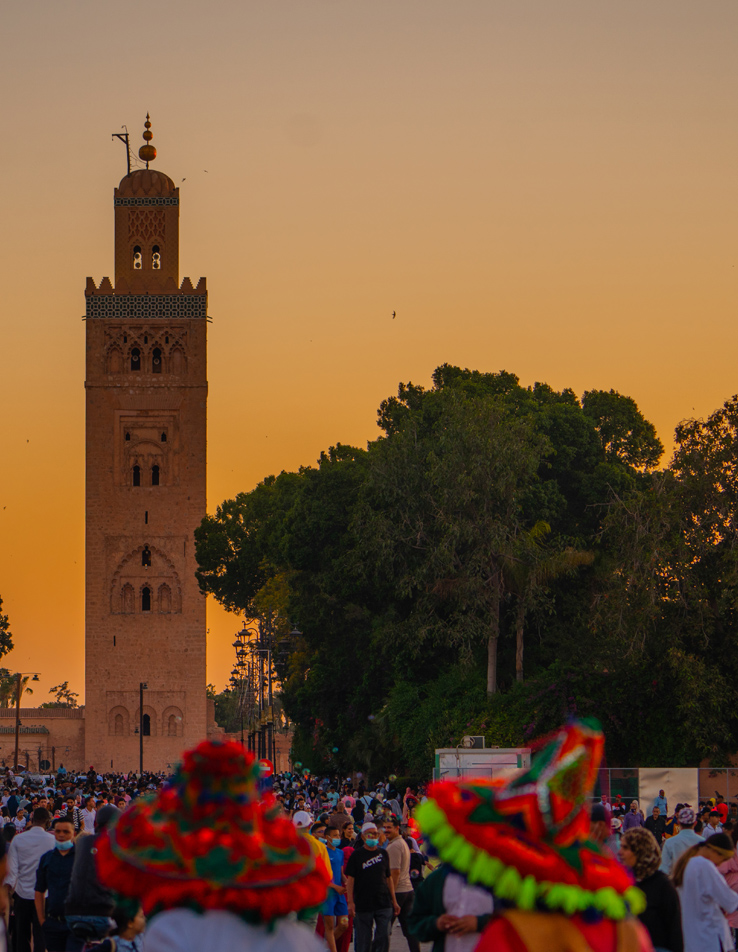
The Pearl of the South
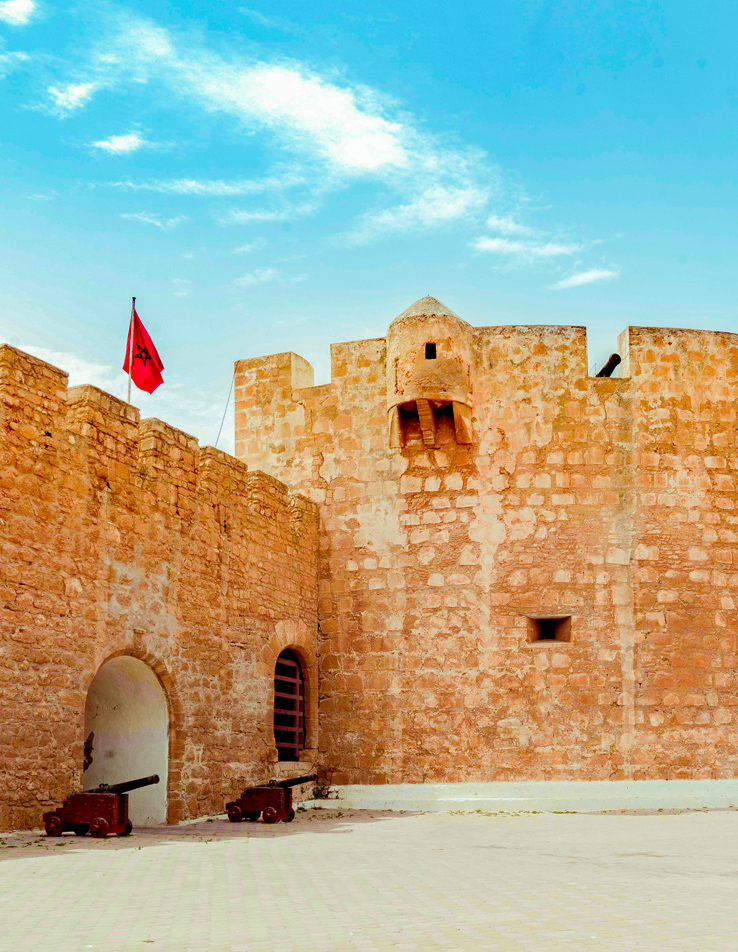
The Pearl of the Atlantic
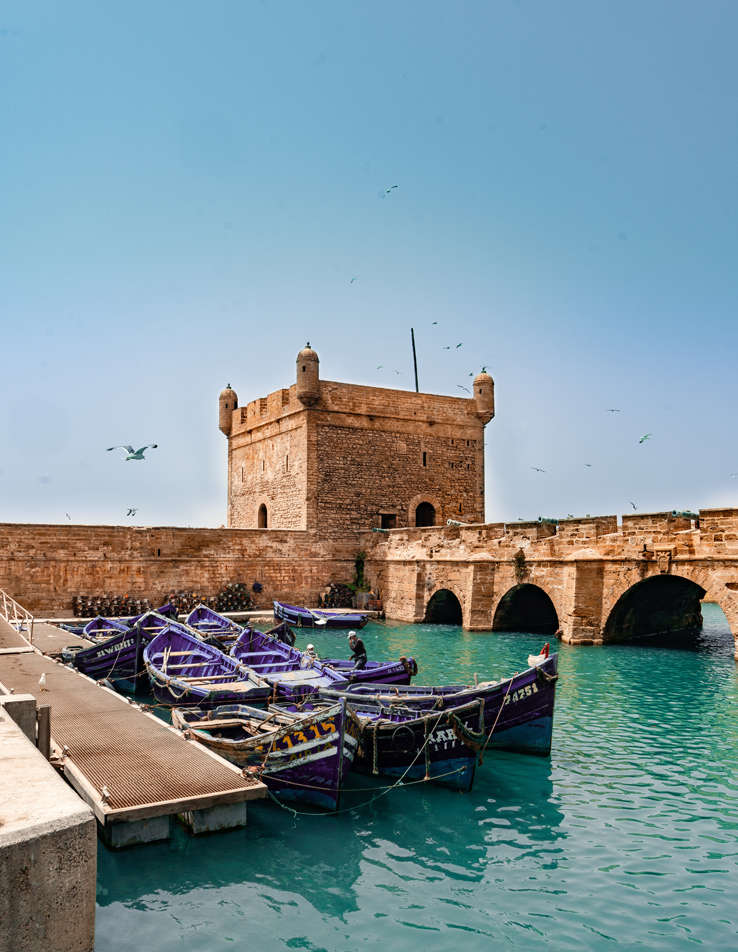
The pearl of Mogador
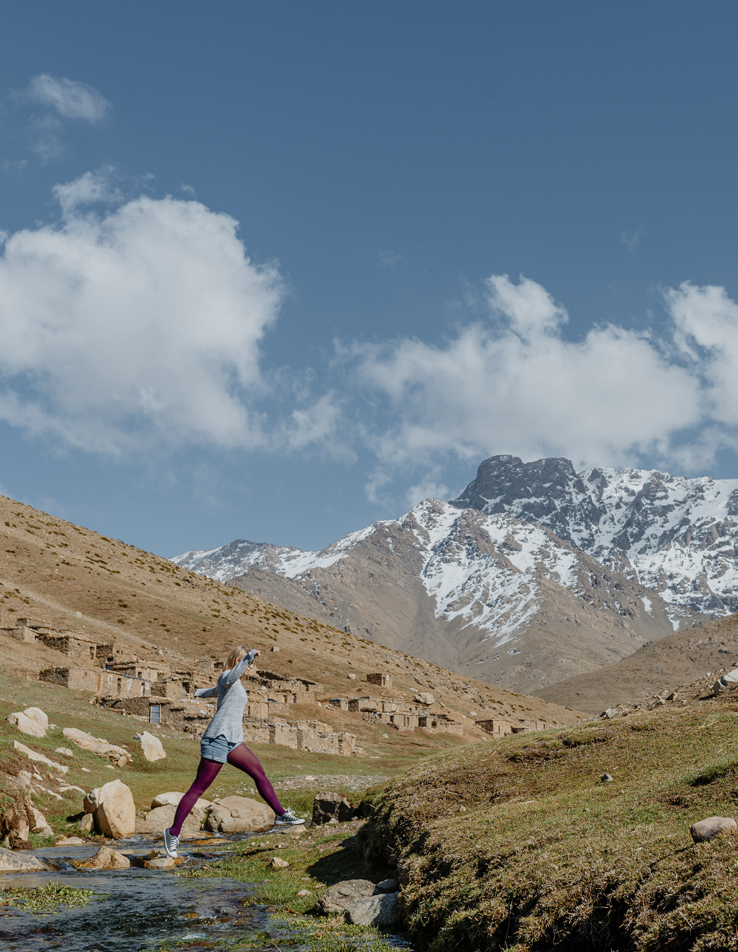
The pearl of the Atlas
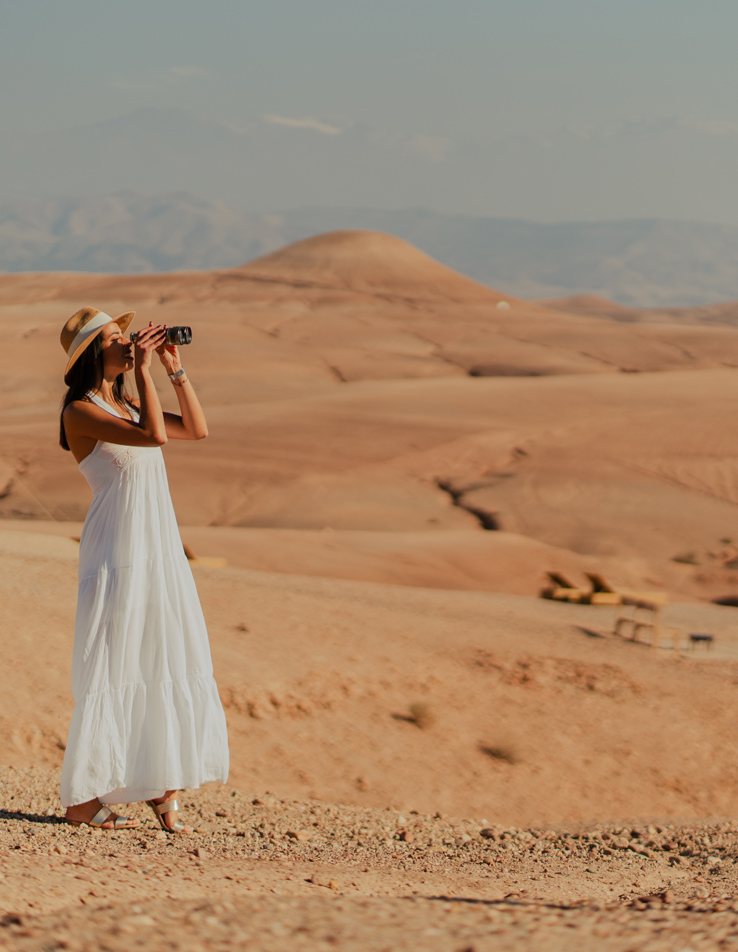
Hidden gem of Marrakech
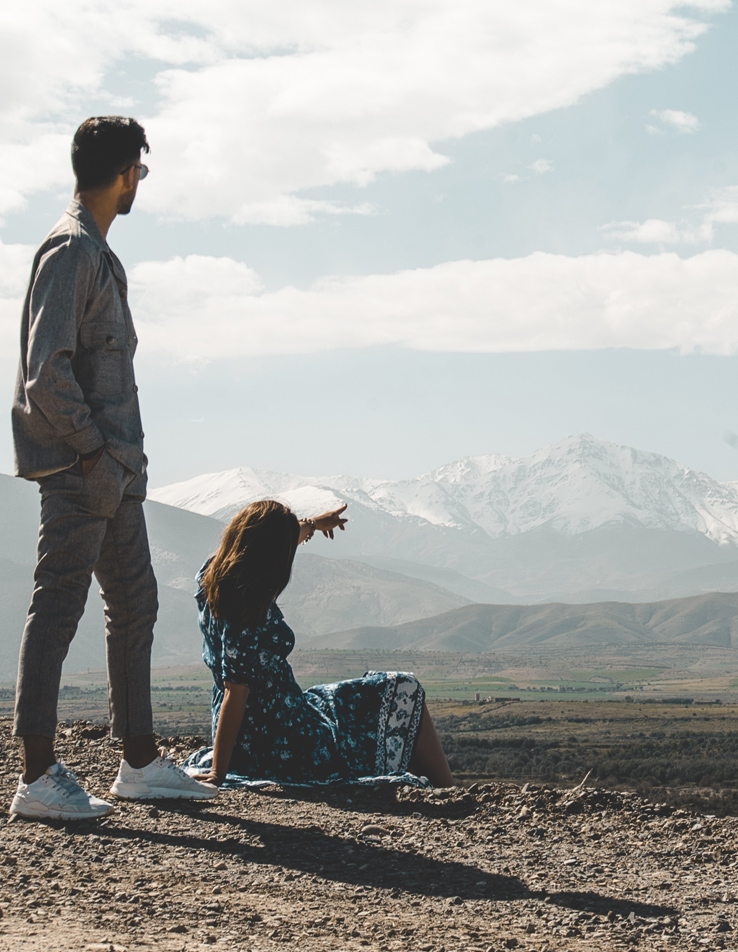
100% Nature Destination
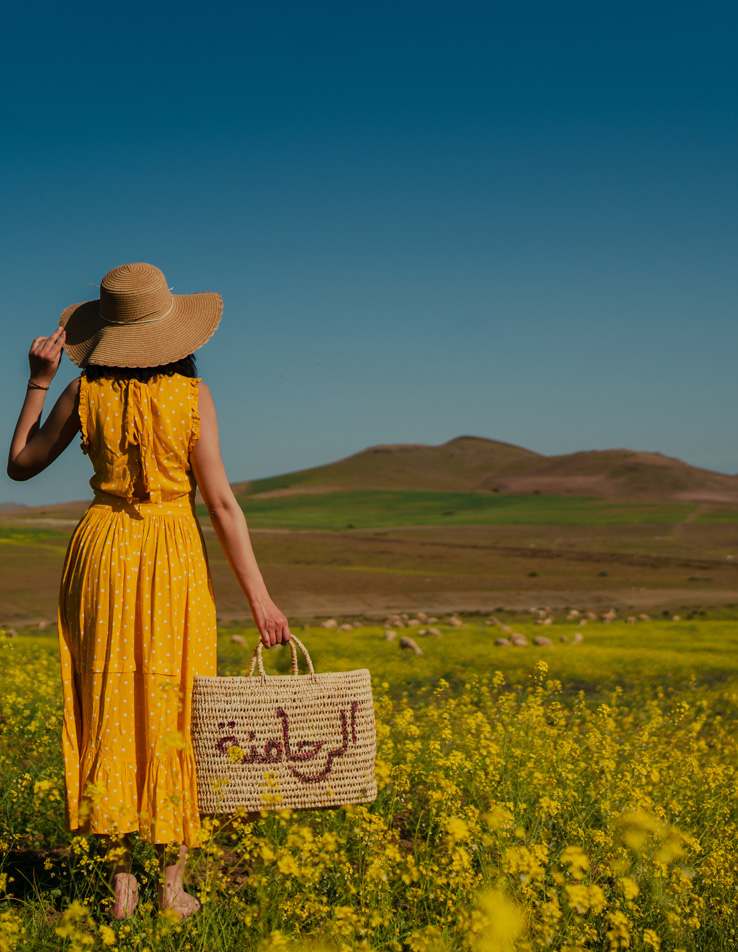
The essence of the hinterland
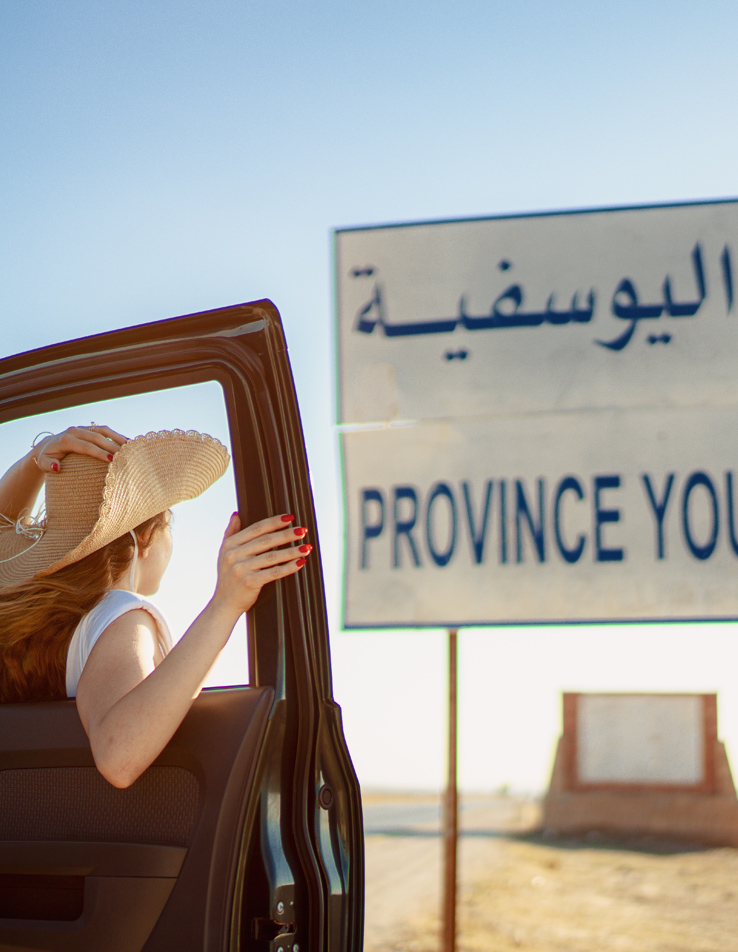
An authentic and memorable land
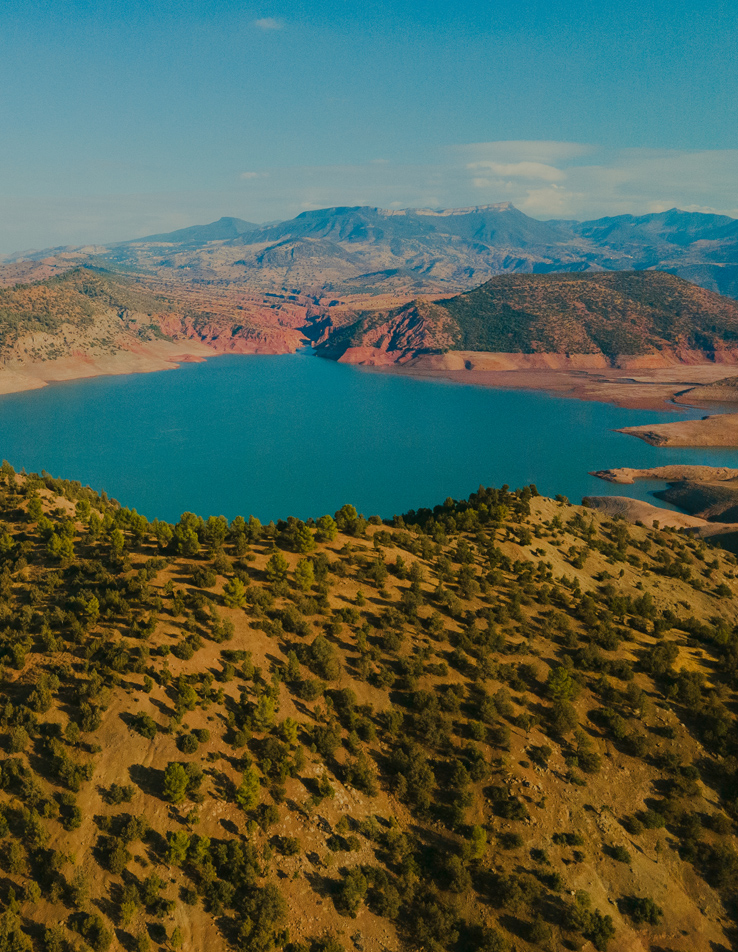
Kelaat des Sraghna
A diverse nature
Did you know ? All the secrets of Marrakech
Bahja agenda events & festivals 2023 & 2024 of the marrakech region, memorable experiences.
As a couple, with friends or family, Marrakech will convince and satisfy all types of travelers, offering you unforgettable experiences.
Personalized hotels and restaurants exceptional in Marrakech
Outdoor activities, shopping & concept store, the marrakech have a message for you, inspiration, meet our experts.

So much to see... RoadTrips™ united, creative and collaborative
You need to know the main places and districts of marrakech, where the foodies are conquered by the local cuisine, news & best of marrakech.
All the news that makes the headlines in Marrakech: events, tourism, people, culture, outings, news,...
International Day of Happiness: Marrakech Shares its Joy and its Bahja
Organized by Cadi Ayyad University of Marrakech in partnership with the Regional Tourism Council…
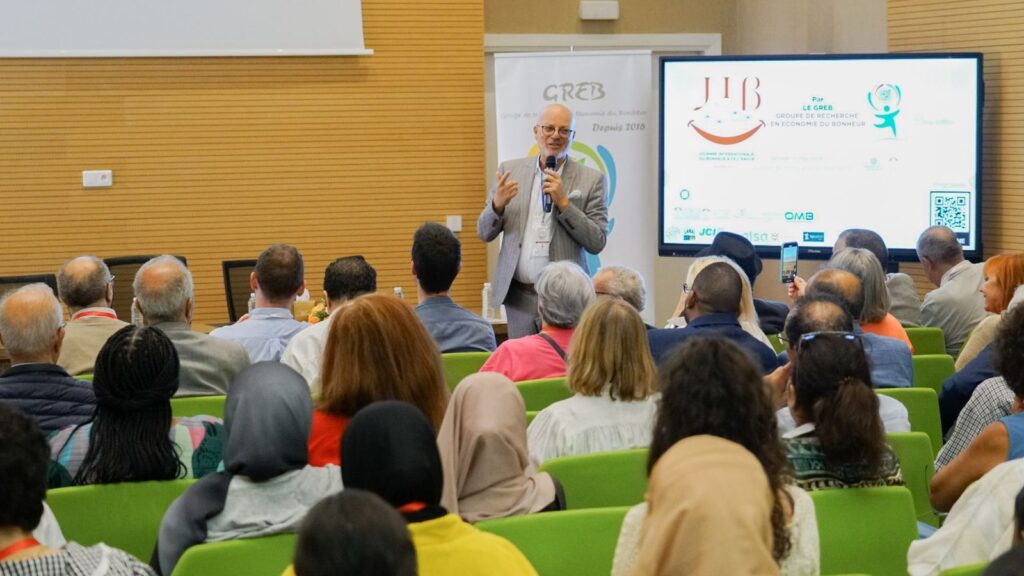
Pictures. The 7th edition of the Marrakech Gnawa Show festival
Images from the 7th edition of the Marrakech Gnawa Show festival will capture the vibrant and…
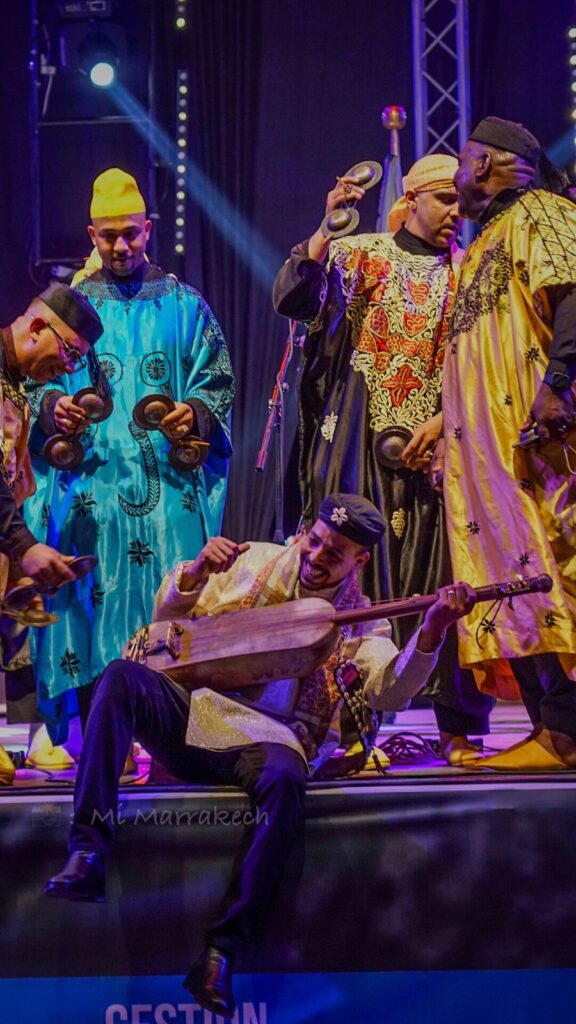
Celebration of Eid Al-Fitr: A Feast of Joy and Solidarity
Eid Al-Fitr, the celebration of breaking the fast, is a time of joy and…
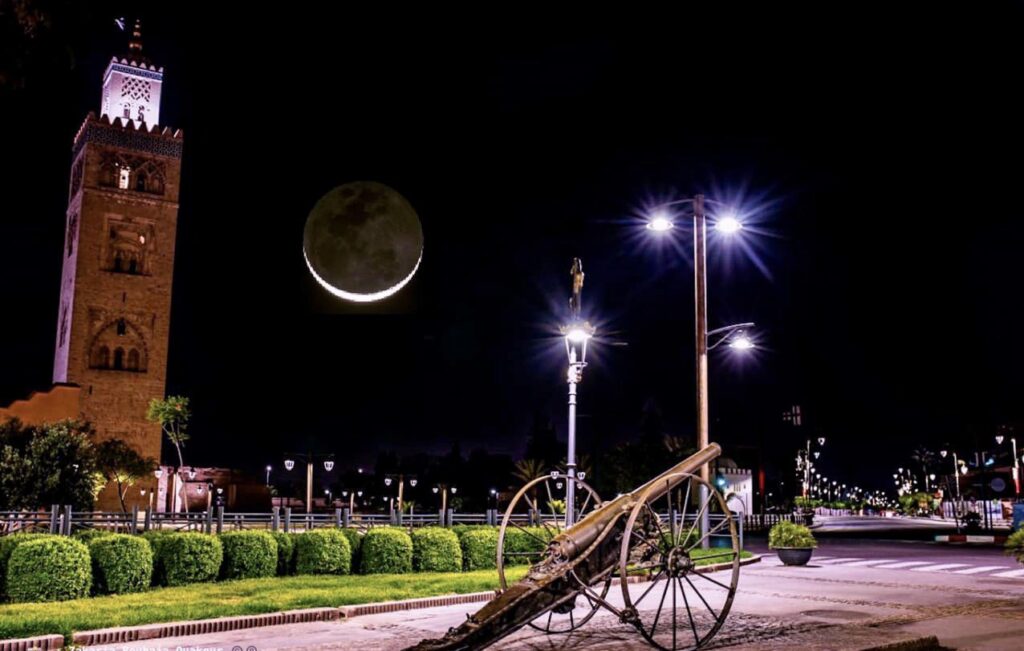
Oasis Festival returns to Marrakech for its 8th edition
Excitement is running high as festival-goers around the world prepare to…
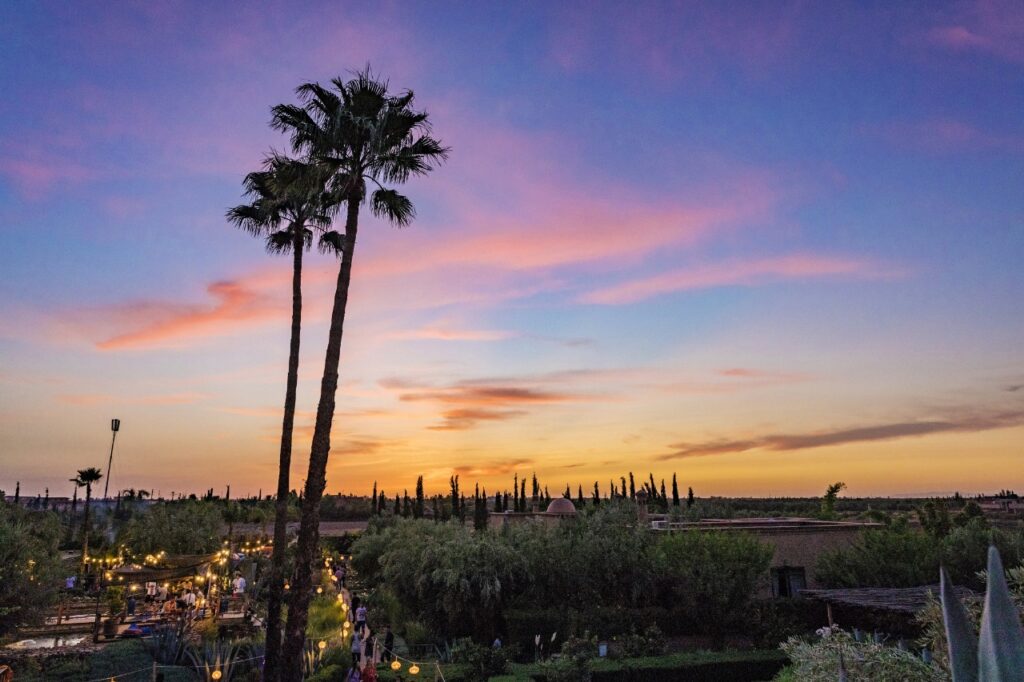
Oukaimeden, snow is back to the delight of winter sports enthusiasts
Situated at an impressive altitude of over 2 meters, the ski resort…
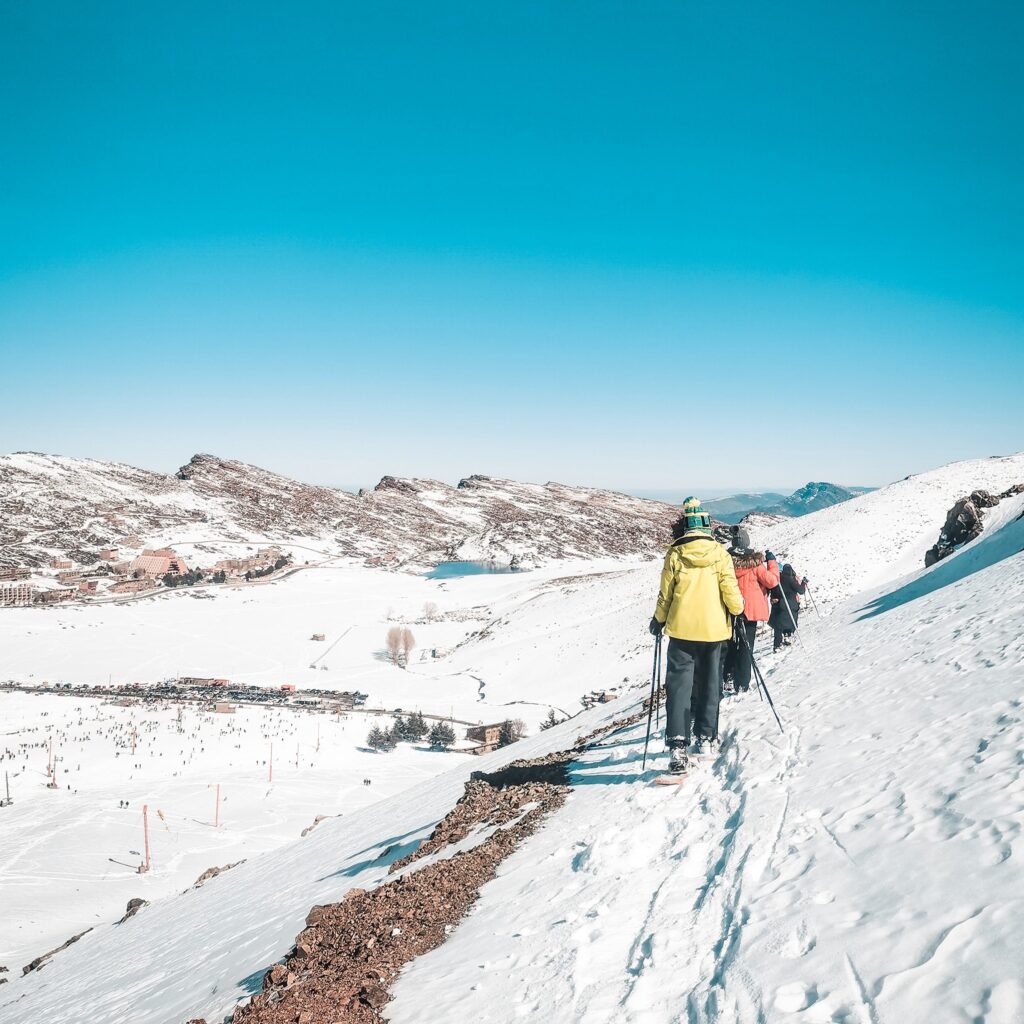
Plan your stay in Marrakech
You will find practical information on how to get there and when, how to get around Marrakech as well as many useful tips.
- Maps and Plans
Guides and Brochures
Info & useful numbers, subscribe to our newsletter, key players who support us.
- Interactive map
- Brochures & Guides
- Mediatheque
- influencers
- General Terms
Official site of the Regional Council of Tourism of Marrakech (CRT). Tel.: (+212) 0524433407 - Email: [email protected] Copyright © 2023 Visit Marrakech & Region. Made with ❤ LOGIC TECHNOLOGIES .
- Create Account
Lost your password?
A password will be e-mailed to you
Please enter your email address. You will receive a link to create a new password via email.
Send message
My favorites.
- The Top 10 Things To...
18 Things to Do in Marrakech for an Authentic Experience

Many people associate the thousand-year-old city of Marrakech with labyrinthine alleyways and snake charmers, which is quite right – but it is equal parts ancient and modern. There are many hip, as well as historic, things to discover in ‘the Red City’ for a truly authentic experience. Think drinking spice-infused cocktails at an underground bar, tucking into slow-cooked lamb and watching artisans at work. Culture Trip curates 18 things to add to your Marrakech itinerary.
1. take in great views and culture at the heritage museum, 2. snap instagrammable pictures at jardin majorelle.
Museum, Botanical Garden
3. Go back in time at Le Jardin Secret
Le Jardin Secret, a secluded riad (a traditional Moroccan house) in the heart of the Medina on Rue Mouassine, features two gardens, a museum, boutique and two cafes. The palace dates back more than 400 years but it was rebuilt in the mid-19th century – and, over the years, it’s hosted some of Morocco’s most important political figures. Head up to its tower, one of the highest in the Medina, for views stretching to the Atlas Mountains, and enjoy strolling around its picturesque gardens. Visit in the morning while it’s quieter and join a guided tour to learn more about its history.
4. Brush up on your history at Bahia Palace
Historical Landmark
This 19th-century palace, set across two acres in the middle of the Medina, is one of the best-preserved historical sites in Marrakech. It was built by Grand Vizier Si Musa in the 1860s and later expanded by his son, Si Ba Ahmed, for his four wives and 24 concubines. It comprises 150 rooms with Andalusian and Moorish influences and intricate marquetry – but the pièce de résistance is the Court of Honour, with a 1,500sqm floor made of Italian marble.
5. Sip a Moroccan spice-infused cocktail at Baromètre
Bar, Restaurant, Cocktails
Cocktail lover? Head down to the experimental Baromètre – Marrakech’s top nightspot, bar and restaurant. Along with a menu of classic drinks, this underground bar brings in a bit of the Medina with local spice-infused spirits. Try the Marrakech Market, which blends whisky with cinnamon, orange and saffron.

Become a Culture Tripper!
Sign up to our newsletter to save up to $1,395 on our unique trips..
See privacy policy .
6. Watch the sunset over dinner at Nomad
Restaurant, Moroccan
7. Sip mint tea on the terraces of Cafe de France
Cafe, Moroccan
Morocco is known for its mint tea – and Cafe de France brews a mean pot. Enjoy this sweet drink (or something stronger on the menu) from the cafe’s terrace, which overlooks the bustling Jemaa el-Fnaa market in the Medina quarter. Here, you can expect to watch a roster of local street performers.
8. Watch artisans make leather at the tanneries
Architectural Landmark, Historical Landmark
Head to the Bab Debbagh quarter, in the northern end of the Medina, to learn all about one of Marrakech’s oldest crafts. Leather tanning is a time-honoured practice and it’s fascinating watching artisans at work. Jump in a taxi to Place Moukef or Bab Debbagh to get there and visit first thing in the morning to see the tradesmen in action.
9. Day-trip to the mountains of Imlil
Natural Feature
Take cues from Marrakech locals and head up to the mountains for respite. The (yellow) shared cabs, parked just down from Jemaa el-Fnaa, can whizz you up to the Atlas Mountains in an hour and a half. Trek up to Toubkal, the highest peak in North Africa, or walk around Berber villages.
10. Watch street performers at Jemaa el-Fnaa
11. haggle over trinkets and treasures in the medina.
Historical Landmark, Architectural Landmark
12. Try a slow-cooked lamb recipe that’s been handed down for generations at Mechoui Alley
Market, Moroccan
For hundreds of years and several generations, the families of Mechoui Alley have woken up early in the morning, stuck a whole lamb on a stick and put it in a large underground oven to slowly roast for four-to-six hours. The result is a deliciously succulent and tender plate of meat that practically falls off the bone. Sprinkle on some cumin and salt for an extra layer of flavour.
13. Get scrubbed down at Hammam Dar el-Bacha
There are few things as quintessentially Moroccan as a trip to the hammam – the Middle East’s answer to a thermal spa. Head on down to the largest public one, Hammam Dar el-Bacha, with your bathing essentials and enjoy being scrubbed across every inch of your body. Be sure to check the timings for men and women before you go.
14. Indulge in French fine dining at the Grand Cafe de la Poste
Restaurant, French
15. Learn about local weaving techniques at Dar Si Saïd
Building, Museum, Natural Feature
Dar Si Said, otherwise known as the Museum of Moroccan Arts, is Marrakech’s oldest museum and it’s where you’ll learn about different Moroccan rug styles. Each region and city in Morocco has its own flair. You’ll see some magnificent examples of traditionally made rugs here, all while also learning about the weaving techniques it takes to create them.
16. Discover old Marrakech at the Maison de la Photographie
17. buy a pair of leather slippers at atika.
Having visited the tanneries, you’ll no doubt feel inspired to leave with some leather goods. Head to Atika for some of the best handmade leather loafers in the city. And don’t be surprised if you leave with more than one pair – there are endless leather colourways, while the store stocks many suede styles too.
18. Cosy up with a novel at the Cafe du Livre
Bookstore, Shop
If you’re looking for English-language books to pass the time on your bus journey down south, then Marrakech isn’t much help as most bookshops only stock French novels. But fortunately the Cafe du Livre keeps a good selection of second-hand English books. It also has the only weekly pub quiz in town.
Sadie Whitelocks contributed additional reporting to this article.

Guides & Tips
How supporting local projects in marrakech can protect tourism and the environment .

See & Do
The top 8 highlights of jewish marrakech.

Meet Morocco’s Gunpowder Girls

The Luxury Desert Stay Close to the Heart of Marrakech


Film & TV
How morocco’s atlas film studios became the world’s biggest film set.

Architecture
Modern marrakech: contemporary buildings reinventing the city.

Places to Stay
The best hotels in – and near – the medina in marrakech.

A Go-To Guide to Skiing in Morocco's Oukaïmeden Mountain

The Best Experiences To Try in Marrakech

Hidden Gems to Explore in Marrakech

Travel the World Virtually With Immersive Sonic Escapes

Sights, Sounds and Souks: Six Days in Marrakech
Culture Trip Summer Sale
Save up to $1,395 on our unique small-group trips! Limited spots.

- Post ID: 382374
- Sponsored? No
- View Payload

The Ultimate Guide to Marrakech
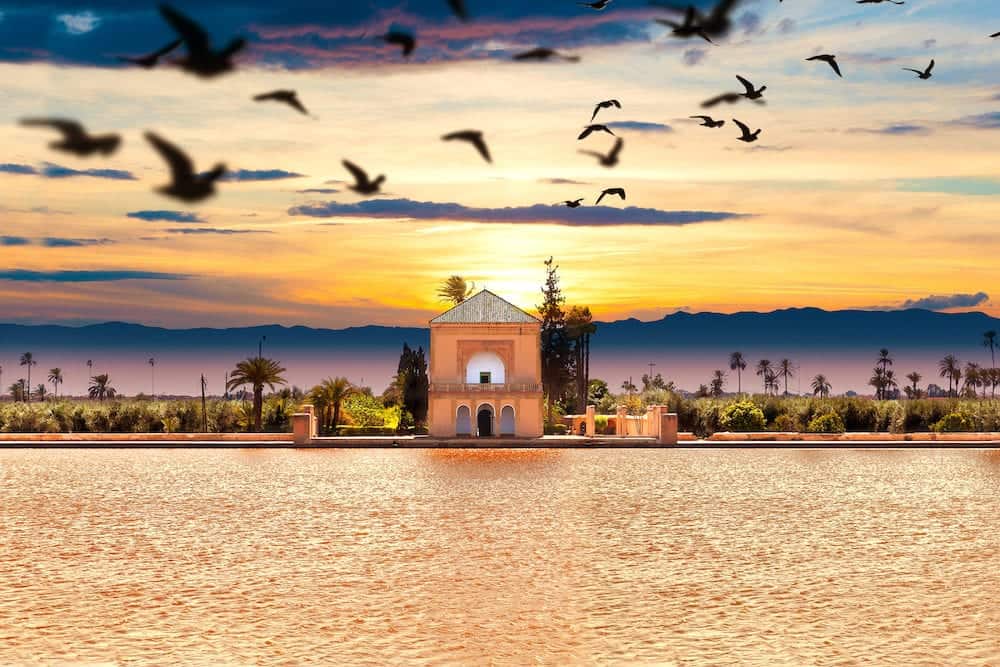
Marrakech is an energetic and eclectic city in the southwest of Morocco. Though it is not the capital, it is considered the cultural hub and home to a walled medieval city and marketplace from the Berber Empire.
The vivid architecture and colourful textiles found in Marrakech draw in a hip, bohemian crowd to this already lively city.
This guide will show you all of the top things to do in Marrakech, Morocco, including what to see and where to stay.
Plan your trip?
Avoid hidden fees in the exchange rate while withdrawing from millions of ATMs abroad, paying in restaurants and shops, and buying your accommodation and flights using the Wise Card . You can hold up to 40+ currencies at once to spend in in over 150 countries, and convert them in real time with the free Wise app.
Need help planning your trip from start to finish? Check out these helpful links:
- Cheap flights
- Savings on accommodation from hostels to luxury hotels
- Affordable car rental options
- Affordable sightseeing tours and day trips
- Travel Adapter – All in one so you don’t have to carry a bunch around
- Don’t be silly and forget Travel Insurance ! Get hurt and you’ll regret it…
This post contains some affiliate links for your convenience. Click here to read my full disclosure policy. You can also read our content/editorial policy here .
Table of Contents
How to get to Marrakech
The city’s Menara Airport is served by over 30 international airlines. Layovers in Casablanca are common, but there are many direct flights from Europe and a few Arab countries.
The airport is six kilometres from the centre of Marrakech, so you will have to catch a shuttle bus, taxi or private transfer. The transport company ASLA runs reliable buses every 30 minutes between the medina, the new town and the airport. When taking a taxi, the fare is typically 150 dirhams.
If you’re travelling to Marrakech from elsewhere in Morocco, the railway system links most of the major cities. Trains to Marrakech from Casablanca and Rabat take about four hours. You can also look into the comfortable and air-conditioned CTM and Supratours buses.
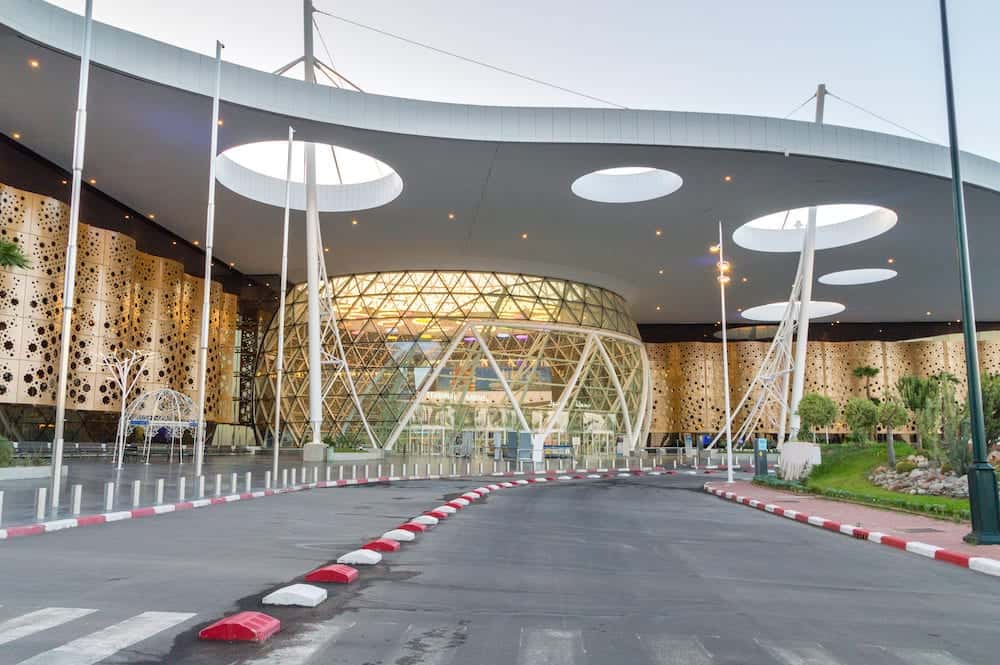
What to expect in Marrakech
Darija (aka Moroccan Arabic) and Berber are the official languages of Morocco. However, French is commonly spoken and is even considered an unofficial language. Signs in Marrakech, for example, are typically written in both Arabic and French.
As Marrakech is a huge tourist destination, you will find that most hotel and restaurant staff will be able to communicate with you in English. At the very least, English menus will be available.
Moroccan dirham is the local currency, and can only be acquired once you arrive in the country. It can be hard to exchange lesser-used currencies, so it’s best to travel with euros, U.S. dollars, or even British pounds.
You can easily convert these currencies at Moroccan airports, banks, or even hotels. If you’re making an expensive purchase, euros and USD may be accepted, but it’s best to use dirham day to day. For reference, one euro currently equals about 10 dirhams. If you have any cash left over at the end of your trip, remember to exchange it back before you leave.
When it comes to tipping, there is no set rule. If you’re at an upscale restaurant, a service charge might be added to your total.
If tipping is something you’re concerned about, round up the final bill to at least the nearest 10 dirhams. It is generous to leave 15 to 20 dirhams to taxi drivers and hotel porters, while 100 may be appropriate to leave a maid after a week-long stay.
How to get around Marrakech
The most convenient way to wander Marrakech is on foot. Many of the streets and alleyways are winding and narrow, making some areas difficult for cars to pass through. Fortunately, most of the must-see attractions are within walking distance.
If your accommodation is a little far out from the medina, you can catch a shuttle provided by your hotel or take a taxi . Apps like Uber and Lyft aren’t available here, but you can find plenty of taxis with running meters.
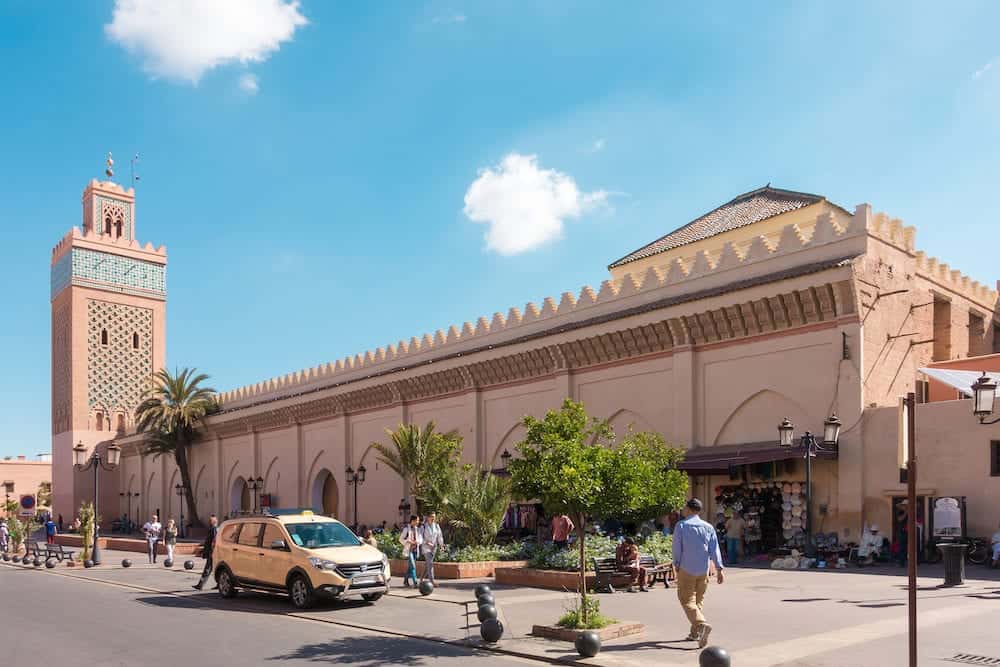
The best time to visit Marrakech
Spring and Autumn are the ideal times to visit Marrakech and Morocco in general. From March to May and October to November, the weather is mild and perfect for exploring. You’ll also avoid heavy crowds that are common during the summer holidays.
Speaking of which, summers in Marrakech are known to be extremely hot, so avoid visiting during June to September. Ramadan also occurs at the beginning of summer, since the majority of the population are Muslim.
Specific dates vary year to year, but it generally begins in May and ends in June. However, if you want to partake in this religious holiday and think you can handle the heat, you will certainly have a memorable trip.
In fact, you may have a more authentic experience and become more familiar with the culture by visiting during Ramadan.
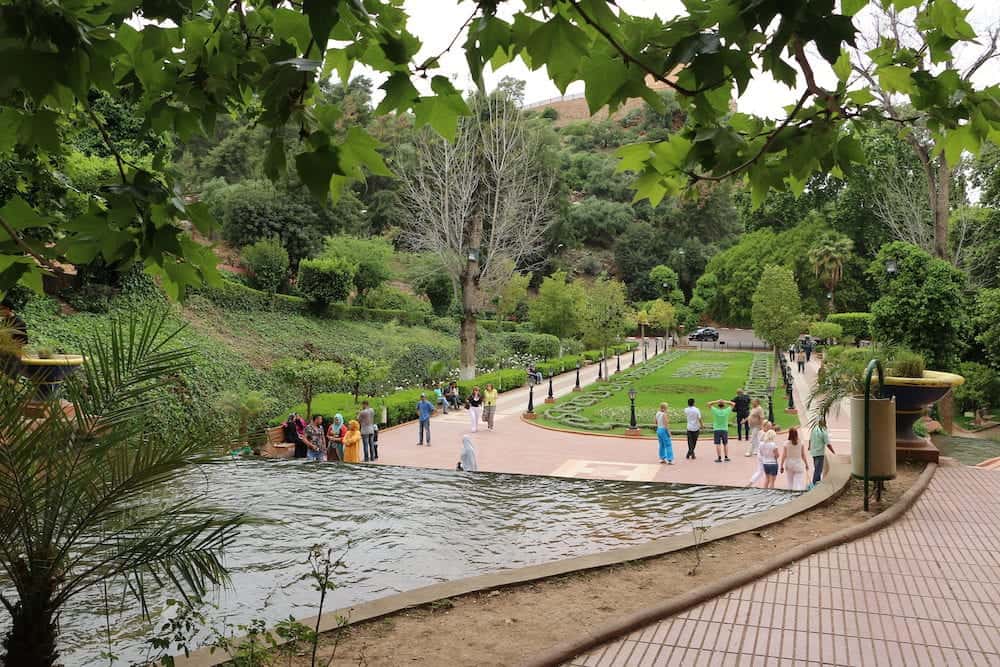
Things to do in Marrakech
Many tourists flock to Marrakech for the incredible textiles, ceramics and handmade crafts. Simply put, it’s a fantastic and unique shopping destination if you know how to haggle.
Jemaa el-Fnaa, the main square, engages all your senses and is unlike any market you’ve ever been to. It’s considered the centre of the city, and you must experience this lively place for yourself.
Just beware of the snake charmers, monkey handlers, and even the occasional wandering tortoise!
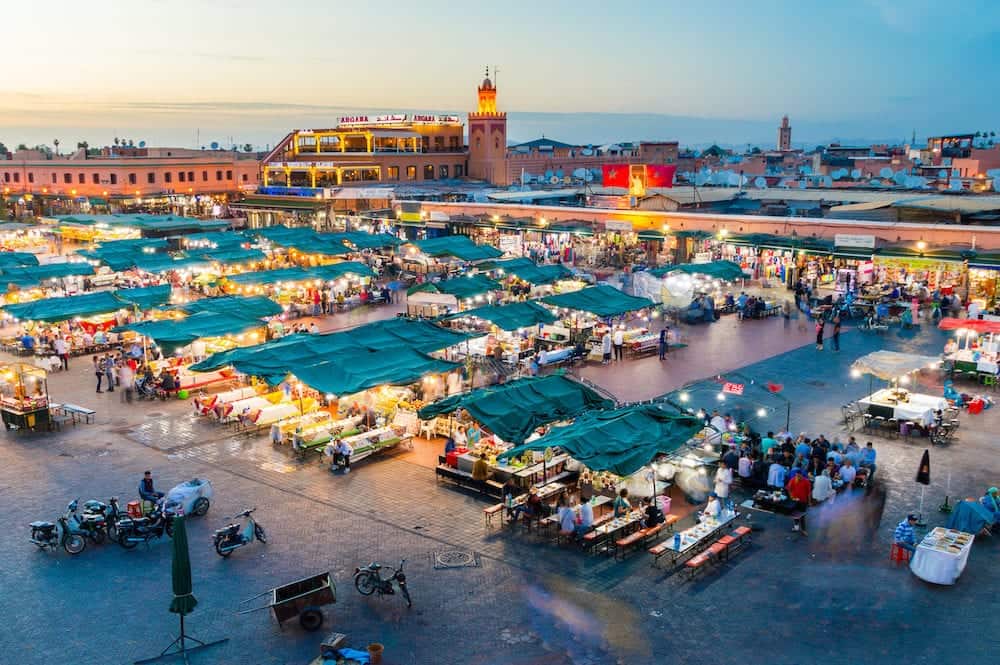
You will find souks upon souks filled with elegant lanterns, colourful plates, eclectic rugs and glittering jewellery.
It can be intimidating at first, so take your time looking around and come back the next day to make your purchases. Even if shopping isn’t your priority, a visit to the square is still a must.
People-watching while enjoying some fresh orange juice or mint tea can be one of the most enjoyable Marrakech activities .
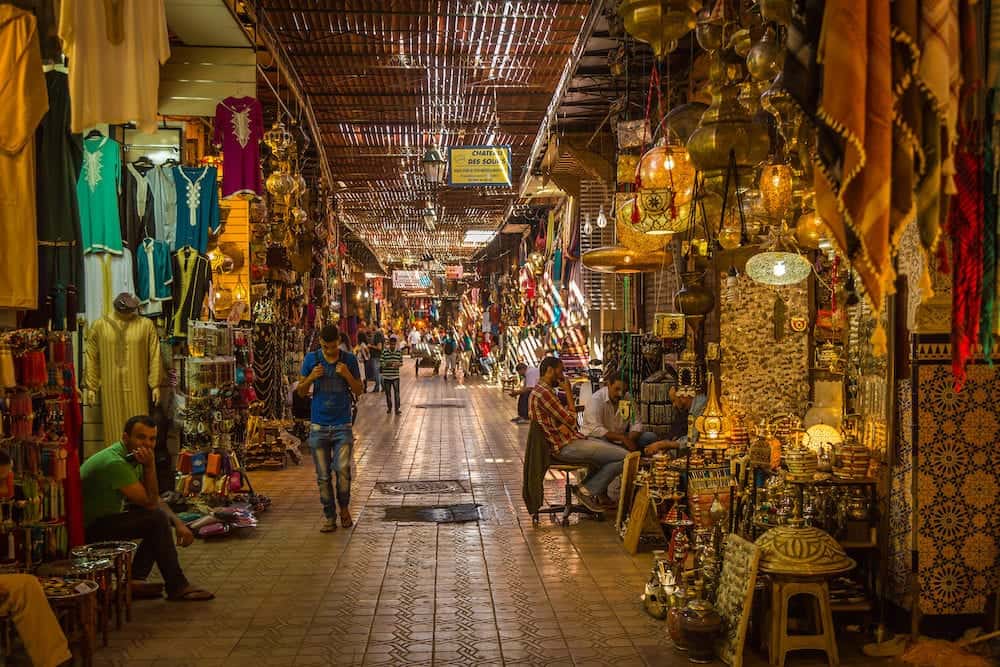
Since Morocco is an Islamic country, you may be wondering about things to do in Marrakech at night. Venturing into the square is all it takes to have an exciting evening.
Late at night, the live music and drumming go crazy in the best possible way. If you prefer to observe the chaos rather than be amongst it, grab a drink at Le Grand Balcon du Café Glacier.
The balcony has an amazing view of Jemaa el-Fnaa that you won’t find anywhere else.
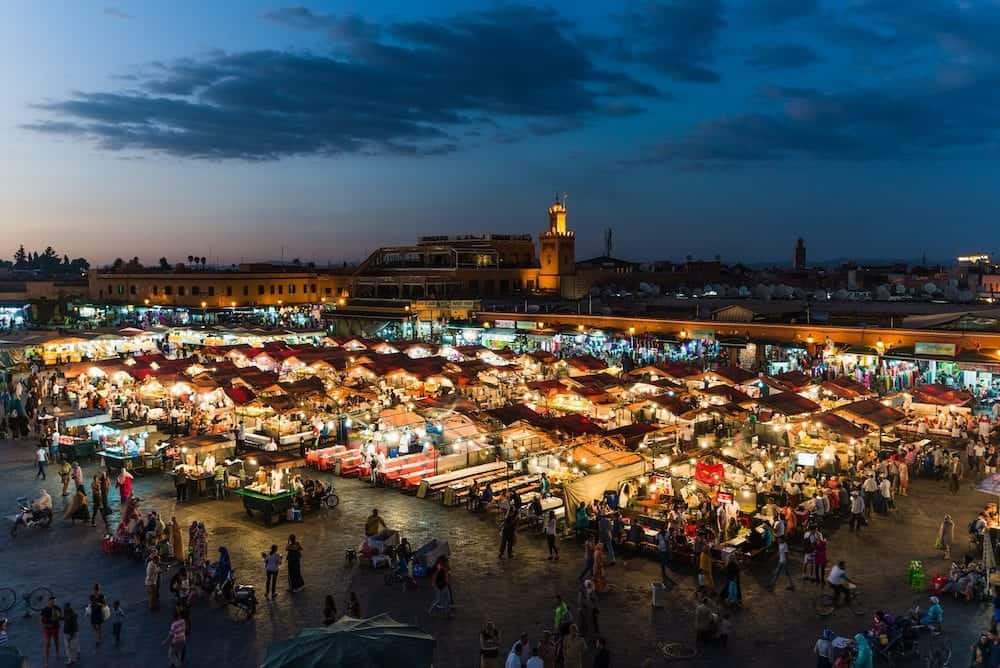
Places to visit in Marrakech
When wondering what to see in Marrakech, you won’t want to miss Jardin Majorelle. This bold botanical garden is one of the most frequented spots in all of Morocco.
When you’re done exploring the outside, take a look at the Berber Museum and Islamic Art Museum.
The complex is also home to the newly-built Yves Saint Laurent Museum, dedicated to the French fashion designer who made Marrakech a second home.
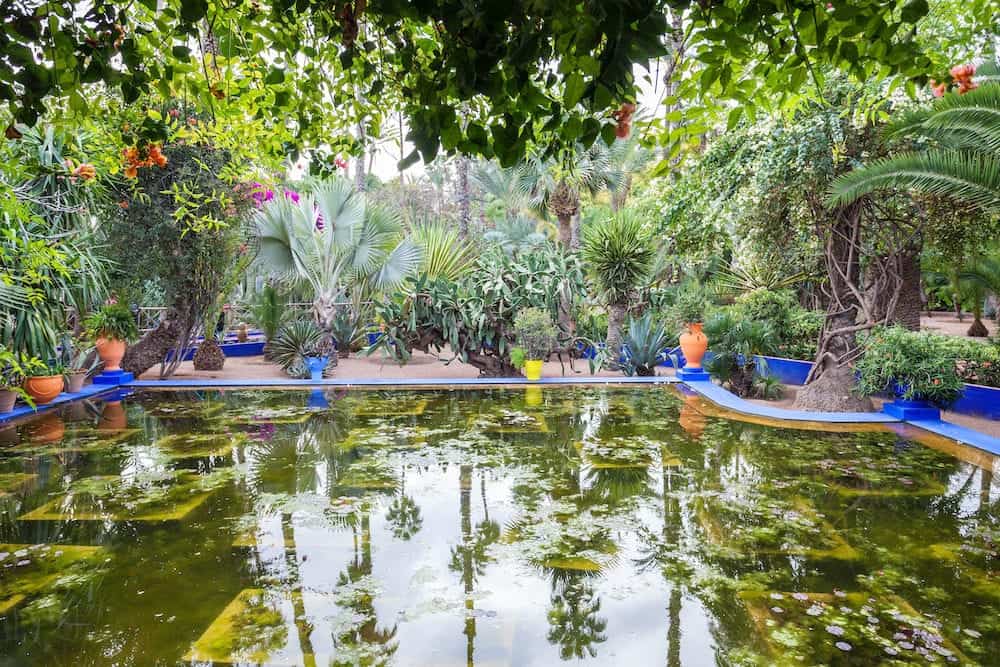
The fascinating, intricate architecture makes the mosques and palaces the best places to visit in Marrakech. Bahia Palace was built in the 19th century with the intention of becoming the greatest palace of all time.
It is considered to be a masterpiece, with colourfully stained glass windows and engraved columns. El Badi Palace, on the other hand, is a former royal residence in ruins.
The 16th-century palace once contained over 350 rooms made from gold, onyx, marble and cedar wood. The enormous complex fell into decay following a civil war in the late 17th century.
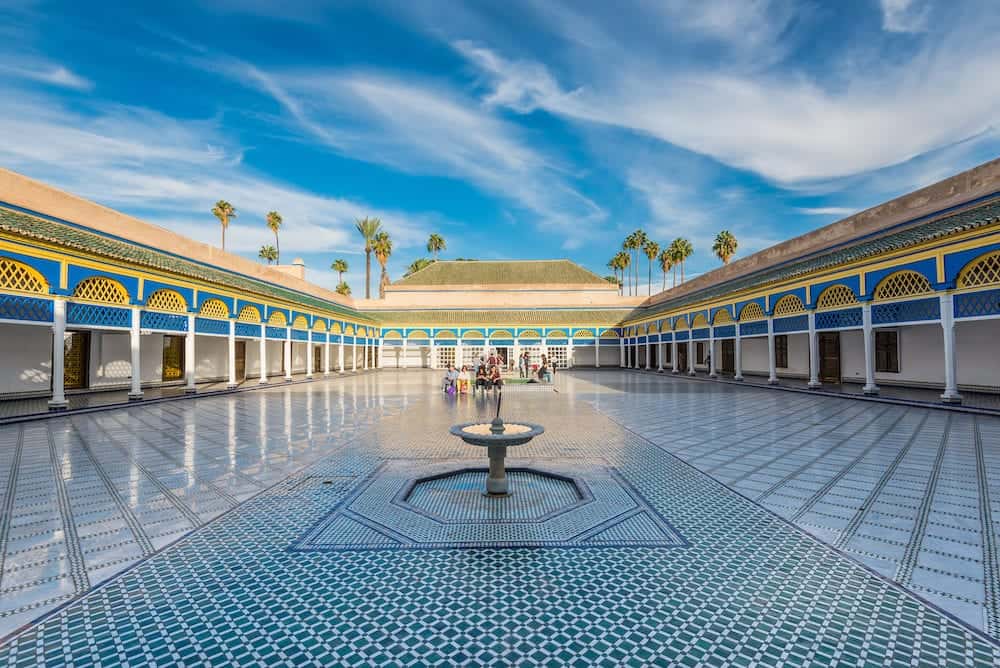
To keep the history lesson going, you must explore the Saadian Tombs . Conveniently, they are only a few hundred metres from El Badi.
Though only discovered in 1917, the tombs date back to the Saadian Dynasty of the 16th and 17th centuries.
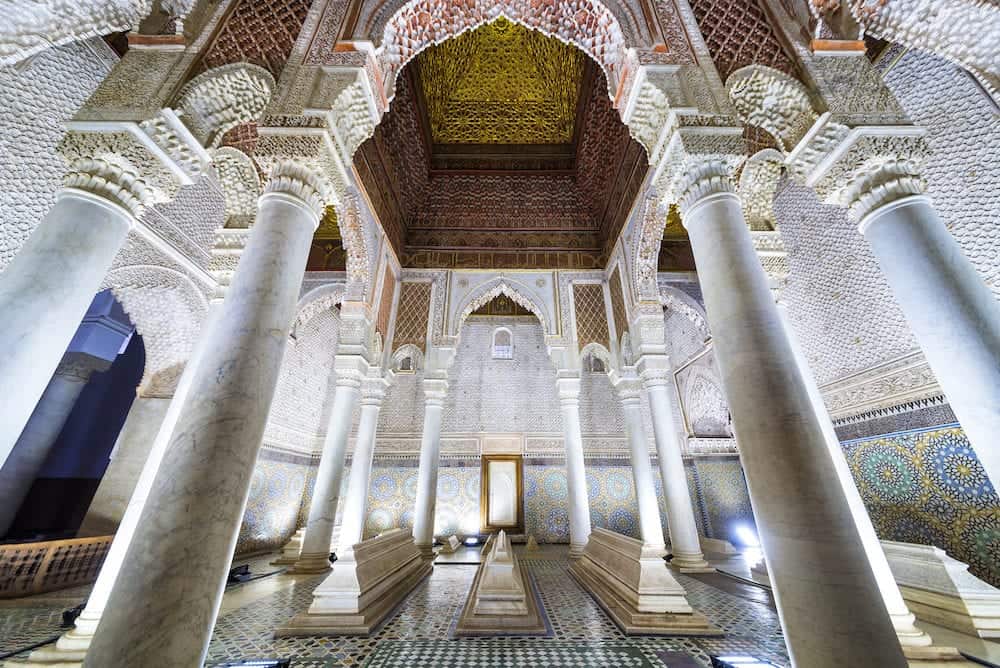
If you’re looking for free things to do in Marrakech after spending all your money at the souks, head to Koutoubia Mosque .
It’s the largest mosque in Marrakech, and you will immediately spot its 77-metre high minaret tower. It is illuminated in the evenings, so be sure to visit during sunset.
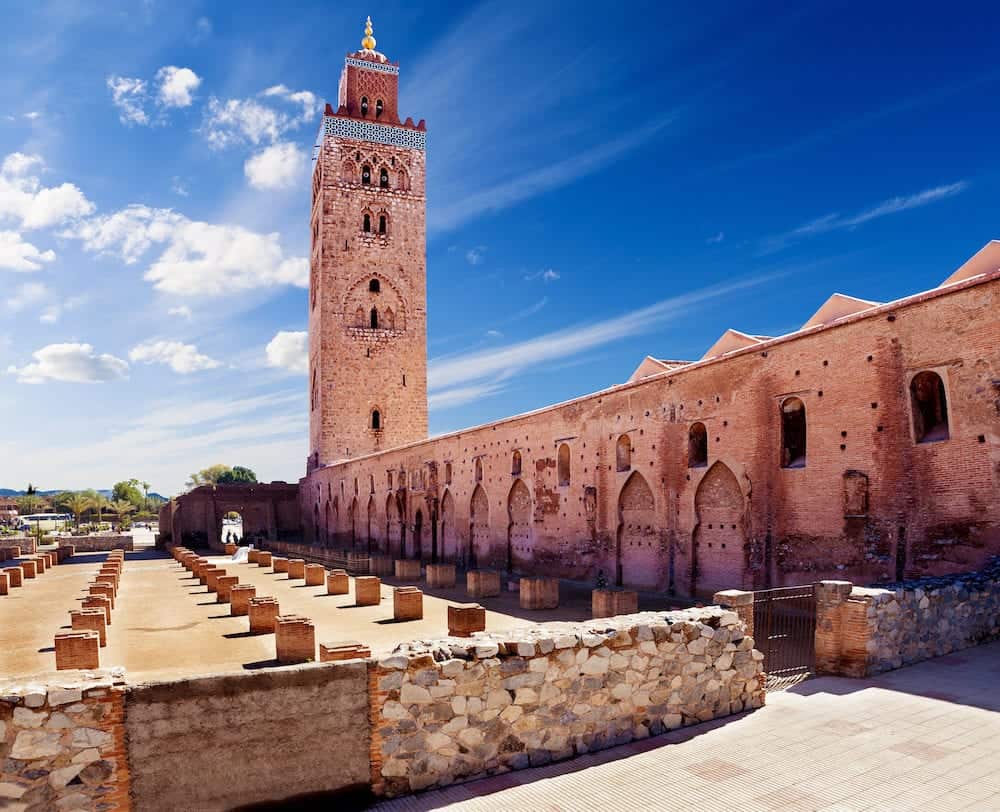
Lastly, you can’t forget one of the most gorgeous Marrakech sites, the Ben Youssef Madrasa. 500 years ago, it was the largest Islamic school in northern Africa.
It has since become a museum and is open to the public daily. You’ll be in awe over the incredible attention to detail here, with stunning mosaics, marvellous carvings and beautiful marble patios.
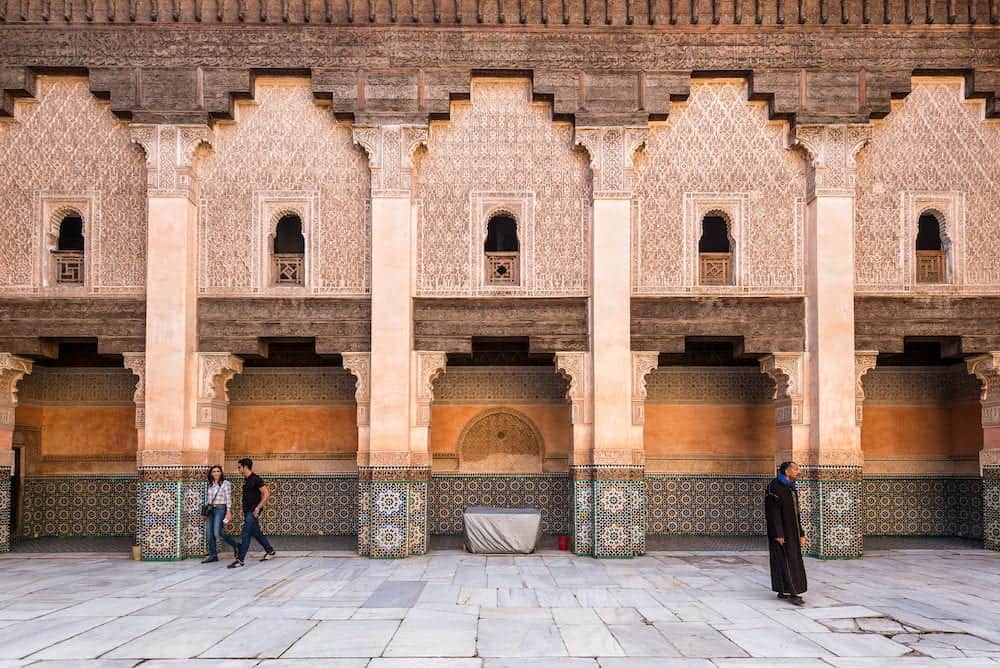
What to eat in Marrakech
Moroccan cuisine is a fascinating mix of Arabic, Mediterranean, Berber and Andalusian foods. Couscous is the country’s main dish, and beef, chicken and lamb are commonly consumed. Middle Eastern flatbread known as khubz is also a favourite.
Dishes are limited if you’re a vegetarian or vegan, but you will always find some delicious and authentic vegetable tagine . There’s also zaalouk , a popular cold salad made from tomato and eggplant.
The best food in Marrakech is often where you’d least expect, and typically out of the main tourist hot spots. However, if you’re in a main area like Jemaa el-Fnaa and want to grab a bite, only eat at stalls the locals are also eating at.
The atmosphere at Atay Cafe will make you want to indulge in a three-hour lunch. You’ll taste some of the most delicious tagines in Marrakech here, whether lamb or vegetarian. Relax with a cup of mint tea and watch the sunset from the inviting rooftop terrace.
Plats Haj Boujemaa is the ultimate restaurant for meat lovers. Though they serve a range of both international and Moroccan foods, grilled meats are their speciality. This local spot boasts affordable prices and is open until one in the morning, ideal for when hunger hits late in the evening!
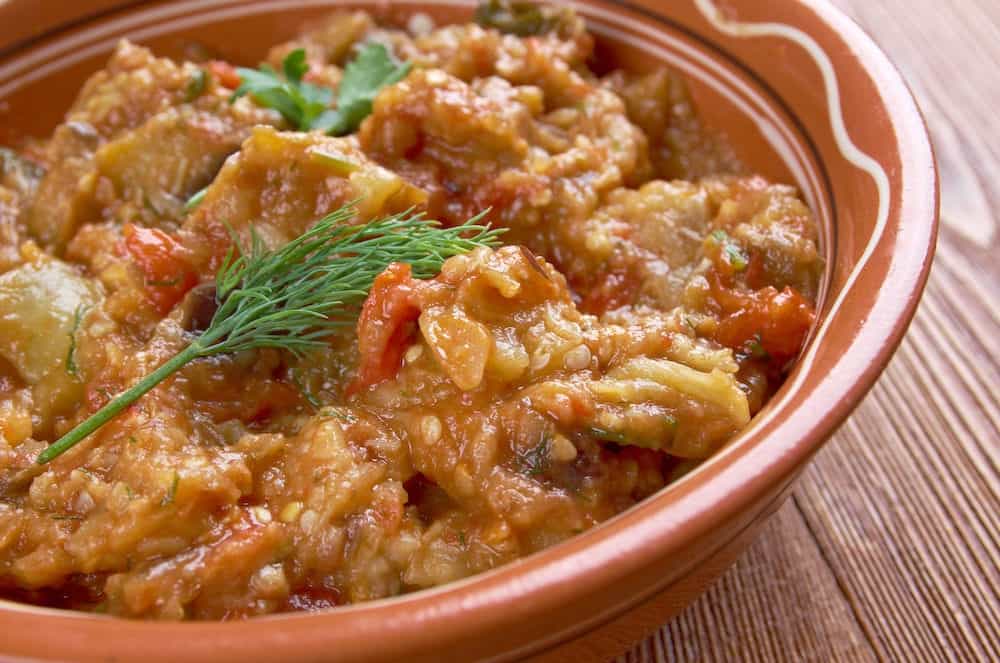
Where to stay in Marrakech
The most intriguing place to stay in Marrakech is at a traditional Moroccan home known as a riad. You can identify a riad by the interior courtyard (often featuring a swimming pool) and the colourful tiles. Here are a few of the most memorable places for you to stay at while in Marrakech.
Although Riad Idra is located right within the medina, it’s an idyllic oasis inside. Escape the hustle and bustle in the luscious courtyard or on the romantic rooftop terrace. There are only seven rooms and suites available, making your stay even more private and intimate.
Each space is adorned with Moroccan and Islamic-inspired furnishings. The riad is a few hundred metres from the Museum of Women and Le Jardin Secret, and a 10-minute walk from the main square, Jemaa el-Fnaa.
Riad Al Jazira is elegant and modern while still maintaining Moroccan charm. This boutique accommodation brings together three separate riads and patios, including a rooftop terrace and a swimming pool.
The earthy tones of the rooms and suites give a warm and cosy feel, with stunning lanterns and Berber rugs everywhere you look. Take a pottery workshop or Arabic calligraphy class, then end the day at the relaxing spa.
Kasbah Le Mirage diverges from the traditional riad, but still captures the essence of Morocco. It’s ideal for a quiet retreat, as it sits along the Tensift River 15 kilometres from the city centre. A free shuttle is offered twice daily, so this slight distance won’t be an issue.
You’ll see classic Moroccan architectural elements throughout the rooms, such as bejmat tiles and tadelakt walls. Choose from a range of pampering treatments during your stay, or get outdoors and partake in the numerous activities offered.
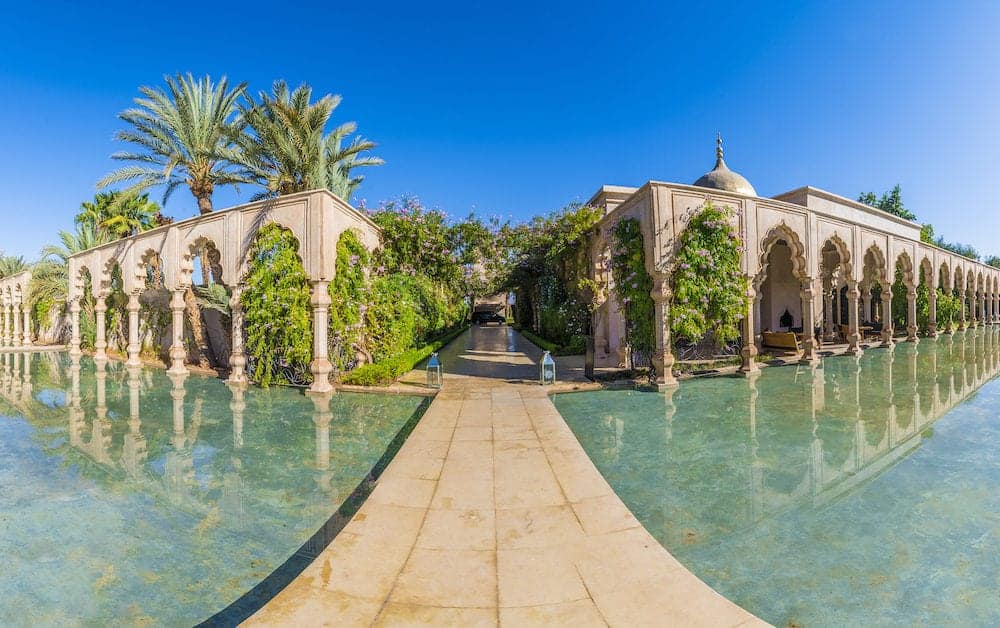
Tours to do in Marrakech
Want to tick something off your bucket list? A hot air balloon ride over the Atlas Mountains is an experience you will never forget.
Marrakech By Air and Ciel d’Afrique Hot Air Ballooning both run sunrise flights with a complimentary Berber breakfast.
While group tours are the cheapest, you can book a private flight for a more romantic occasion. It is absolutely one of the top things for couples to do in Marrakech!
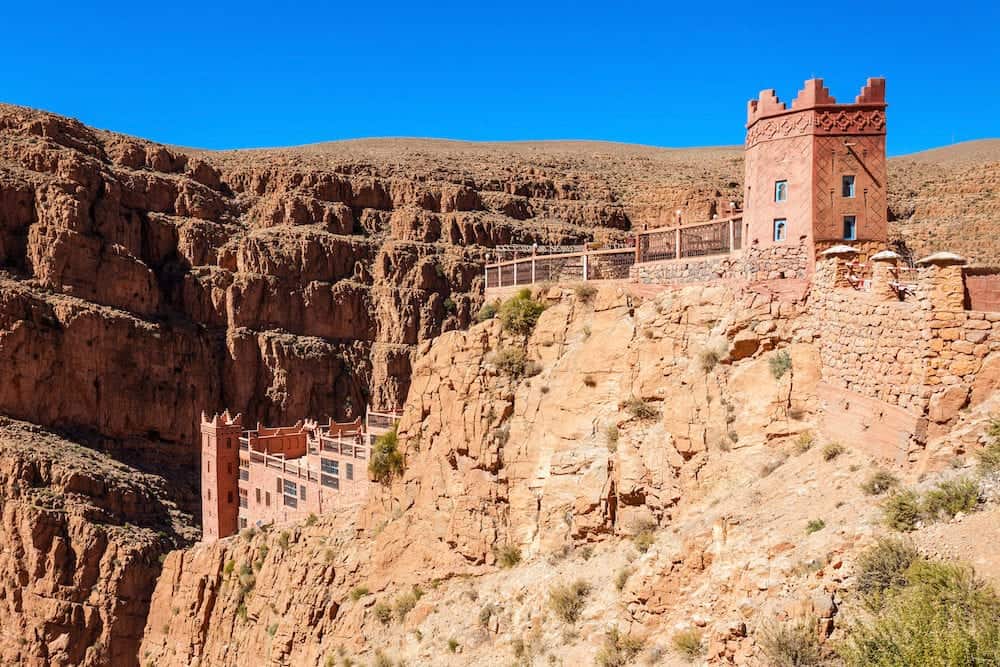
Another enjoyable tour is a sunset camel ride . Palmeraie is an oasis of palm trees right outside of the city, waiting for you to explore via camel.
At the end of the ride, M and A Tours can take you to a local Berber house to drink mint tea and learn about the culture and people living in the area.
This experience is truly one of the most unique things to do in Marrakech and guarantees you an authentic Moroccan experience.
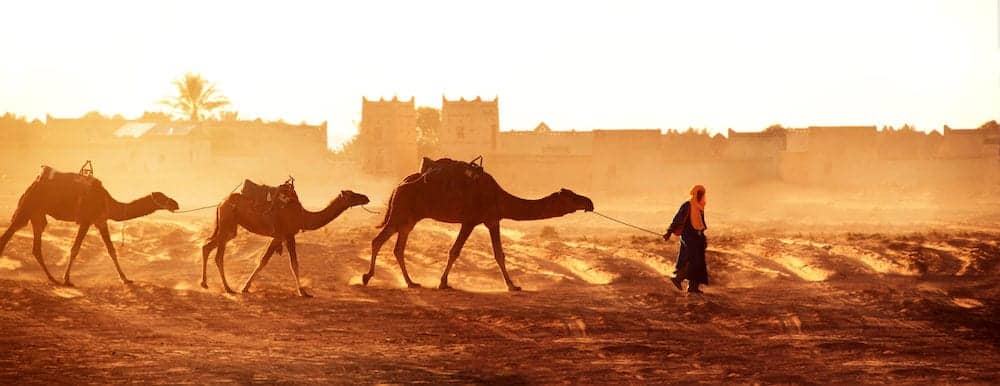
If you want to know how to eat like a local, take a four-hour food tour with AXS. By bike, you will stop by bakeries, spice shops, and other spots to sample delicious Moroccan foods.
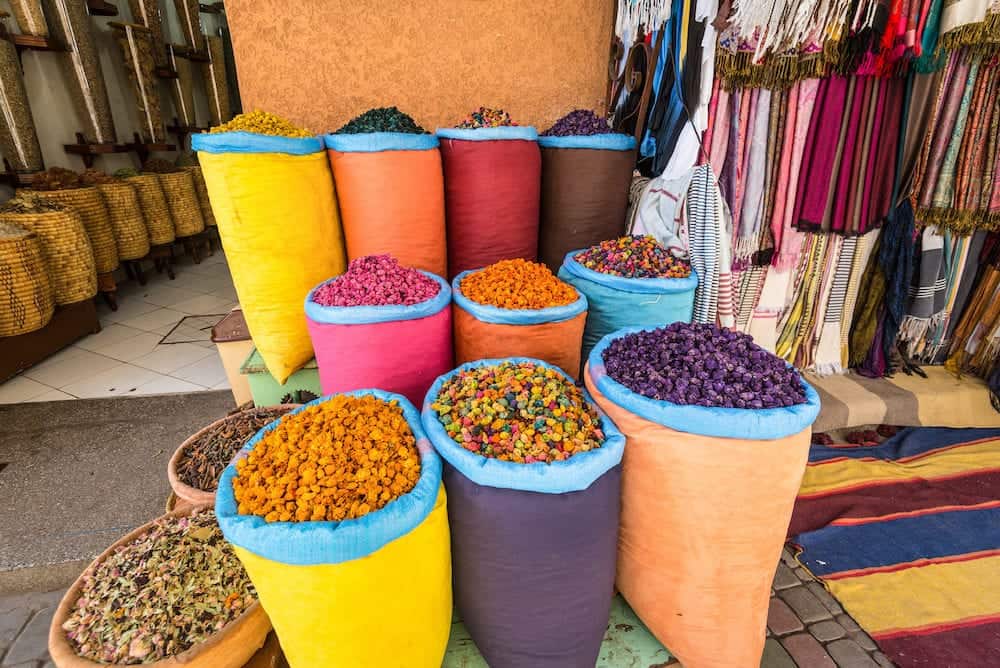
Day trips from Marrakech
One of the ultimate day trips to take from Marrakech is an adventure to the Atlas Mountains. On this full-day trip run by Trekking with Morocco, you’ll be driven through the Moulay Brahim Gorges and to the picturesque Imlil Valley .
Your guide will take you on a one to three-hour trek to the Berber village of Ait Souka, followed a visit to the waterfalls at Arouz.
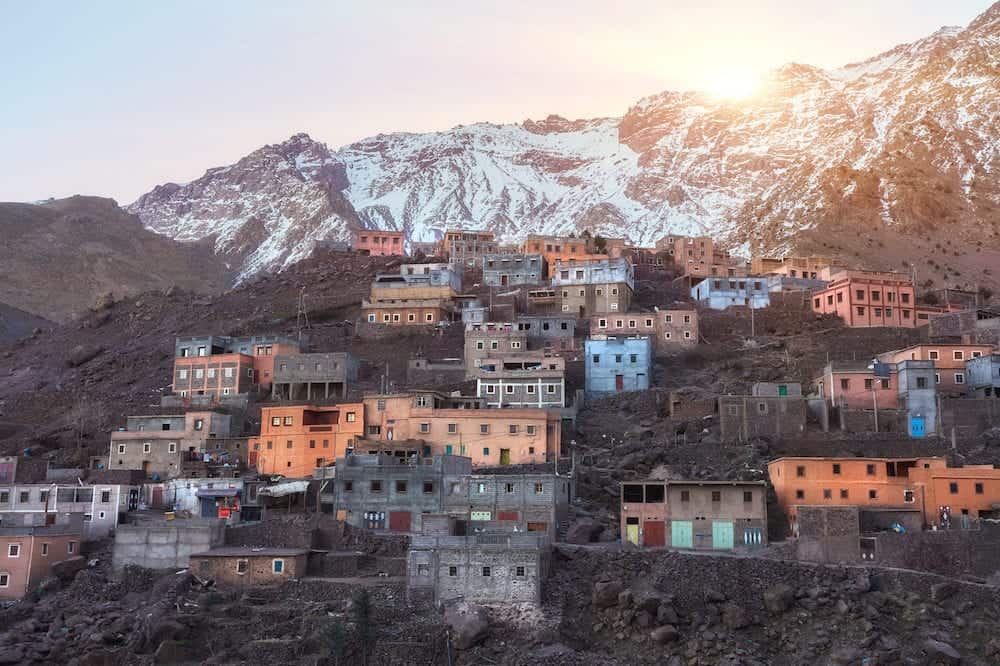
If you want a bit of a sea change, you can take a day trip to the coastal city of Essaouira . You can make the three-hour-long journey, stopping along the way at an Argan oil co-op, and explore the laid-back town at your own pace.
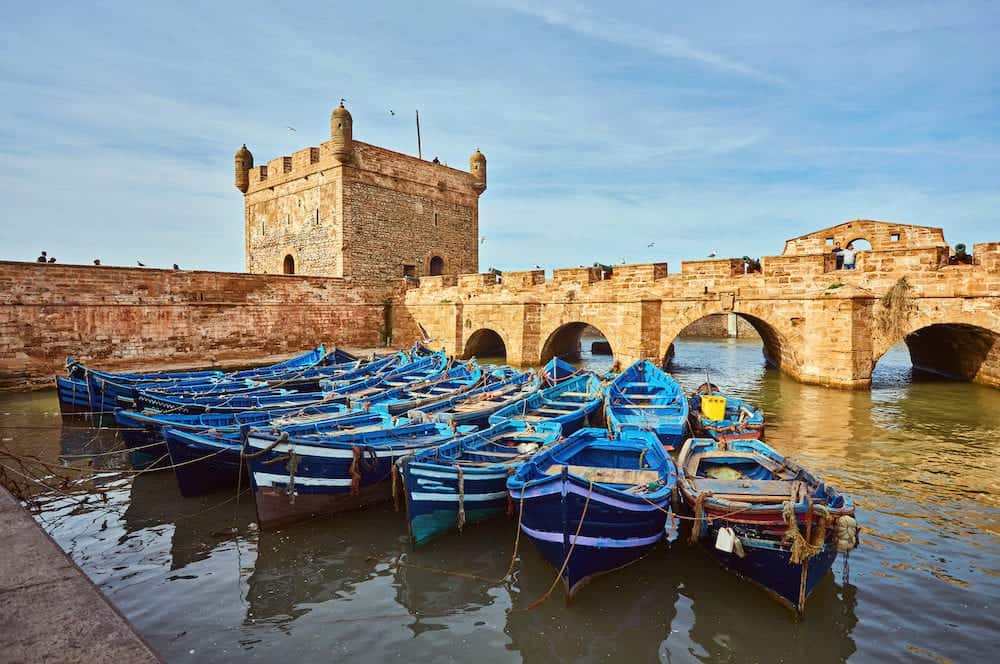
This guide has hopefully answered your questions regarding what to do in Marrakech. You will absolutely fall in love with everything this bustling and vibrant city has to offer!
Recommend budget tours in Marrakech
- Atlas Mountains Hot Air Balloon Ride from Marrakech with Berber Breakfast and Desert Camel Experience
- Atlas Mountains and 4 Valleys Guided Day Tour from Marrakech including Lunch in Berber House
- Camel and Quad Biking Tour from Marrakech
- 3 Day Trek in the Atlas Mountains and Berber Villages from Marrakech
- Marrakech Hot Air Balloon Morning Flight with Berber Breakfast
- Overnight Sahara Tour from Marrakech
- Marrakech City Tour: Private Half-Day Guided Tour
- Full-Day Trip from Marrakech to Atlas Mountains and The Ancient Ait Ben Haddou
- Sunset Camel Ride in the Palm Grove of Marrakech
- Ouzoud Falls Day Trip from Marrakech
- Experience Morocco: Visit a Souk and Cook Moroccan Food in Marrakech
- Day-Trip to Imlil Valley including Camel Ride from Marrakech
Get your guide is a Great company, that often offers heavily discounted tours! Check out a few options below:
If you’d like to save it for later, please save it to Pinterest.
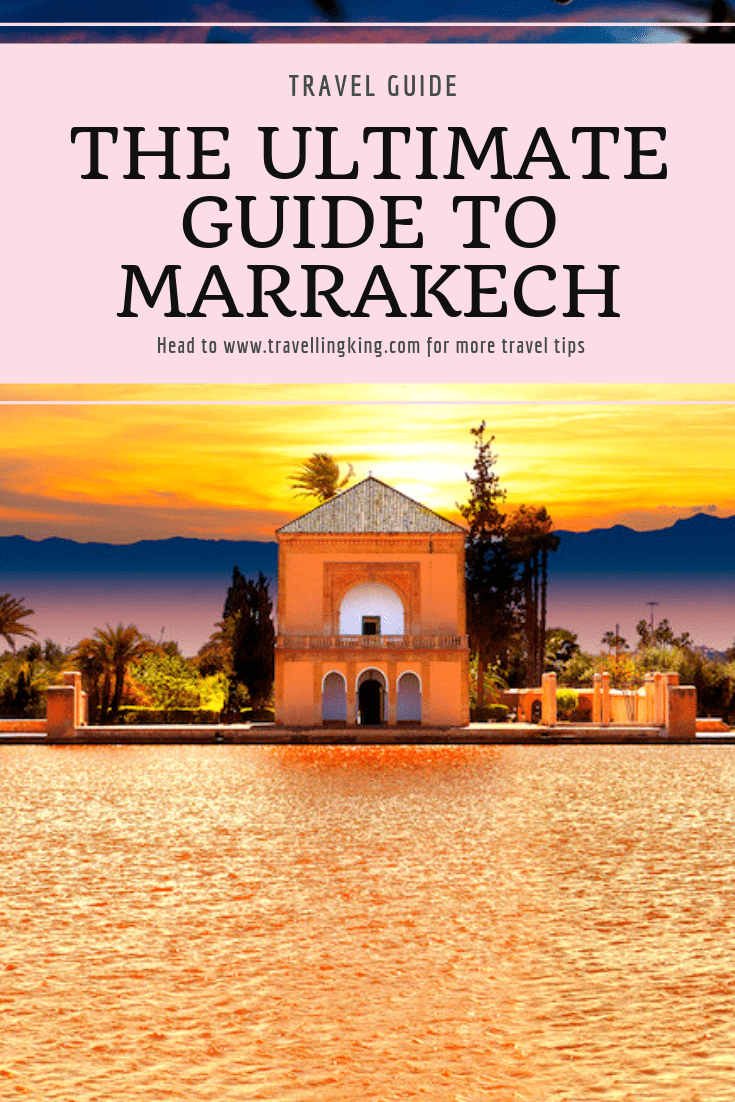
Sam, a seasoned traveler across four continents and 49 countries, is a leading authority in travel planning. Her website, Travelling King, offers tailored itineraries and expert guides for seamless trips. Sam's expertise in luxury travel, fast travel, and destination guides keeps her at the forefront of the travel community.
Similar Posts
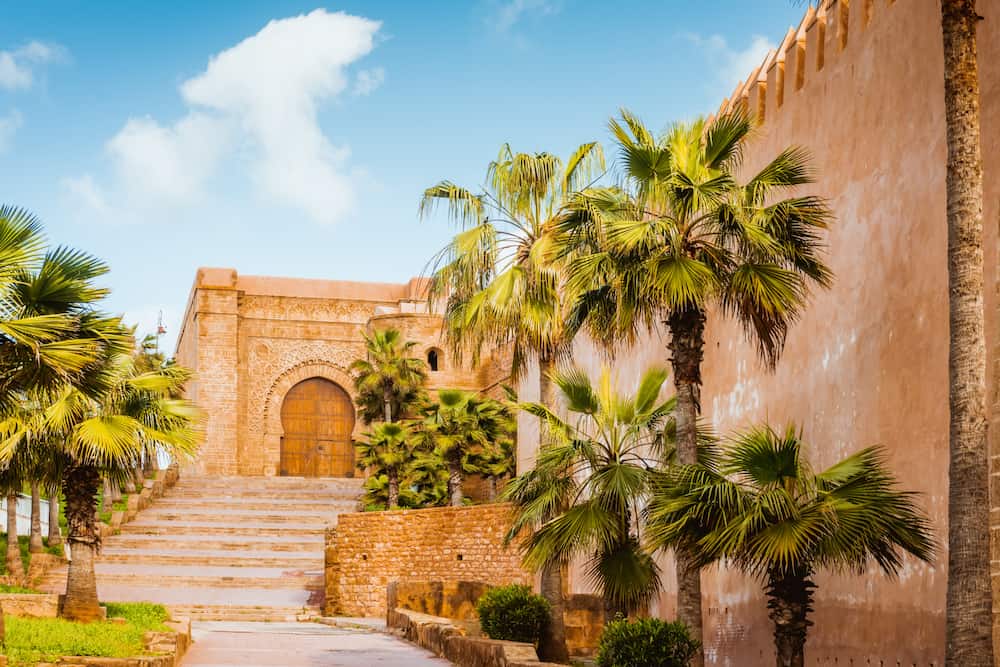
Budget Travel Guide for Morocco
Morocco is a diverse and unique country in Northern Africa with a range of cultural influences, from Arab, Berber,…
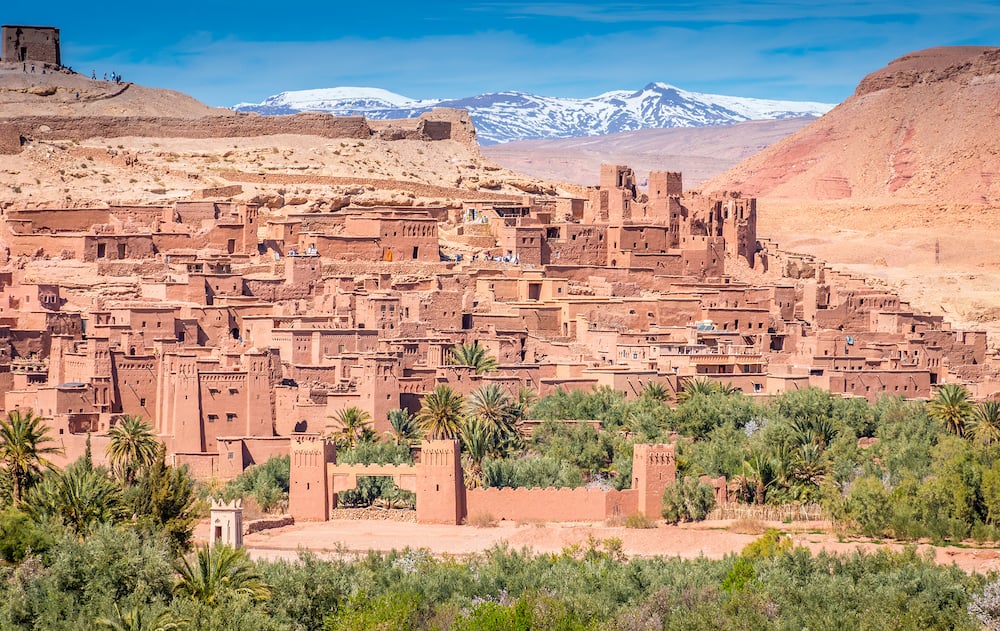
Best Day Trips From Marrakech
One of the main attractions of Marrakech, the red Moroccan city, is its vibrant souk, a bustling Berber bazaar…
![french tourist marrakech Where to stay in Marrakech [Best Places to Stay for 2024]](https://www.travellingking.com/wp-content/uploads/2023/02/Marrakech-Koutoubia-Mosque-at-sunset-time.jpg)
Where to stay in Marrakech [Best Places to Stay for 2024]
Marrakech is the city of medinas and minarets, souks and snake charmers within day trip distance of the Atlas…
![french tourist marrakech Where to stay in Casablanca [Best Places to Stay for 2024]](https://www.travellingking.com/wp-content/uploads/2022/12/Casablanca-The-Hassan-II-Mosque-largest-mosque-in-Morocco.-Shot-after-sunset-at-blue-hour-in-Casablanca..jpg)
Where to stay in Casablanca [Best Places to Stay for 2024]
Casablanca evokes images of a romantic city of Morocco during simpler times. In truth, it’s the largest city in…
![french tourist marrakech Where to stay in Rabat [Best Places to Stay for 2024]](https://www.travellingking.com/wp-content/uploads/2023/06/Rabat-Kasbah-in-medina-of-Rabat-.jpg)
Where to stay in Rabat [Best Places to Stay for 2024]
Rabat is the capital of Morocco, and is overall just a fascinating place to visit. The whole city was…
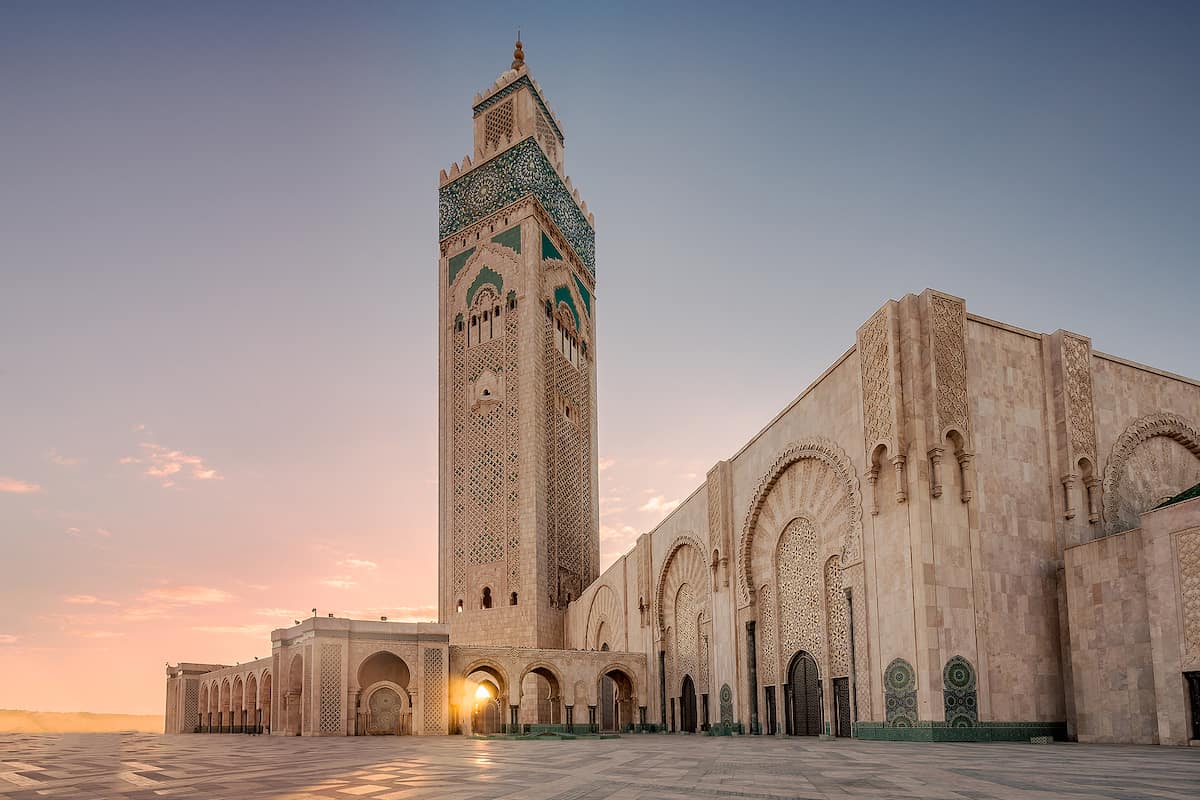
48 hours in Casablanca – A 2 day Itinerary
A 2 day itinerary for Casablanca, Morocco would not be complete without a trip to Old Medina, the Royal…
- Top Attractions
Marrakech Must-See Sights
Discover what to see as you wander through the souk, visit the impressive Jamaa el Fna Square and the Badi Palace , and many other great places during your stay in Marrakech.
Marrakech is not a city that necessarily stands out for its monuments or amazing museums, it's more like a journey to a different world where magic is in the daily life of its inhabitants. That said, there are certain must-see sights in Marrakech that you simply can't miss.
If it's your first time in Marrakech, check out our guided tour of Marrakech . Your tour guide will speak perfect English!
Most important monuments in Marrakech
These are some of the most popular sights in Marrakech. They are ordered according to our tastes:
Jemaa el-Fnaa
Explore the souks of marrakech, koutoubia mosque, bahia palace, ben youssef madrasa, saadian tombs, el badi palace, marrakech museum, dar si said, parks and gardens, menara gardens, majorelle garden, marrakech’s palm grove, other attractions, marrakech’s new city of gueliz.
Once you've visited the most interesting parts of Marrakech, we highly recommend booking an day trip outside Marrakech's Medina . There are plenty of things to see and you can spend a full day visiting or you can reserve a multi-day tour.

16 Top Things to do in Marrakech Morocco – The Complete Guide to Morocco’s Red City
What are the top things to do in Marrakech? Find out in this article what are the top attractions in Morocco’s most iconic city. Here you’ll discover what to see in Marrakech and places you shouldn’t visit as well as the best restaurants in Marrakech and where to stay in Morocco’s red city.
Marrakech was the very first city I visited in Morocco , and well, let’s just say it wasn’t love at first sight. Marrakech was a shock to my system.
I arrived in Square Jemaa el Fna on a busy day. I was tired and stressed out after a long flight, didn’t speak a word of Moroccan Arabic, and got scammed by a taxi driver right out of the airport.
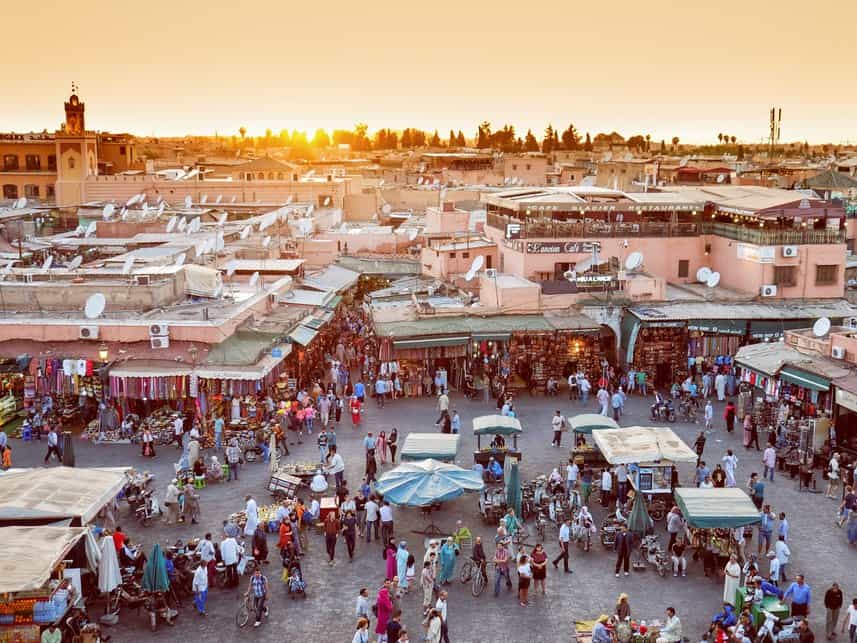
The square was full of snake charmers, women walking around selling henna tattoos, and men holding monkeys on leashes . The air was full of unknown smells and sounds.
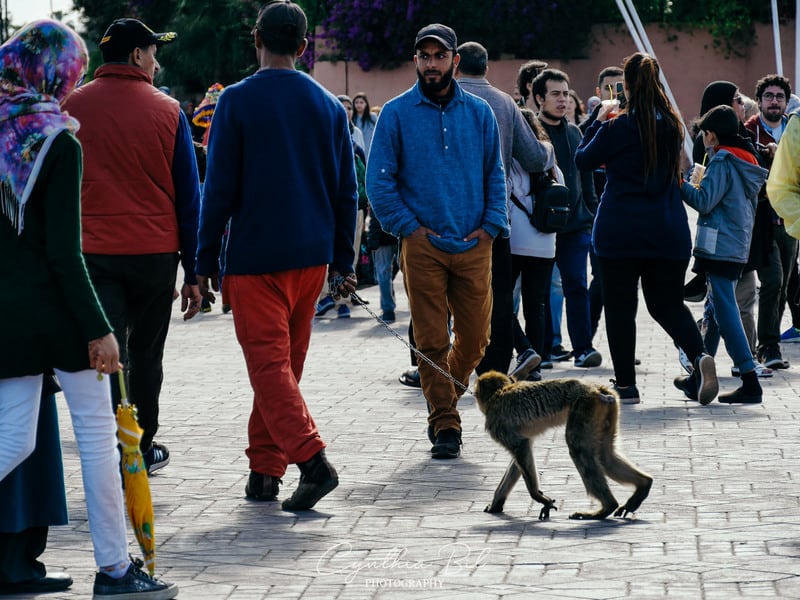
Often time I would catch whiffs of incense in the little streets, at other moments it would be the smell of leather that would fill my nose.
The loud call to prayer kept resonating all over the city while street kids were running around me with their extended open hands, begging for a few dirhams.
The square was bustling with activity. Left and right I could hear the shouts of people trying to sell Moroccan lamps and fruit juices. Street performers were bumping into each other trying to attract the attention of a busy crowd. I had never seen so much chaos in my life.

Like many other tourists, I had decided to land in Morocco in the most chaotic city there is in the country instead of taking a flight to slightly calmer cities such as Casablanca or Tangier . A poor decision that lead to a dire situation. I was pickpocketed on my first day in Morocco and lost my wallet to some petty thieves.

Although my first impression of Marrakech wasn’t a good one, I eventually stayed there for a whole month and grew to love the hectic, busy jungle that is this Moroccan city.
I let myself get lost in the little back alleys every day and slowly learned to speak Arabic . I also decide to explore the rest of the country and eventually completely fell in love with Morocco .
Now, every time I think back about Marrakech, I feel flooded by an odd nostalgia. I feel a mix of love and longing for this huge, busy city.
I would absolutely recommend visiting Marrakech but I think it would be better to acclimatize yourself first in other calmer cities before if it’s your first time in Morocco. Not everyone will love their time in this city, but nobody will be able to leave it without an unforgettable sensory experience.
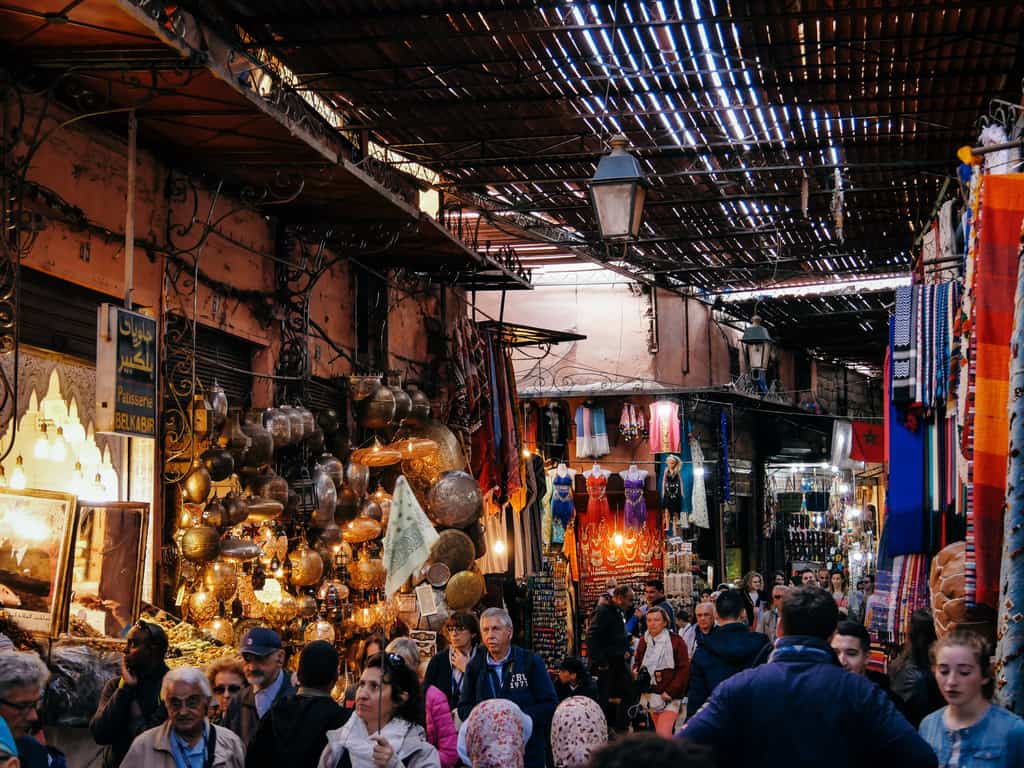
If you like to know what are the top things to do in Marrakech, I’ll tell you all about them in this guide. I’ll also cover what you should avoid in Marrakech as well as where you should stay and the best restaurants in Marrakech.
Tip: See my Morocco Travel Page for a complete overview of all my travel guides and blog posts about Morocco!
Disclaimer: This posts might contain affiliate links, meaning that if you make a purchase through these links, I may earn an affiliate commission. Thank you for helping to support this website!
Plan your trip to Marrakech
Where to stay.
- Best budget pick: Kasbah Red Castel Hostel
- Best mid-range Riad choice: Riad Dar Tamlil
- Top high-end Riad choice: Riad Zoraida
Top experiences in and around Marrakech
- Highlights of Marrakech City Tour
- Marrakech Medina Night Tour
- 9 Best Day Trips from Marrakech
Plan your trip to Morocco
- 19 things to know before traveling to Morocco
- 3 itineraries to discover the best of Morocco
- Morocco Safety Guide
- Renting a car in Morocco
- Best travel insurance for Morocco
TABLE OF CONTENTS
Things you need to know before you visit Marrakech
Where is marrakech.
Marrakech is located almost right in the center of Morocco. The majority of the touristic destinations in the country are within easy reach of this city.

T he 9 best day trips from Marrakech
The snow-covered mountains of the High Atlas and the beautiful dunes of the Sahara desert are relatively close to Marrakech so it’s generally the first city tourists will visit in Morocco.
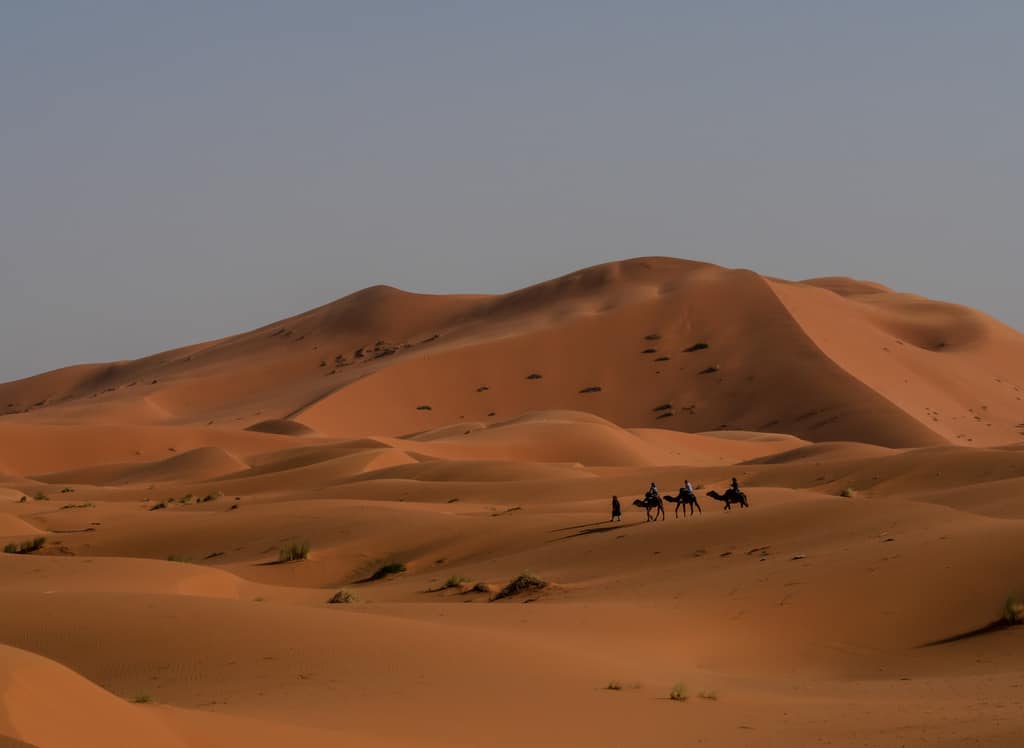
Marrakech was at one point the capital of Morocco. It is 240 km south of Casablanca , 320 km southwest of the Moroccan capital Rabat and 574 km southwest of Tangier .
Merzouga , the famous desert village of the Sahara is just 9 hours away from Marrakesh so the city is often the starting point of expeditions to the desert.

How to plan a desert trip to Merzouga, including the best things to do in the Sahara desert .
A bit of history about Marrakech
The history of this beautiful city easily stretches back in the past a thousand years. Morocco is even named after Marrakech.
Marrakech, also written Marrakesh in English, was founded in 1070 by the dynasty of the Almoravids and became the capital of their empire.
Marrakech also went on to be captured by various other caliphates and dynasties such as the Almohad Caliphate and the Marinids who captured the city in 1269. Marrakesh was later captured by the Saadians who greatly embellished the city.

Over the course of Moroccan history, Marrakech has always maintained a rivalry with Fez to become the leading city in the country. The country was often fragmented into two with Marrakech as the southern capital and Fez as the northern one.
Eventually, Rabat was chosen as the capital of the country. This was seen as a compromise that afforded neither city supremacy over the other.
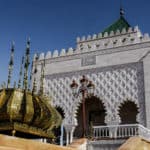
Top Things to do in Rabat – A Complete Guide to Morocco’s Capital City

A few tips before visiting Marrakech
Before visiting Marrakech, I would suggest learning a few words of Moroccan Arabic .
Shop owners in the markets of Marrakech are very good at picking foreign languages but the vast majority of the people only speak Arabic. Learning a few words of Moroccan Arabic will help make everything easier and will go a long way!

10 tips and tricks to learn Moroccan Arabic
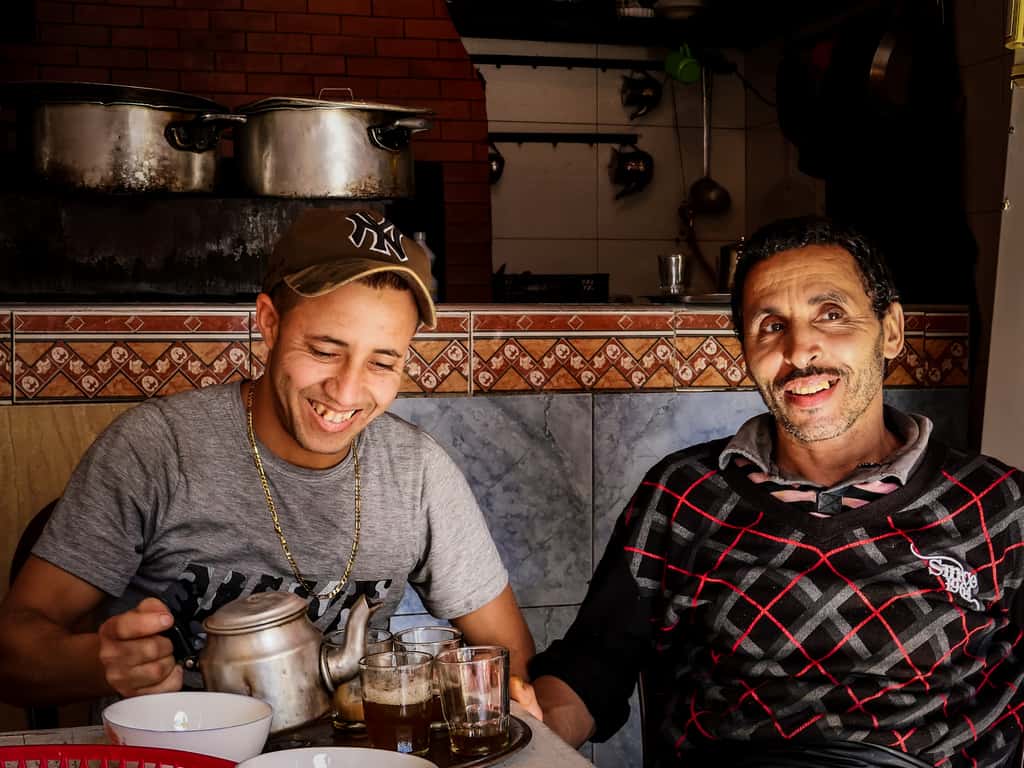
I also highly recommend getting your hands on the Lonely Planet Moroccan Arabic Phrasebook .
It is packed with all the essential words and phrases you will need on your trip to Morocco and will help you in every situation — from finding a hotel room to ordering tajine or joining the local festivities this book will cover almost every situation you could imagine.
I would also recommend getting a map software on your phone that works offline. Google maps has helped us navigate the narrow streets of Marrakech and many other Moroccan cities. One of the cool features of Google Maps is that it can be used both online and offline.
Connect to the wifi at your hostel and download a map of the part of Marrakech you wish to explore. This map works with the GPS chip in your phone so it will continue working, even when you’re offline.
And finally, I highly recommend getting a Lifestraw Water Filter Bottle . Although the tap water in Marrakech is not dangerous, it may contain many new bacteria that your body just isn’t used to.
If you drink water using this bottle, any dirt, bacteria, or parasites get trapped in its filter, while the clean water passes through.

Morocco T r a v e l G u i d e : 19 useful things to know before traveling to Morocco
Arriving at Marrakech Menara airport
Menara airport is the airport in which you’ll land if you take a flight to Marrakech. It’s located only 6 km from Jemaa el Fena, the main square of the city and getting there from the airport by taxi takes about 15 minutes.
Should you exchange money at Marrakech Menara airport?
Airport exchange offices are not the best place to change money. Exchange just a small amount of cash into dirham (MAD) at the Marrakech airport to pay for your taxi to the city center. Once you’re in Marrakech city, you’ll find plenty of currency exchange offices.
If you’re wondering where to exchange money in Marrakech, here is a link to Google maps with all the major exchange offices in the city. They usually offer a much better rate than what you get at the airport.
How much is a taxi from Marrakech airport to the city center?
There are a lot of scammer taxi drivers that park at the airport waiting for unwary tourists arriving in the country for the first time.
They know that these new arrivals are very often unaware of prices in Morocco . They have no qualms in tripling or even quadrupling the price of a taxi ride to the city center!
Unless the official taxi prices are somewhere near the exit of the airport on the wall (more and more airports in Morocco adopt this practice to avoid taxi scams), you shouldn’t pay more than 100 MAD for a ride to the city center.
Depending on your haggling and negotiation skills, fares to Jemaa el Fenaa should range from 50 MAD to 100 MAD.

Morocco Budget Guide: How much does it cost to travel in Morocco?
Is Marrakech safe?
Marrakech is a relatively safe city. There are no violent crimes in this city, however, it’s a place that is quite notorious for theft, scams and con artists.
Traveling there requires you to be alert all the time as your attention will be solicited in all directions and the streets can be extremely crowded.

The best solution to avoid being pick-pocketed is to stay aware of your belongings and surroundings at all times.
You should leave all your important items at your hotel and walk around only with what you absolutely need.
I suggest always keeping your wallet in your front pocket or carrying a money belt . Another great option is to travel with a slash-resistant and lockable anti-theft bag . I would also recommend getting good travel insuranc e that covers theft .
Need Travel Insurance? I use and highly recommend HeyMondo Travel Insurance . As a reader of Journal of Nomads, you get a 5% discount off your insurance plan!

At times I found Marrakech to be quite tiring but ultimately it was worth it and if you take the time to really discover and get to know the city, you’ll surely grow to like it.
One thing you need to remember is that Marrakech is not all floaty dresses, ornate riad walls and water fountains like some social media influencers would like you to believe.

Is M a r r a k e c h Safe? Useful Things to Know before you go

16 Top things to do in Marrakech Morocco
1. go for an evening visit to jemaa el fna or stop there during the day.
If you want to truly understand and feel what Marrakesh is about, you should visit its main square Jemaa el Fna . It’s a place unlike any other. It’s where you’ll find the best and worst of the city.

You’ll find the freshest and cheapest fruit juice served all day in the square, the smell of grilled meat, snake charmers, monkeys who have been captured from the wild to perform for tourists, and ladies jumping on your hands to convince you to get a henna tattoo.

There are horse carriages parked on one corner of the square that will take you around the city. You’ll have the time to relax while seeing the best attractions of Marrakech.
You’ll be able to reach areas that are far from each other rather quickly and you’ll see things that would not be accessible by car.
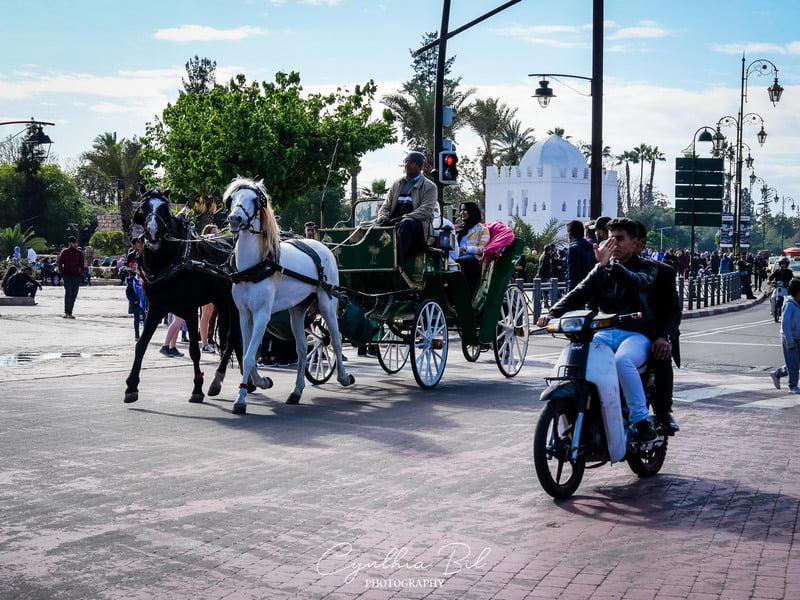
When it starts getting dark the square becomes alive with street performers, musicians, snake charmers, and mouth-watering food stalls. There are thousands of people filling up the square and an endless amount of captivating street performances and shows.
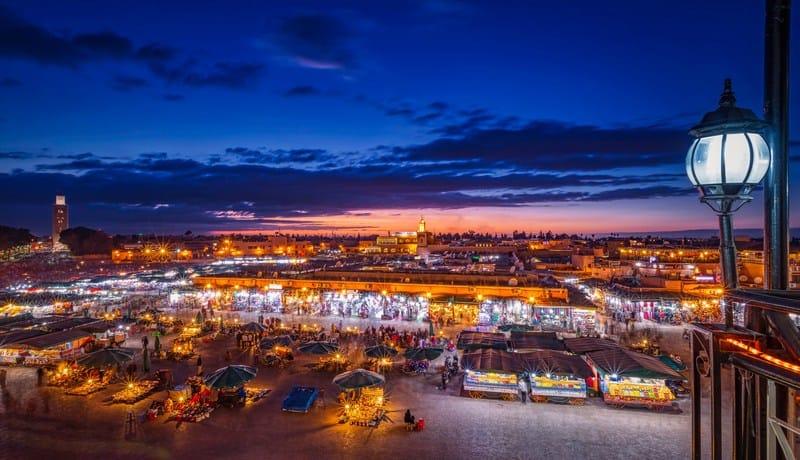
I would recommend not bringing more money than you need to this square as it’s a hub for pickpockets but if you just carry the minimum in a money belt , you’ll be able to fully enjoy the square and its busy atmosphere.
If you want to explore Marrakech at night but you don’t feel safe to go by yourself, you can join this great Marrakech Medina Night Tour.
2. Take some cooking classes in Marrakech
I don’t think there is a better way to discover a city or a country than by learning about the local cuisine. There are plenty of great chefs in Marrakech offering cooking lessons. We highly recommend booking one of these cooking classes .
You’ll learn to cook some authentic Moroccan tagines, shop for ingredients at a souk and learn about the uses of different spices and herbs.
3. Visit the leather tanneries in Marrakech
Marrakech has, just like Fez , some pretty big leather tanneries. The two cities are known for their production of world-class leather.
The 11th-century tanneries in Fez are much bigger than the ones in Marrakech. However, if you aren’t heading to Fez, the Marrakech tannery still makes an interesting visit.

In Marrakech, it’s better to ask your hotel where the tanneries are located or have a good map of the city. On the way there, many scammers might offer to guide you but they will charge an exorbitant price.
You should walk to the tanneries by yourself and avoid the help of ”friendly” strangers offering to show you the way there (this is a common scam in Morocco ).
The best way to visit the tanneries in Marrakech is to hire a local guide for 2 to 6 hours for as little as $30 USD to show you the local side of Marrakech including the medina and the tannery.
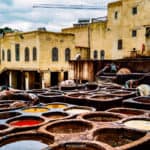
How to visit the leather tanneries in Fez
4. Go for a hot air balloon flight over Marrakech during sunrise
Float above Morocco’s countryside and watch the sunrise over Marrakech and the surrounding Atlas Mountains on a hot air balloon flight !
This is absolutely one of the unique things to do in Marrakech and an experience you’ll remember forever!
5. Visit Jardin Majorelle, a stunning botanical garden
Jardin Majorelle is probably Morocco’s most gorgeous botanical garden. Although Marrakech can be quite hectic, this garden is the best place to escape from the noise and chaos of the city.
This peaceful place stands out so much from the streets that surround it that it can truly be called an oasis in the desert.

It was designed by the French painter Jacques Majorelle. He incidentally became more famous because of his botanical garden than because of his paintings.
The garden is home to more cacti and desert plants than any other garden in the world. This beautiful atmosphere is completed by the indigo blue walls of the house snuck between the plants.

This place is a prized location for Instagrammers who line up in front of the blue walls in the afternoon. I would suggest going there as early as possible to avoid crowds of photo bombers pulling up duck faces.
You can also visit this oasis of art and landscaping at Majorelle Gardens and then learn to ride a camel at the La Palmeraie on a half-day urban escape in Marrakech .
6. Get lost in the souks and the back alleys of Marrakech and buy souvenirs for friends
Marrakech and its tiny back alleys are often compared to a big open-air maze where one can get lost for hours. As much as some people can dread the feeling, I tend to enjoy it. I think getting lost in the streets is always a great way to discover a new city.
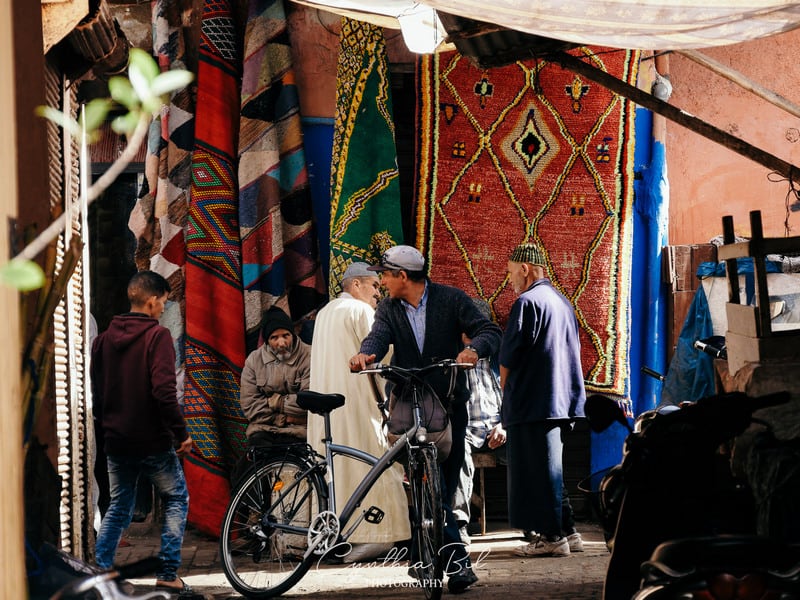
As you walk through these back alleys and small markets, you’ll find handmade pottery and ceramic, leather products, bags and shoes, and beautiful wood crafts.
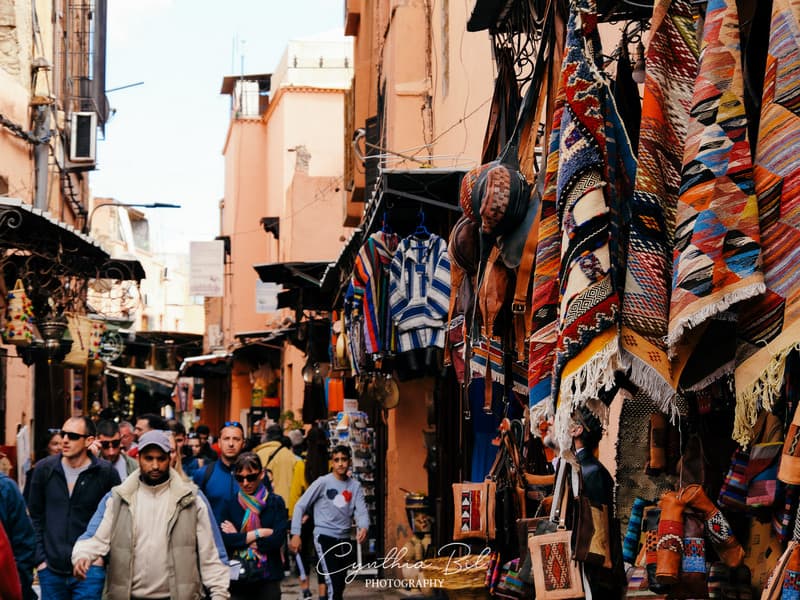
Shopping in Marrakesh is almost like a sport. It’s a really fun experience but you have to follow a few simple guidelines if you want to avoid paying too much. If you plan to buy something in the markets of Marrakesh, be prepared to haggle and negotiate prices.
Prices generally start really high but don’t be scared to haggle and make an offer much lower than the starting price. Moroccans love to haggle and will generally expect you to do the same.
You can offer a bit more than half of what the seller was asking and take the negotiations from there. Whatever you do, keep the negotiations friendly and you’ll be bringing your friends a beautiful new rug for their living room or a Moroccan lamp for their kitchen.

7. Visit the Saadian tombs
In the modern world, we don’t often think of death and beauty as compatible. One look at the gorgeous Saadian tombs will convince you of the contrary.
These tombs are one of the only remains of the Saadian dynasty that reigned over Marrakech between 1524 to 1659. It’s a stunning place with great mosaic work.
You don’t always know whose tomb you are looking at but it’s hard not to be impressed by all the intricate carving and tilework of this stunning place.
The tombs are extremely well-kept. If you want to see the most famous hall there – the Chamber of the Twelve Columns- you may have to wait in a queue but it will be well worth the wait.
8. Get a good scrub in a traditional hammam
One of the best and most traditional experiences you can have in Morocco is to visit a traditional hammam. The hammams in Marrakesh come in all different styles. Some are almost like spas and expensive while others are a bit cheaper and used mostly by locals.
The ones visited by locals are the establishments I would recommend. Popular local hammams are a great part of the Moroccan culture.
Before you go, you’ll need to get some natural Argan soap and a scrubbing cloth. Once you arrive at the hammam, you’ll be handed a bucket and you’ll undress before going to a closed room. There you’ll be in the midst of locals scrubbing each other’s back and talking about daily life.
All you need to do is fill your bucket with hot water and scrub yourself in the sauna-like room. These hammams are very cheap and cost around $3USD. they’re an important part of Moroccan culture and will make you feel like a local.

Spending time in a hammam is one of the most relaxing activities in Marrakech…
9. Visit the Koutoubia mosque
The stunning Koutoubia mosque is a must-see in Marrakesh. It’s the highest mosque and its minaret can be seen from almost everywhere in the city center.
The mosque is just 200 meters from Jemaa el Fnaa square. Non-Muslims can’t enter this mosque but it’s possible to admire it from the outside. Koutoubia is not only an important spiritual center but also an admirable piece of architecture. It has stunning arches and beautiful proportions.

The mosque becomes particularly gorgeous at night when it’s illuminated and covered in a golden light.

If your hostel or riad is not too far from the city center, you’ll hear the call to prayer coming from the top of Koutoubia’s minaret throughout the day and see people congregate together towards the building.
10. Stay in a traditional riad in Marrakech
Morocco is a country that is rich in its stunning mix of architecture. In Marrakech, there is a special type of building that combines both architecture and history. They are called Riads. They are typical Moroccan buildings that started appearing during the Idrisid dynasty.

They usually have indoor courtyards with gardens and fountains. Their walls are covered in colorful tiles and some even have indoor pools. These beautiful establishments can take you from the bustling streets of the city to a calm oasis of peace.
No stay in Marrakesh would be complete without at least one night in a riad. Further in this guide, I’ll tell you what are some of the best riads in Marrakech .

11. Visit Ben Youssef Madrasah
Madrasas are ancient Quranic schools. They can be found all over Morocco and in other Islamic countries such as Uzbekistan . They usually have beautiful intricate tile patterns and they are masterpieces of architecture.
Ben Youssef Madrasah used to be the biggest Quranic school in North Africa. It has a gorgeous inner courtyard and ornate tiles.

Make sure you go upstairs to look into tiny rooms that were once home to around 900 students. If you go there early enough during the day, the inner courtyard will be absolutely quiet and peaceful.
12. Walk around the ramparts of Marrakech
Marrakech has some ancient fortified walls that stretch 19 km around the city center. These defensive walls were built in the 12th century and much of the original construction still remains.
They were originally built to provide protection for the inhabitants of the city and there are nineteen gates that provide entrance into the heart of the Medina through these walls.
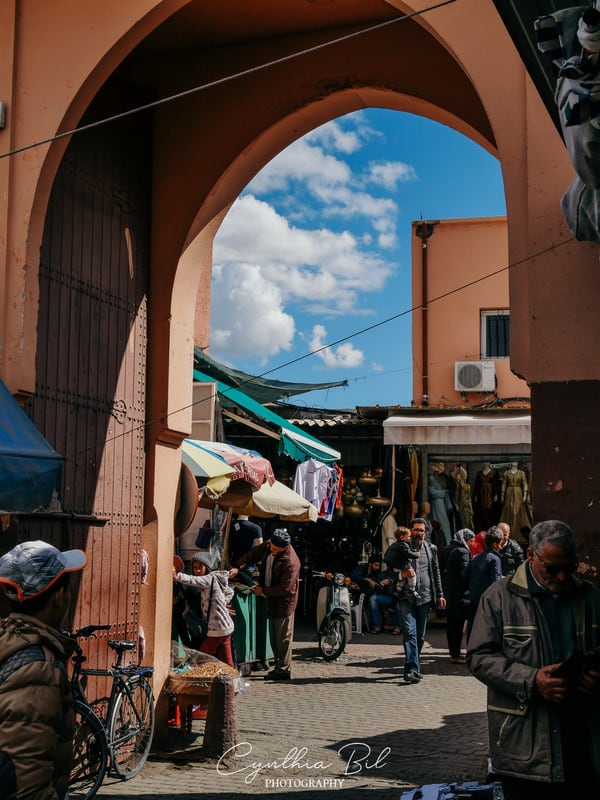
Bab Aganou is perhaps the most unique of Marrakech’s nineteen gates. It used to be a royal entrance to the city and it’s decorated with floral patterns and inscriptions from the Quran.
Bab al Khamis (Khamis means Thursday) marks the entrance to the flea market held around the gate each Thursday morning. If you love flea markets, this one is totally worth it!! In this weekly street bazaar, you’ll find old treasures, ancient wooden doors, and beautiful antiques.
The fortification around the Medina has a reddish color and that’s where the name of the city itself comes from. The city of Marrakech got its epithet the “Ochre City” from the color of the reddish-pink clay used to build its ramparts.

The best way to see the walls is to take a long walk around the city. It’s easier to see the walls from outside the perimeter of the old medina than from the inside. Don’t forget to bring a good paper map or install Google maps on your phone.
Another way to visit the walls is to hire a horse carriage at one corner of the Jemaa el Fenaa square (see above). Visiting the walls by calèche takes around 40 minutes and the price can be negotiated.
13. Visit a traditional Berber carpet museum
Marrakech has a few carpet museums that were opened to promote the rich heritage of the Moroccan and Berber carpet and weaving collections.
One of the best carpet museums to visit in Marrakech is the Dar Si Said Museum of Weaving and Carpets .
The collection of carpets on display is not very different from the other ones you would find in Marrakech but the beauty of the building itself is what makes this museum worth a visit.
The museum is located inside a beautiful old palace, with small yards and gardens filled with flowers and shrubs. Each room of the museum is decorated with intricate wooden ceilings and multicolored tiles. If you want to see the most beautiful halls, you’ll have to go to the second floor.
14. Visit the Bahia palace
The Bahia Palace is probably the highlight of the tourist attractions in Marrakech.
It was built in the 19th century and intended to be the greatest palace of its time. Its name Bahia means “brilliance” in Arabic. It’s a beautiful building that captures the essence of the Islamic and Moroccan styles.

It’s one of the masterpieces of Moroccan architecture, one of the major monuments of the country’s cultural heritage, and one of the main places of tourism in Morocco.
It’s absolutely worth a visit but because the courtyards are exposed to the sun, I would go there on a cloudy day.

15. Enjoy a traditional mint tea in one of the many small cafes of Marrakech
The traditional mint tea that Moroccans are so fond of is absolutely delicious and it’s a drink you should try during your visit to Marrakech. If my time in Morocco could resume itself in one flavor it would be the flavor of mint tea. I’ve never drunk more tea in my whole life than when I was in Morocco.

Moroccans are so fond of this sweet drink that they call it the “Moroccan Whiskey”. It is served with almost every meal and tastes absolutely delicious.

I liked the Moroccan tea so much that it became one of the 13 things that made me fall in love with Morocco .
There are many small cafes and restaurants in Marrakech where you can enjoy this traditional drink. One of the best cafes in Marrakech to have mint tea is Zwin Zwin Cafe. The cafe has a beautiful rooftop terrace from which you can enjoy panoramic views and the sight of the Atlas mountains.

The 17 most beautiful places to visit in Morocco
16. Visit Marrakech with a guide
If you like to learn more about this historically and culturally rich city, you can visit Marrakech on a guided tour.
There are many different tours to choose from: from guided walking tours and historical tours to visiting hidden sites in Marrakech.
Here are 3 tours we highly recommend:
Things I don’t recommend doing and places I don’t recommend visiting in Marrakech
Here are a few places and activities I deem worth skipping in Marrakech. Now bear in mind that this is only my opinion but the following activities really didn’t appeal to me and I’ll tell you why.
1. Don’t Visit the Yves Saint Laurent museum
Yves Saint Laurent spent a good deal of time and money in Marrakech and he built this small but beautiful modern museum to showcase himself, his work, and his models and friends.
Unless you’re a fan of Paris high-fashion designer clothing, this museum risks being quite boring. The entrance is 7 euros per person and that’s a very high cost for such few exhibits.
There’s nothing in the museum related to Morocco or Marrakech. Even if you are into fashion, all you will see are rooms full of dresses.
2. Don’t Take a picture with snakes or monkeys
In the large squares of very touristic cities such as in Jemna El-Fna in Marrakesh, you might encounter people walking around with animals such as snakes or monkeys.
When you walk by, these scammers place the animal on you and invite you to take a picture. They may even snatch your camera out of your hand to take a picture of you with the animal.
They then try to convince you into paying them a super large sum of money for the picture you took with their critters.
If you give less than what they’re expecting (which is usually something around 100 MAD or 10 euros), they’ll throw the money back at you and start shouting while asking you to pay more.
The first way to not fall into this trap is to avoid people insisting on you taking a picture with their animals. If you do like a photo, however, pay them only what you consider to be a fair price and then walk away.
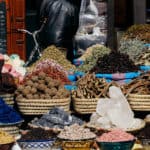
12 common scams in Morocco and how to avoid them
3. Don’t go to the Marrakech museum
There is not much to see in this museum apart from the exterior of the building itself. The building is nice but the displays are not so interesting. Also, you have to be able to read French or Arabic if you want to learn anything about what you’re looking at.
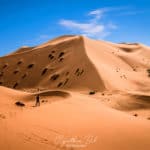
Visit the best places in Morocco with these 3 Morocco itineraries
What are the best day trips from Marrakech?
Marrakech is a fantastic city where you can see tons of beautiful sights but at times it can become a bit overwhelming.
Because it’s so close to many interesting destinations, it’s easy to take a small break from the hustle and bustle of the city.
You can leave Marrakesh in the morning, visit cool waterfalls and mountain villages during the day and come back in the evening.

To help you make the best of your time in Morocco, I wrote a complete guide to the best day trips around Marrakech .
In this guide , I explain how to reach each destination by public transport and with your own car from Marrakech and what you can do there.

Where to eat: the best restaurants in Marrakech
Marrakech has a wide selection of restaurants that can satisfy travelers with different budgets.
Whether you want a fancy restaurant where you can try some Moroccan wine or a local eatery, you’ll find some savory options in the city.
Here are some of the best restaurants in the city:
- Le Trou au Mur
If you want some authentic Moroccan food, this is the place to visit. They have a delicious mechoui and mixed salads that you can savor from a rooftop terrace with a view over Marrakesh.
This restaurant has some beautifully stunning decorations and the staff is super friendly and helpful.

When we called the restaurant to confirm our reservation, the owner offered to send one of his employees to meet us so we could easily get to the restaurant without getting lost. They even had someone walk us back to our hostel.
This is where you’ll find Le Trou au Mur:
This restaurant is a bit outside the city center but it’s well worth the 45-minute walk or the 5-minute taxi ride to get there. It’s the perfect place if you love salads and fresh vegetables.
I had a fantastic grilled eggplant with honey and almonds, a cauliflower fritter, and sweet pumpkin puree.
Here is where you’ll find Libzar in Marrakech:
This place is slightly expensive but so worth the price. It was probably our most expensive meal in Marrakech but compared to restaurant prices in Europe it wasn’t too pricey.
They serve generous portions and have delicious vegetarian options. If you eat meat, I absolutely recommend the lamb tajine or the chicken tajine with lemon.
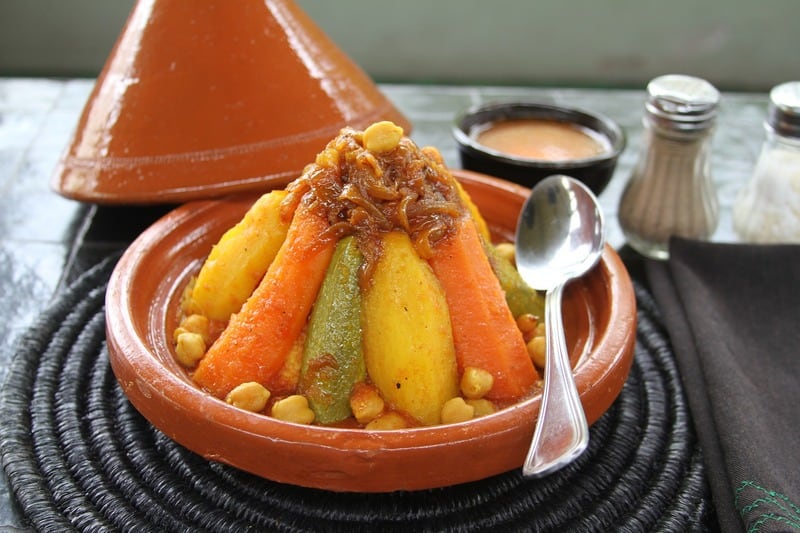
If you have a sweet tooth, the chocolate and orange pastila will be the perfect dessert.
There seems to be live music in this restaurant every evening. There were some Sitar players while we were there and a belly dancer.
Here is where Dar Zalij is located in Marrakech:
Where to stay in Marrakech?
Marrakech is a city that is worth taking the time to discover, so you will want to stay there for at least a night or two.
It’s a city rich in traditional architecture. One of the best experiences you can have in Morocco is staying in a riad, a typical rich Moroccan house with indoor courtyards and fountains, designed with zellij (Moroccan tiles).

Marrakech also offers a wide choice of hostels for budget travelers who want to save money to explore during the day and swap stories with fellow backpackers in the shared kitchen or bar in the evening.
What are the best hostels in Marrakech?
- Kasbah Red Castel Hostel
This hostel has some of the friendliest staff in Marrakesh and it felt like they were old friends we hadn’t seen for a while. They were very helpful and diligent.
This gorgeous hostel has a great rooftop terrace where there are plenty of long chairs to lounge.
For digital nomads who work from their laptops creating online content, this hostel will be the ideal location. The hostel has a lot of power sockets in the dorms as well as in the shared areas.
Jemaa el Fnaa, the main square of Marrakech is just 15 minutes away from this establishment so the location of the place is ideal to see all the main sights of the city.
Click to check out rates and availability for “Kasbah Red Castel Hostel”
- Mosaic hostel
This hostel is located right in the heart of the medina. Although it’s located right in the center of the city, it’s still an oasis of peace and tranquility.
There is a great breakfast served in the hostel every morning composed of delicious pancakes, omelets, and fruits.
The staff of the mosaic hostel was super friendly. They recommended some awesome things to do around the city and made us feel at home.
They also had an awesome music playlist that played every morning and it was the perfect way to start the day.
Click to check out rates and availability for “Mosaic hostel”

This is the cleanest and most beautiful hostel in Marrakech, hands down. The rooms, bathrooms, and shared areas are impeccably clean.
The hostel is also covered in beautiful decorations. Although this is a hostel, you’ll find the same level of comfort here than you would in a fancy riad.
The place is managed by a young Moroccan entrepreneur who is really keen on providing his guests with the very best experience possible.
He speaks English very well and can help you with anything you would need during your visit to Marrakech.
Click to check out rates and availability for “Be Nomad”

What are the best riads in Marrakech?
Marrakech has so many beautiful riads that we couldn’t possibly put them all here. They are becoming more and more affordable and give you the impression of being part of a Moroccan royal family without breaking your piggy bank.
These are the ones we recommend in Marrakech:
- Riad les 2 Portes
This riad is smaller than other establishments so it has a cozier and more private atmosphere than what you would get in other places.
The rooms are very comfortable and they are painted in very light shades of colors as you can see in these pictures .
Riad les 2 Portes is in a perfect location in the heart of the Medina. It was ideal for our quick visit to Marrakech and was very enjoyable.
The staff was excellent, they were always available to answer all of our questions and the breakfast was really varied.
Click to check out rates and availability for “Riad les 2 Portes”

- Riad Jomana
Luxurious is the best way to describe this lavish palace. Riad Jomana seems to come straight from the Arabian night’s novel.
It has a very traditional look with colorful tiles and a water fountain. This riad is famous for its super huge rooms with humongous beds.
If you want to feel like a royal without spending too much money, this is the place where you should stay.
Click to check out rates and availability for “Riad Jomana”
- Riad Dar Tamlil
This riad is full of lovely trees, shrubs, and flowers. It feels very quiet and peaceful even though it’s very close to the city center.
Riad Dar Tamlilhas a washing machine and getting some clothes washed while you’re there is not a problem.
This riad is quite small with only 4 rooms but the rooms are really spacious.
Click to check out rates and availability for “Riad Dar Tamlil”

How to get to Marrakech?
How to get from casablanca to marrakech by train.
Marrakech can be reached from Casablanca by taxi, by bus, and by train. However, the cheapest and most convenient way to travel between the two cities is by train so that’s the option I will cover here.
Traveling around Morocco by train is a great choice because they’re cheap and they are a great way to see the stunning Moroccan landscapes.

It’s very easy to buy your train tickets directly at the train station. Ticket prices and time schedules can be found on the ONCF website .
Once you know which train you will take, you can head over to the train station to buy your ticket. Bring cash to buy your ticket as it’s not always possible to pay by debit or credit card.
There are eight trains per day between Casablanca and Marrakech departing every couple of hours. Travel time between the two cities is around 2 hours and a half.
Here is where you can hop on the train in Casablanca:
How to get from Casablanca to Marrakech with your own car?
If you have your own car or if you’re renting one , reaching Marrakech from Casablanca becomes very easy. To reach Marrakesh from Casablanca, just follow the highway N11 towards the south until you reach highway A7. Follow highway A7 and you’ll arrive in Marrakech.
The distance between the two cities is 244 km and getting there will take around 3 hours.
Reading Tip: Top things to do in Casablanc a – C a s a b l a n c a C i t y G u i d e
How to get from Essaouira to Marrakech by bus?
One of our favorite cities in Morocco is Essaouira and if you travel along the coast you’ll probably end up visiting it as well.
Marrakech and Essaouira are both very traditional cities and it’s a great idea to visit both if you want to understand the Moroccan culture in greater depth.

To reach Marrakech from Essaouira you’ll have to reach one of the bus stations in the city first.
There are two bus terminals in Essaouira, one is used only by CTM and the other one is used by Supratour and the various other bus companies that operate there.
The Supratour terminal is much closer to the old city while the CTM one is located a bit farther. The Supratours bus stop can be found just southwest of the square known as Bab Marrakech.
Here is the location of the two bus terminals in Essaouira where you can get a bus for Marrakech:
You can find the bus schedules on the CTM and the Supratour websites.
How to get from Essaouira to Marrakech with your own car?
If you have your own car, it doesn’t take a lot of time to reach Marrakech from Essaouira. There is only 191 km between the two cities and it takes a bit more than an hour and a half to get to Marrakech from Essaouira.
Reading Tip: Top things to do in Essaouira – Essaouira City Guide
How to get from Fez to Marrakech by bus?
Fez has a bus station with buses departing to Marrakech every single day. Buses in Morocco usually tend to be old, rusty and without lights but the main company that connects Fez and Marrakech, CTM, has really modern and comfortable vehicles.
They offer European-quality service, for double the price by Moroccan standards, but they usually include the 5 to10 dirham required for transporting luggage (malletas), and they’re not overcrowded.
People go to the station in the morning to book their ticket for the afternoon or the day after, and collect stickers for luggage, so beware of showing up at the last minute and not finding a place.
Here is the location of the CTM bus station in Fez:
How to get from Fez to Marrakesh in your own car?
If you have your own car and you want to drive to Marrakech, it’s easier to get there using the coastal highway.
The highway that follows the coast is almost brand new and by using it you won’t have to drive through the treacherous windy mountain highways in the center of the country.
Reach the coast by driving to Rabat first and then drive south from there to Casablanca and then to Marrakech.
More MOROCCO TRAVEL Resources:
- What you need to know before you go: 23 Travel Tips for Morocco
- Is Morocco Safe? Safety Guide to Morocco
- How to avoid the 12 most common scams in Morocco
- See the best of Morocco by following these 3 great travel itineraries
- Visit these beautiful 17 places in Morocco
- Tips for traveling to Morocco during Ramadan
- Morocco City Guides: Fez , Tangier , Essaouira , Chefchaouen , Rabat , Meknes , Marrakech , Casablanca , Agadir
- The best daytrips from Marrakech
- Fun things to do in the Sahara: how to plan a desert trip to Merzouga
- The Complete Guide to Imlil and Hiking Mount Toubkal
- Everything you need to know about visiting the Ouzoud Waterfalls
- Rock climbing and other fun things to do in the Todra Gorges and Tinerhir
- How to get to the Akchour Waterfalls from Chefchaouen
- A guide to visiting the Ouzoud Waterfalls
- Surfing in Morocco – The best surfing spots in Morocco
- How to visit Paradise Valley in Agadir
- What to wear in Morocco: Complete packing list for Morocco
- Morocco photography tips: How to take portraits of people in Morocco
- Extend your stay in Morocco using one of these 3 ways to renew your Morocco visa
- Useful tips on how to take the ferry from Tangier to Spain
- Books about Morocco: 10 Great Novels set in Morocco

I hope this guide was useful and that you’ll have a great time in Marrakech. If you have any questions, don’t hesitate to write them in the contact below or contact us directly .
Related Posts:

What are the 9 Best Things To Do in Casablanca Morocco? Casablanca City Guide

The Fes tannery In Photos: The best way to Visit the Leather Tanneries of Fes

11 Best Things to do in Rabat Morocco – The Complete Guide to Morocco’s Capital City

14 Best Things to do in Essaouira Morocco, the Complete Guide to Morocco’s windy city

20 Top Things to Do in Tangier Morocco – The Complete City Guide

The Honest Guide to Meknes Morocco and Volubilis – 9 best things to do and what to skip
6 thoughts on “16 top things to do in marrakech morocco – the complete guide to morocco’s red city”.
By far this is the best and most comprehensive guide in one blog. Kudos! Planning to visit in January 2023.
Thanks so much Arfah!
Love this blog! do you have recommendations of riads in marrakech with pools? asking for my 8 year old 🙂
Hi Jimena, there are quite some Riads with pools in Marrakech. Here are some suggestions: Riad Africa Riad Ayadina Riad Sidi Mimoune
Amazing Blog Thank you for sahring with us your experience
Thank you! 🙂
Comments are closed.

8 Essential Rules for Visiting Marrakech

In my photo diary of Marrakech , I mentioned that the golden rule that took our trip from holiday to heaven was trust .
We had to put our trust in the people around us – and that took some skill, but it certainly paid off!
With that being said, if you’re ever planning to visit the city, here’s the advice that made our trip incredible – and kept us from falling for traps, making mistakes, and generally not getting the most out of everything:
1. Get to know the lingo
Marrakech runs on a mixture of Arabic, French, and for the tourists, English. Knowing a few key phrases in Arabic ( salaam alaikum for hello, shukran for thank you) as well as French made conversing easy. Our hoteliers spoke great English, as did waiters, but taxi drivers and small shop owners preferred French for the most part.
2. Don’t worry too much about how you dress
I was super conscious about what to wear while in Marrakech . As a Muslim country, many of the local women are covered from head to toe, but tourists ranged from floaty dresses to shorts and strap tops. In order not to draw too much attention to myself, I made sure to cover my legs (at least from the knees up) and my shoulders, which seemed to do the trick.
3. Get your currency when you arrive
Marrakech runs principally on Moroccan Dirhams (MDhs). While Euros will work in the airport and hotels, Dirhams are your best bet for everywhere else. Morocco operates a closed currency, meaning you can only buy and sell Dirhams within the country. Currently, you get around 12 MDhs for every £1, so I exchanged half of our spending money in the airport, and got an even better exchange rate for the second half in the Medina, from a Bureau de Change that one of our hotel managers walked us to.
4. Ignore the street signs – ask at your hotel
One of the most common pieces of advice I read was to do with “tour guides” in the streets of Marrakech. Many young men loiter around, shouting directions at tourists and trying to get into conversations – it happened to us on multiple occasions. This is fine, but if you trust them to take you to where you want to go, they will often as for payment when you arrive at your destination.
Not only this, but some of the street signs were tampered with, making tourists even more vulnerable. Thankfully, the managers at our hotel also warned us of this, and presented us with a hand-drawn map to show how to get to the main destinations around the Riad.
5. Ask for half-off everything
Haggling may seem embarrassing, but it’s the done thing in Marrakech. While we chose not to buy any nick-nacks during our stay (I mean, I didn’t go to buy a rug, but some people do!) we still found ourselves haggling with taxi drivers and small vendors for things like bottled water or razors. Some were fine about it, but others wouldn’t budge – so go with your gut. If you don’t like the price, there’s plenty of other people to purchase from instead.
6. Don’t eat the fish, salads, or fruit
One of the biggest mistakes we both made during our visit was to trust most of the food and drink. Don’t. Do. This. Not unless you want to spend the next seven days laying in bed…
If you’re planning on eating out (which is the easiest option, especially in the Medina where supermarkets are non-existent), make sure you:
- Stay hydrated by drinking at least 1.5L of bottled water each day
- Don’t drink juice made by street vendors – it often contains non-bottled water
- Avoid fish – as it’s shipped in from miles away
- Don’t eat salads as they’re washed in regular water
- Don’t eat fresh fruit (unless it comes from a really reputable place you could trust)
7. Don’t forget the tourist tax
In Marrakech, it is a requirements that your hotel charges you tourist tax. This goes some way to support the local economy, and even the company you book your hotel with will warn you of this. Ours equated to 2.50 € per person per night, so make sure to bring the right amount of euros with you so you can settle the bill at the end of your stay.
It’s also recommended you keep a receipt, in case officials ask to see it at the airport.
8. Give yourself at least three hours at the airport
Finally – you will need at least three hours at the airport. I was so sceptical of this when our hotel manager arranged our taxi that early, but we needed every minute to get to the gate on time. Despite only bringing hand luggage, we had to get our tickets stamped at the check-in desk, fill out a leaving form, and go through multiple x-ray scanners and checks. Give yourself time so you don’t stress out, or worse, get stuck in the city!
Share this:
- Click to share on Twitter (Opens in new window)
- Click to share on Facebook (Opens in new window)
- Click to share on Pinterest (Opens in new window)
- Click to share on LinkedIn (Opens in new window)
Advertisement
My summer holiday capsule wardrobe, a guide to second-hand shops in birmingham, a long weekend in birmingham, sustainable fashion week brighton – a huge success.
- United Arab Emirates
- Switzerland
- The Netherlands
- Puerto Rico
- United States
- New Zealand
- ➨ Choose from World Map
- Budget Travel
- Family Travel
- Getting Around
- Visas & Passports
- Work with Us
Browsing Category
- Czech Republic
- Saint Martin
- Uncategorized

Is Marrakech, Morocco Worth Visiting?
· our answer to this question, plus the best things to do in marrakech, how to get to marrakech, and more. ·.
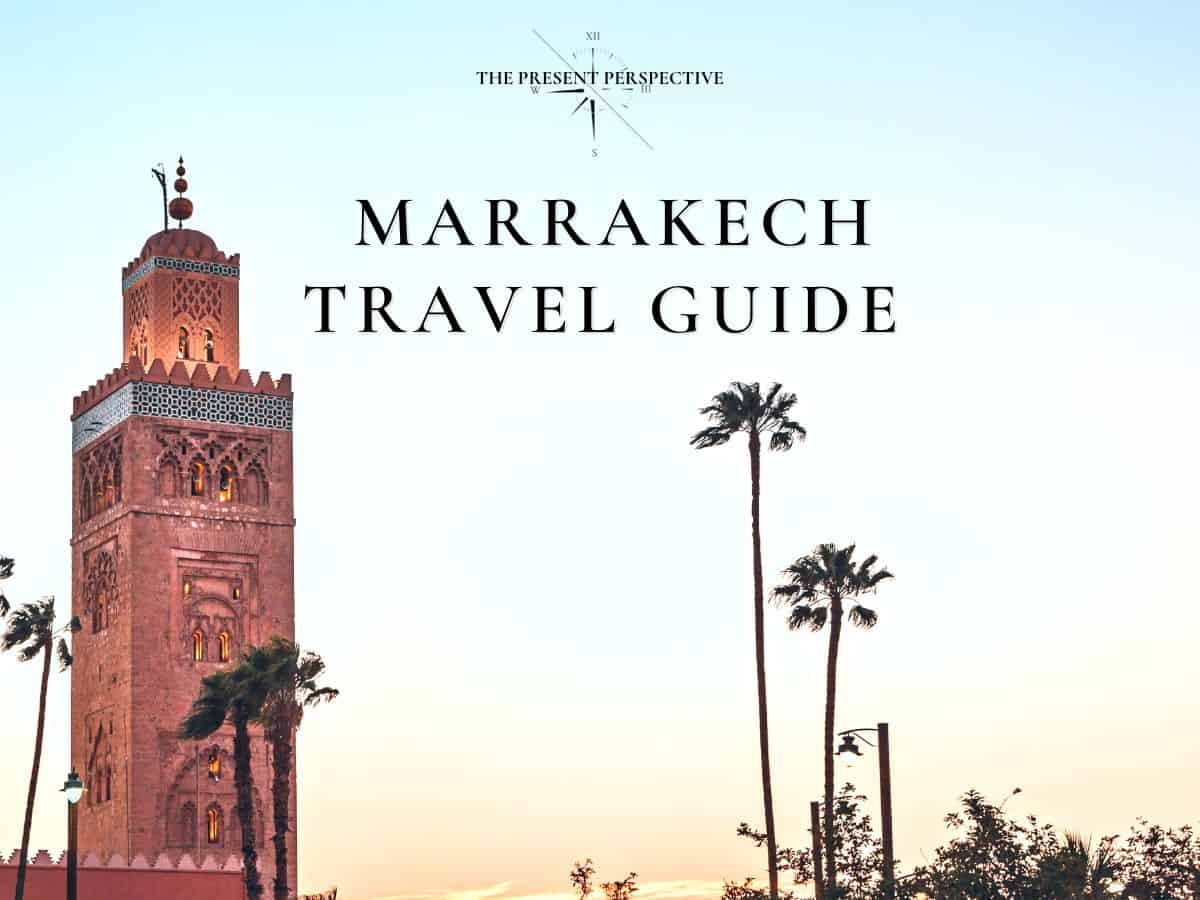
To many people, Marrakech is what dreams are made of. This place has the potential to feel surreal, from its regal palaces to its tight, winding markets. Honestly, imagine this: snake charmers and fortune tellers in the main square, vendors selling leather and spices on narrow streets, colorful palaces imposing their will on the city in every direction, and camels and horse-drawn carriages slowly making their way through the streets.
Snake charmers, fortune tellers, spices, camels, and horse-drawn carriages. Marrakech has it all.
Marrakech is in many ways a city of wonder, and I felt this way both times that I visited. There is just something special in this city that is hard to find in other corners of the world. This is what earned it a place on my list of the best cities to visit in 2022.
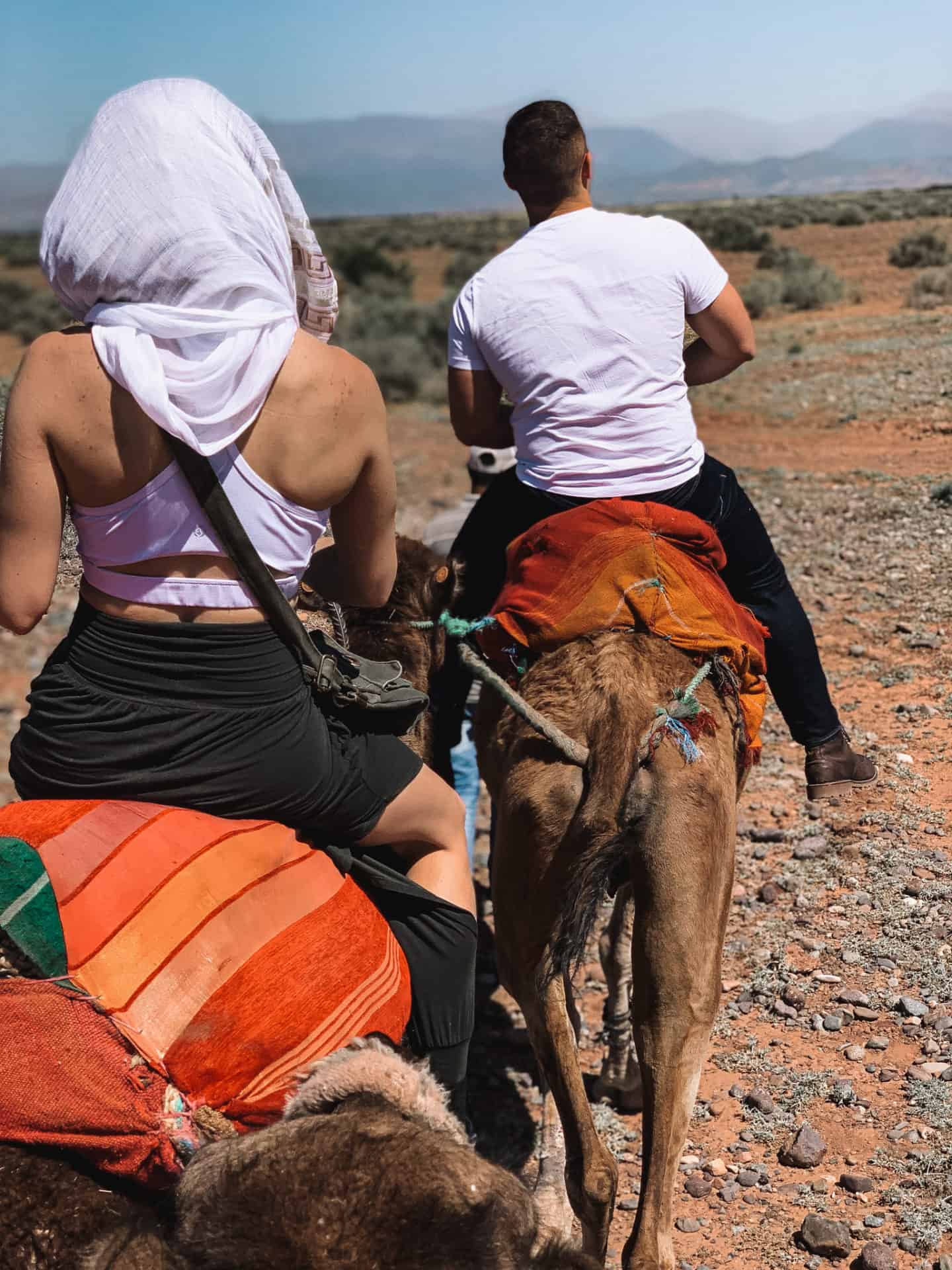
Going to Morocco can really be a once in a lifetime kind of trip if you plan it the right way. There are some really incredible things to see and do, and normally all at a great price. The food is outstanding, the desert activities like camping and camelback riding are always a blast, and the history is just everywhere. Marrakech is always a great starting point for a Morocco trip because it is fairly central, very busy, and very tourist friendly. From here, Casablanca, Rabat, Fez, and all of the other major cities are very accessible by train.
This blog post is going to take a look at everything you need to know when visiting Marrakech, including the best things to do in Marrakech, how to get there, safety in Marrakech, and more. While this post won’t cover what to wear when visiting Marrakech, I did write a whole post on what to wear in Morocco that I recommend reading before your trip.
Is Marrakech, Morocco Safe to Visit?
Morocco is usually the first country that westerners visit in the Arab World, and this is largely due to its level of familiarity. Morocco kind of bridges the gap between European and Middle Eastern culture and influence, and it truly does make for a great first Arab country to visit. In truth, Morocco is unique in and of itself, and while there are components of both European and Arab cultures in Morocco, it has developed a culture of its own over its 1000 years of existence. Personally, I think that Morocco’s culture is much more similar to the cultures of Middle Eastern countries, but it is still very unique in and of itself.
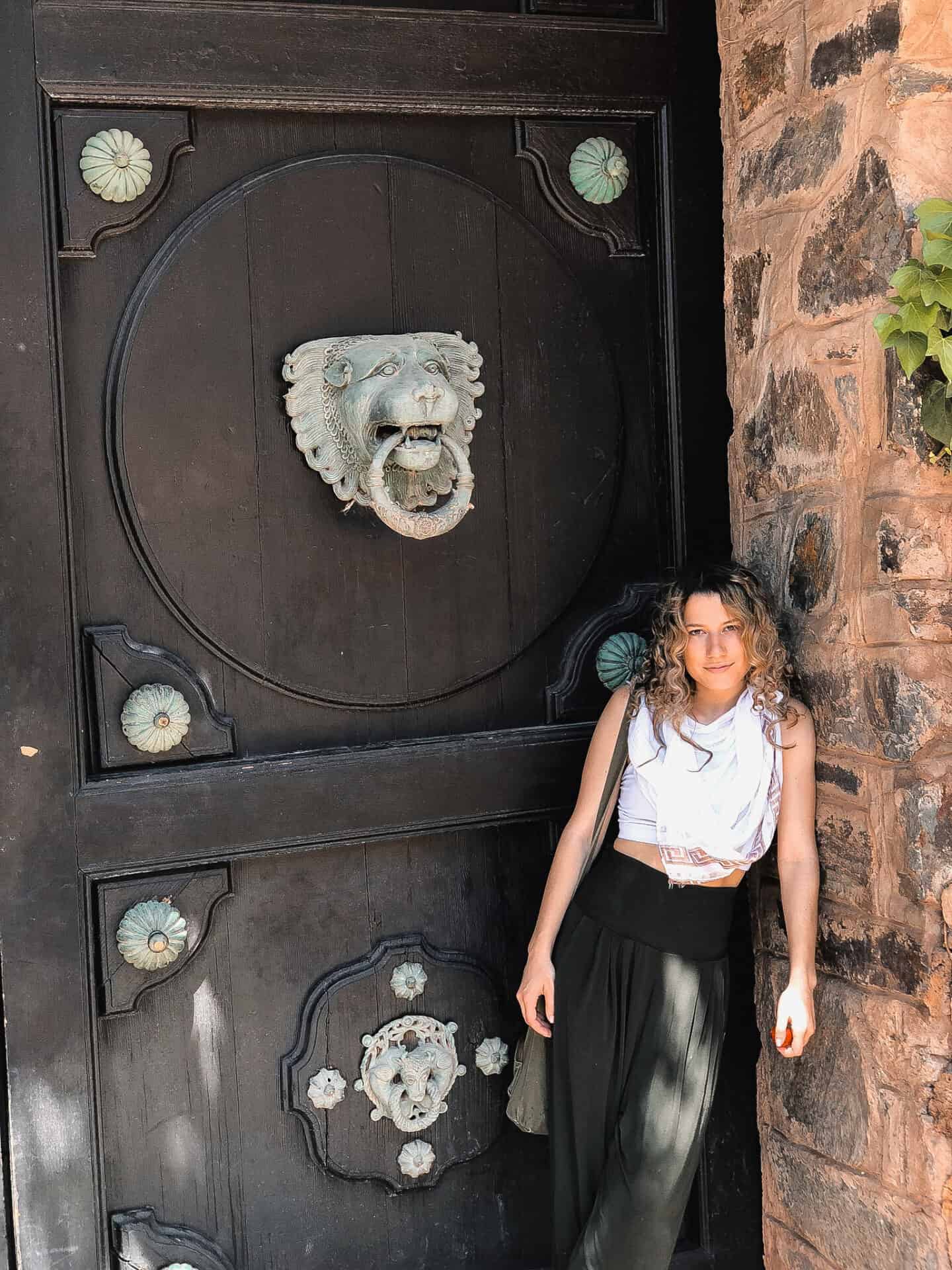
Regardless, my point is that if this is your first time visiting an Arab country, you are likely to be apprehensive. As an American, I heard plenty of stories of terrorism, violence, and crime associated with “the Middle East,” and even I was a bit apprehensive about visiting Morocco for the first time. Well, there are several things wrong with that fear, but I think the most important one to note is that Morocco isn’t even in the Middle East. Morocco is as far from the Middle East as New York City is from Mexico City, or London is from Istanbul. Italy and Greece are both closer.
Important note: Morocco isn’t even in the Middle East.
Morocco is a very safe country to visit. There are few threats of violence here, and I would argue that there is no more threat of violence here than there is in Western Europe or the United States. While you want to take caution in any new place that you travel, there is no need for any different level of caution than you would have in Paris or Rome . Personally, in all of my experiences in the Arab World, I have felt just as safe as I would in Europe. This includes cities like Dubai , Abu Dhabi , and Muscat.
Marrakech, specifically, is one of the safest places to visit in Morocco. There are very few threats of violent crime here, as the city is so internationally famous for tourism. Marrakech authorities do a great job of keeping control of their city, and the locals know the value of foreigners to the Moroccan economy. After all, scaring away tourists means everyone in Marrakech loses.
Your biggest safety concern should be pickpocketing.
In Marrakech, your biggest concerns shouldn’t be violent crimes, but petty crimes. Pickpocketing is a real issue, and you should never keep things in your back pockets. Especially with the close nature of the markets, having a phone or wallet disappear is very easy if you aren’t careful. However, as long as you are careful and keep an eye on your things, there is very little threat to you in Marrakech.
Best Things to Do in Marrakech
1. hang out in the djemaa el fna in the evening.
The Djemaa El Fna is the main square in Marrakech, and it is an absolutely electric place to hang out – especially after dark. This square is probably the place you imagine when you think of Marrakech. This is where you can find snake charmers, fortune tellers, food vendors, singers, dancers, fire jugglers, and other performers. There are great restaurants and cafes lining the perimeter of the square, and the vibes here are nothing short of energizing. If you are looking for the best things to do in Marrakech, spending an evening in the Djemaa El Fna is easily going to land toward the top of any list. I recommend grabbing dinner in one of the restaurants overlooking the square and then proceeding down into the square to hang out afterwards. Beware of scammers here, though, as nothing is truly free. Everyone will want a tip for their services – even the guys with the monkeys.
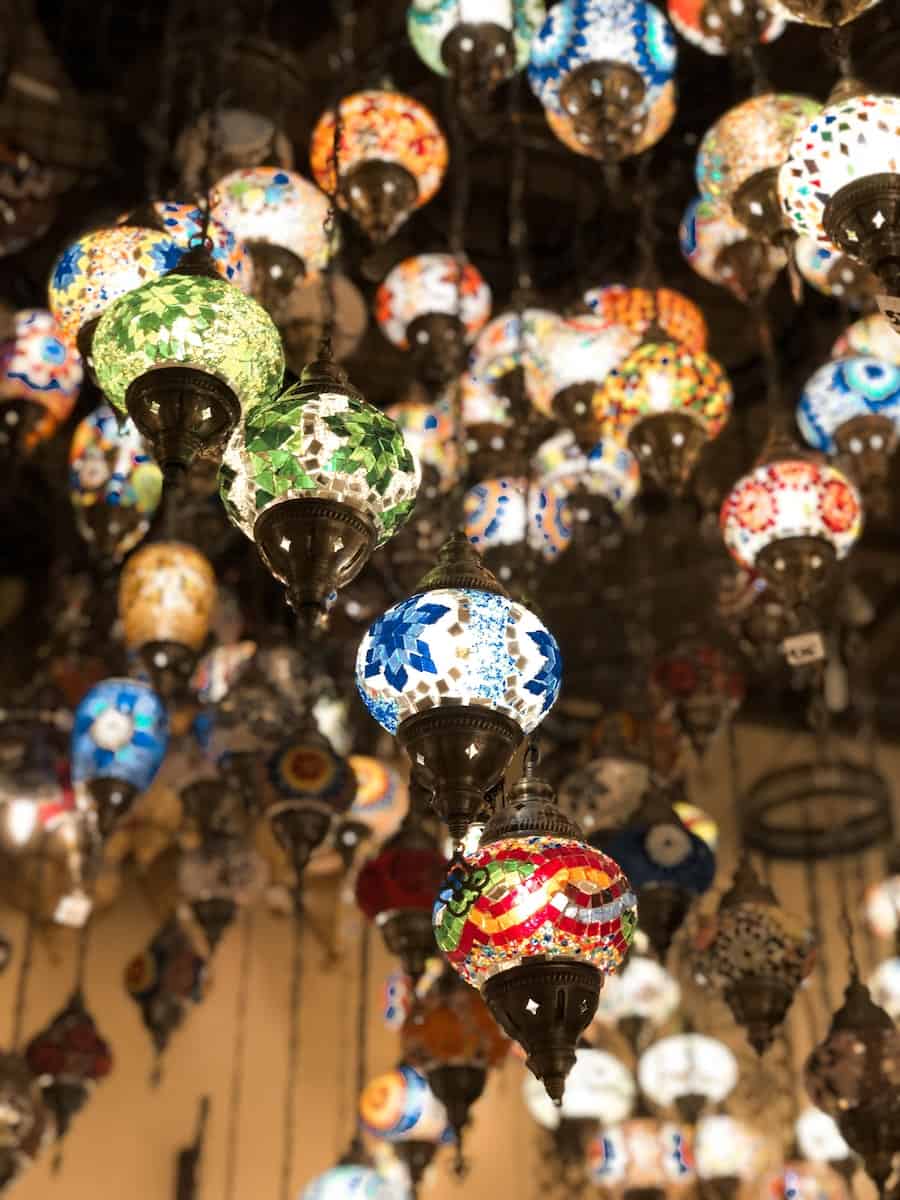
2. Wander Through the Souks in the Medina
On any visit to an Arab city, you will likely encounter the word medina a lot. As background, this is the Arabic word for city , and it is usually used to refer to the walled-in portion of any Arab city. Many Arab cities have city walls, and as time went on, civilization expanded beyond those city walls. Now, the old city inside of the walls is often referred to as the medina , and everything outside of the city walls is just considered the new city. This is the case in Marrakech.
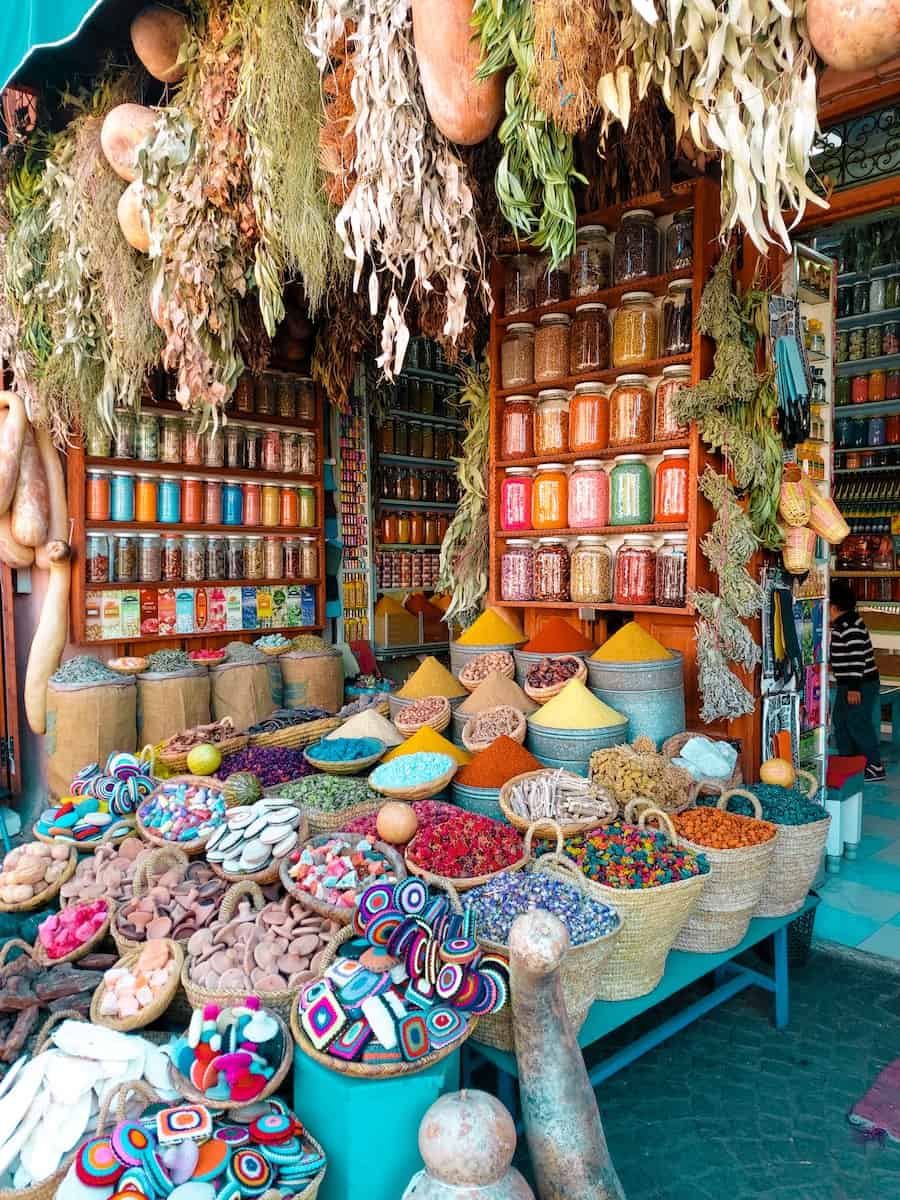
The medina is usually the most traditional part of the city. This is also where the Djemaa El Fna is located. In Marrakech, the iconic markets, or souks , are also located inside the walls of the medina. These markets are known globally as some of the best things to do in Marrakech, and you can buy anything from spices, to leather goods, to animals, to clothing, and more in them. I got a nice pair of pajama pants and a backpack there that I still wear to this day!
When shopping in the souks, remember that the first price they offer you is never the price you should pay. You are expected to haggle , and you can often get the goods for less than half of what the vendor initially offers you.
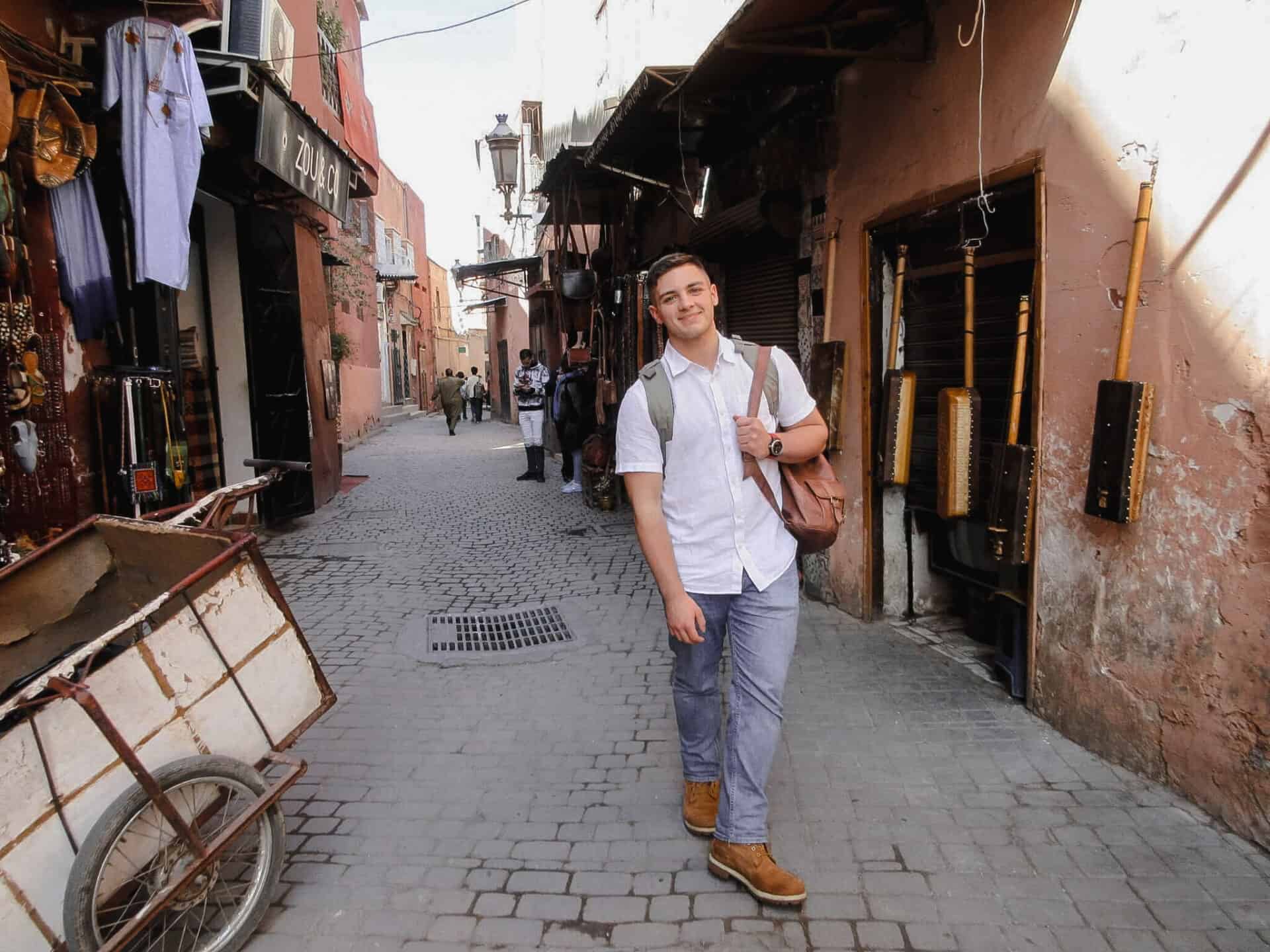
3. Visit the Koutoubia Mosque
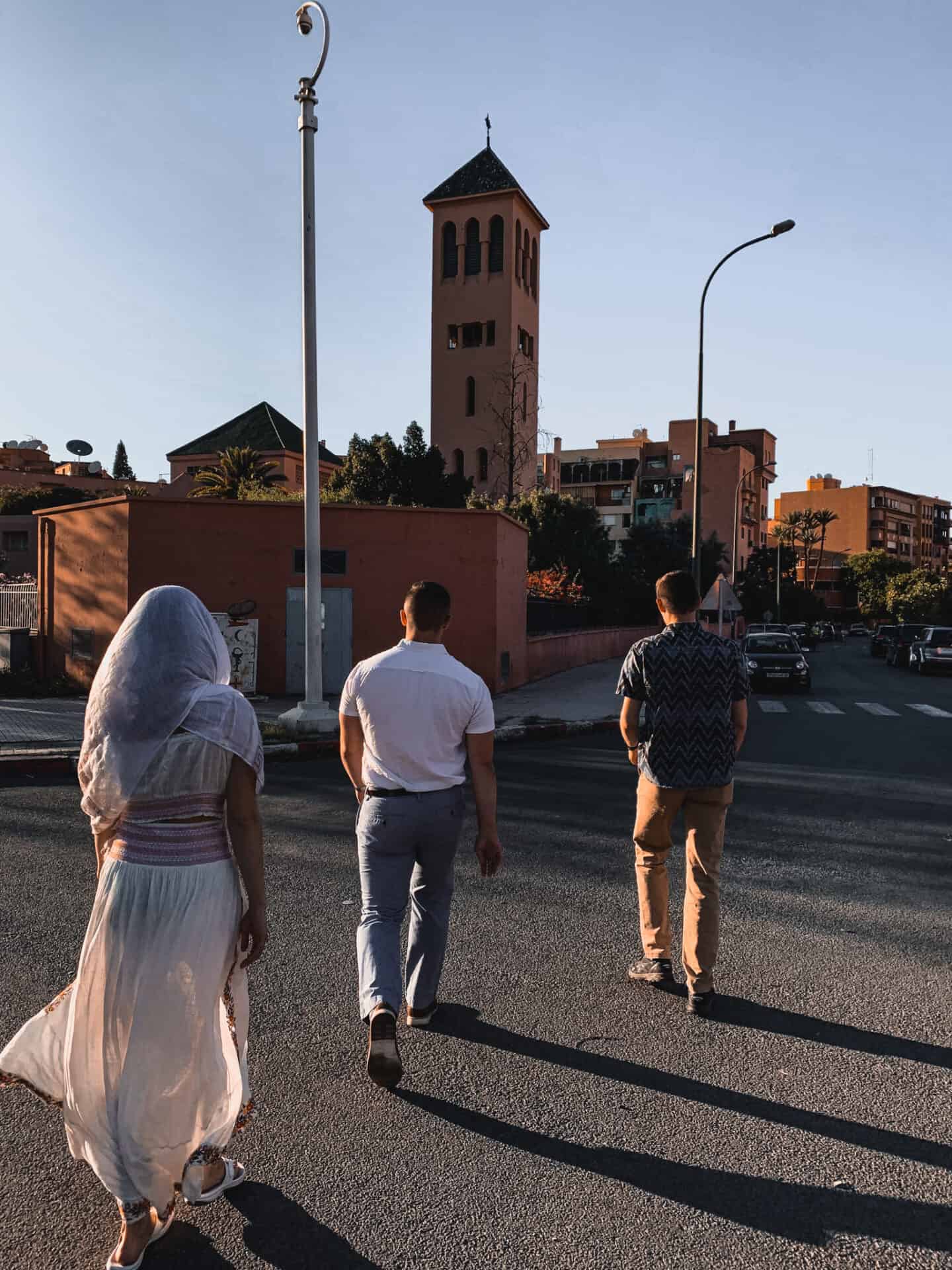
While Marrakech proudly celebrates religious tolerance and has vibrant communities of Jews, Christians, and other major religions, the overwhelming majority of Moroccans are Muslims. The Islamic influence is evident all throughout the city, resulting in some stunning architecture and gorgeous mosaics. The Koutoubia Mosque is no exception to this! This mosque is giant, and its minaret is over 200 feet tall. I always love learning about the interplay of religion and society in the places that I travel, and the Koutoubia Mosque is one of the best places to see the locals’ faith on full display.
One of my visits to Marrakech was during Ramadan , and the religious devotion was simply extraordinary. While you can only enter the mosque if you are a practicing Muslim, admiring it from the outside is still worth the time and effort if you aren’t a practicing Muslim. This building is stunning, and it is one of the most important places in the city without a doubt.
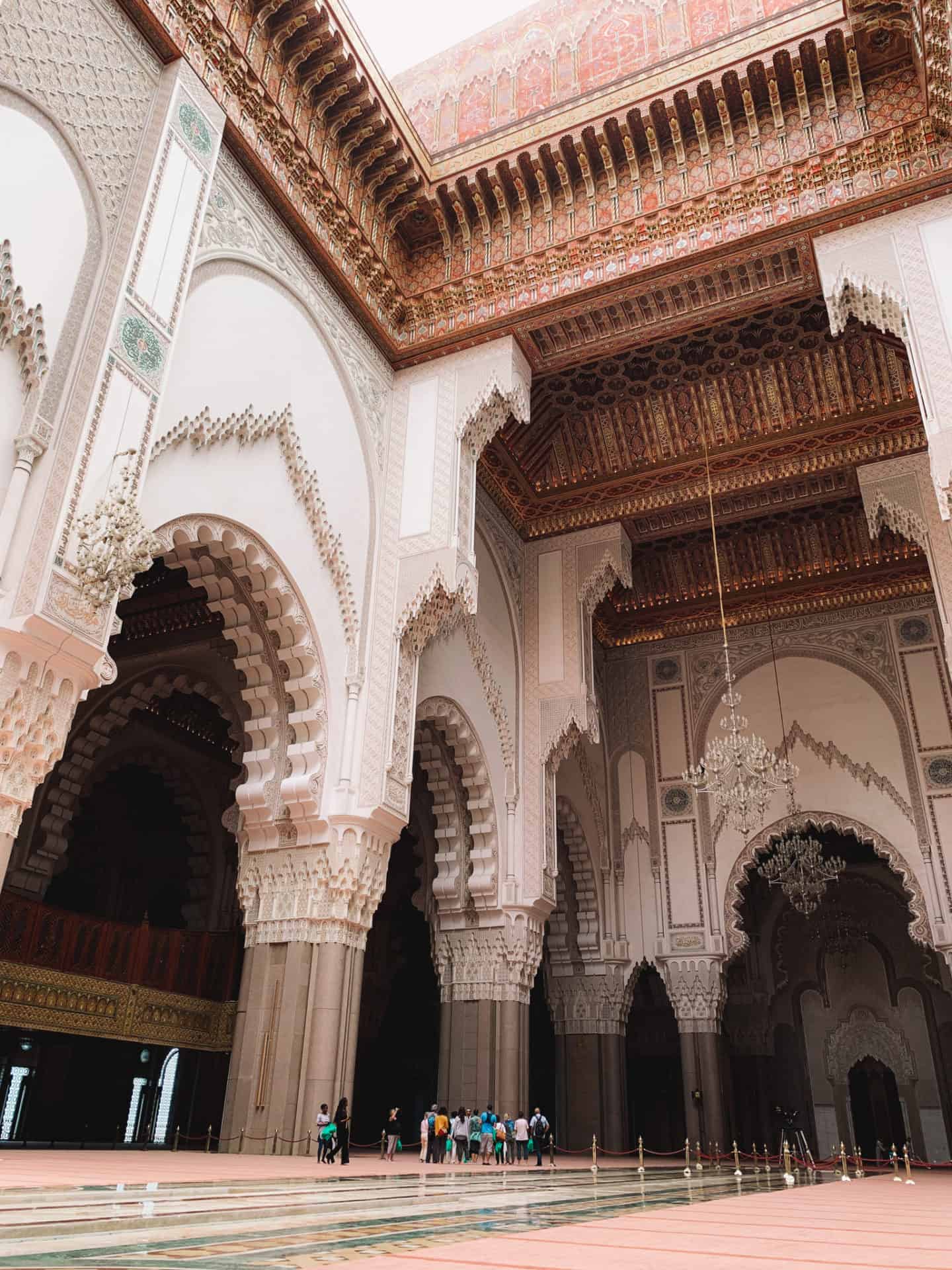
– R E A D –
4. Go for a Marrakech Camel Ride in the Palmeraie
Without a doubt, one of the best things to do in Marrakech is go for a camel ride. This is an iconic thing to do as a western tourist, and there are countless great places to do it. You could ride a camel in the Atlas Mountains, through the city, or in the Sahara Desert. Personally, I think the best place to ride a camel in Marrakech is in the Palmeraie, or Palm Groves. This area just outside of the city is filled with over 100,000 date palm trees, and there are lots of cool things to do here. From biking and ATV riding to horseback and camelback riding, The Palmeraie is definitely worth checking out.
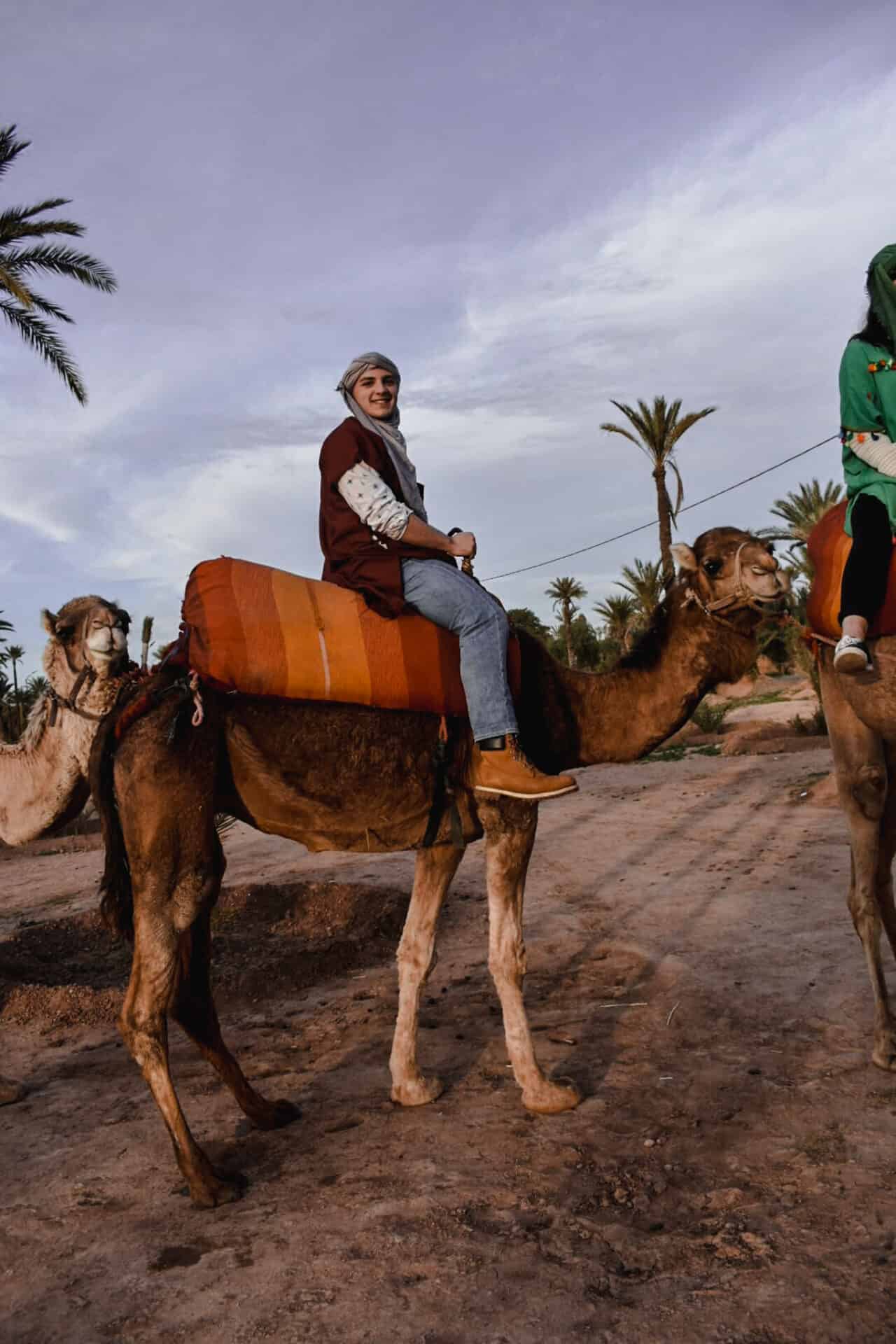
While camel rides in the Atlas Mountains or the Sahara Desert might be bit more epic, camel rides in the Palmeraie are often much more accessible. The Palmeraie is not very far from central Marrakech, and the price points tend to be very affordable, all things considered. For more information about Palmeraie camel rides, check out this company’s website . They offer free transportation from your hotel to the Palmeraie and back, and their price points are very affordable.
5. Visit the Marrakech Museum
The Marrakech Museum is the city’s main museum, filled with collections of old artifacts, artworks, and treasures. The treasures that fill this museum are simply invaluable, and it is really unique to see the prized possessions of this area from so long ago. While the artifacts are great, the actual museum itself is also a spectacle. The Marrakech Museum is housed in the Mnebhi Palace, which is the former residence of one of the rulers of Morocco. This building is grand and stunning, and imagining the lives of the people that once lived here is awesome. I always love seeing the grandeur of palaces and castles, and this museum is a perfect example of that.
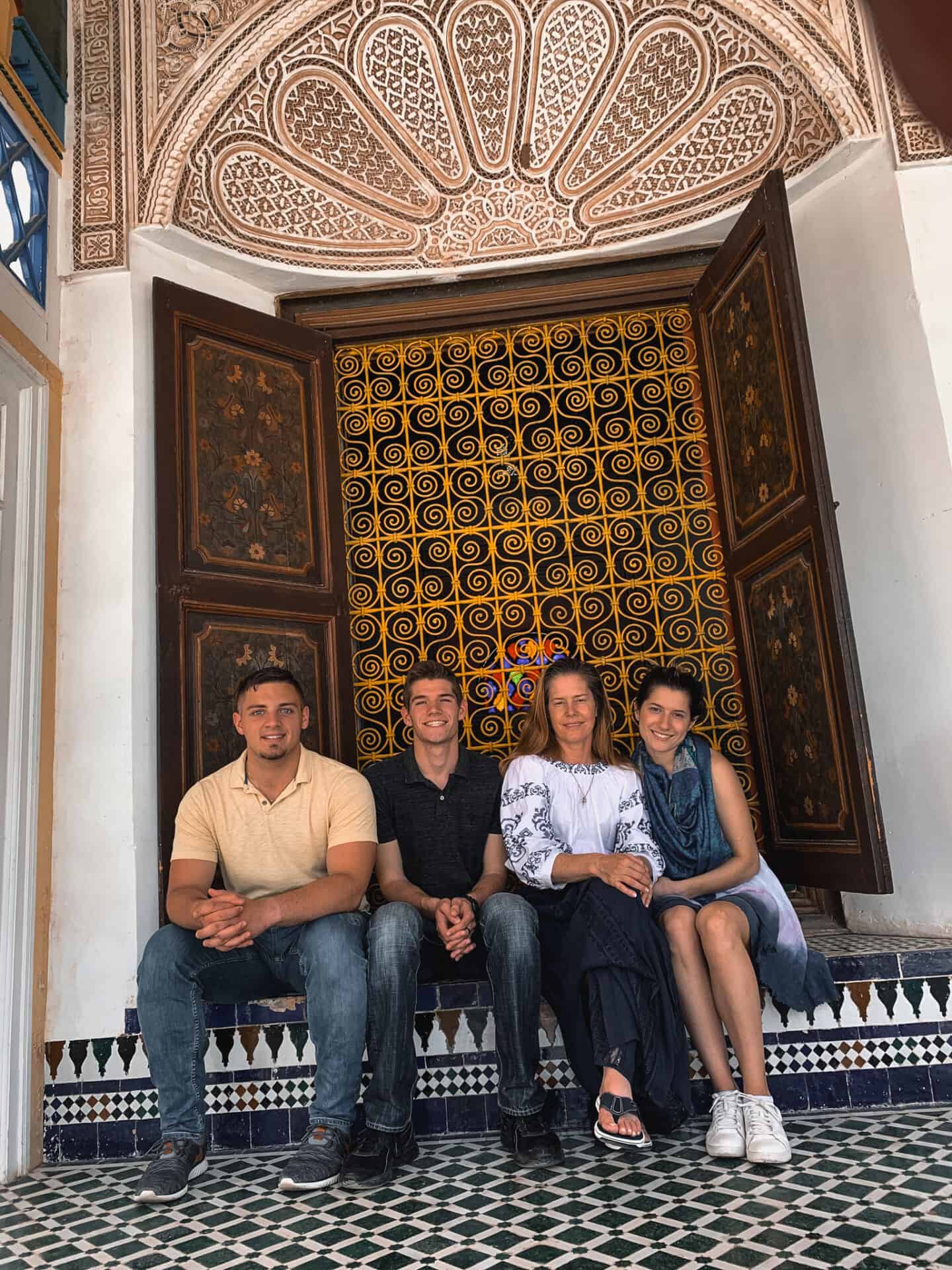
The Marrakech Museum is housed in the magnificent Mnebhi Palace.
6. Meander Through the Majorelle Garden
The Majorelle Garden is a breath of fresh air amid the hustle and bustle of Marrakech. The garden is the work of French painter Jacques Majorelle, who lived here for a significant stretch of his life. The garden is beautiful, and is accented by the bright blue residence where he lived. When he died, the property was purchased by Yves Saint Laurent, who lived here for decades until his death in the early 2000’s.
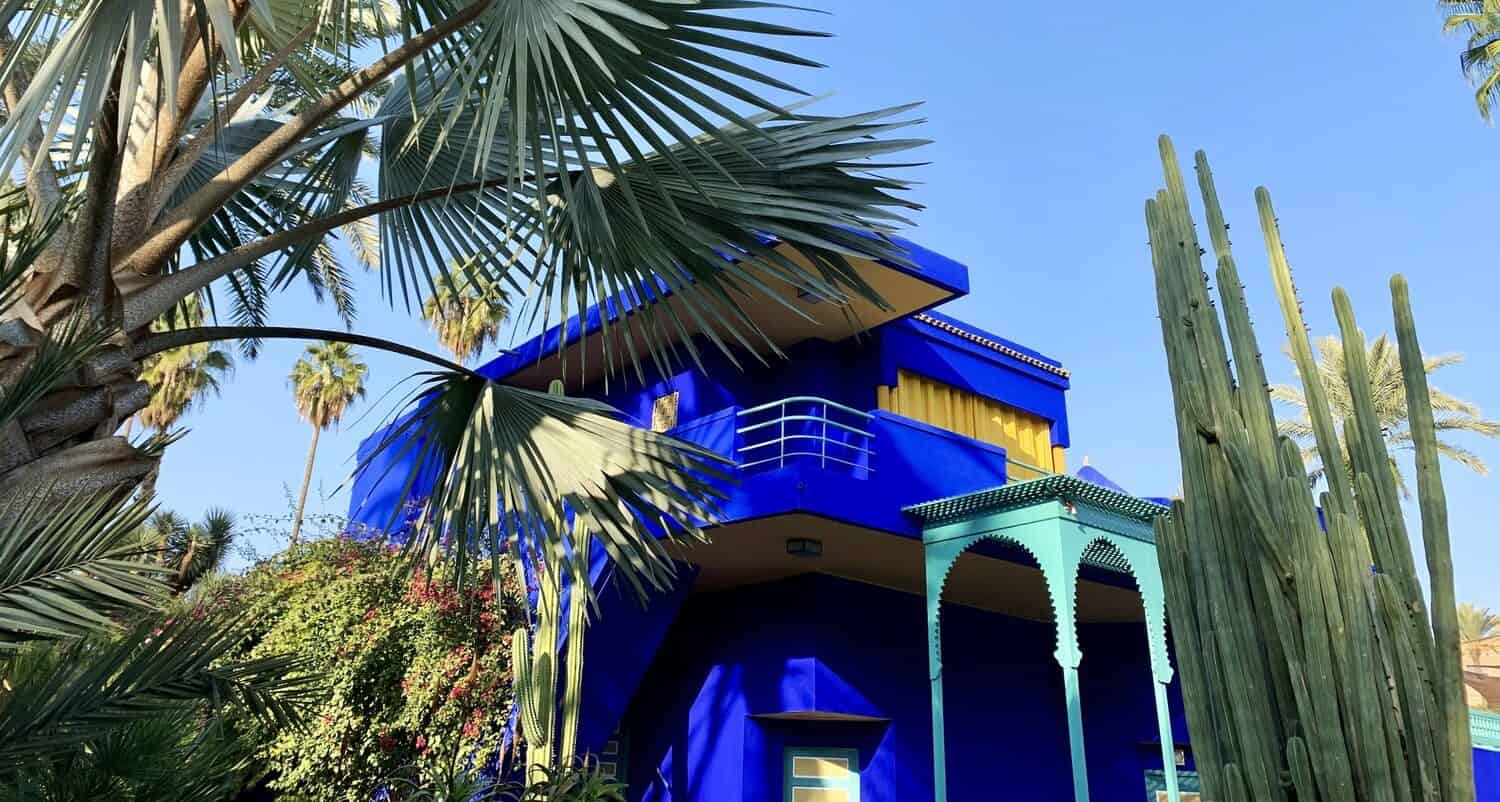
The garden is by no means a full-day activity, but it is certainly a nice place to stop and relax for an hour or two while you are in Marrakech. The greenness of the plants just miles from the Sahara desert is really a cool juxtaposition, and there is a small museum here dedicated to the property and its former owners.
7. Go for a Walking Tour of the Medina
While you could visit some of Marrakech’s palaces and important places on your own, there is no better way to see them than via a tour – especially a free one. There is so much information to be learned about each of these places, and I think that going without a guide only gives you 10% of the experience. In my opinion, one of the best things to do in Marrakech is hire a local guide who can take you through the city to stop at its most famous points . There are several stunning palaces, mosques , and other structures in the city that are best visited with a guide who knows the full history of each one. Visiting the souks with a guide is also a great idea, as your guide generally knows what a fair price for each item is.
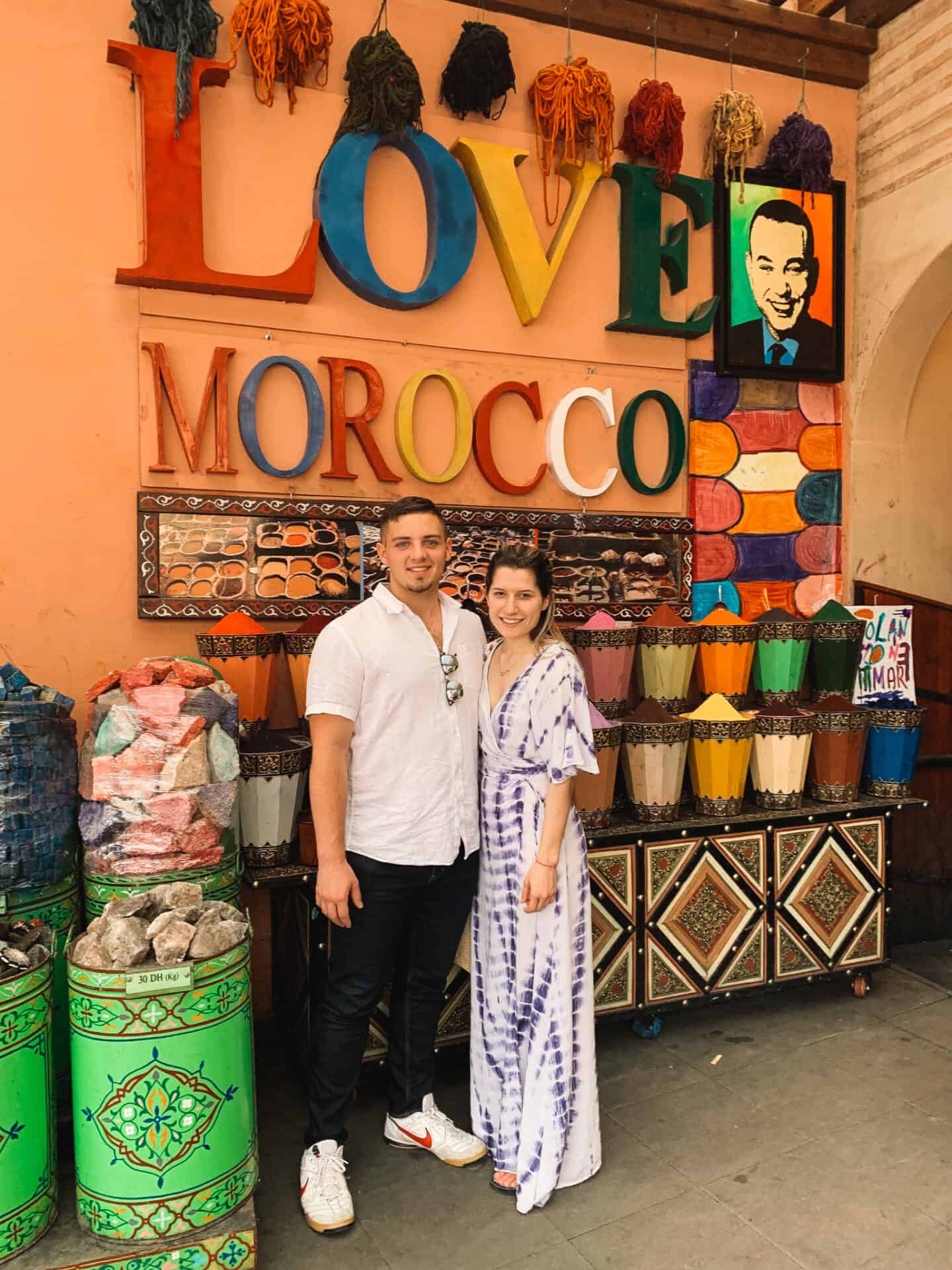
How to Get to Marrakech
Marrakech is an incredibly popular tourist destination, and its airport is well-equipped for tourist traffic. This airport offers great flight options to places all over the world, and the signage is mostly trilingual in Arabic, French, and English. While Marrakech doesn’t have the biggest airport in Morocco, it does have the second-biggest airport in Marrakech Menara Airport (RAK) . If you want to fly into Marrakech, this airport is going to be your best best most of the time. It is located very close to the best parts of the city, and there are usually many great flight options right into it from all over the world. Morocco retains very close ties with France, and you can get a flight to Marrakech from most places in the world with just one stop in Paris. In my experience, flying into Marrakech’s airport is generally the same price as flying into Morocco’s biggest airport, which is in Casablanca.
Casablanca is the biggest city in the country and also has its biggest airport. Casablanca Mohammed V Airport (CMN) is by far the best airport to fly into in Morocco in general, as it has direct flight routes to countries all over the world, including the United States. I mention in my post on finding cheap airfare that typically, bigger airports offer better flight options. This is true for Casablanca! If you plan on going to Casablanca at all, I recommend either starting or ending there so that you can fly into Casablanca and take advantage of the direct flight options. However, if you are only visiting Marrakech, your best bet is probably not to fly into Casablanca, as you would then need to transit a few hours south to Marrakech. While I normally recommend alternative airports that might offer cheaper airfare, there really isn’t one for Marrakech. Just fly right into Marrakech.
Regardless of which airport you choose, the best way to get from the airport to your hotel in Marrakech is by booking a private transfer with our partners at Welcome Pickups . Welcome Pickups offers personalized, private, comfortable rides from the airport into the city for about the same price as a standard taxi. They monitor your flight status while you are in the air, and a driver will be waiting for you holding a sign with your name on it as soon as you arrive.

How to Get Around Marrakech
BY FOOT | TAXI | BUS | CARRIAGE
Marrakech has very scarce public transportation. In the medina itself, there is no way to get around other than walking. This is fine, as it is very walkable. Most people stay within the medina or walking distance to it, anyway, so there is very little need for a car, taxi, or public transportation. However, if you want to get to other parts of the city, you will need to rely on a scant bus network or taxis. There is no Uber in Marrakech, either, so you will need to rely on traditional taxis. Make sure they turn on the meter or you agree on a price ahead of time, otherwise the driver may try to rip you off.
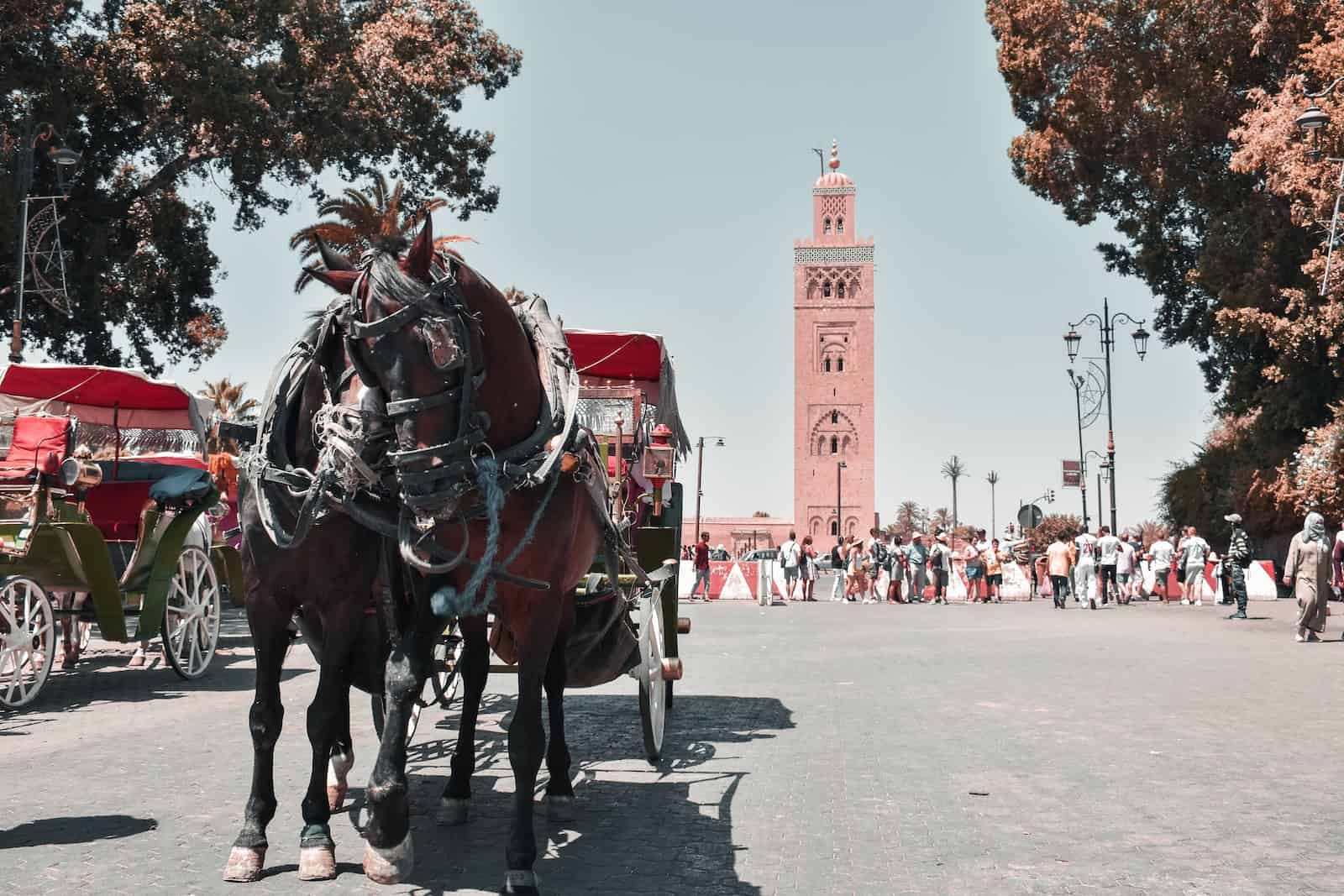
If you are simply looking for a good time, one fun way to get around Marrakech is via horse-drawn carriage. There are carriages placed all around the city with drivers who will happily take you anywhere you want to go in the city. This is a fun and cute way to see the city and get around, but you will certainly be paying a premium for the experience, as these rides are not cheap.
The Best Time to Visit Marrakech
Marrakech is very hot to visit in the summer, as it is located on the edge of the Sahara Desert. Additionally, this is when the massive crowds of tourists come pouring in. I think that the best time to visit Marrakech is between February and May or between September and November. February and November are slightly chilly at times – like in the high 50s – but overall very pleasant. At these times, the crowds of tourists will be much smaller, and you will be able to have a much more pleasant experience with no waiting in lines for restaurants or activities. I advise against visiting Morocco in the middle of the summer, as the heat is just very unpleasant. Most of the best things to do in Morocco are outdoors, and hanging out in the Majorelle Gardens with the sun beating down on you in July isn’t nearly as nice as it is in April.
Visit between February and May or between September and November.

You can probably guess that this question has a very easy answer. If I included Marrakech on my list of the best cities to visit in the world in 2022, it probably is worth visiting, right? This city is filled with unique experiences, and I absolutely love it here. I think that it is the best city to visit in all of Morocco . While there are components of it that are absolutely touristy, Marrakech is still very authentic and is likely one of the most unique places you will have ever visited. The cuisine is delicious, the architecture is beautiful, the markets and squares are vibrant and electric, and the culture is entirely unique. If you were to ask me “Is Marrakech, Morocco worth visiting?” I wouldn’t even hesitate to say it should be towards the top of your bucket list.
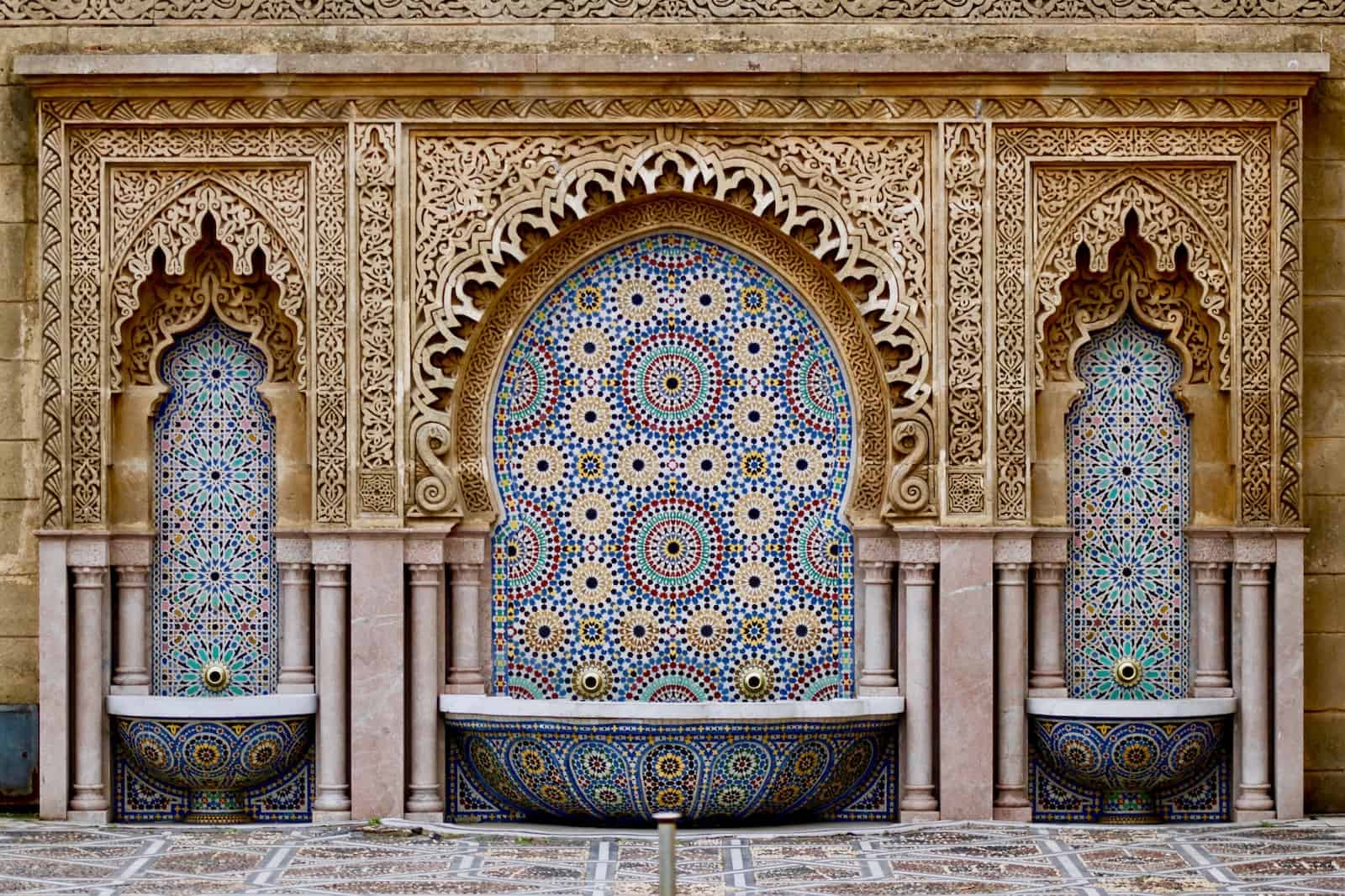
That’s all we have for you about Marrakech! Hopefully this post is helpful as you start planning your journey to one of my favorite cities in the world. I really do think that Marrakech is worth visiting, even if you need to fly across the world to do it.
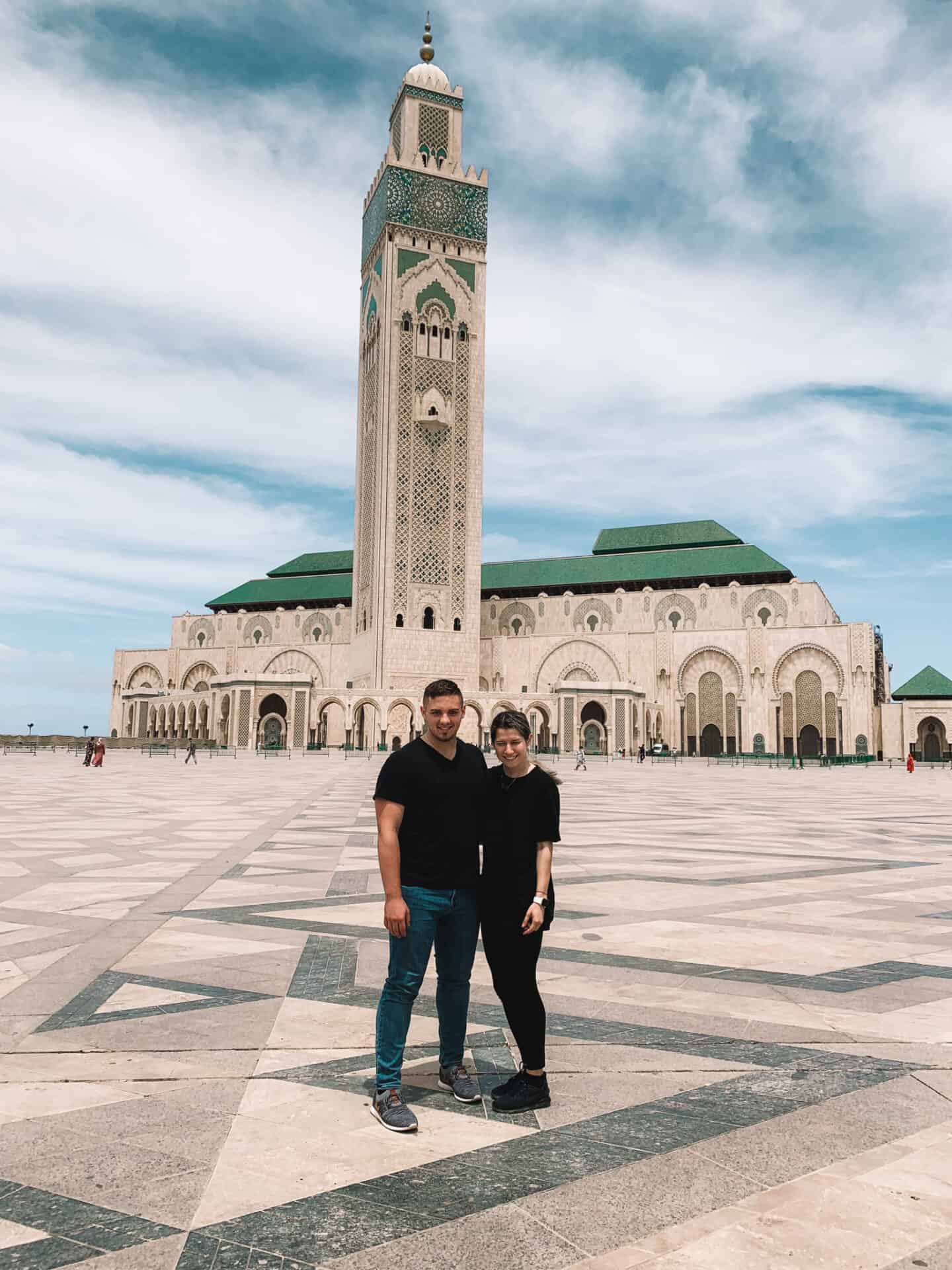
Hi, I'm Greg. I'm an avid traveler who has traveled to over 50 countries all around the world with my wife and kids. I've lived in Italy, Mexico, China, and the United States, and I dream of moving abroad again in the future. With this blog, I provide my audience with detailed destination guides to my favorite places and pro-tips to make travel as stress-free as possible.
thanks a lot for this post
Leave a comment
Save my name, email, and website in this browser for the next time I comment.
Meet The Author - Greg

Recent Post

10 Best Coffee Drinks to Buy From Starbucks in India
April 26, 2024

How Much Does a Trip to Egypt Cost: Budget Breakdown
March 10, 2024

Best Time to Visit the India Gate in Delhi [2024]
March 1, 2024

Flying with a Sinus Infection: Tips to Avoid Pain
February 20, 2024

11 Best Things to Do in Breckenridge Besides Skiing
February 12, 2024

Click allow to get notifications on every article we post.


Marrakech Culture: Exploring the Rich Traditions and Customs of Morocco’s Red City

Affiliate Disclaimer: As an affiliate, we may earn a commission from qualifying purchases. We get commissions for purchases made through links on this website from Amazon and other third parties.
Marrakech is a city that is rich in culture and history. Located in Morocco, it is one of the most popular tourist destinations in the world. The city’s intricate architecture , delicious cuisine, exciting adventures, and welcoming people make it a must-visit destination for anyone interested in experiencing a unique and vibrant culture.
Marrakech has a long and fascinating history that spans centuries. The city was founded in 1070 by Emir Abu Bakr ibn Umar as the imperial capital of the Almoravid Empire. Over the years, Marrakech has been shaped by various rulers, including the Almohads, the Saadians, and the French. Today, the city is a blend of old and new, with ancient monuments and modern amenities coexisting side by side.
Despite its long and complex history, Marrakech remains a city that is deeply connected to its roots. The people of Marrakech are proud of their culture and traditions, and they are happy to share them with visitors. From the language they speak to the food they eat, everything in Marrakech is a reflection of the city’s rich and diverse culture.
Key Takeaways
- Marrakech is a city that is rich in culture and history, making it a must-visit destination for anyone interested in experiencing a unique and vibrant culture.
- Despite its long and complex history, Marrakech remains deeply connected to its roots, with the people of Marrakech being proud of their culture and traditions.
- From the language they speak to the food they eat, everything in Marrakech is a reflection of the city’s rich and diverse culture.
History of Marrakech
Marrakech has a rich and fascinating history that spans over a millennium. From its Berber origins to its Arab influence and French colonization, the city has been shaped by a variety of cultures and civilizations. One of Morocco’s four imperial cities, its full of historical influences from previous Islamic civilisations to the French who colonised it.
Berber Origins
Marrakech was originally founded by the Berber Almoravid dynasty in the mid-11th century. Before the arrival of the Almoravids, the region was ruled by the Maghrawa from the city of Aghmat. The Almoravids conquered Aghmat in 1058, bringing their dominance over southern Morocco. Marrakech served as the Almoravid capital until it fell to the Almohads in 1147.
Arab Influence
After the Almohad conquest, Marrakech continued to thrive as a center of culture and trade. The city was renowned for its beautiful architecture, including the Koutoubia Mosque and the Bahia Palace. It was also an important center of Islamic learning, with scholars and theologians flocking to the city to study at the famous Ben Youssef Madrasa.
French Colonization
In the early 20th century, Morocco fell under French colonial rule. Marrakech became a popular destination for French expatriates and tourists, who were drawn to the city’s exotic charm and vibrant culture. The French colonial influence can still be seen today in the city’s architecture and cuisine.
Geographical Context
Marrakech is located in the western part of Morocco, at the foothills of the Atlas Mountains. It is situated at an altitude of 466 meters (1,529 feet) above sea level and covers an area of 230 square kilometers (89 square miles). The city is surrounded by olive groves, palm trees, and orange trees, which give it a unique beauty and charm.
Marrakech has a hot semi-arid climate, characterized by hot summers and mild winters. The average temperature in summer is around 38°C (100°F), while in winter it drops to around 18°C (64°F). The city receives very little rainfall, with most of it falling between November and March.
Natural Landmarks
Marrakech is surrounded by several natural landmarks that are worth exploring. The High Atlas Mountains, located to the south of the city, offer breathtaking views and are a popular destination for hiking and trekking. The Ourika Valley, located about 30 kilometers (18 miles) from Marrakech, is another popular destination for nature lovers. The valley is known for its picturesque waterfalls, lush greenery, and traditional Berber villages.
The Sahara Desert is also within reach from Marrakech. Zagora, a town located on the edge of the Sahara, is a popular starting point for desert tours. The Sahara offers a unique landscape of sand dunes, oases, and nomadic tribes.
People and Ethnic Groups
Marrakech is a melting pot of cultures and ethnic groups. The city is home to a diverse population, which includes Berbers, Arabs, and people of French descent. Each group has its own unique traditions, customs, and language which have all strongly influenced the modern city and culture today.
The Berbers are the largest ethnic group in Morocco, and they have a rich history that dates back thousands of years. They are known for their colorful clothing, intricate jewelry, and beautiful music. The Berber language is still spoken in Marrakech, and it remains an important part of the city’s culture.
The Arab population in Marrakech is also significant. Arabic is the main language spoken in the city, and it is the language of the Quran, the holy book of Islam. The Arab culture is deeply rooted in religion, and the city is home to many beautiful mosques and religious sites.
French Influence
The French influence in Marrakech is also evident. Many people of French descent live in the city, and their influence can be seen in the city’s architecture, cuisine, and fashion. French is also spoken by some people in Marrakech, especially in the more touristy areas.
When visiting Marrakech, it’s helpful to know a bit about the language spoken in the city. The main language in Marrakech is Arabic, but French is also widely spoken. The Berber language is significant and still spoken within the country. Many people in the city speak a third or fourth language, including English.
Arabic is the official language of Morocco, and it’s the most widely spoken language in Marrakech. It’s a beautiful language with a rich history, and learning a few basic phrases can go a long way in making your visit more enjoyable. Here are a few common Arabic phrases that you might find useful:
- “Salam alaikum” – This is a greeting that means “peace be upon you.” It’s a common greeting in Morocco, and you’ll hear it frequently.
- “Shukran” – This means “thank you.” It’s always polite to say “shukran” when someone does something nice for you.
- “La shukran” – This means “no thank you.” If you’re not interested in something, you can politely decline by saying “la shukran.”
French is the second language of Morocco, and it’s widely spoken in Marrakech. This is due to the country’s colonial past, as Morocco was a French protectorate from 1912 to 1956. Many signs in Marrakech are in both Arabic and French, and you’ll hear French spoken in many restaurants and shops. If you speak French, you’ll have an easier time communicating with locals.
Berber Language
The Berber language is the traditional language of Morocco, and it’s still spoken by many people in Marrakech and is the unofficial second language. The language berbers remain an indigenous group in North Africa, and their language has been spoken in the region for thousands of years. If you’re interested in learning more about the Berber language and culture, there are many opportunities to do so in Marrakech.
English is not as widely spoken in Marrakech as Arabic or French, but many people in the city do speak some English. If you don’t speak Arabic or French, you can usually get by with English in tourist areas. However, it’s always a good idea to learn a few basic phrases in the local language to show respect for the culture and make your visit more enjoyable.
Religion and Beliefs
Marrakech is a city deeply rooted in religion and beliefs. The majority of the population in Marrakech is Muslim, and Islam is the official religion of Morocco.
Islam is the predominant religion in Marrakech, and it is deeply ingrained in the daily lives of the locals. Muslims believe in one God, Allah, and follow the teachings of the Prophet Muhammad. The Quran is the holy book of Islam, and it is believed to be the word of God as revealed to the Prophet Muhammad.
Muslim Practices
Muslims in Marrakech follow the five pillars of Islam, which are the foundation of the religion. These include:
- Shahada: the declaration of faith
- Salat: prayer five times a day
- Zakat: giving to charity
- Sawm: fasting during the month of Ramadan
- Hajj: pilgrimage to Mecca
Prayer is an important part of Muslim life in Marrakech, and you will often hear the call to prayer, known as Adhan, echoing through the streets. Muslims are required to pray five times a day, facing towards Mecca.
Religious Festivals
Muslims in Marrakech celebrate several religious festivals throughout the year. Eid al-Fitr, also known as the Festival of Breaking the Fast, is celebrated at the end of Ramadan. It is a time for families to come together, share meals, and exchange gifts.
Another important festival is Eid al-Adha, the Festival of Sacrifice, which commemorates the willingness of Ibrahim (Abraham) to sacrifice his son as an act of obedience to God. Muslims celebrate by sacrificing an animal, usually a sheep or goat, and sharing the meat with family, friends, and those in need.
Architecture
Marrakech is a city that is known for its rich and diverse architecture. From the ancient buildings of the medina to the modern structures built outside the City Walls, t he city has a unique and fascinating architectural history that is worth exploring.
The medina of Marrakech is a UNESCO World Heritage Site and is home to some of the most impressive examples of traditional Moroccan architecture. The buildings in the medina are made of red sandstone and feature intricate carvings and geometric patterns. The narrow streets and alleys of the medina are lined with shops and stalls that sell everything from spices and textiles to jewelry and pottery.
Koutoubia Mosque
The Koutoubia Mosque is one of the most famous landmarks in Marrakech. The mosque is located in the heart of the city and features a towering minaret that can be seen from miles away. The minaret is over 70 meters tall and is decorated with intricate carvings and patterns. The mosque itself is also a stunning example of traditional Moroccan architecture, with its red sandstone walls and ornate details.
Residential Architecture
Residential architecture in Marrakech is also worth exploring. Many of the homes in the city feature traditional Moroccan design elements, such as courtyards, fountains, and intricate tile work. Some of the most impressive examples of residential architecture can be found in the riads of the medina.
Riads are traditional Moroccan houses that feature an interior garden or courtyard. Many of these riads have been converted into guesthouses or hotels, allowing visitors to experience the beauty of traditional Moroccan architecture firsthand.
Marrakech is a food lover’s paradise, with a rich and diverse culinary culture that reflects its history and geography. Moroccan cuisine is a blend of Berber, Arab, and Mediterranean influences, with a focus on spices, herbs, and local ingredients. The cuisine of Marrakech is particularly renowned for its tagines, which are slow-cooked stews made in a clay pot over a charcoal fire.
Traditional Dishes
Traditional Moroccan dishes are hearty, flavorful, and often spicy. One of the most famous dishes is the tagine, which is a stew made with meat, vegetables, and spices. Chicken tagine with preserved lemons and olives is a classic dish that you must try. Another popular dish is couscous, which is a staple food made from semolina grains. It is often served with vegetables, meat, or fish.
Street Food
Marrakech’s street food scene is vibrant and diverse, offering a range of delicious and affordable options. One of the most popular street foods is the b’stilla, which is a sweet and savory pastry filled with meat, almonds, and spices. Another popular snack is the maakouda, which is a fried potato ball that is crispy on the outside and soft on the inside. You can also try the merguez, which is a spicy sausage made from lamb or beef.
Tea Culture
Mint tea is an essential part of Moroccan culture, and it is often served as a sign of hospitality. The tea is made with green tea leaves, fresh mint, and sugar. It is poured from a height to create a frothy layer on top, and it is served in small glasses. Drinking mint tea is a social activity, and it is often accompanied by sweet treats like honey and argan oil pastries.
Arts and Crafts
Marrakech is a city that is rich in arts and crafts. From music to textiles, this city has a lot to offer.
Marrakech is known for its diverse music scene. Some of the most popular genres of music in Marrakech include Rai and Gnaoua. Rai music is a type of popular music that originated in Algeria but has since spread throughout North Africa. Gnaoua music, on the other hand, is a type of spiritual music that is performed by a group of musicians known as a “troupe.” The music is characterized by the use of traditional instruments such as the guembri, krakebs, and tbel.
Marrakech is also well-known for its crafts. One of the most significant craft skills is the beautiful art of Tazoukt. This is a creative form of woodcraft where wooden items such as furniture, boxes, and panels are painted with intricate and sophisticated patterns. The designs use red to symbolize the city of Marrakech, and the craftsmen incorporate this into their work.
Another popular craft in Marrakech is rug making. The rugs are made from wool, silk, or cotton and are often decorated with intricate designs. The rugs are made on looms, and each rug can take several weeks or even months to complete.
Traditional Clothing
Traditional clothing is an essential part of Marrakech’s culture. Men often wear djellabas, which are long, loose-fitting robes that come in a variety of colors and patterns. Women, on the other hand, wear kaftans, which are long, flowing dresses that are often decorated with embroidery or beading. Both men and women wear a type of slipper known as babouches.
Festivals and Events
Marrakech is known for its vibrant culture and diverse festivals and events. Whether you are interested in music, sports, art, film, food, or traditional culture, there is sure to be an event or festival in Marrakech that you’ll love.
Ramadan is a month-long religious observance celebrated by Muslims worldwide. During this time, Muslims fast from dawn until dusk and engage in prayer and reflection. In Marrakech, where there is a strong religious culture and the vast majority are muslims, Ramadan is a time of great celebration and community. Ensure you are aware of what not to do in Marrakech – you must respect their culture and their customs.
The city comes alive at night, with bustling markets, lively music, and delicious food. If you are in Marrakech during Ramadan, be sure to visit the famous Jemaa el-Fnaa square, where you can experience the vibrant atmosphere and enjoy traditional Moroccan cuisine.
Eid Es Seghir
Eid Es Seghir, also known as Eid al-Fitr, is a religious holiday that marks the end of Ramadan. It is a time of great celebration, with families coming together to share food and gifts. In Marrakech, Eid Es Seghir is a time of great joy and festivity. The city is decorated with colorful lights and decorations, and there are many cultural events and activities to enjoy.
Music Festivals
Marrakech is home to several music festivals throughout the year. One of the most popular is the Marrakech International Film Festival, which showcases the best in international cinema. Another popular festival is the Marrakech Popular Arts Festival, which celebrates traditional Moroccan culture through music, dance, and theater. The Marrakech Jazz Festival is a must-see for jazz enthusiasts, featuring some of the best musicians from around the world.
Marrakech, although it is not the Moroccan capital, is a city that attracts tourists from all over the world. It is an incredible city that is rich in culture and offers a unique experience to all its visitors. Before you go, make sure you are up to date with Marrakech travel restrictions and have read our Marrakech travel tips .
Accommodation
Marrakech has a wide range of accommodation options to suit all budgets. From luxury hotels to budget-friendly hostels, there is something for everyone. If you are a couple looking for a romantic getaway, there are many riads (traditional Moroccan houses) that offer a peaceful and intimate setting. If you are travelling with family or friends, there are many hotels and apartments that can accommodate larger groups.
Attractions
Marrakech has many attractions that are a must-see for any tourist. The city is home to the famous Jardin Majorelle, a beautiful Marrakech garden that was once owned by Yves Saint Laurent. The garden is a UNESCO World Heritage site and is a popular attraction for tourists.
The city also has many historical sites, such as the Koutoubia Mosque, the Bahia Palace, El Badi Palace ruins,and the Saadian Tombs. The famous Jamaa el Fna square is a hub of activity and is a great place to experience the local culture.
Marrakech offers a wide range of activities for tourists. For those who love outdoor activities, there are many options such as hiking in the Atlas Mountains, camel trekking in the desert, and quad biking.
If you are interested in shopping, the souks (markets) in Marrakech offer a unique shopping experience where you can buy traditional Moroccan goods such as carpets, pottery, and leather goods. The city also has many restaurants that serve traditional Moroccan cuisine, as well as international cuisine.
FAQS on Marrakech culture
What is the culture of marrakech.
Marrakech, known as the “Red City” due to its red sandstone buildings, is rich in culture that blends Berber, Arab, French, and other influences. Its vibrant culture is seen in its bustling souks, ornate palaces, beautiful gardens, and historic medina. Marrakech is renowned for its arts and crafts, including pottery, leather goods, textiles, and metalwork.
The city is also famous for its food culture, with street food stalls in Jemaa el-Fnaa square and traditional Moroccan restaurants offering tagines, couscous, and mint tea. Marrakech respects its religious culture, evident in its beautiful mosques and Islamic architectural features.
What is Marrakech famous for?
Marrakech is famous for its historic medina, a UNESCO World Heritage Site, where you can explore labyrinthine alleys filled with colorful souks selling everything from spices to handcrafted goods. The city is also known for iconic landmarks such as the Koutoubia Mosque, Bahia Palace, and Jardin Majorelle.
Marrakech’s Jemaa el-Fnaa square, a bustling marketplace in daylight hours and a food lover’s paradise at night, is an unforgettable sight. Outside the city, the stunning landscapes of the Atlas Mountains and the Agafay Desert add to Marrakech’s allure. The city’s luxurious riads (traditional houses turned hotels), five star resorts , spas offering traditional hammam experiences, and vibrant festivals also add to its fame.
Leave a Reply Cancel reply
Your email address will not be published. Required fields are marked *
Save my name, email, and website in this browser for the next time I comment.
Explore More

Beaches in Tangier: Sun, Sand, and Serenity

Journeying from Tangier to Chefchaouen

Ajdir al Hoceima: The Unsung Gem of the Rif Mountains

History of Tangiers: The Crossroads of Civilizations

Day Trip Tangier: Exploring Morocco’s Northern Gem in One Day

Best Places to Stay in Tangier: A Comprehensive Guide
National Geographic content straight to your inbox—sign up for our popular newsletters here

A family city guide to Marrakech
Morocco with kids? The best place to start is Marrakech — an ancient yet accessible city with street entertainment, rooftop restaurants and colourful markets.
The melodic song of the call to prayer bouncing off the honeycomb-coloured medina walls; the hammering of metal and bray of a donkey in the winding souqs; the whine of a pungi flute in the Jemaa el-Fnaa square at dusk — there’s much to enchant kids in Marrakech’s ancient heart. This North African destination might not be the most likely of family city breaks, but it’s guaranteed to burrow deep into your children’s memories. The compact historic centre — with its fountains, palaces and lively markets — is easily walkable and provides endless fascination for enquiring minds.
Beyond the city, there are many excellent day trips, from gentle hikes and waterfall excursions in the High Atlas Mountains to quad biking in the Agafay desert and kid-friendly cooking classes surrounded by village farms. Many families choose to stay in hotels with pools outside central Marrakech, but there’s so much to explore in the medina (old town) itself that those with older kids or more adventurous appetites should consider atmospheric, traditional-style riad hotels close to the thrumming beats of the Jemaa el-Fnaa and its evening entertainment — a guaranteed crowd-pleaser for any age, at the heart of a city that deserves far more than a day’s exploration.
( A family city guide to Paris .)

What to do in Marrakech with kids
Toddlers: The Arabian Nights fairytales have nothing on Marrakech’s medina. Glistening platters of honey-soaked pastries, rainbow displays of babouche slippers and the whir and hammer of toiling craftsmen all offer joyful distractions for tots. The best time to wander the souk is at dusk, when the sun loses its bite and local families come out to stroll and shop.
Late afternoon to early evening is also a good time to let kids explore Marrakech’s many gardens. They’ll be in good company with all the local children, who come for family picnics in the shade of palm trees. The gardens surrounding the Koutoubia Mosque are the closest to the medina, but Cyber Park a five-minute walk northwest has a more local vibe, as do the Menara Gardens a little further west. Adventurous parents could also try the public hammam — every neighbourhood in Marrakech medina has one, and they’re usually full of mothers and children during the women’s bathing sessions.
Children under 10: To see something of the Rose City’s past, take your kids to the Badi Palace, a medieval ruined fortress perfect for energetic scrambles. Long-legged storks have built huge nests on its lofty ramparts, providing a fascinating sideshow. History-lovers may prefer the Bahia Palace, which leaves less to the imagination as it’s been partially restored to show how former sultans lived amid richly tiled courtyards and ornately carved rooms.
After around 2pm, the Jemaa el-Fnaa is closed to traffic, orange-juice stalls pack away and the medina’s main square is transformed into a huge street-food market. It’s not just a good place for dinner come dusk, but also live entertainment with magic tricks, gnaua drumming and high-pitched pungi flutes drawing locals and travellers alike.
A wealth of kid-friendly day trips can be organised from Marrakech, too. Take your little ones out for a donkey trek in the High Atlas Mountains with a stop for lunch in a traditional Amazigh village, scramble up to a waterfall with locals or book onto a country cooking class at Atelier Chef Tarik , which operates on a laidback farm. Here, children can get involved with kneading dough for fresh bread or mixing semolina for couscous — and the cooking school supports training and education for young women in the local villages.

Tweens and teenagers: Marrakech has a wealth of museums, tours and activities for every interest. Active kids can whizz around on a quad bike in the arid Agafay scrub and desert just 40 minutes from the medina. Social enterprise Pikala , meanwhile, runs bicycle tours through the medina or Palmeraie (a palm oasis outside of Marrakech) that support local kids by training them as mechanics while promoting bicycle transport for local youths.
Arty teens can visit Jardin Majorelle — the beautiful, chic gardens and house once owned by Yves Saint Laurent — and the Musée Yves Saint Laurent fashion and design museum next door. There’s also the Moroccan Culinary Arts Museum , exploring Morocco ’s spices, the Jewish influence on Moroccan food and other aspects of the country’s unique cuisine, which will reel in budding chefs. If all else fails, teenagers may enjoy shopping for trainers and other gear in the medina souks. Try Naturom for organic local beauty products or Max & Jan for cool clothing, accessories and room decor.
Where to stay in Marrakech with kids
Toddlers: Traditional medina riads are beautiful but sound travels easily in these intimate courtyard hotels and parents of toddlers may prefer more space and privacy. Jnane Tamsna , in the Palmeraie area just north of central Marrakech, is an excellent, family-friendly alternative with two heated pools, lush palm-shaded walkways and delicious home-cooked meals. It also has a TV and games room with a DVD library for downtime. For something a little more central, look for a contemporary pool-framed hotel in the quiet, upmarket suburb of Hivernage, just outside the medina.
Children under 10: Beldi Country Club , a 15-minute taxi ride south of the Jemaa el-Fnaa, is a fashionable option with rose gardens and several pools, including two for kids, plus child-friendly activities such as pottery and cooking classes, an outdoor cinema and horse-riding. For medina atmosphere, try Riad Nesma — a Moroccan-owned traditional hotel with four-person rooms. The big selling points are its small rooftop dip pool, friendly staff and easy-to-find location on one of the main streets 10-minutes’ walk south of the Jemaa el-Fnaa.
Tweens and teenagers: Older kids will appreciate being in the thick of the action. Try Riad L’Orangerie , which has an easy-to-find location surrounded by shops and cafes on one of the medina’s main arteries. On balmy nights, the walled pool area is strung up with a projector for movie nights. Riad Noos Noos , in the mellow Mellah — ancient Jewish quarter — is a good-value option with a couple of family suites and a pool table room; it’s just off lively Place de Ferblantiers and has a small suntrap roof terrace overlooked by nesting storks.

Where to eat in Marrakech with kids
Toddlers: The casual-dining atmosphere of the Jemaa el-Fnaa makes it a laidback spot for snacking and quick bites with whirlwind small children — fried fish, kebabs and freshly squeezed orange juice are all likely to appeal. Pizza is always a good fallback — Kasbah Café Marrakech is a well-located spot serving giant pizza wheels on its straw-umbrella-shaded rooftop, close to the Saadian Tombs and Badi Palace.
Children under 10: Whisk kids up to the waterfall terrace seating at Zeitoun Café overlooking the Jemaa el-Fnaa; there’s a kid’s set menu including ice-cream, plus crowd-pleasing seasonal juices, kefta meatball sandwiches and omelettes, which kids can munch on while checking out the street hawkers and snake charmers below. Café Clock , in the southern Kasbah area of the medina, is a cultural space and cafe with a warren of art-splashed rooms and terraces and gnaua music nights, storytelling and cinema events — adventurous kids might like to try the camel burger with a date milkshake.
Tweens and teenagers: The Marrakech Henna Art Cafe , south of the Jemaa el-Fnaa, is a popular lunch stop for families; let your kids choose a natural plant-based henna design and then stay for juices, vegan wraps and salads as local women paint henna designs onto hands and feet. For dinner, ascend the stairs to the terraces at Nomad , just north of the medina. Its cool soundtrack, fairy-lights and woollen Moroccan capes for chilly nights are a good accompaniment to the inventive Moroccan menu featuring dishes such as fried Agadir calamari and spiced beef-and-lamb burgers with smoked aubergine.
Seasonality is an important factor in deciding when to book a trip to Marrakech. Temperatures in July and August average 37C, so it’s not advisable to travel then. The best months to visit are in spring and autumn, around April and May or October — this is also when hotel prices are highest (along with the New Year period). Temperatures usually hover around the late teens to early 20Cs into winter months, though in December and January it can get chilly at night.
Related Topics
- FAMILY TRAVEL
- FAMILY LIFE
- CITY GUIDES
- TRAVEL AND ADVENTURE
You May Also Like

A family city guide to Berlin

How to plan a family city break in Rome
Fuel their curiosity with your gift.

10 experiences families shouldn’t miss in San Diego

A family city guide to Edinburgh

A family city guide to London

A family city guide to Paris

5 of Europe's best family city breaks for football lovers, from Barcelona to Liverpool
- Environment
- History & Culture
History & Culture
- Gory Details
- Mind, Body, Wonder
- Adventures Everywhere
- Terms of Use
- Privacy Policy
- Your US State Privacy Rights
- Children's Online Privacy Policy
- Interest-Based Ads
- About Nielsen Measurement
- Do Not Sell or Share My Personal Information
- Nat Geo Home
- Attend a Live Event
- Book a Trip
- Inspire Your Kids
- Shop Nat Geo
- Visit the D.C. Museum
- Learn About Our Impact
- Support Our Mission
- Advertise With Us
- Customer Service
- Renew Subscription
- Manage Your Subscription
- Work at Nat Geo
- Sign Up for Our Newsletters
- Contribute to Protect the Planet
Copyright © 1996-2015 National Geographic Society Copyright © 2015-2024 National Geographic Partners, LLC. All rights reserved

IMAGES
VIDEO
COMMENTS
Souk Sebbaghine, the dyers' souk, is a photographer's dream with its strands of wool in bright colours drying overhead. You will be expected to haggle, but through this act it's worth bearing in mind that all traders want to make a sale. Recommended tour: Marrakech: 3-Hour Colorful Souks Tour. 3. Koutoubia Mosque.
Haggle with the traders for that beautiful rug you spotted - you won't regret it. Buy ticket. Advertising. 3. Musée Yves Saint Laurent. Things to do. Photograph: Musée Yves Saint Laurent ...
Photo: Le Jardin de Majorelle. The Jardin de Majorelle (or the Majorelle Gardens) is one of the most popular tourist attractions in Marrakech.. The gardens were created by French painter Jacques Majorelle in the 1922s. They feature a stunning array of plants and flowers, as well as a labyrinth of intertwining alleys and hallways, bold-colored buildings, and a beautiful blue-and-yellow Art Deco ...
Marrakech, or Marrakesh, is an interesting city in the former French colony of Morocco. It is the third-largest city in Morocco. Some other popular cities of this country include the ever-famous Casablanca and Rabat, among others. ... The building was refurbished and reopened to the public as a historical site in 1982 and is now a major tourist ...
1. Shop the Medina Souks. A colorful rug shop in a medina souk. For many visitors, Marrakesh's labyrinthine medina (old city) district is the town's star attraction. The narrow alleyways are a kaleidoscope of colors, scents, and sounds and are bound to be the sightseeing highlight of your trip.
In This Post. 1 19 INCREDIBLE Things to do in Marrakech. 1.1 Go shopping at the Souks. 1.2 Delve into the history of Marrakech. 1.3 Tuck into a Tagine. 1.4 Walk around the city Ramparts. 1.5 Sip on some mint tea. 1.6 Take a Day Trip Out to the Desert. 1.7 Admire the Mosques.
Separated from the Sahara Desert by the Atlas Mountains, Marrakech was built in 1070 as the capital of the Almoravid Empire. Formed from the earth, red mud buildings have given it the nickname The Red City. But 500 years after its inception, wealthy Sultans added to the architecture with sumptuous palaces and ornate tombs - the combination of which provides a myriad of captivating things to ...
Over the last ten years or so, Marrakech has exploded as a tourist destination, and if you let all those photos of bikini-clad Instagrammers deceive you, you may end up believing you can roam the streets of this much-loved Moroccan city dressed in hot pants and a crop top. ... Certainly, you won't struggle to get by if you don't speak French or ...
Morocco gained independence from France in 1956, and Marrakech became a center of political and cultural activity. The city continued to grow and modernize, with new hotels, restaurants, and tourist attractions , the modern city is the more business side of town.
Welcome to the official Visit Marrakech Morocco website: Tourist attractions Hotels Restaurants Must-sees Events Road Trips Outdoor activities Shopping Official Travel Guide of Marrakech Morocco & Africa!
Find zen at one of Marrakech's most famous botanical gardens, Jardin Majorelle, which covers more than 2.5 acres (1ha). The artistic gardens, centred around an electric blue building, were created over the course of 40 years by French painter Jacques Majorelle, and was co-owned by fashion designer Yves Saint Laurent and his business partner Pierre Bergé for many years and who saved it from ...
The planes take off several times a day from Paris and the big cities of France, allowing the elderly, those having only a short free stay to escape, families with young children, or even people phobic of the plane, to travel to an exotic destination in the greatest serenity. ... Official site of the Regional Council of Tourism of Marrakech ...
At the time of writing, 1 USD = 9.15 Moroccan Dirham or 1 euro = 11.37 Moroccan Dirham. Another way to look at it is if you spend 100 MAD that is equal to $10.92 USD. Without having to overthink things while shopping, I kept in mind that if I was spending 200MAD, it was roughly $20.
However, French is commonly spoken and is even considered an unofficial language. Signs in Marrakech, for example, are typically written in both Arabic and French. As Marrakech is a huge tourist destination, you will find that most hotel and restaurant staff will be able to communicate with you in English.
Visit Marrakech's unmissable tourist attractions and monuments, including Koutoubia Mosque, Saadian Tombs and the Bahia Palace, among many others. ... a French painter that settled in Marrakech in 1919. Marrakech's Palm Grove. The palm grove of Marrakech has over 100.000 palm trees and is the ideal place to relax and get away from the ...
It was designed by the French painter Jacques Majorelle. He incidentally became more famous because of his botanical garden than because of his paintings. ... The Bahia Palace is probably the highlight of the tourist attractions in Marrakech. It was built in the 19th century and intended to be the greatest palace of its time. Its name Bahia ...
Marrakech runs on a mixture of Arabic, French, and for the tourists, English. Knowing a few key phrases in Arabic (salaam alaikum for hello, shukran for thank you) as well as French made conversing easy. Our hoteliers spoke great English, as did waiters, but taxi drivers and small shop owners preferred French for the most part. 2.
The terrace of Café De France (Rue des Banques), which overlooks Jemaa el-Fnaa, is a great place to enjoy a cup of mint tea. ... Hammam Dar el-Bacha is the largest public hammam in Marrakech, but there are countless hammams in Marrakech, many of which cater to tourists. Location: 20 Rue Lalla Fatima Zahra Opening Hours: ...
Marrakech is an incredibly popular tourist destination, and its airport is well-equipped for tourist traffic. This airport offers great flight options to places all over the world, and the signage is mostly trilingual in Arabic, French, and English.
Rabat - This summer, Marrakech has been the most popular holiday destination among French tourists. Citing data from travel search engine Liligo, the French outlet "Le Parisien" reported on ...
Marrakech is a city that is rich in culture and history. Located in Morocco, it is one of the most popular tourist destinations in the world. The city's intricate architecture, delicious cuisine, exciting adventures, and welcoming people make it a must-visit destination for anyone interested in experiencing a unique and vibrant culture.. Marrakech has a long and fascinating history that ...
French is also widely spoken in Marrakech because of the period Morocco spent as a French protectorate (1912-1956); in the north of the country, once ruled by Spain, locals are more likely to ...
Number of international tourists in Morocco. Tourism in Morocco is well developed, maintaining a strong tourist industry focused on the country's coast, culture, and history. The Moroccan government created a Ministry of Tourism in 1985. Tourism is considered one of the main foreign exchange sources in Morocco and since 2013 it had the highest number of arrivals out of the countries in Africa.
A Japanese woman and her child were among three people stabbed by a man on Monday in front of a school bus at a bus stop in eastern China, according to Japanese authorities. A Chinese woman school ...